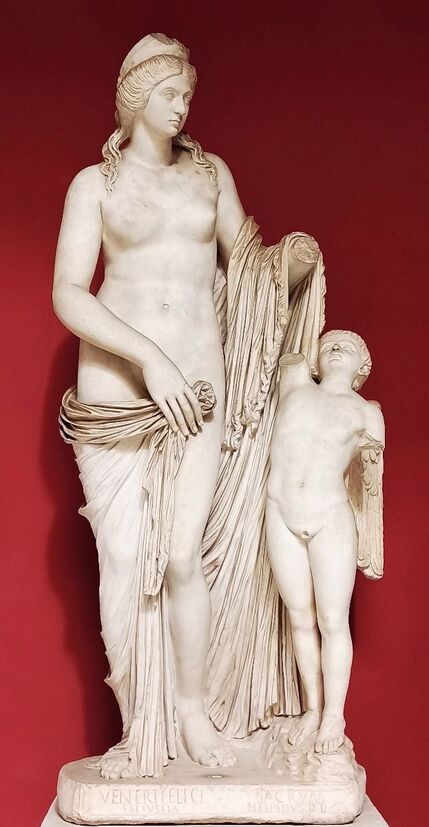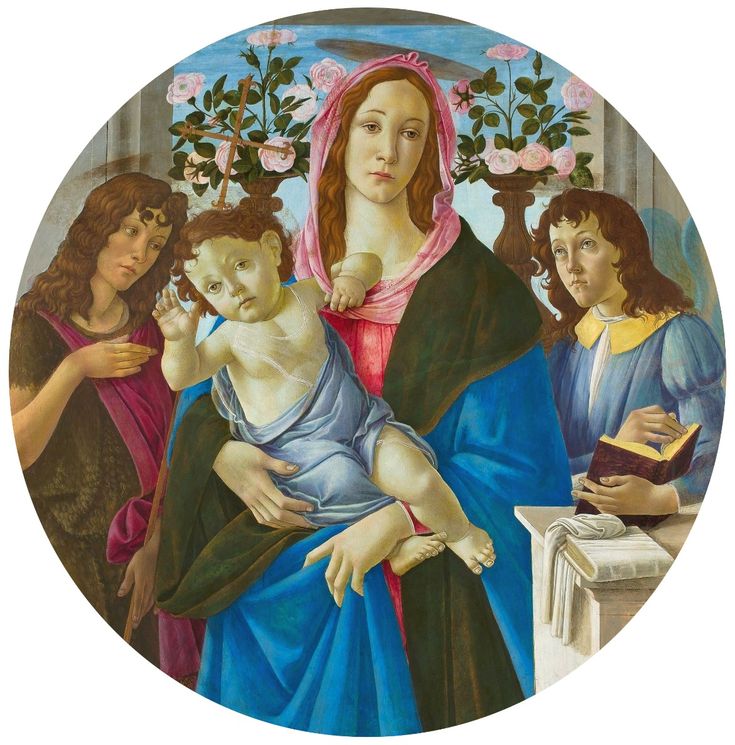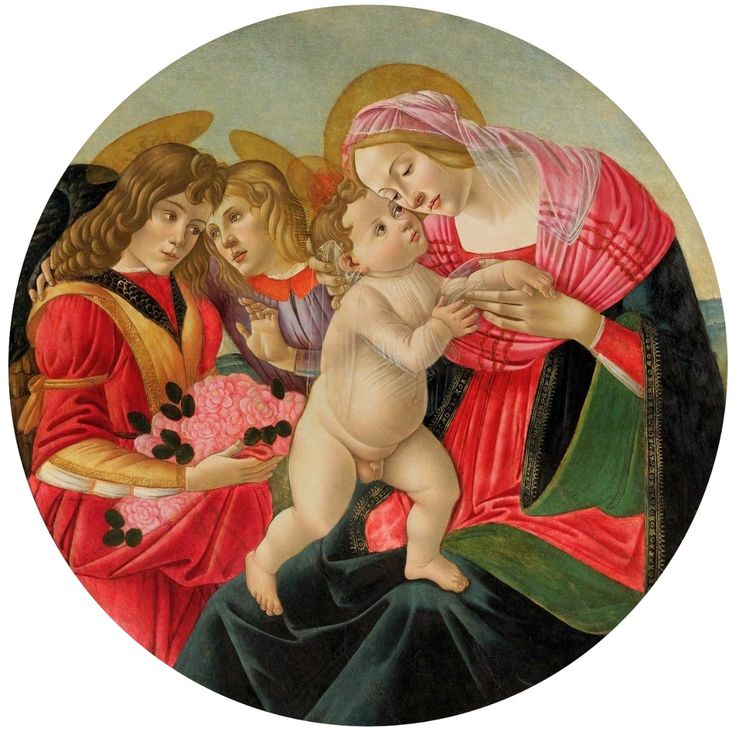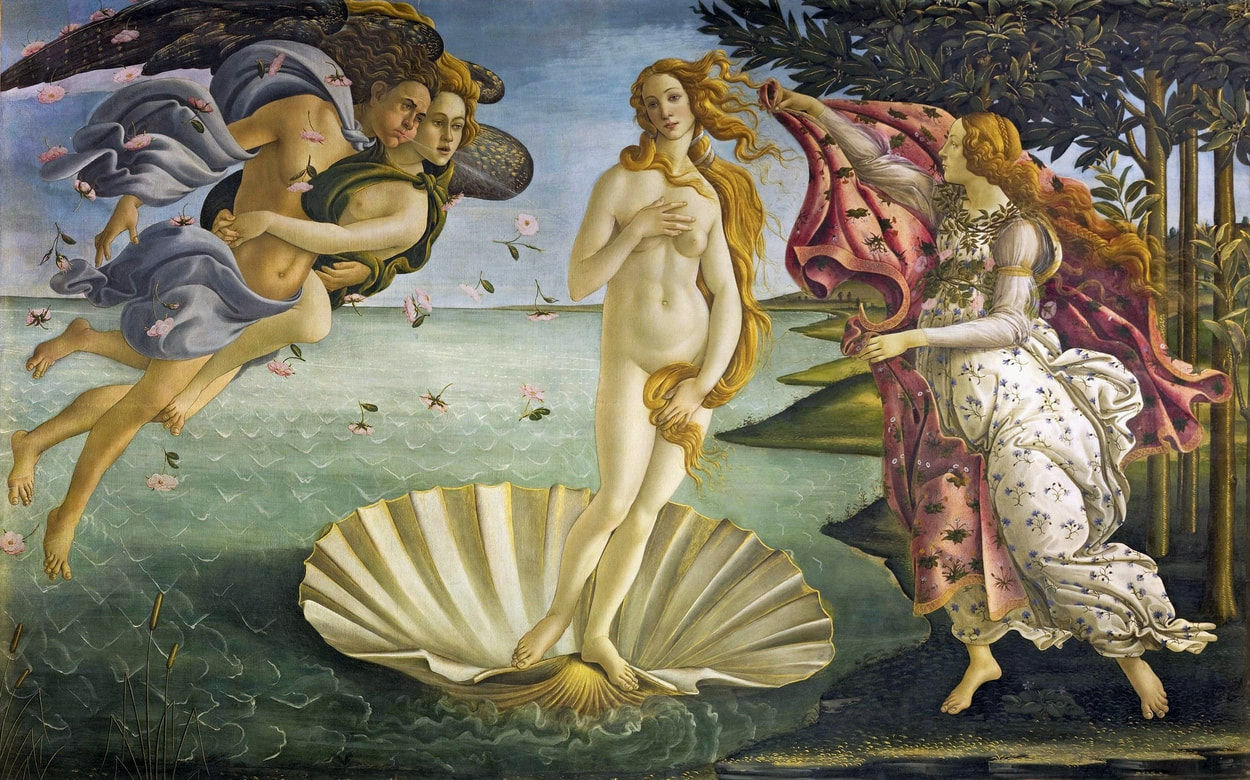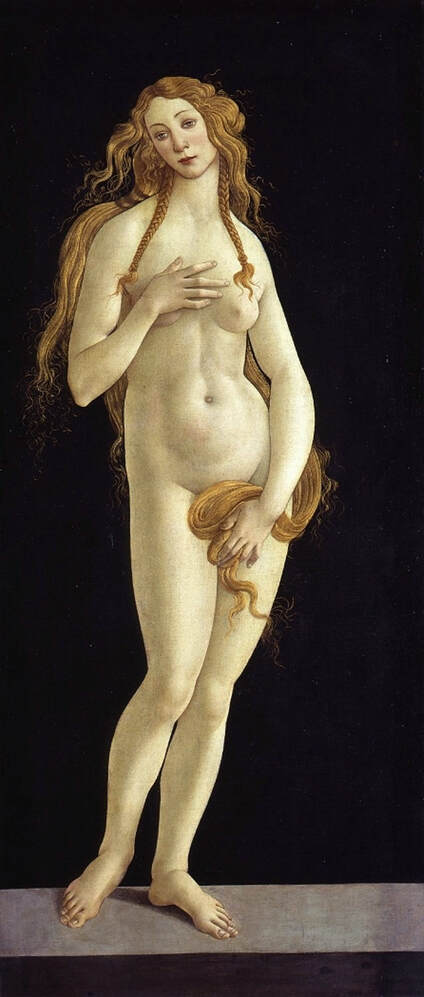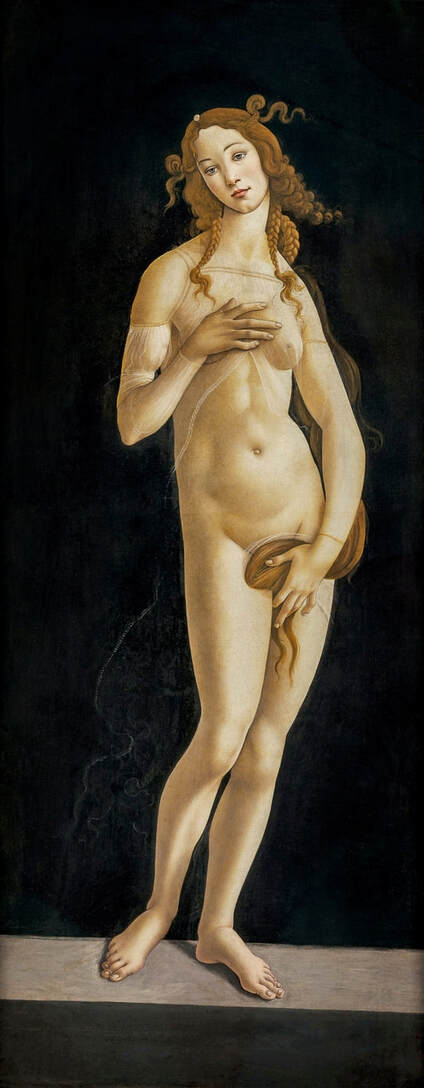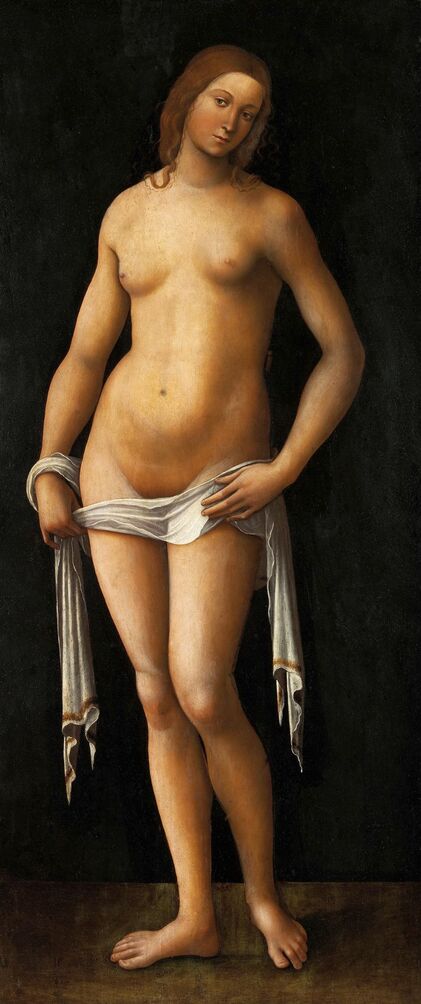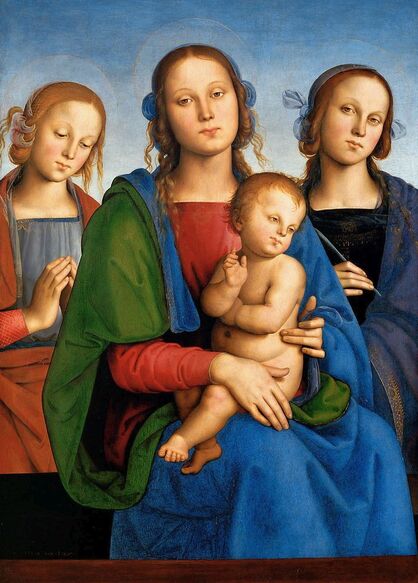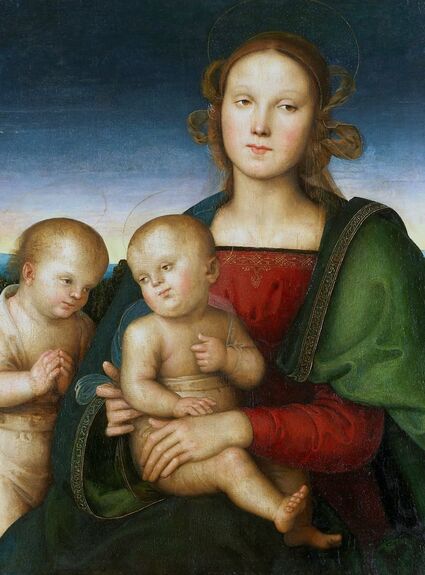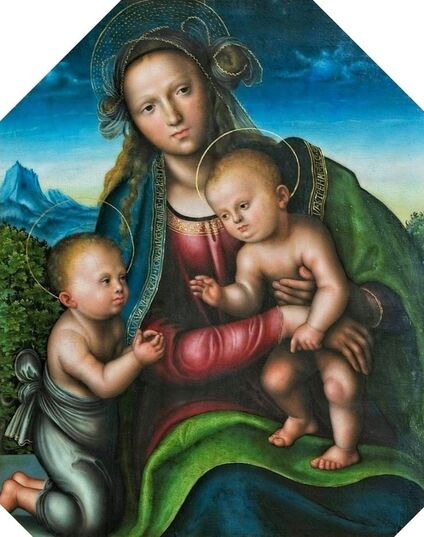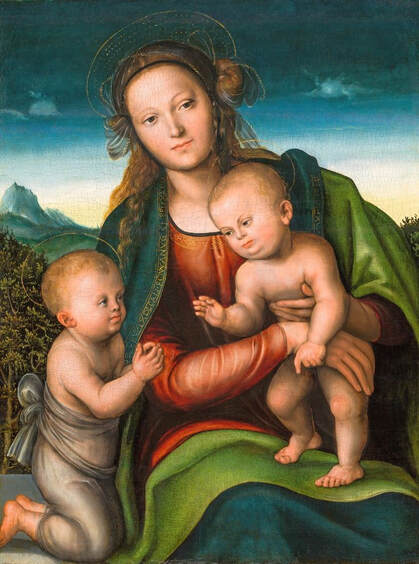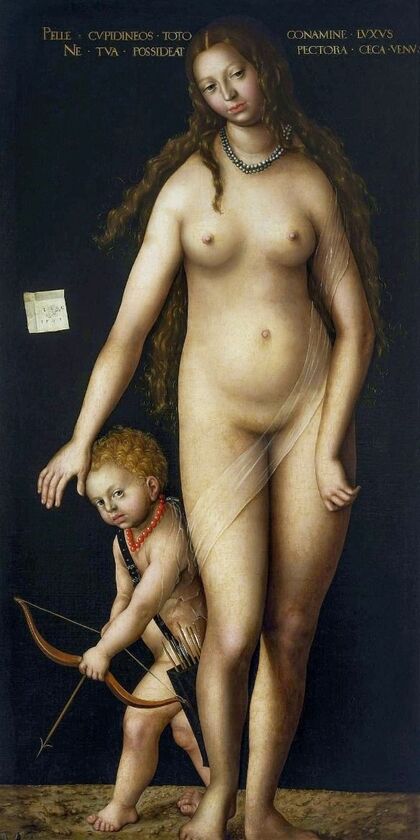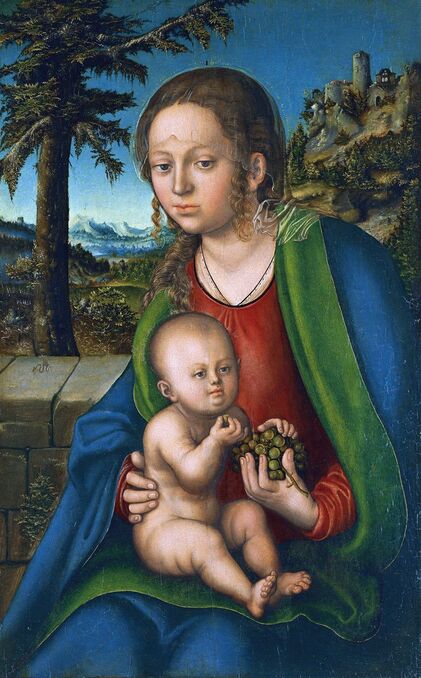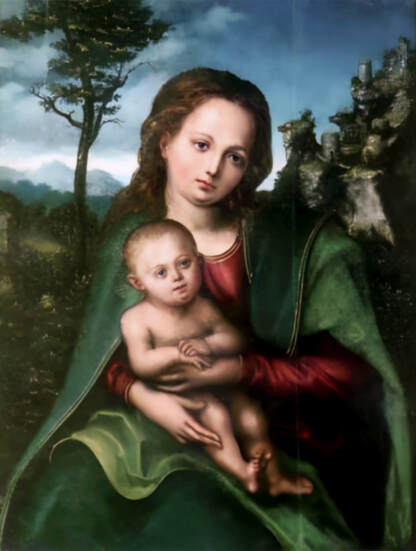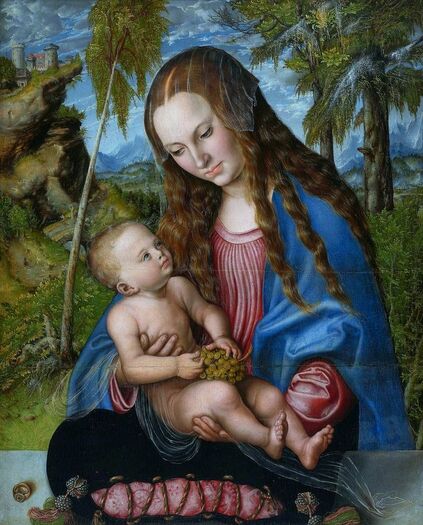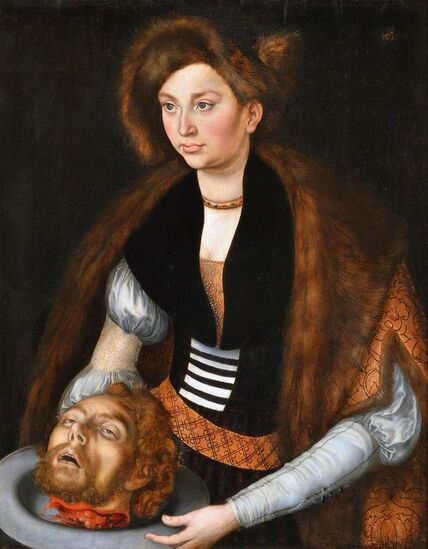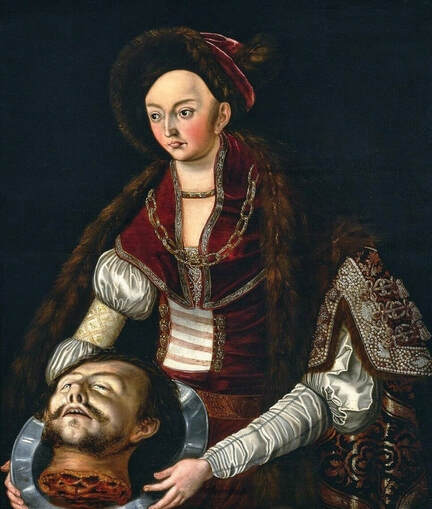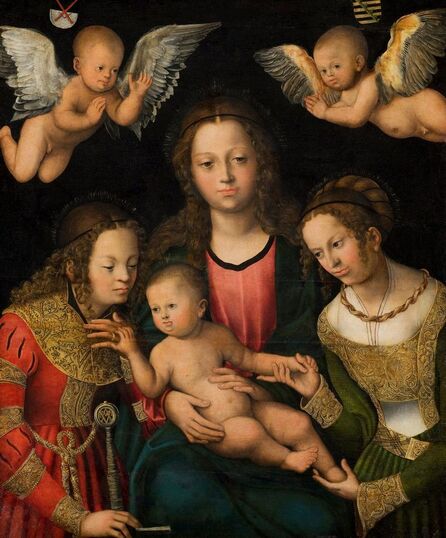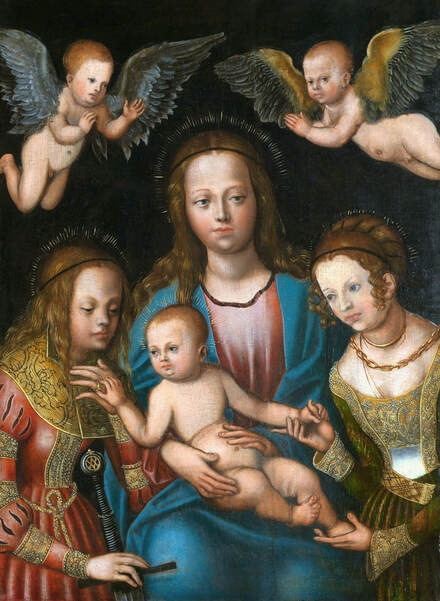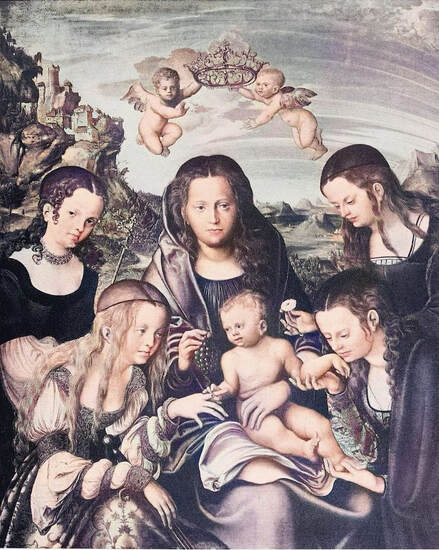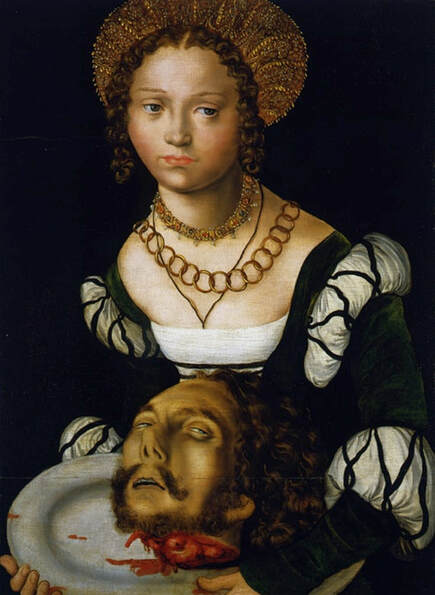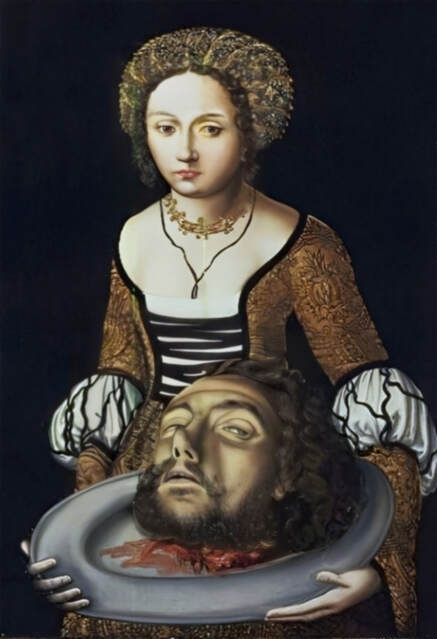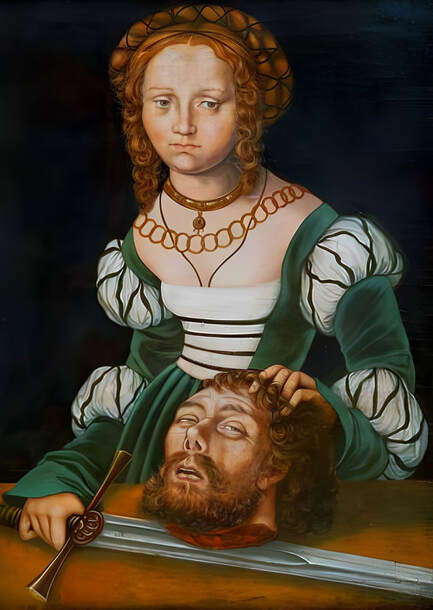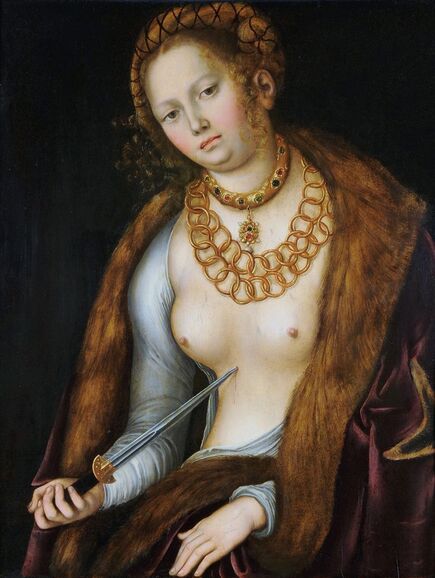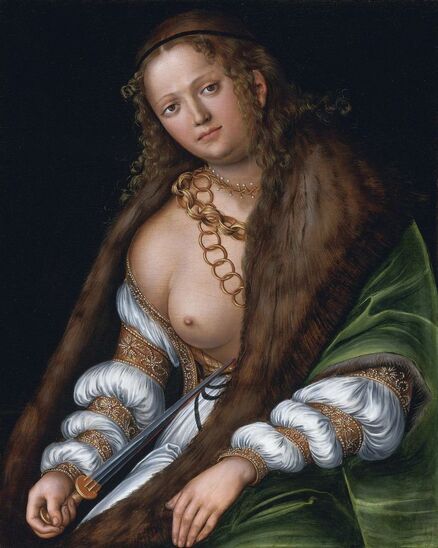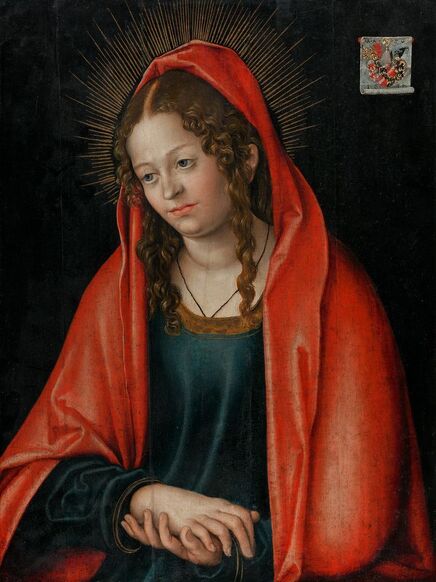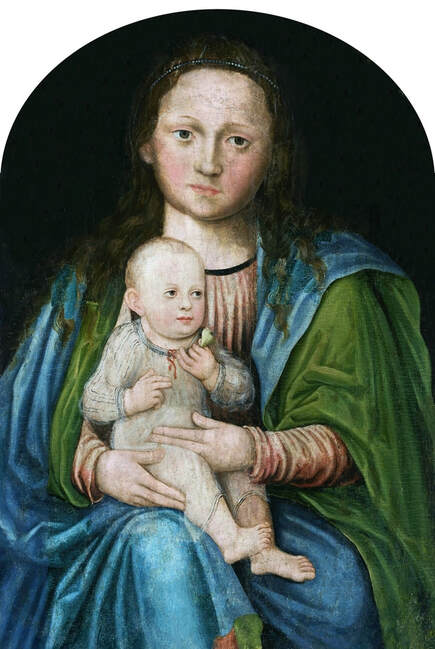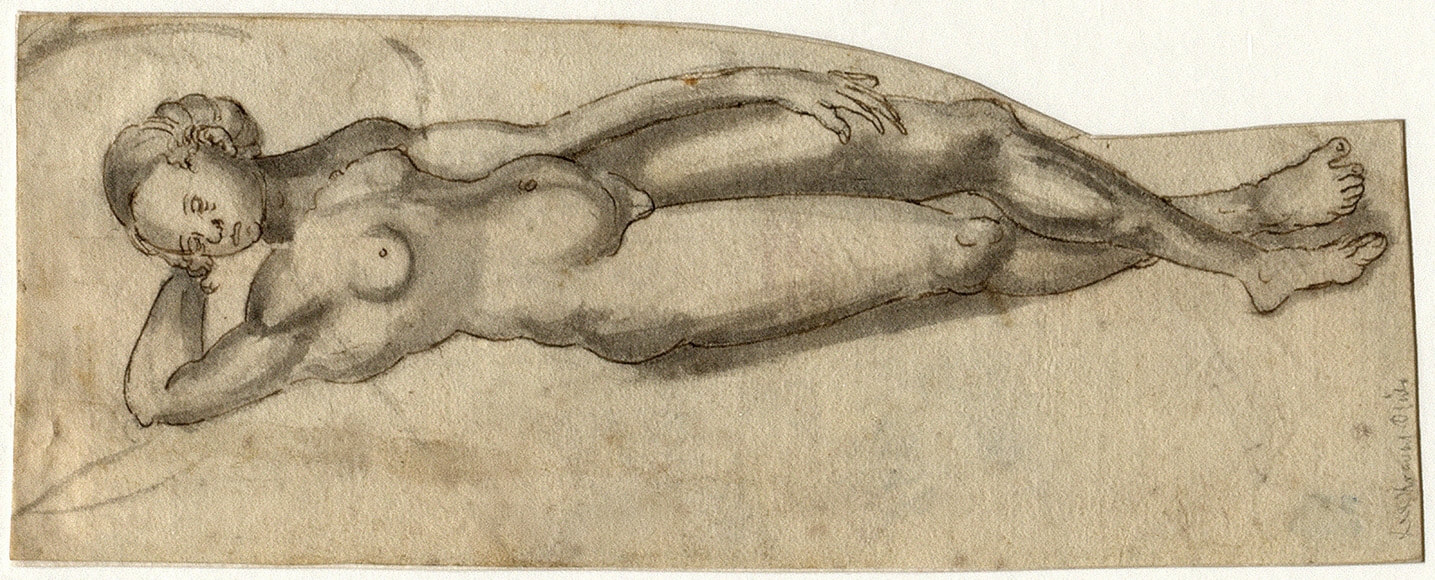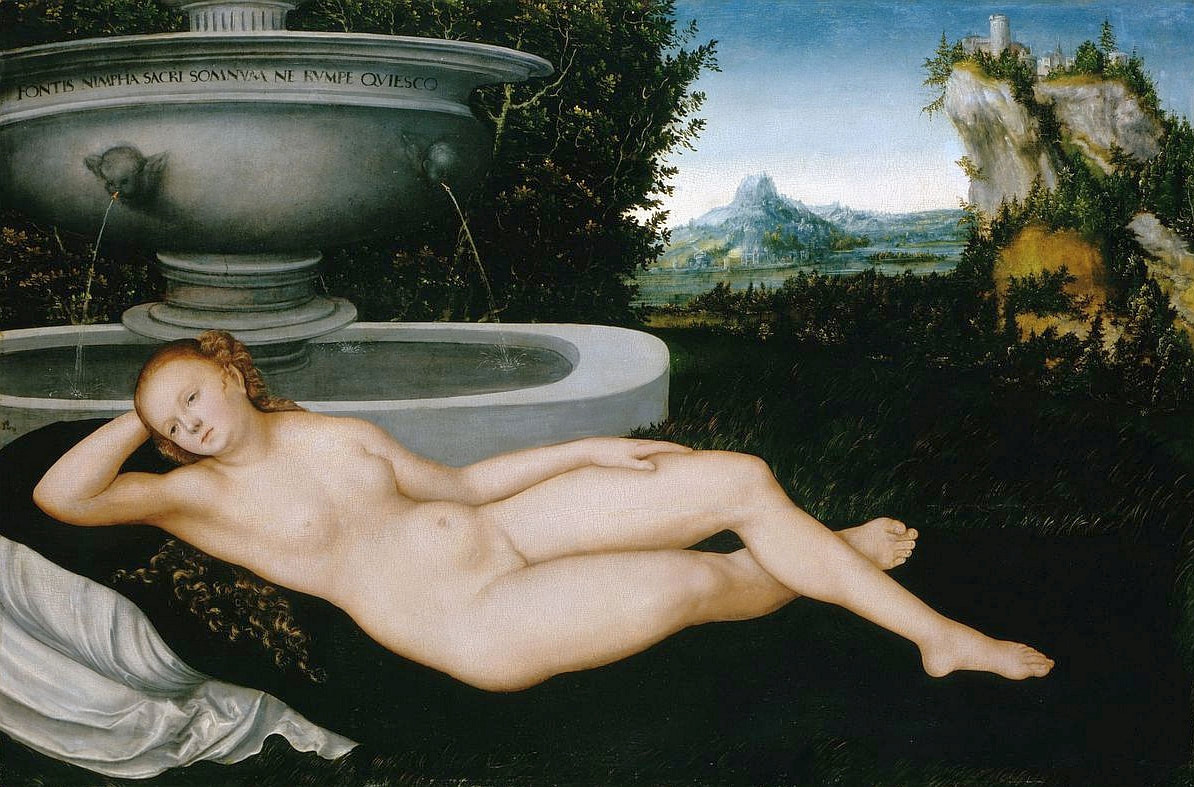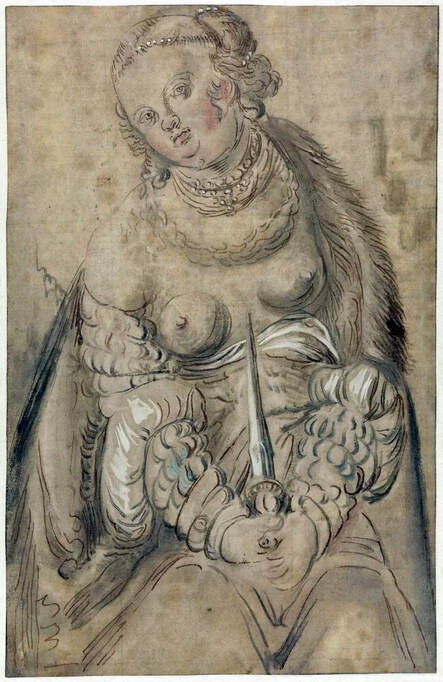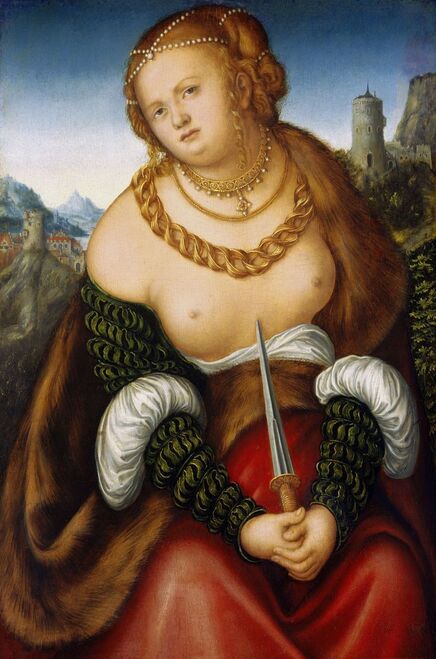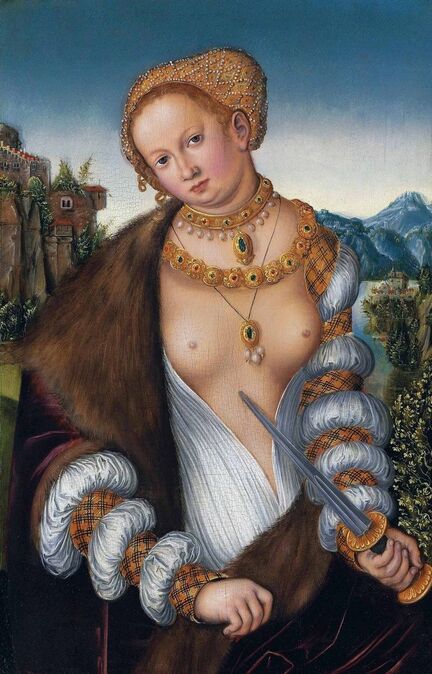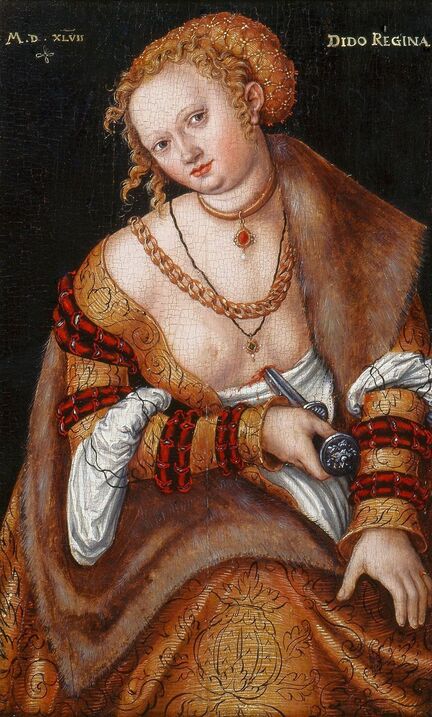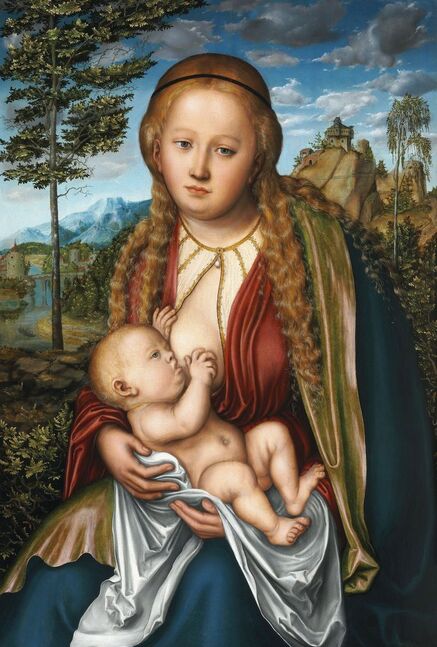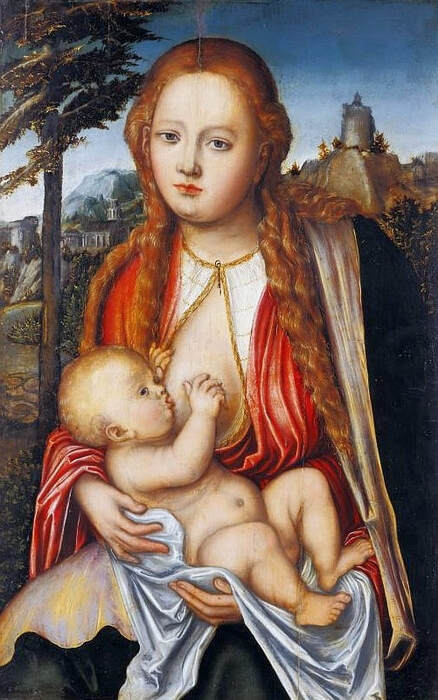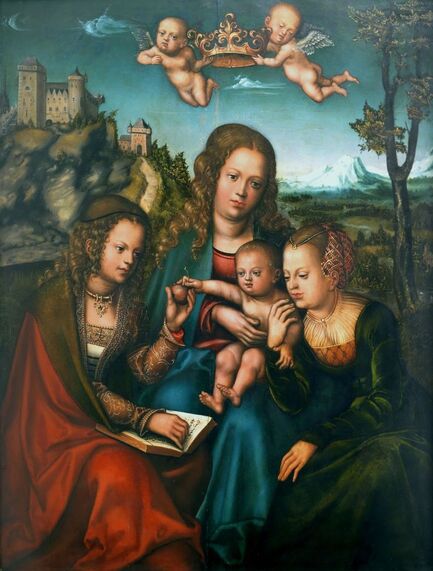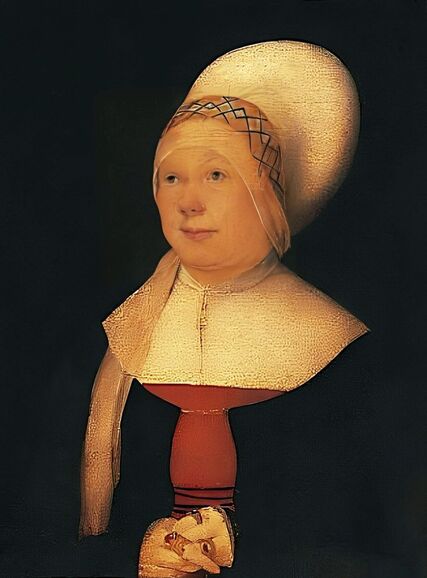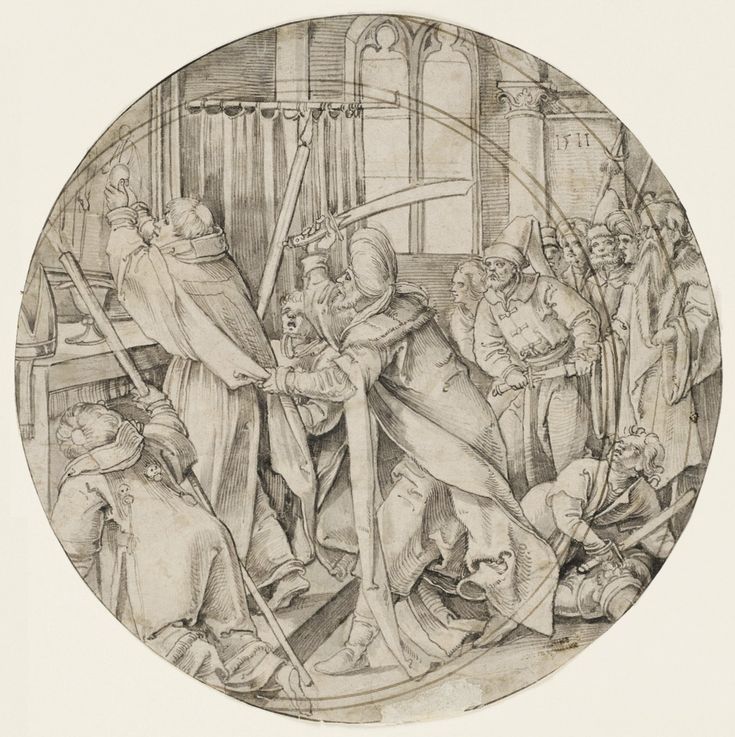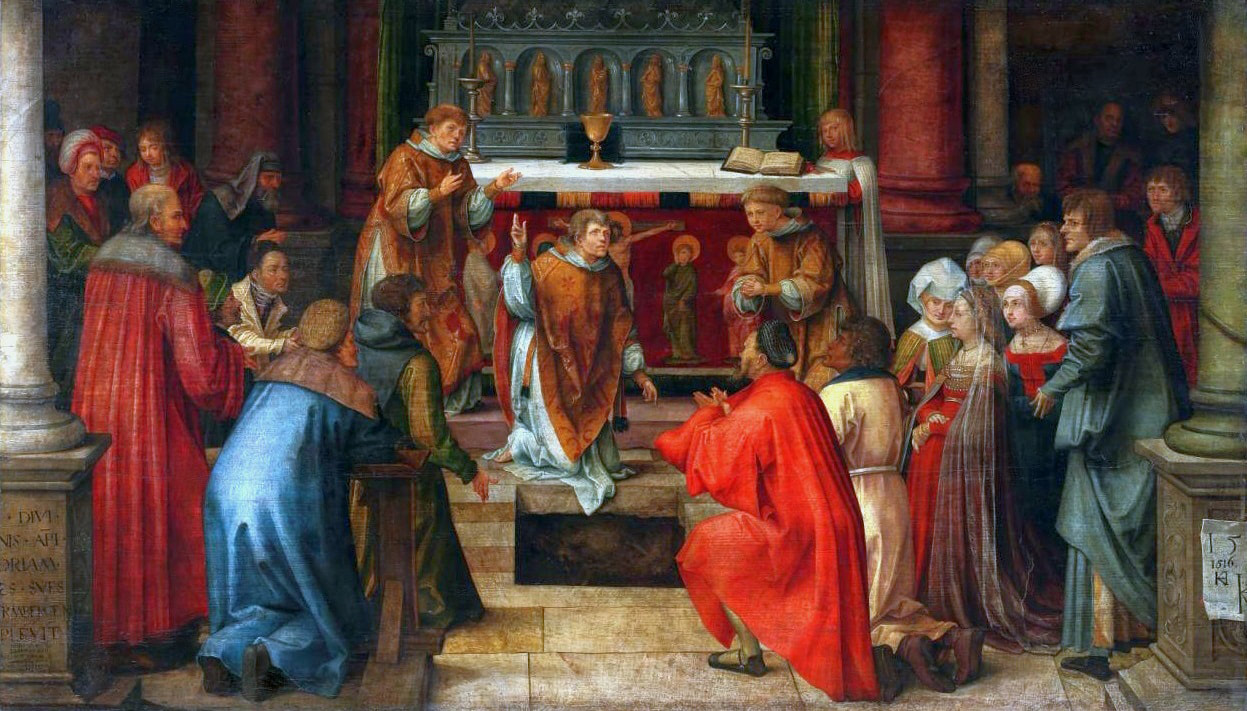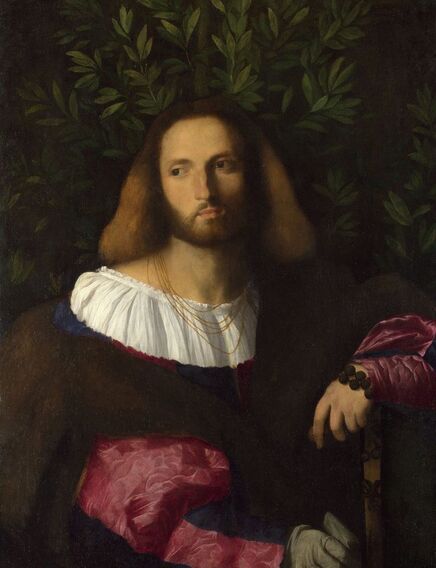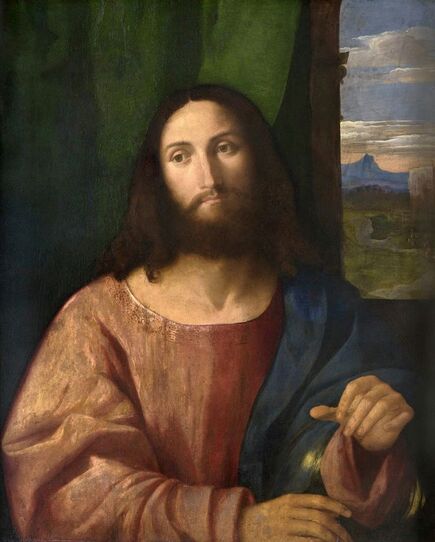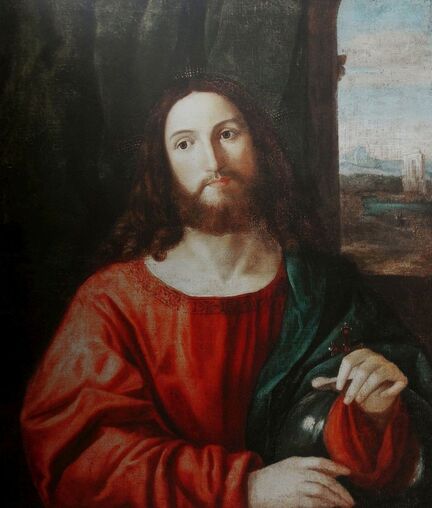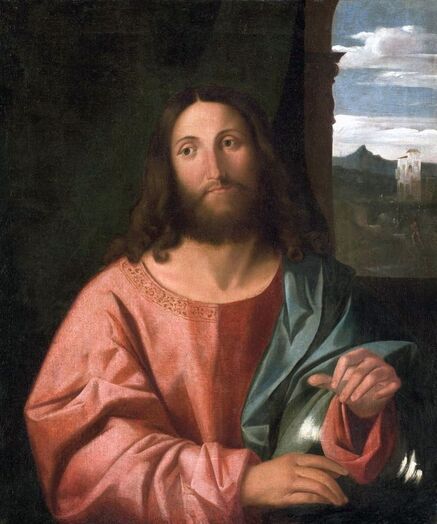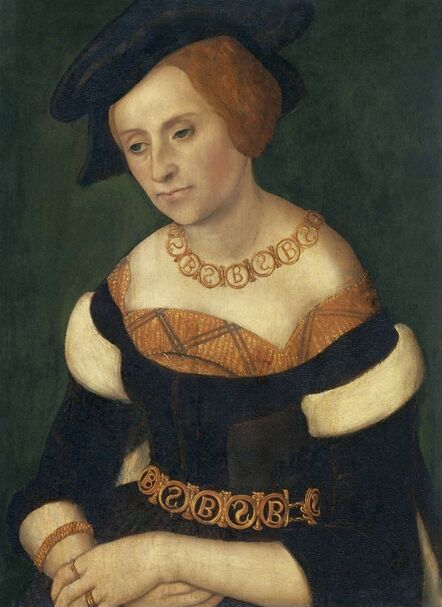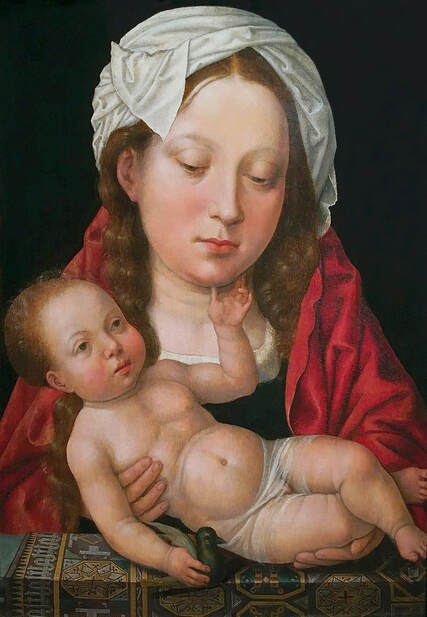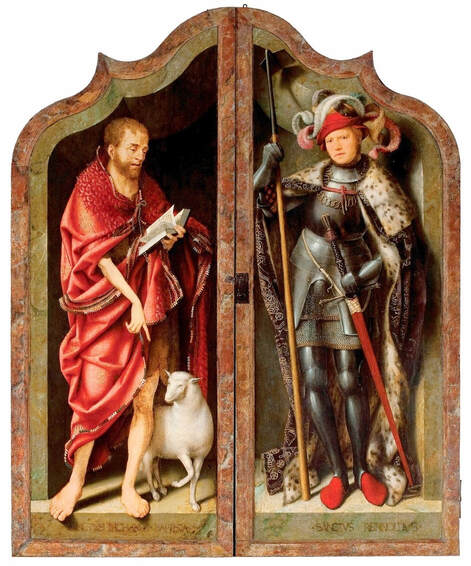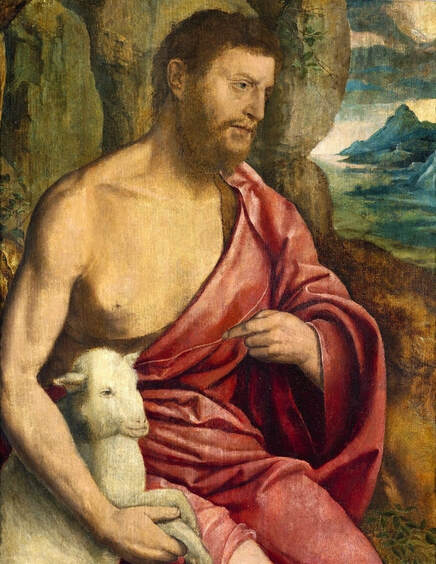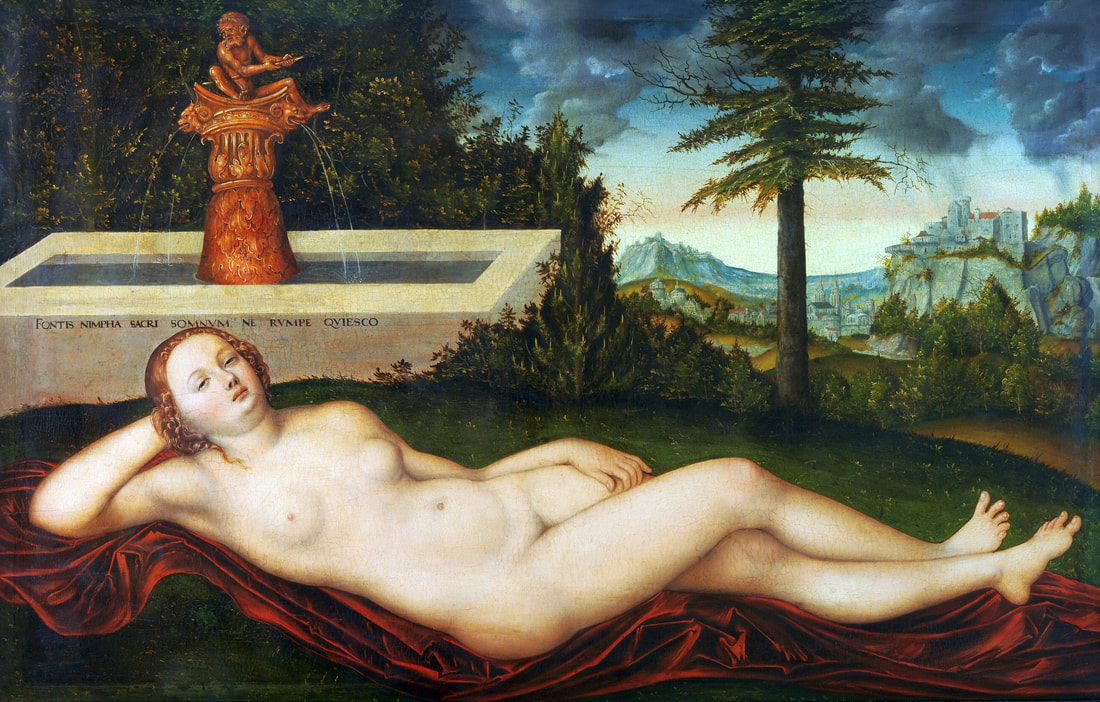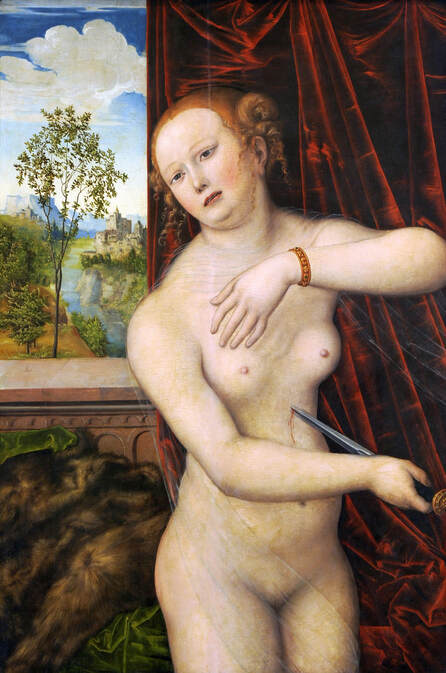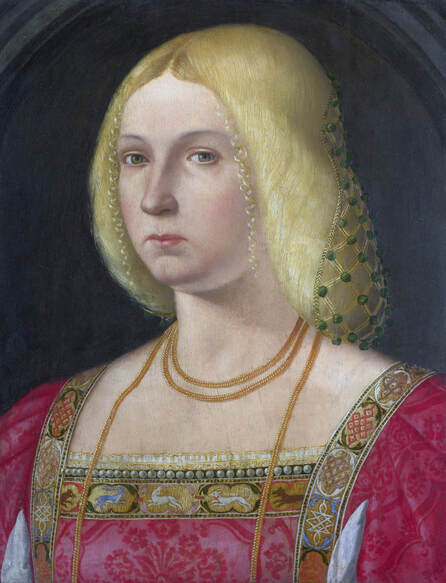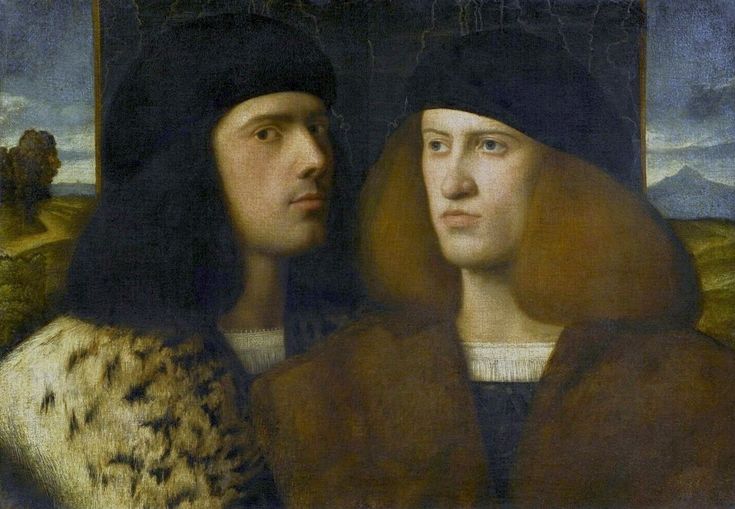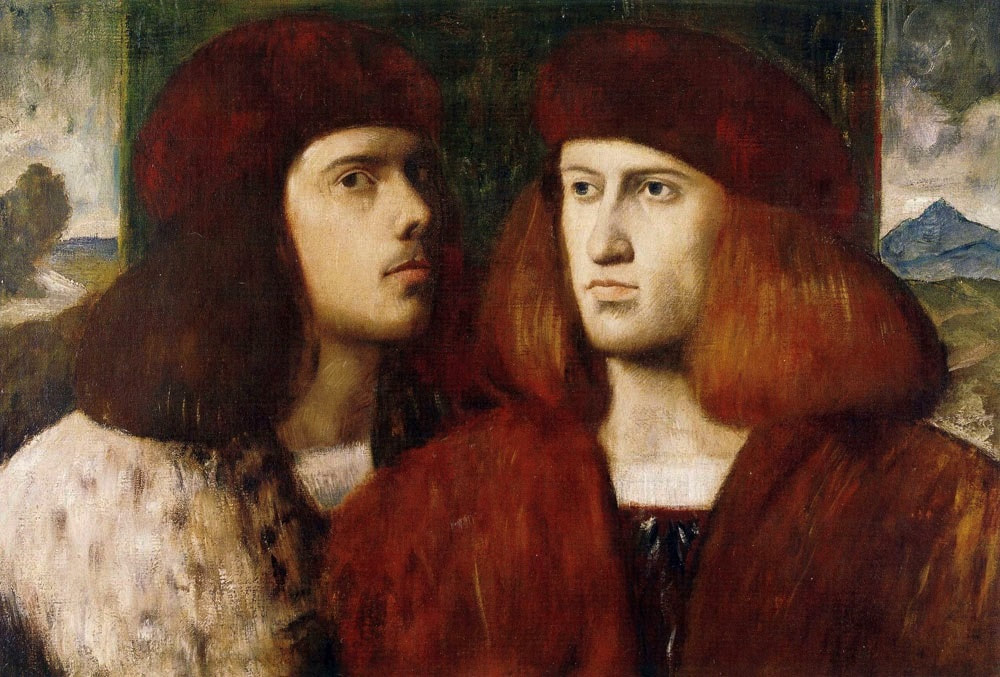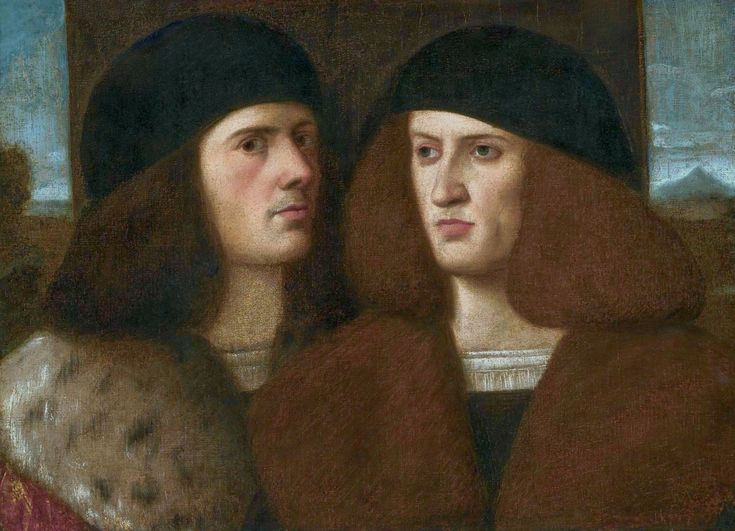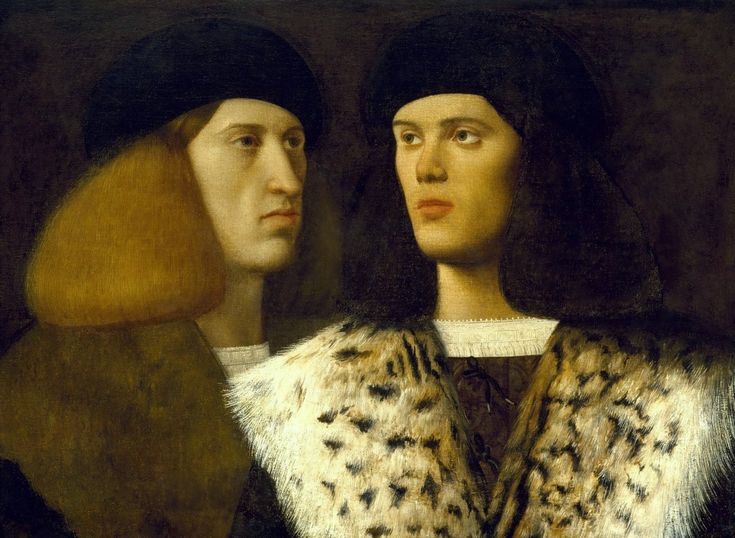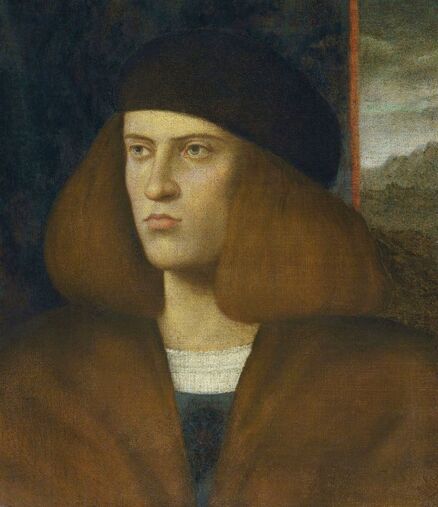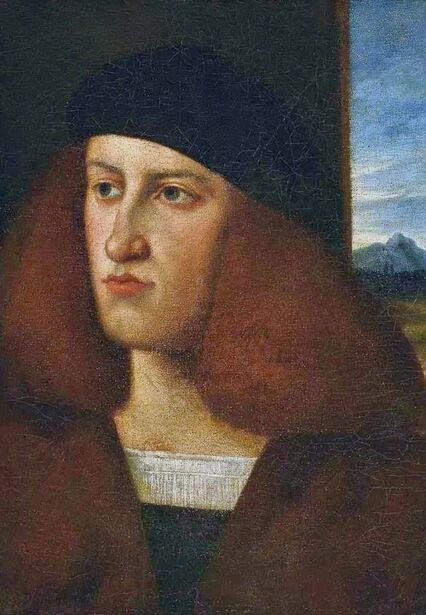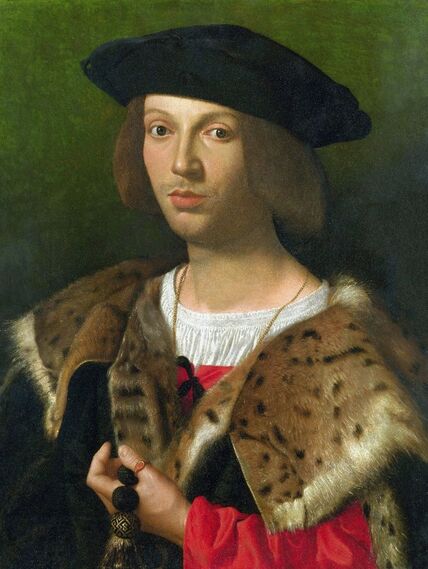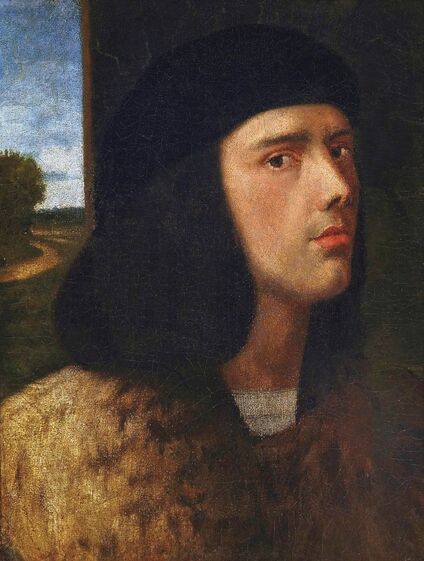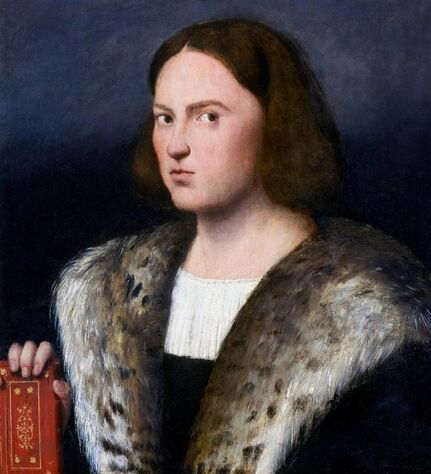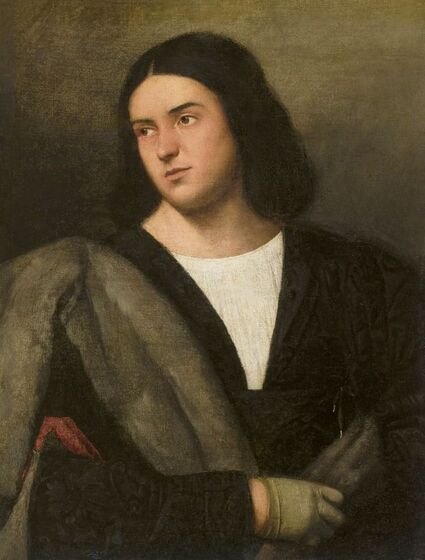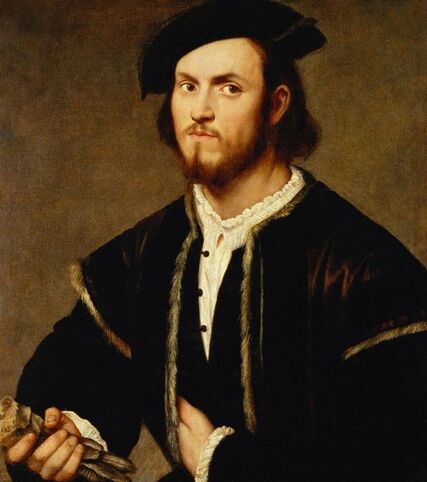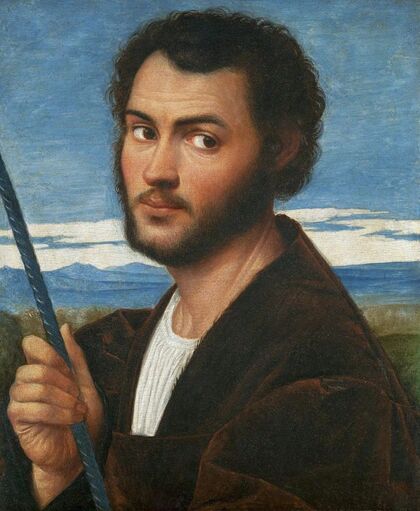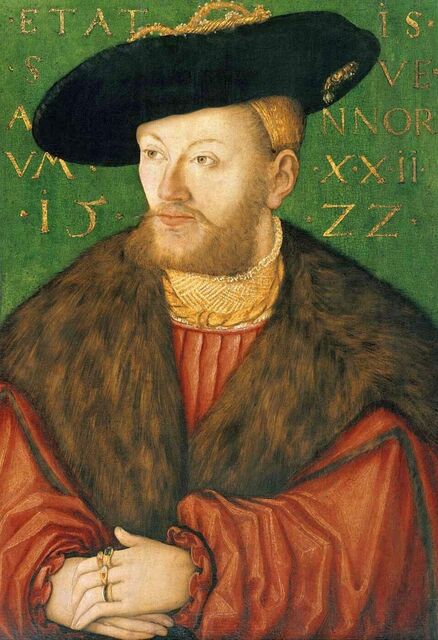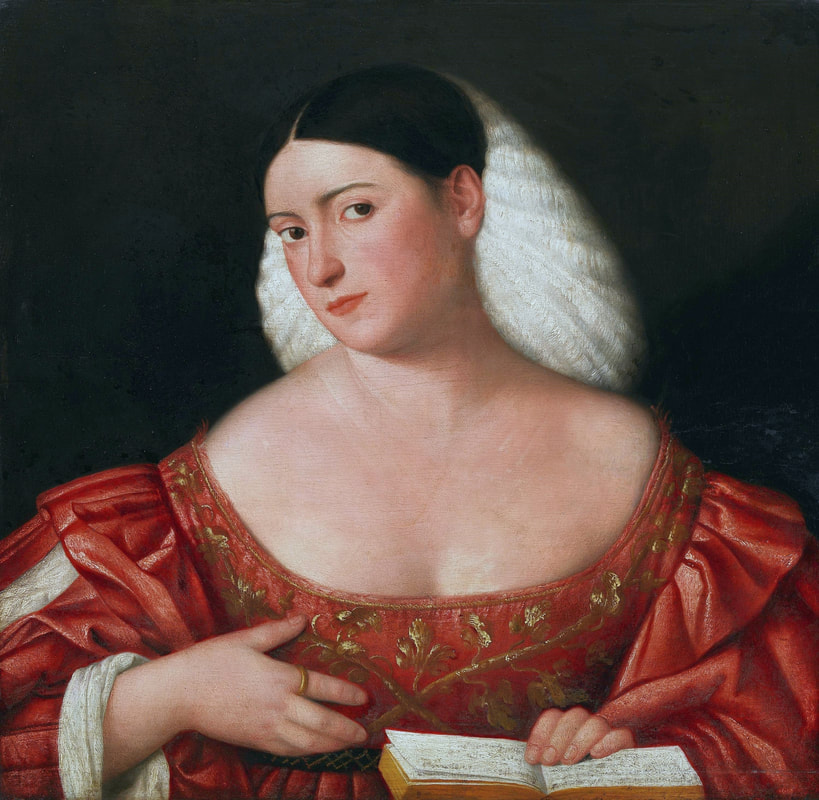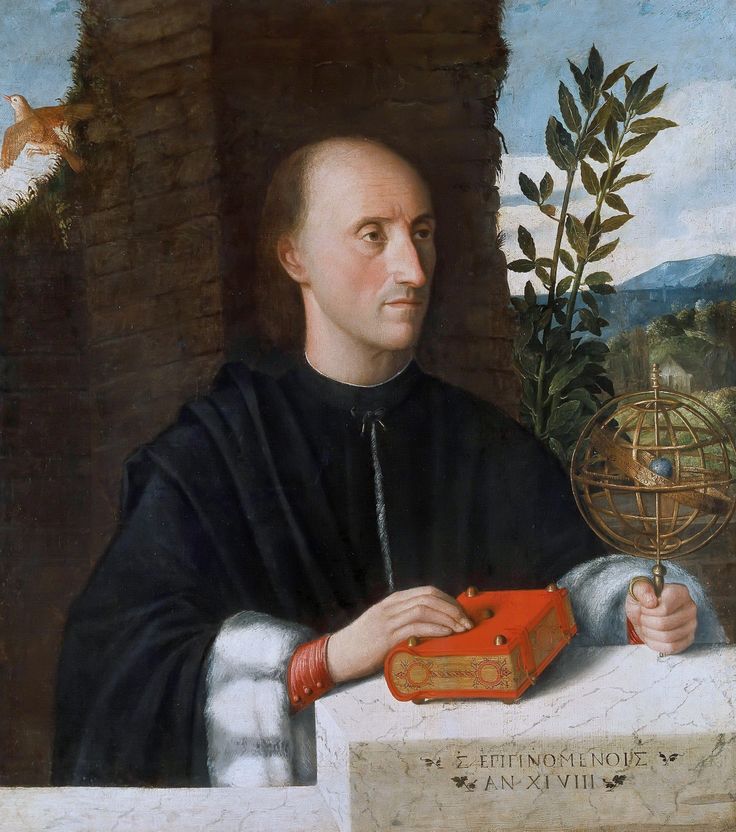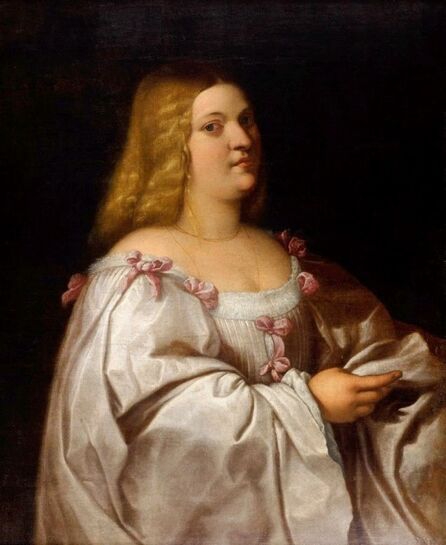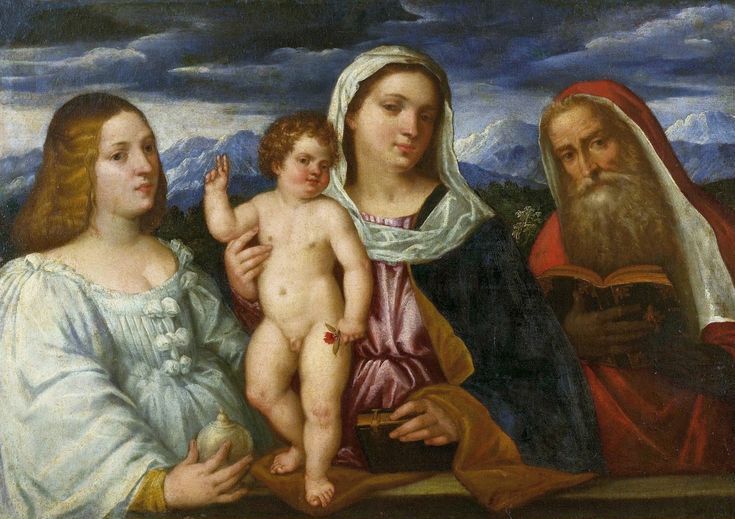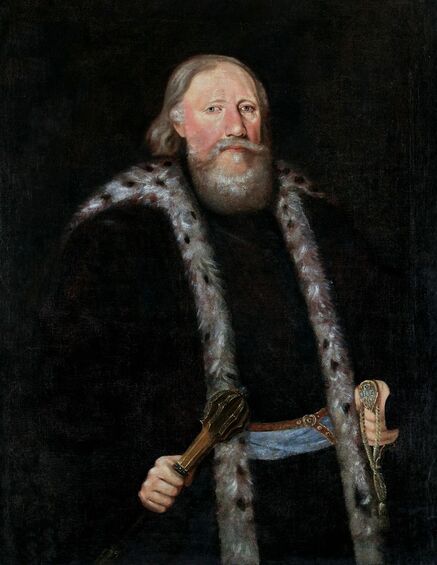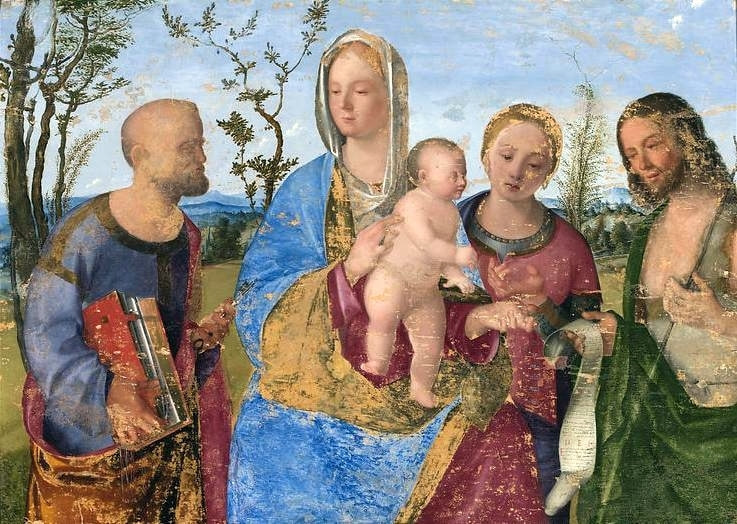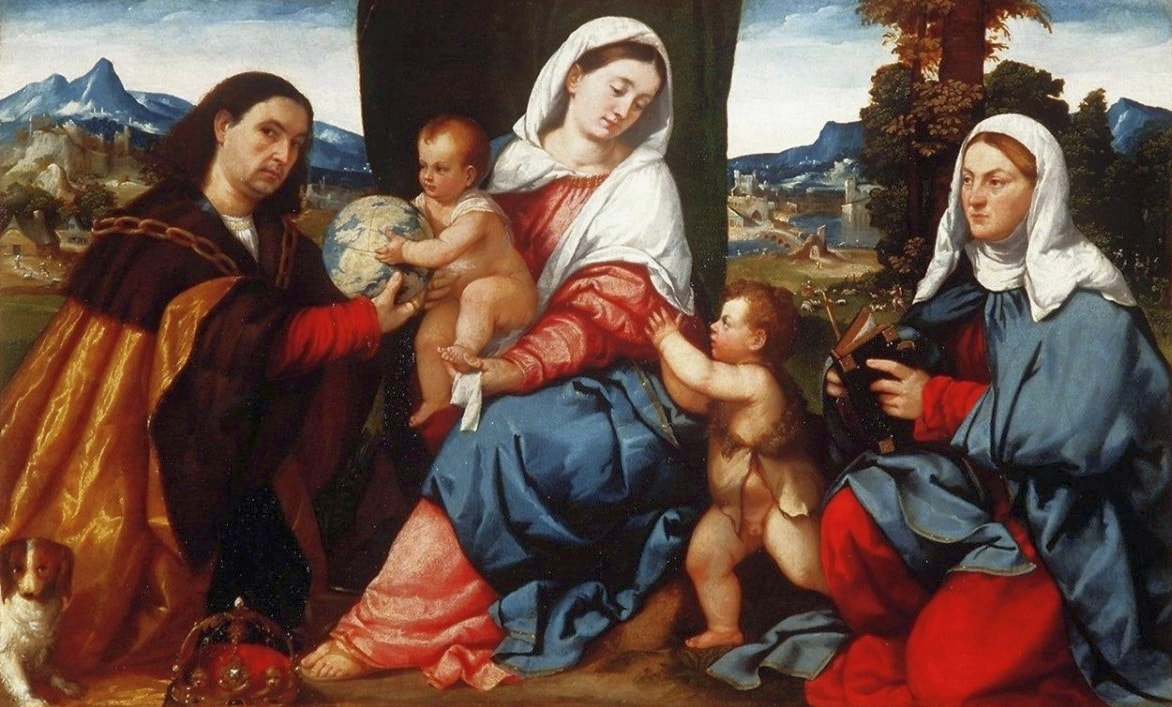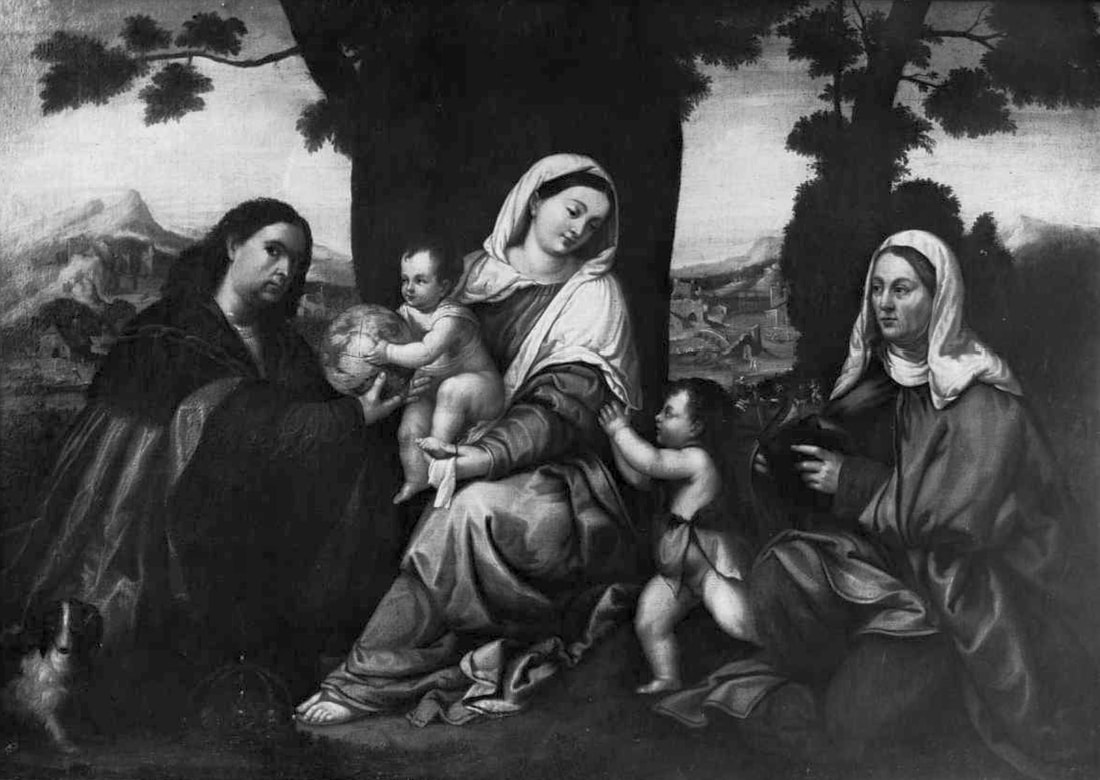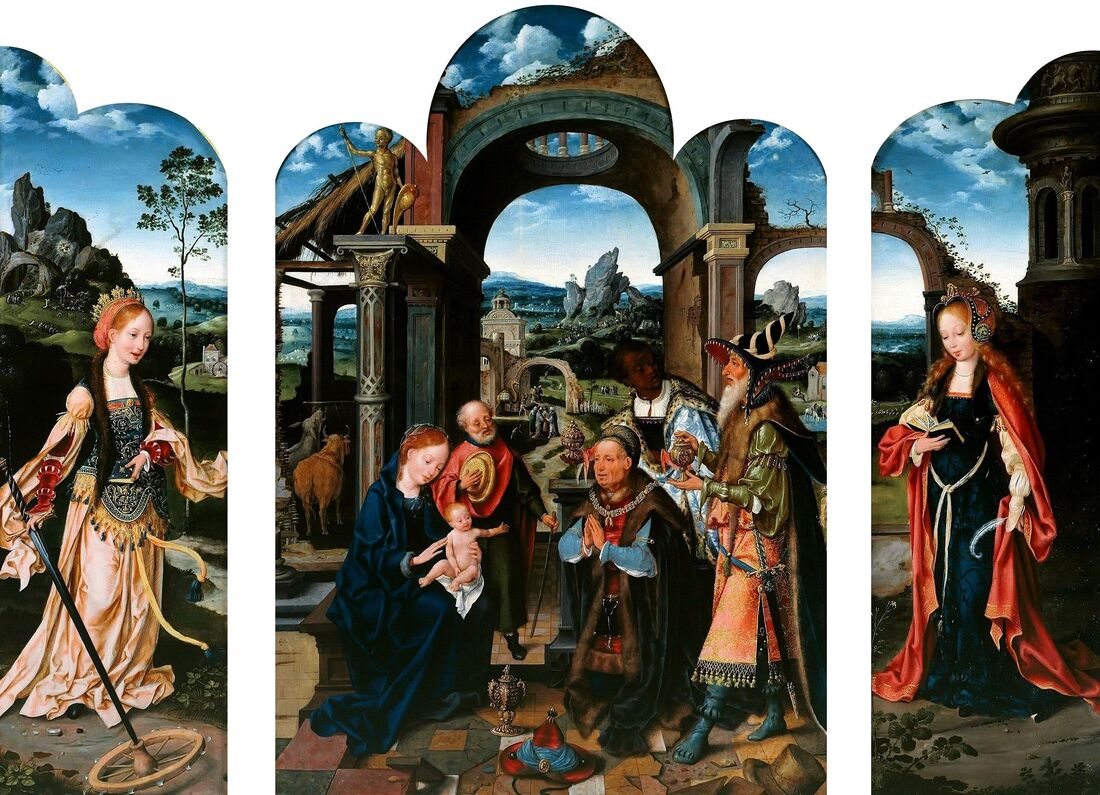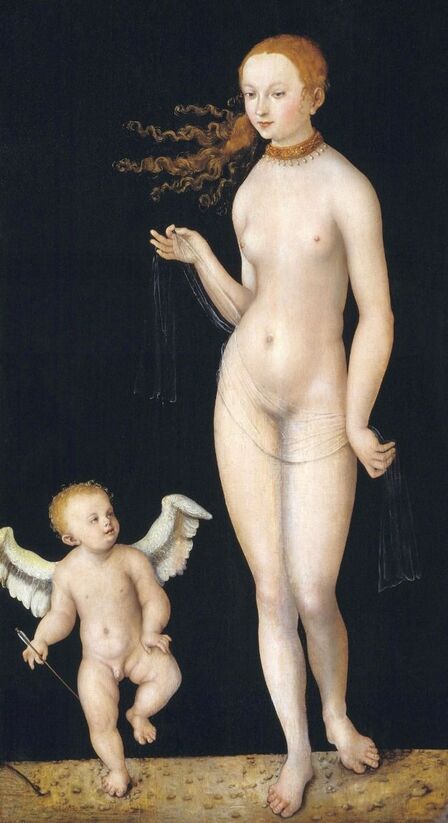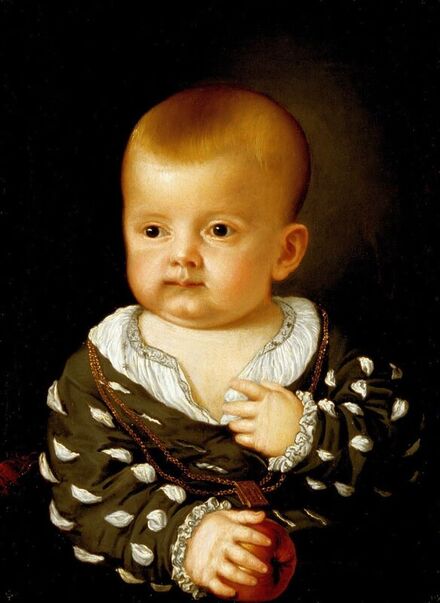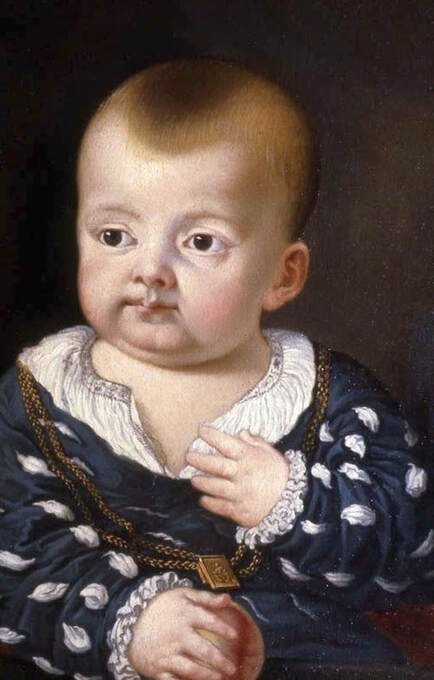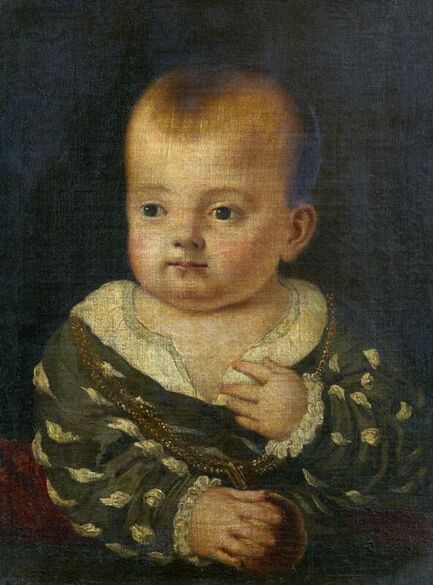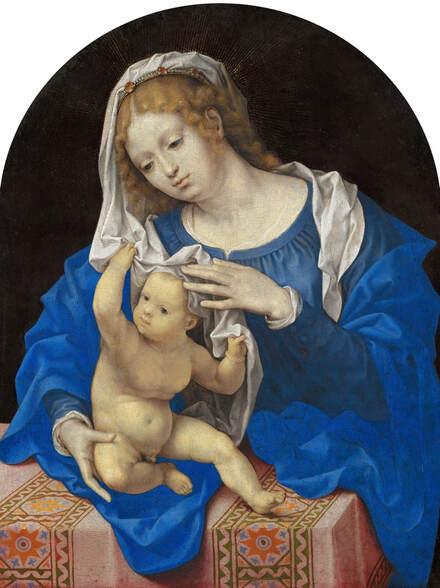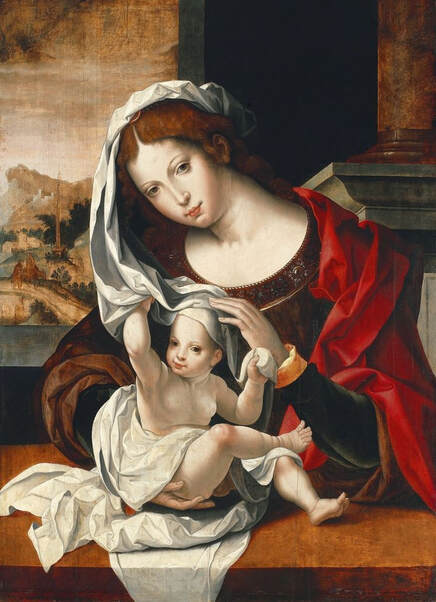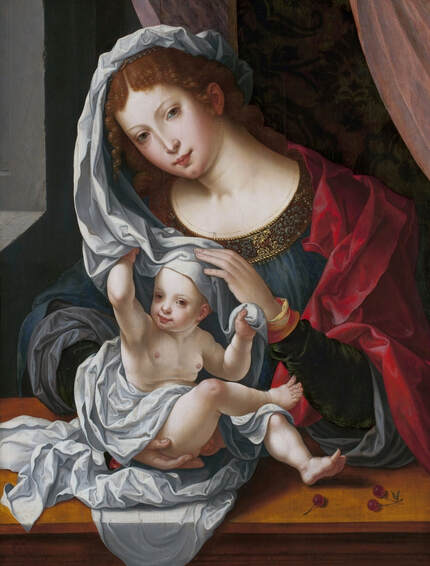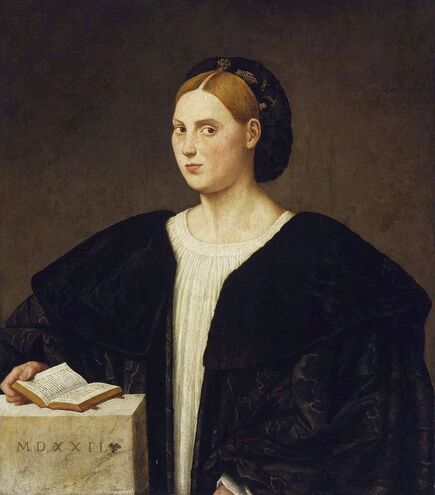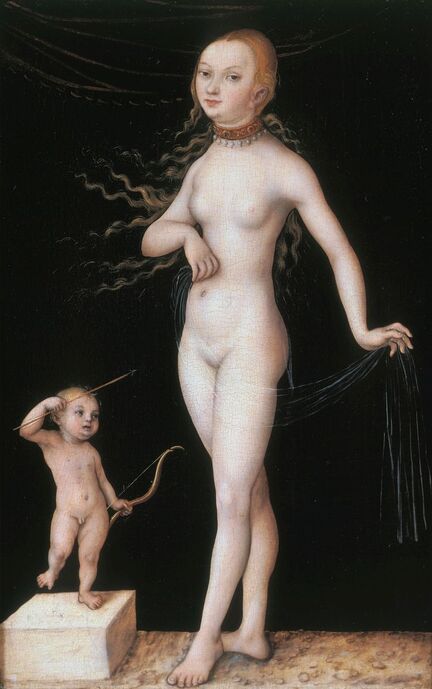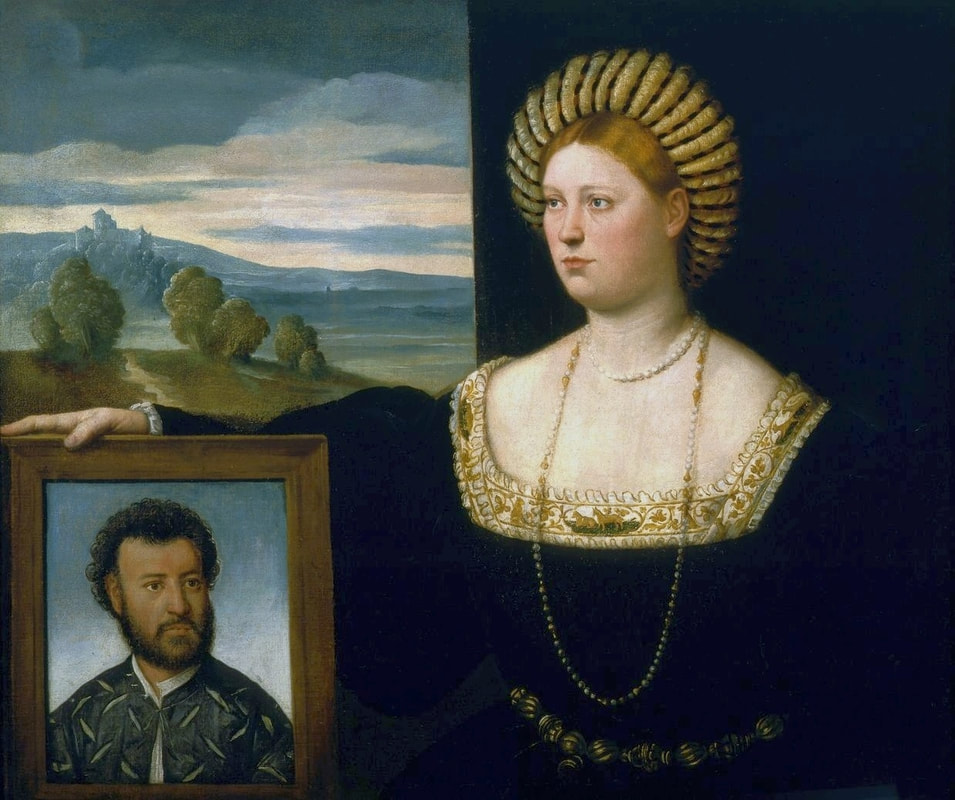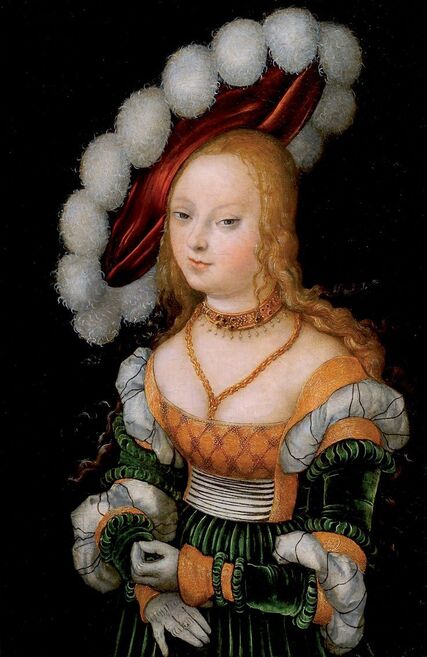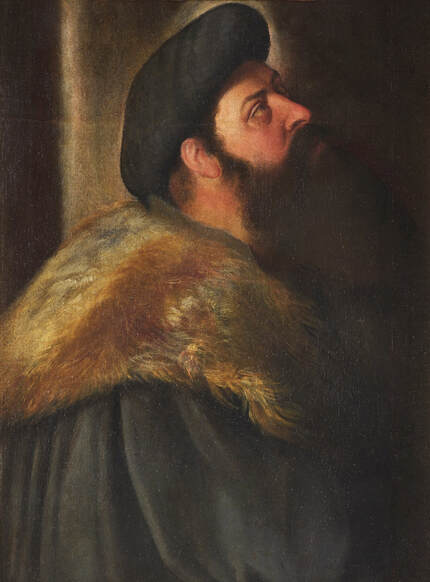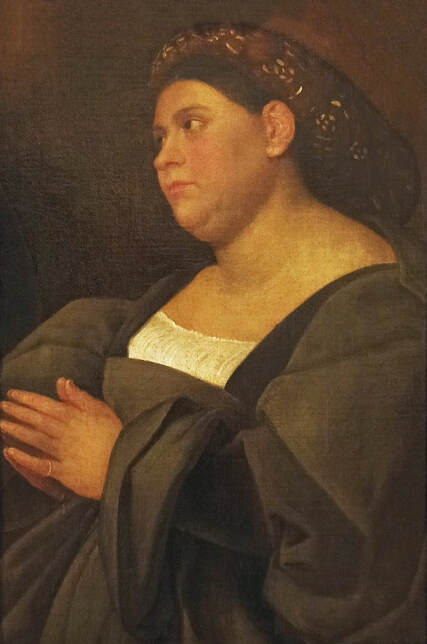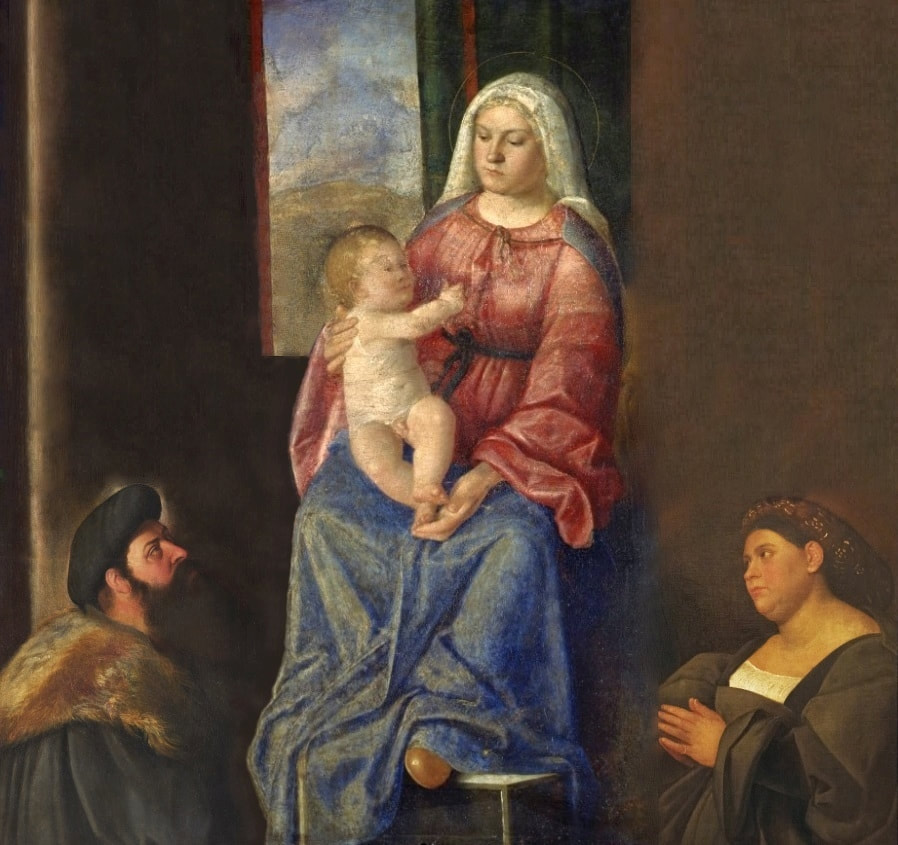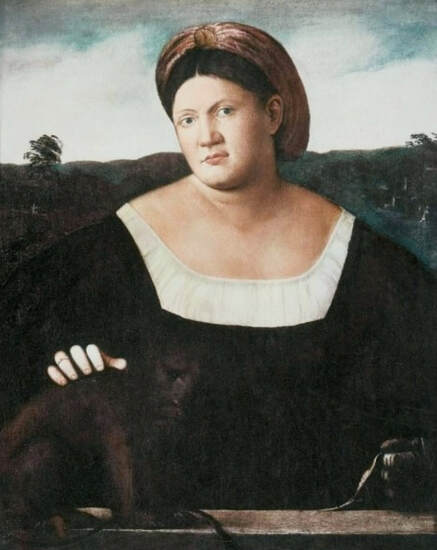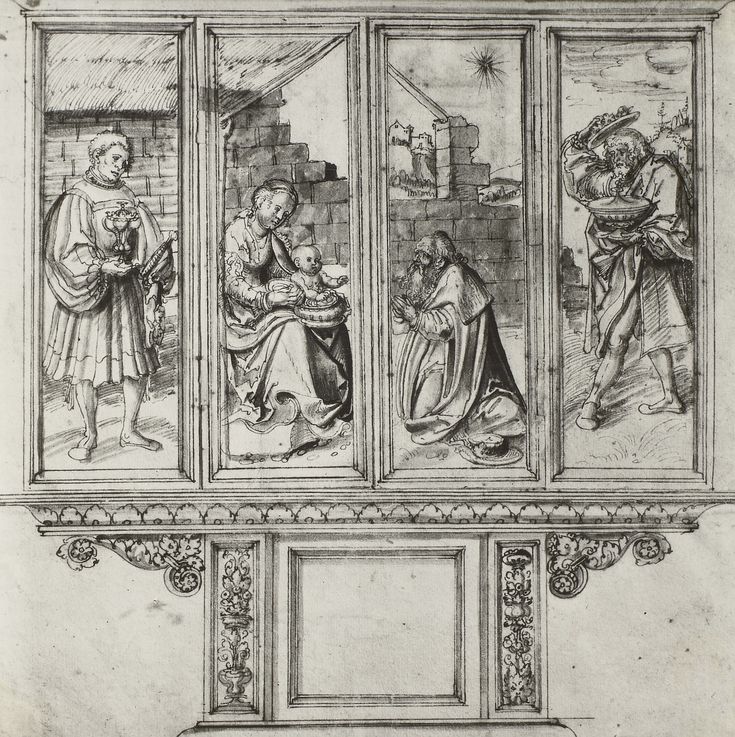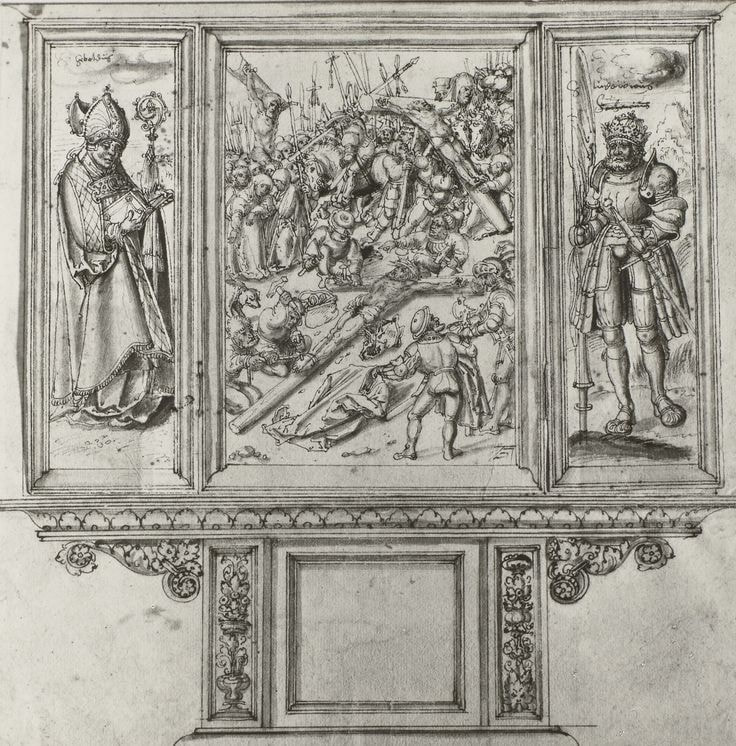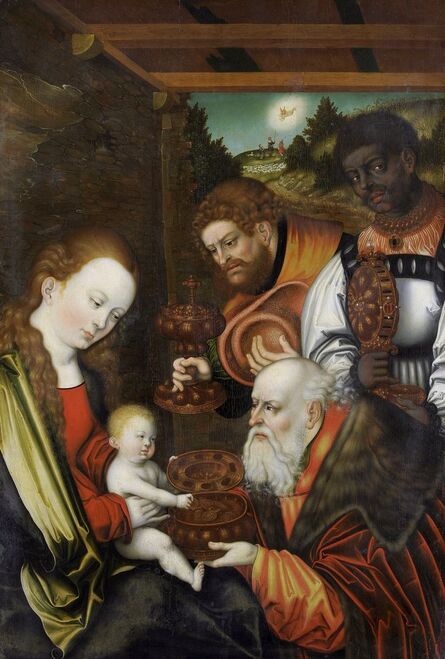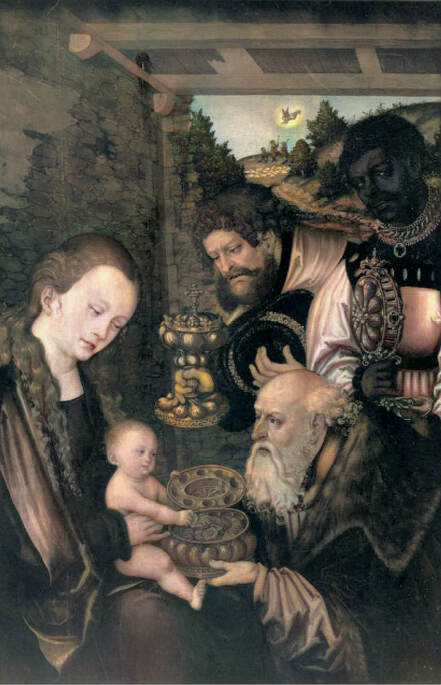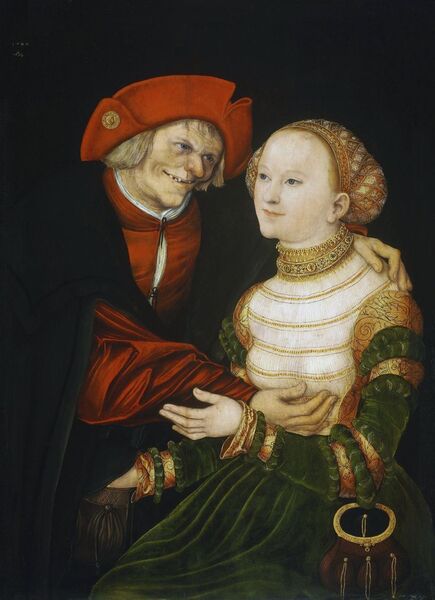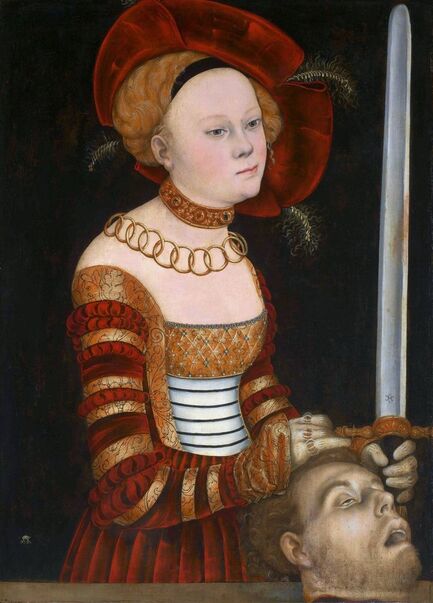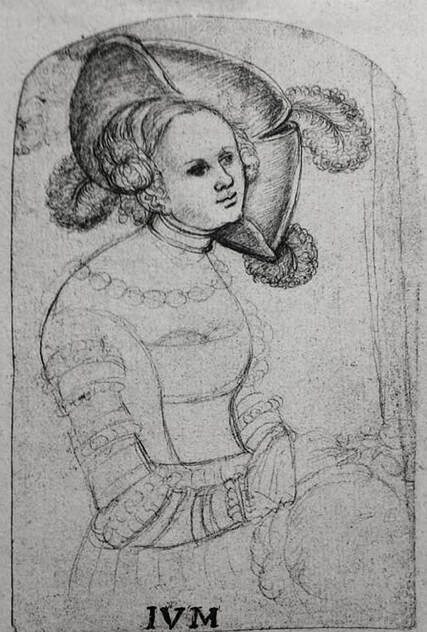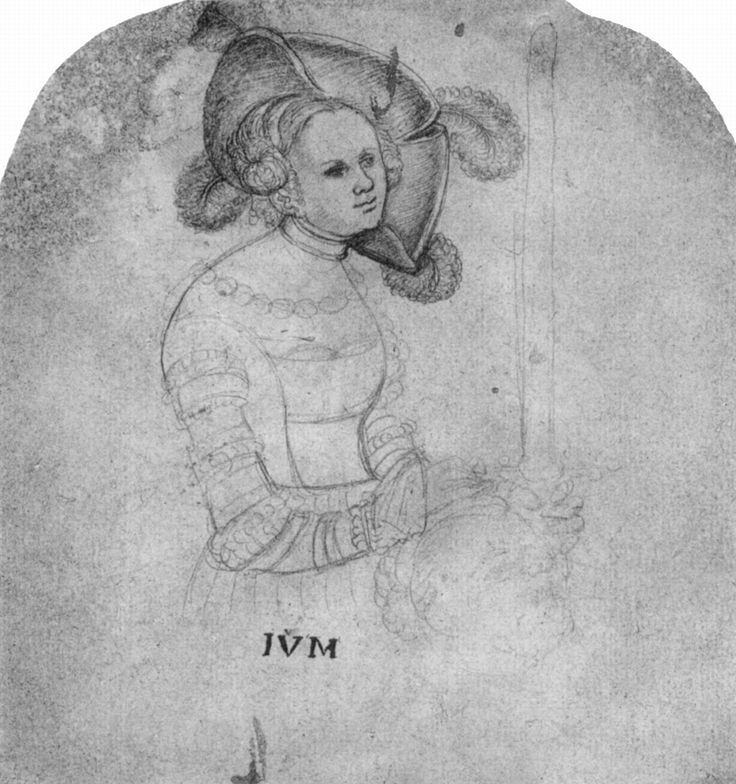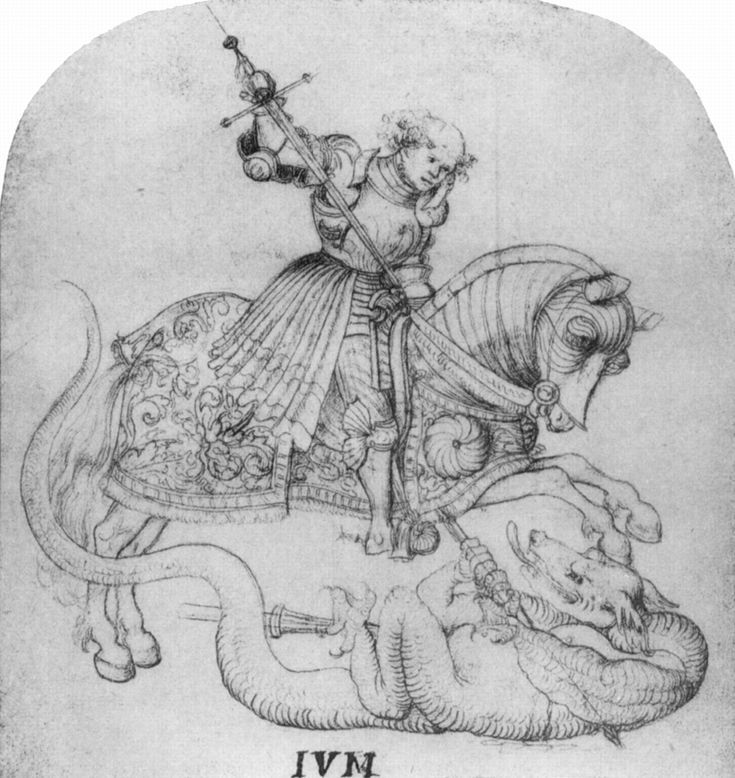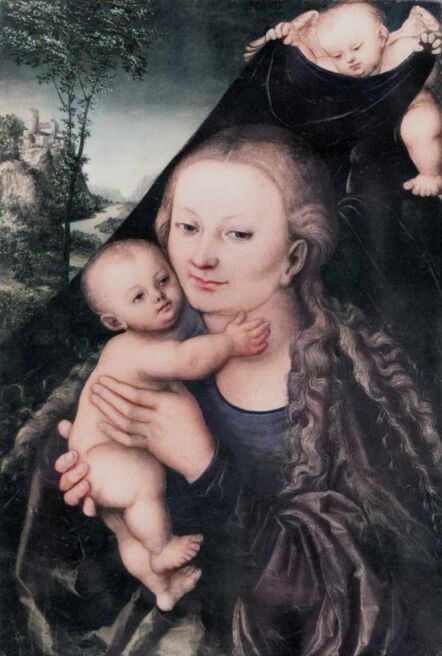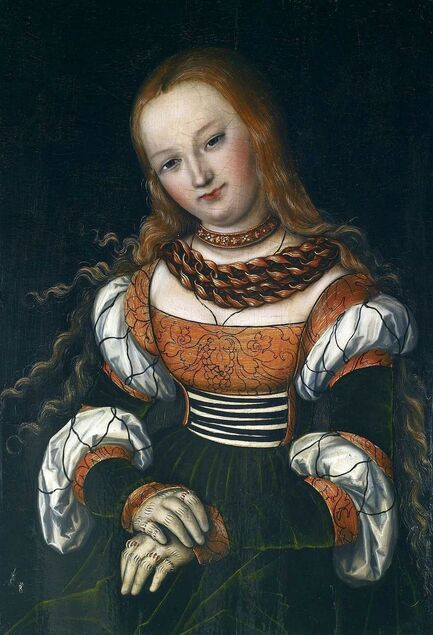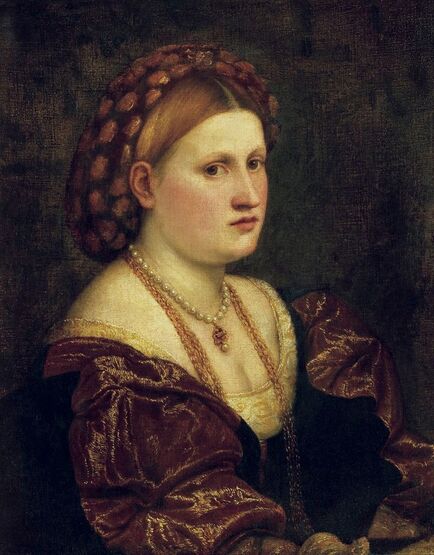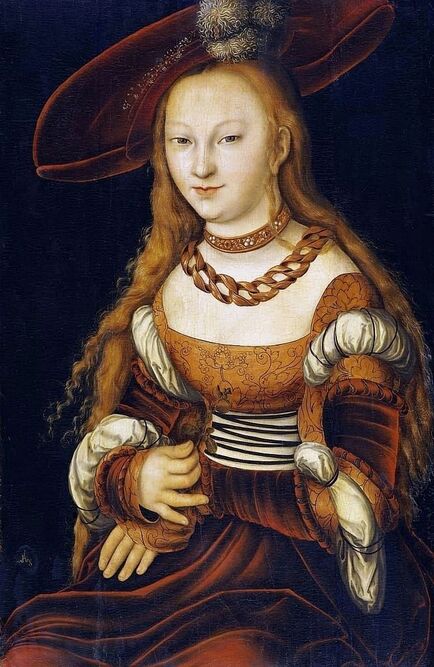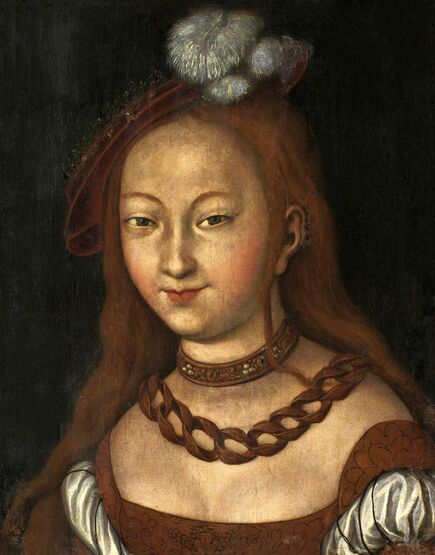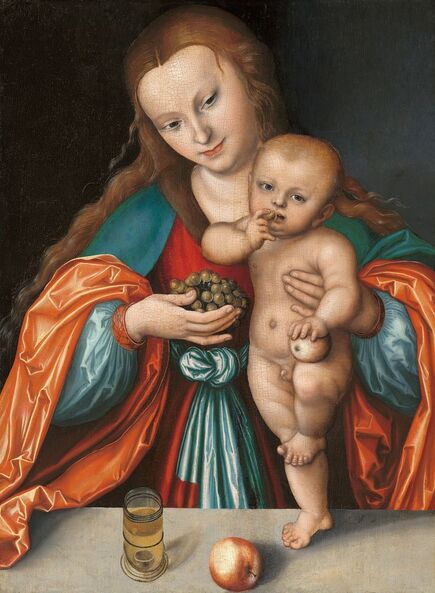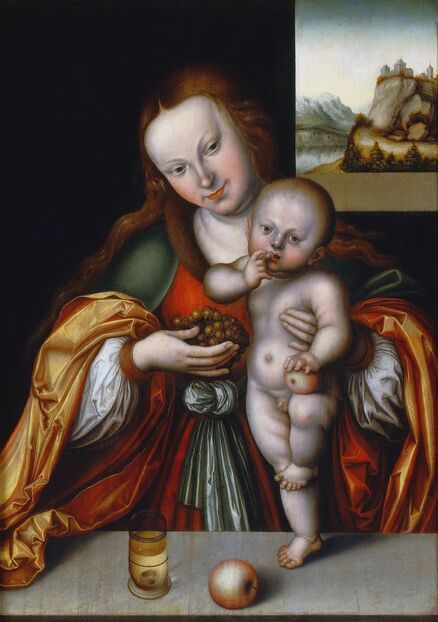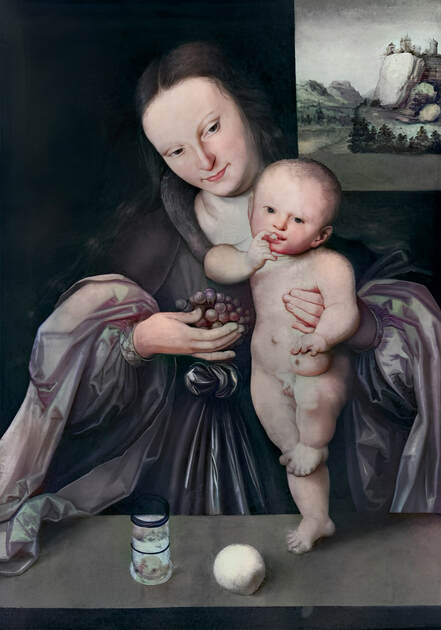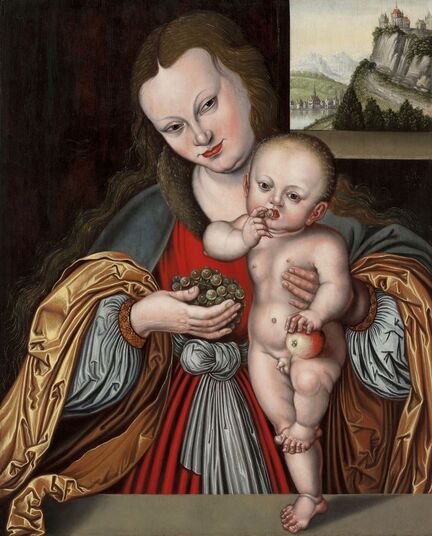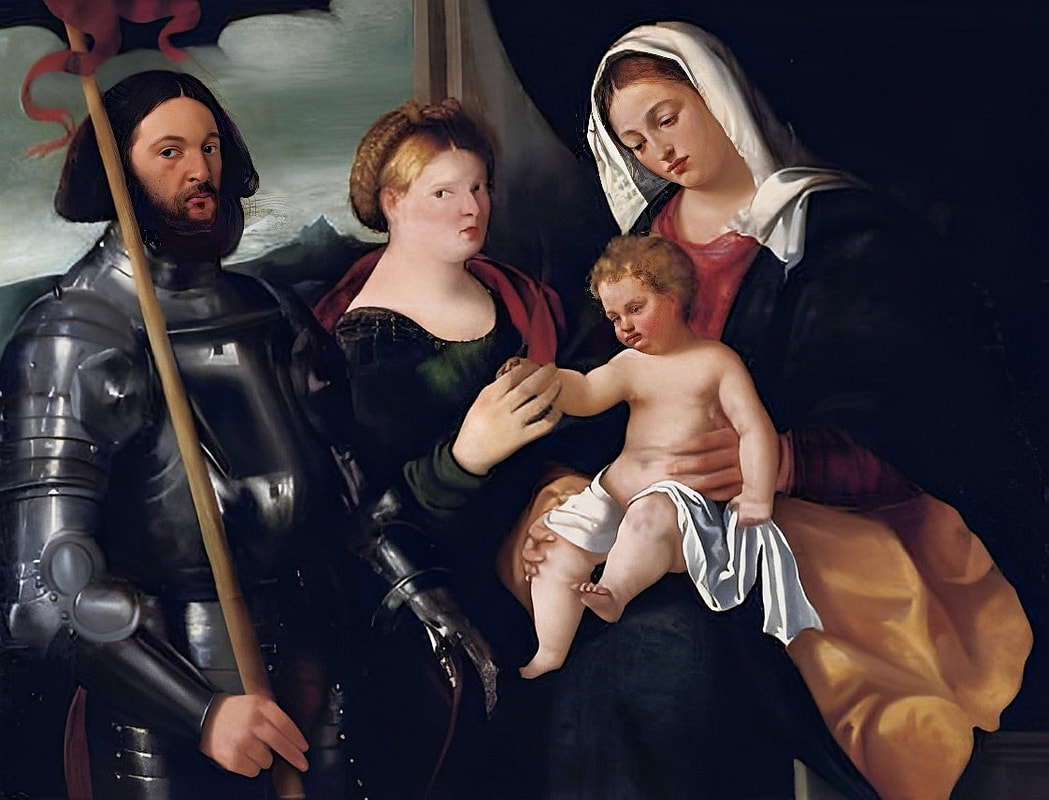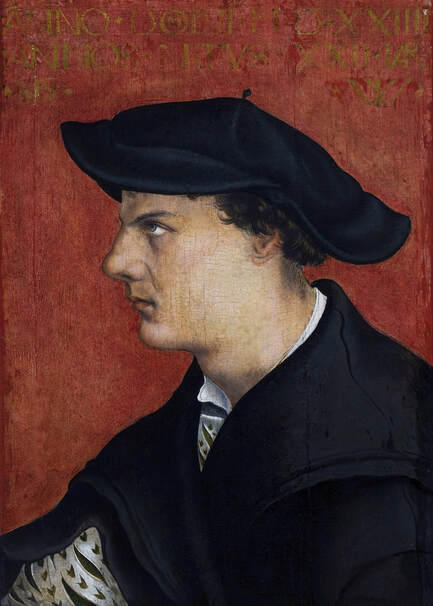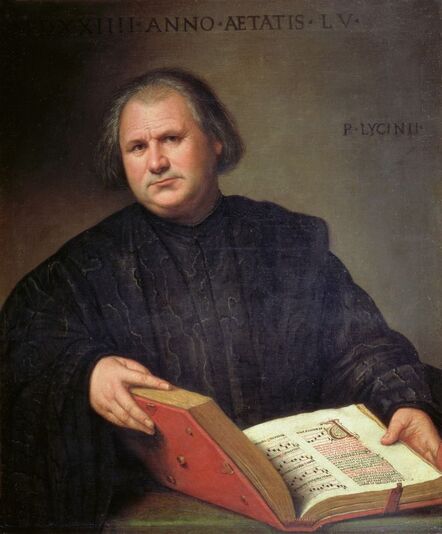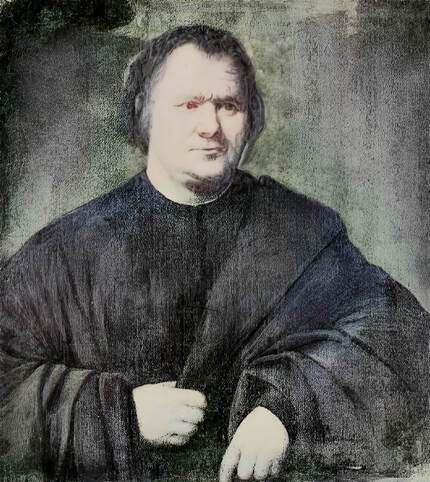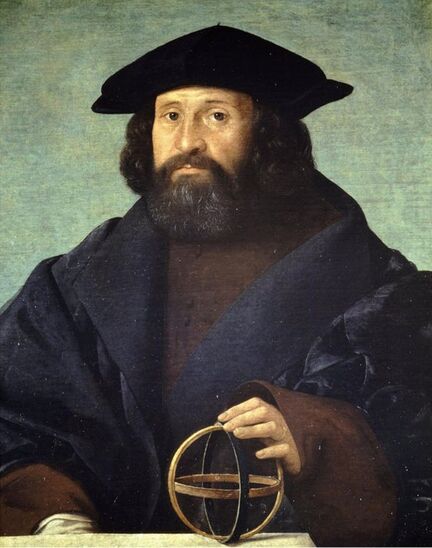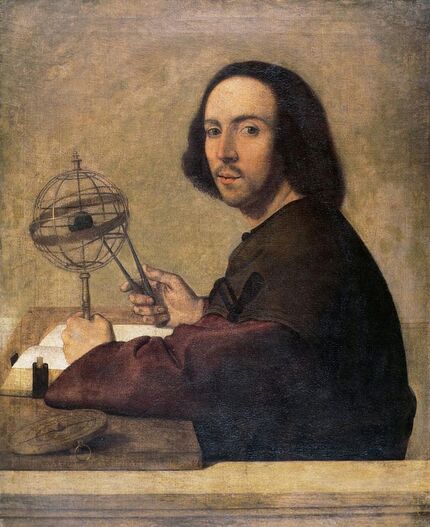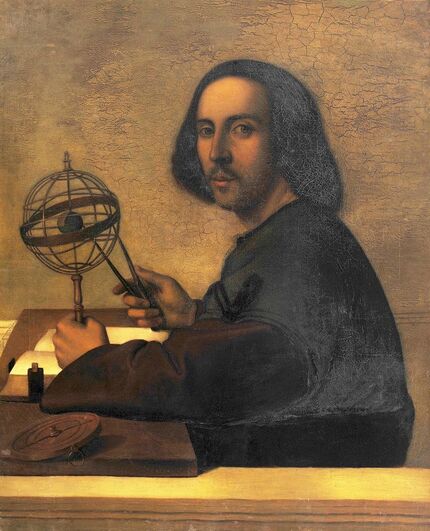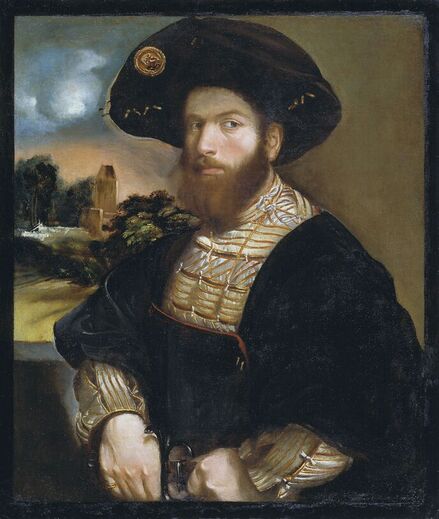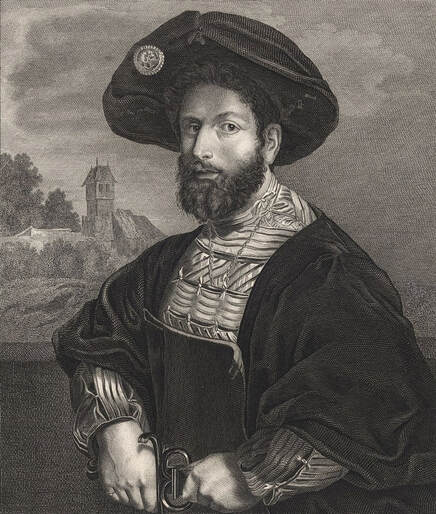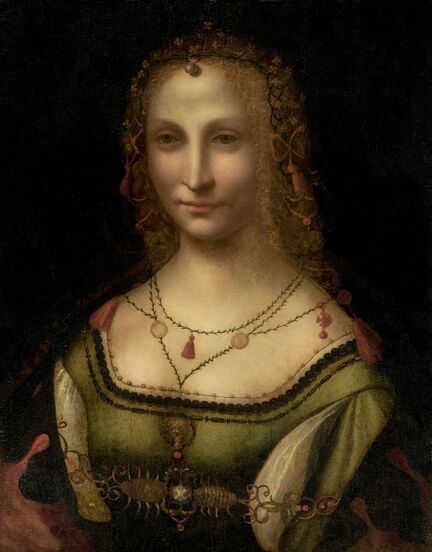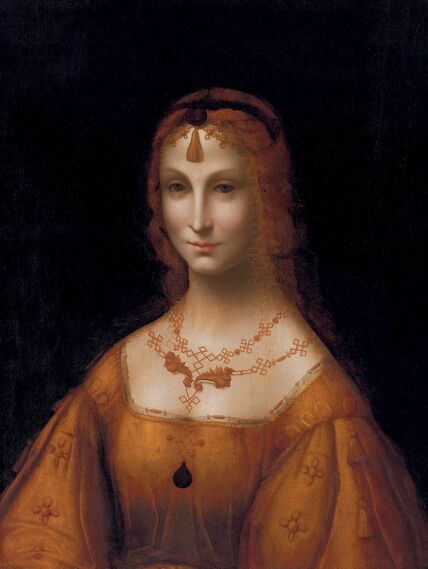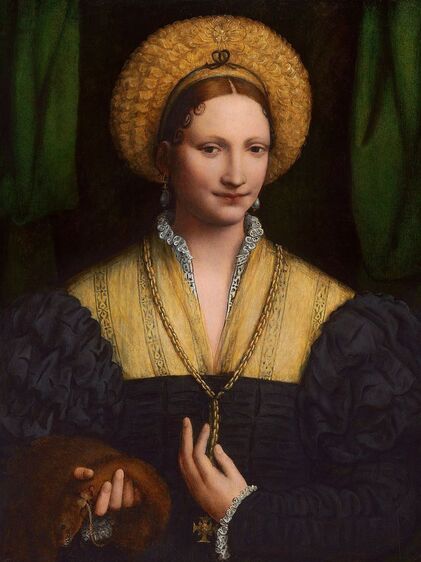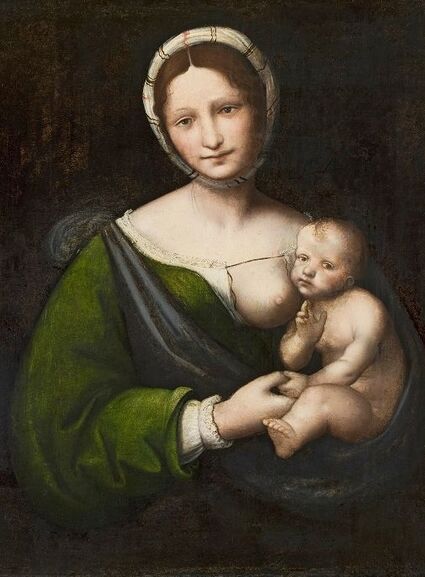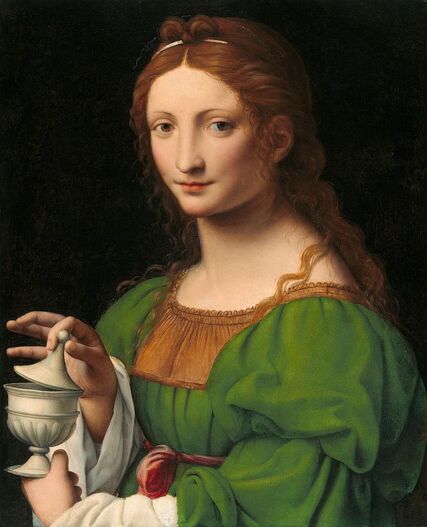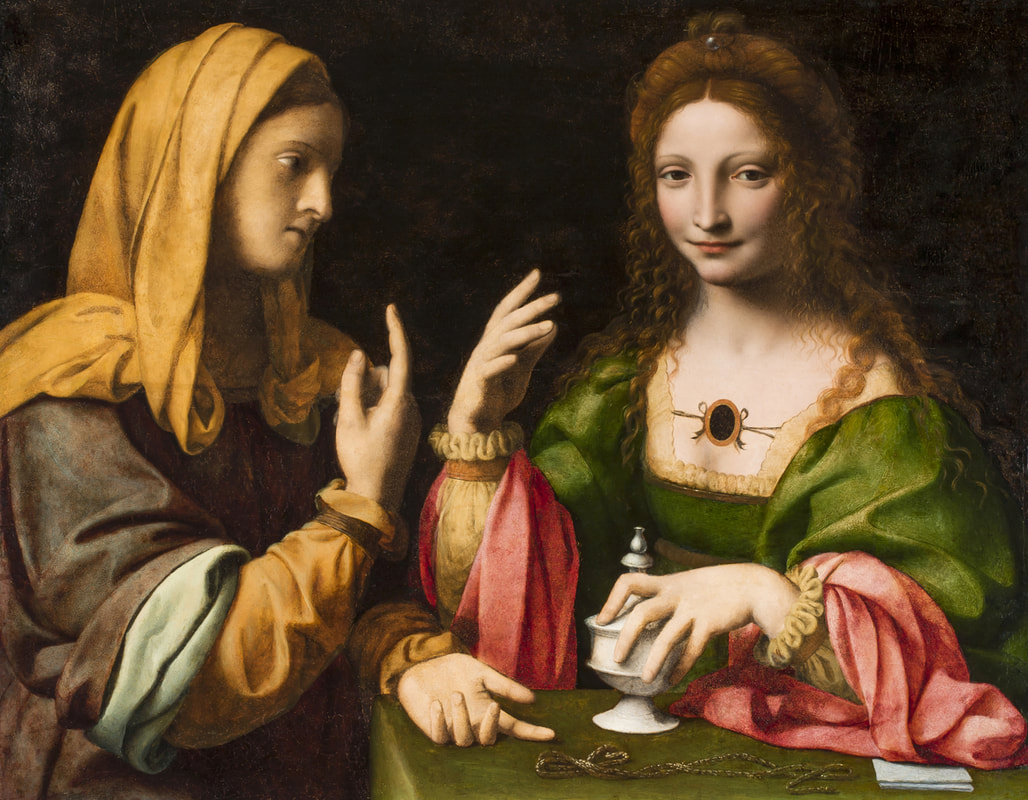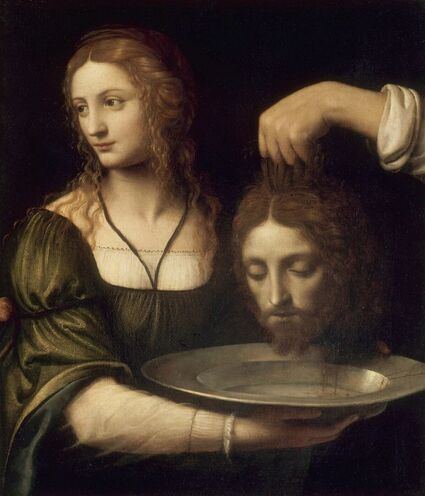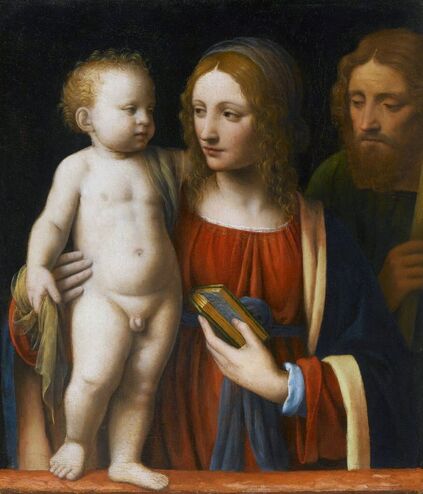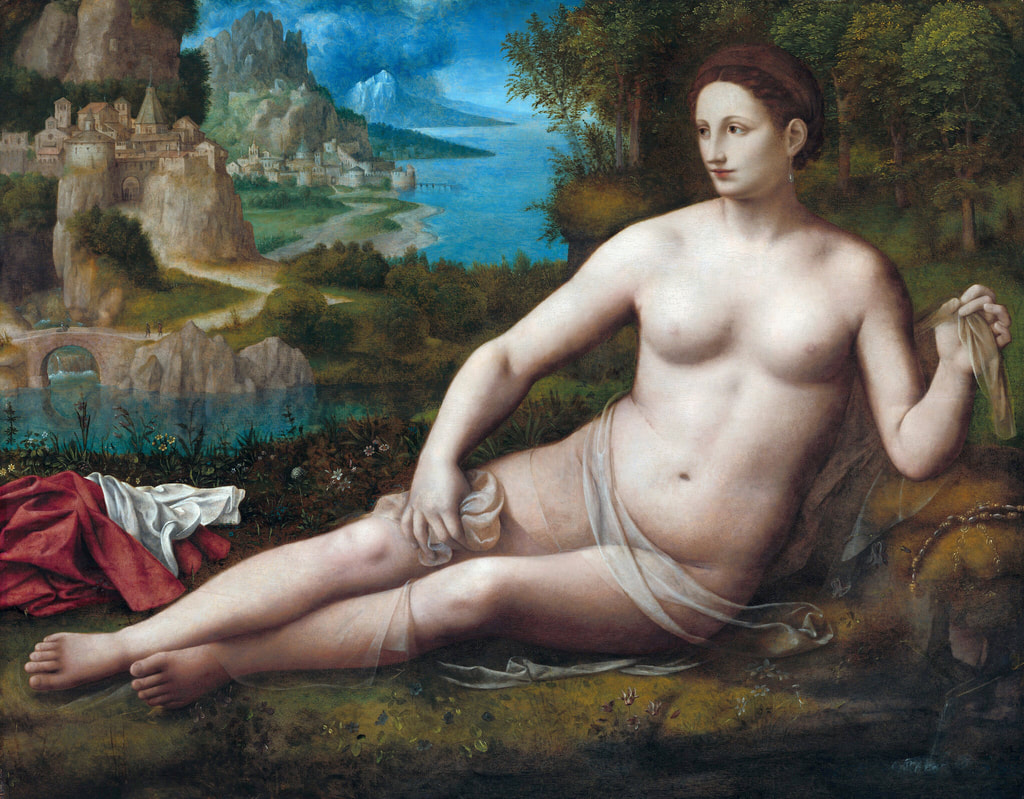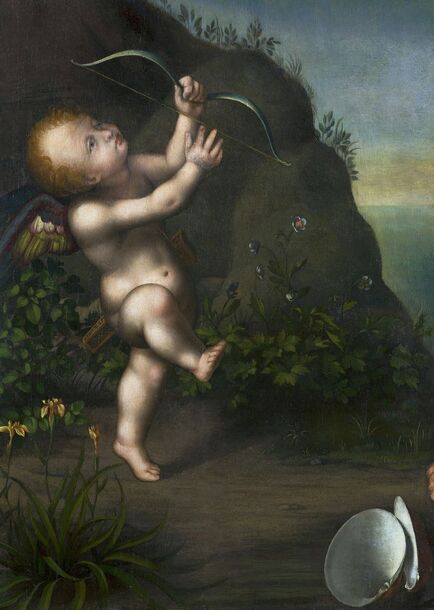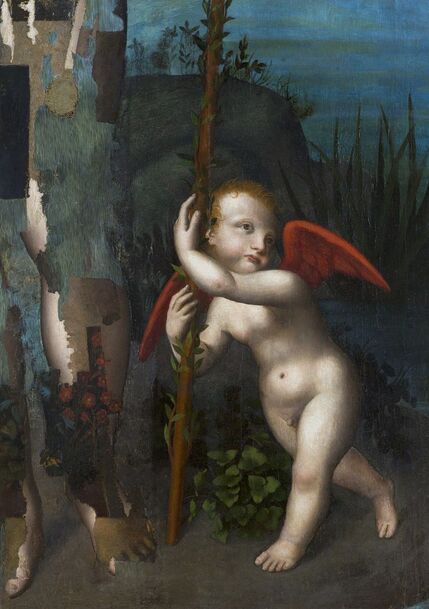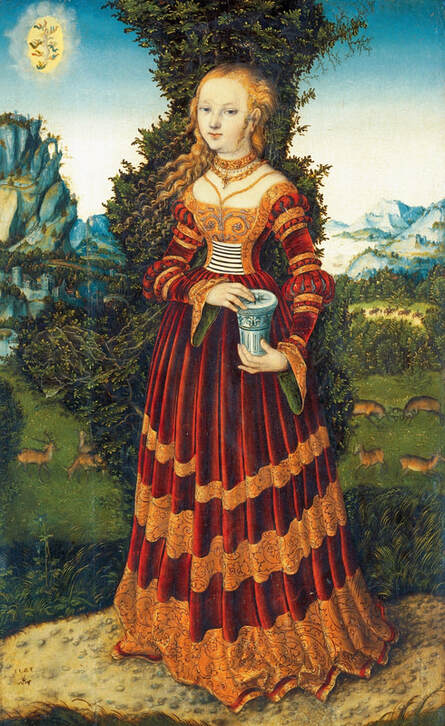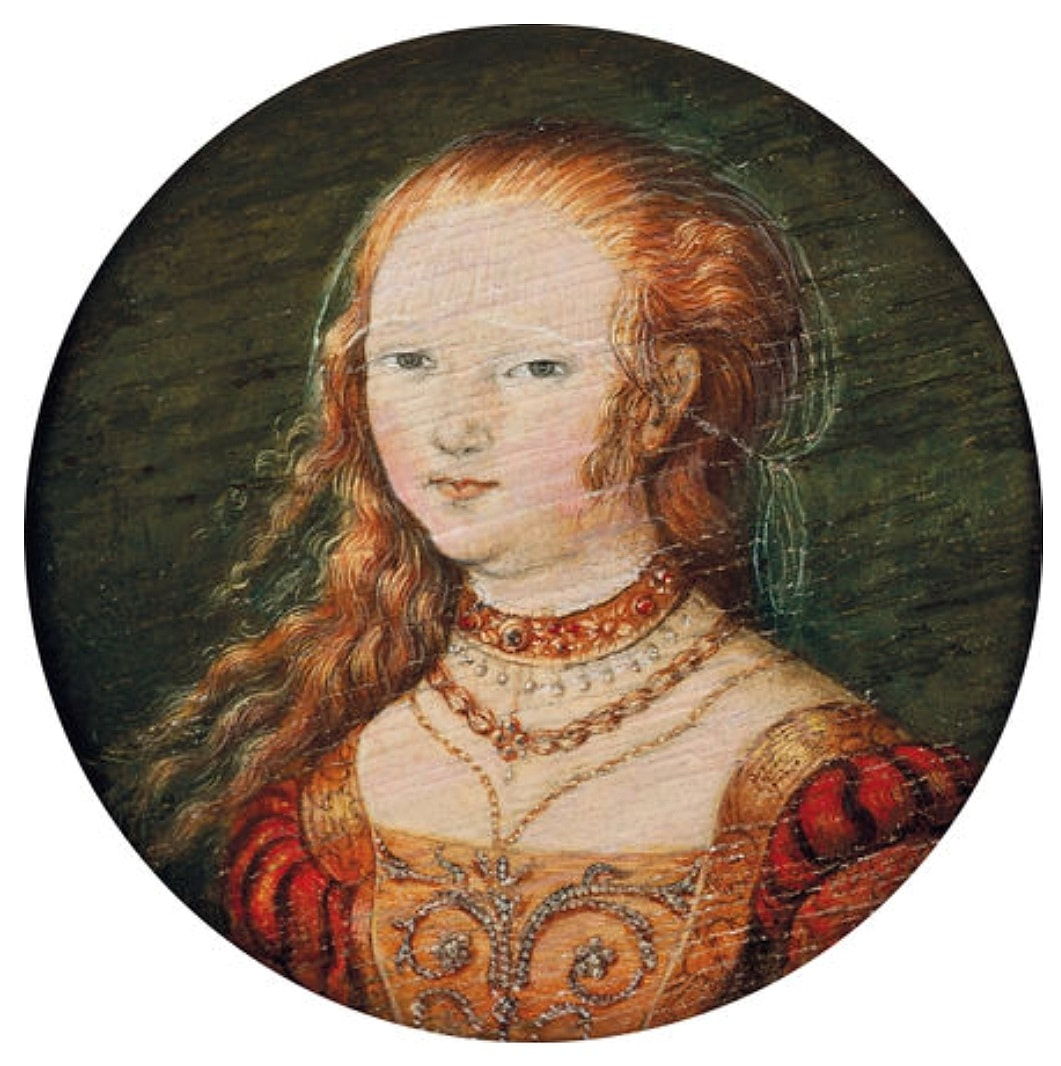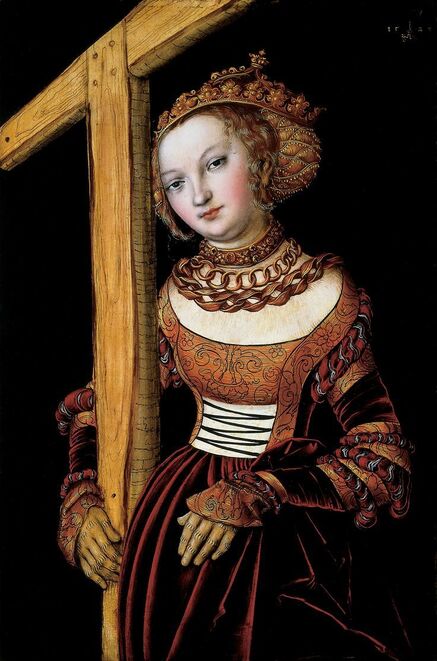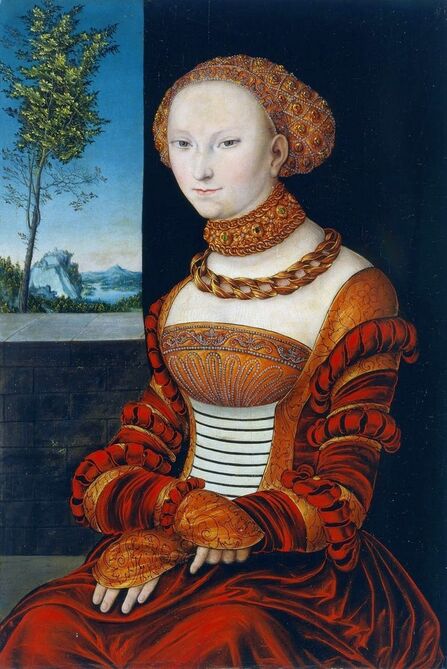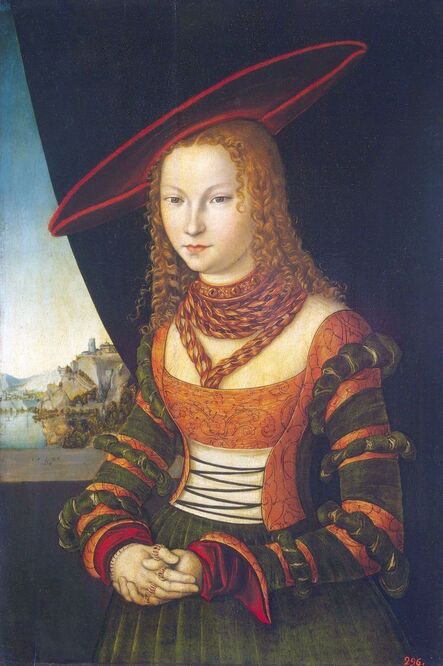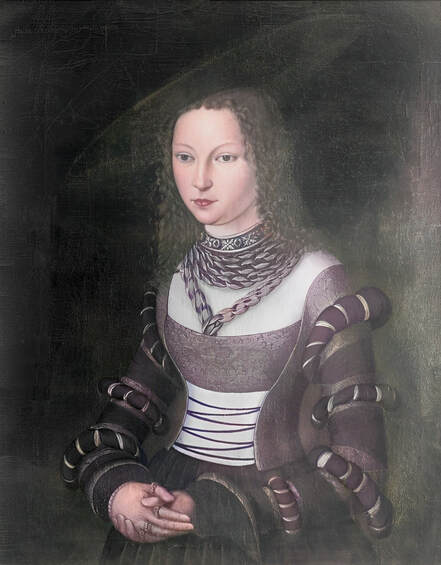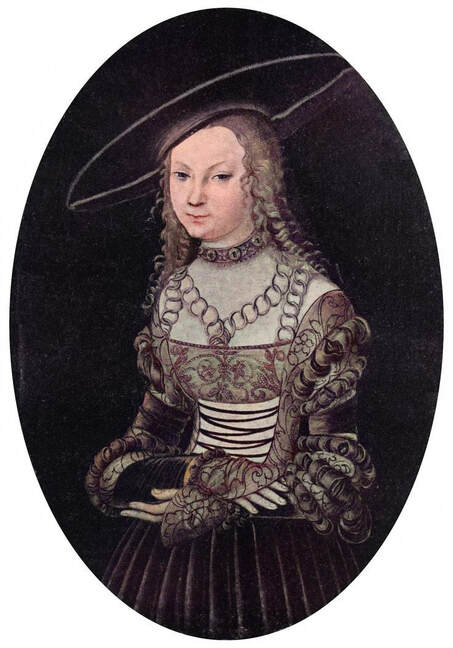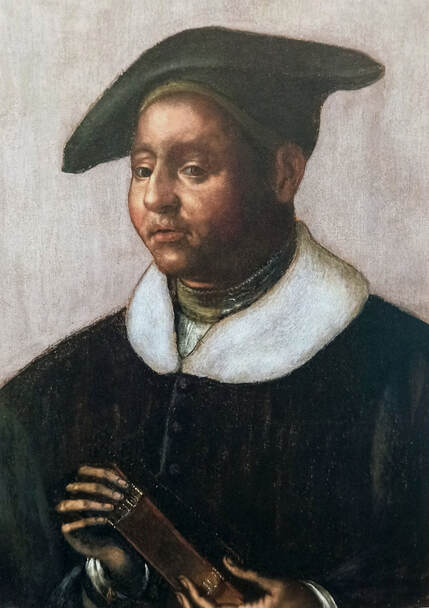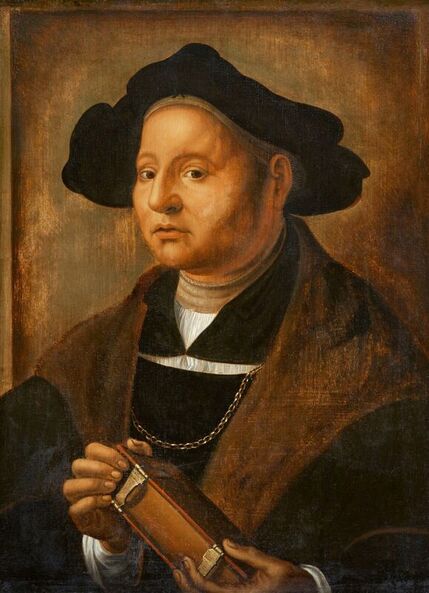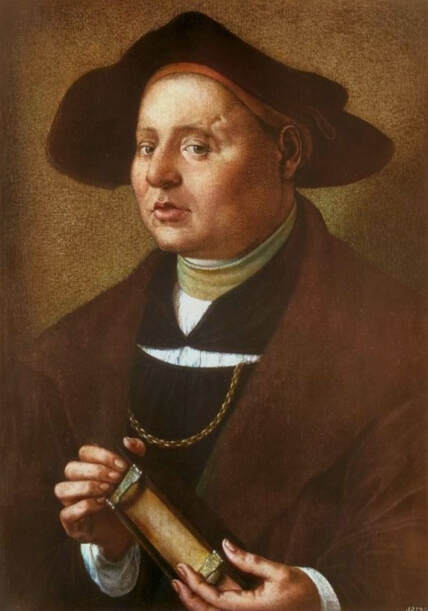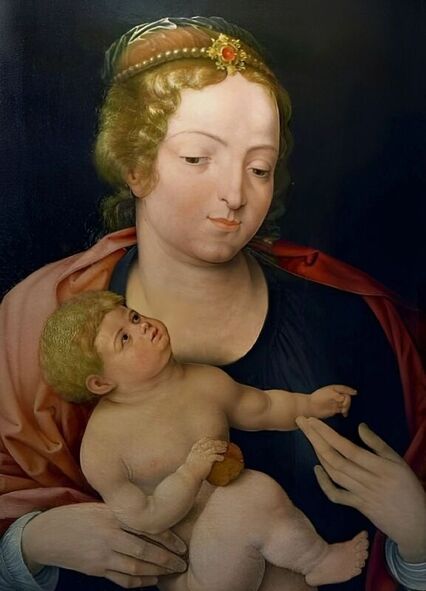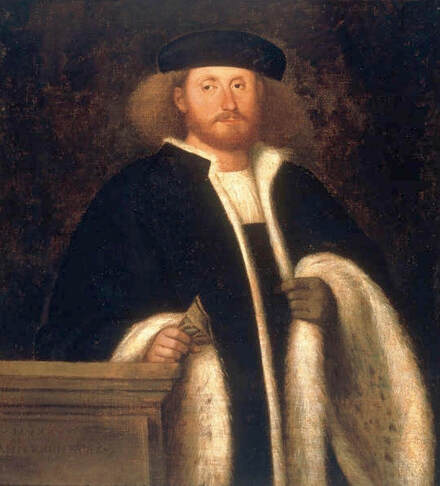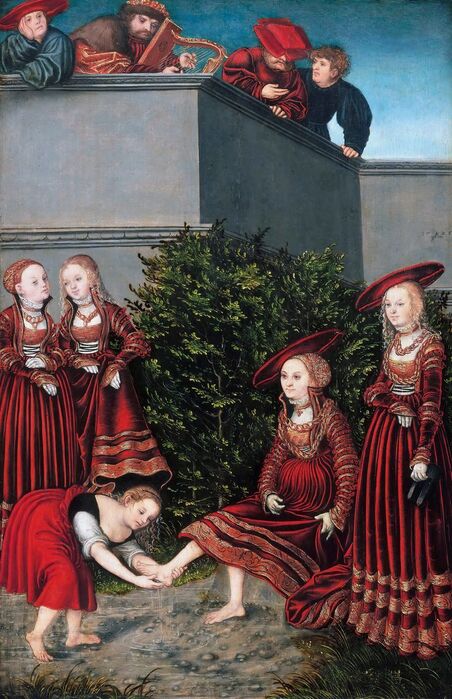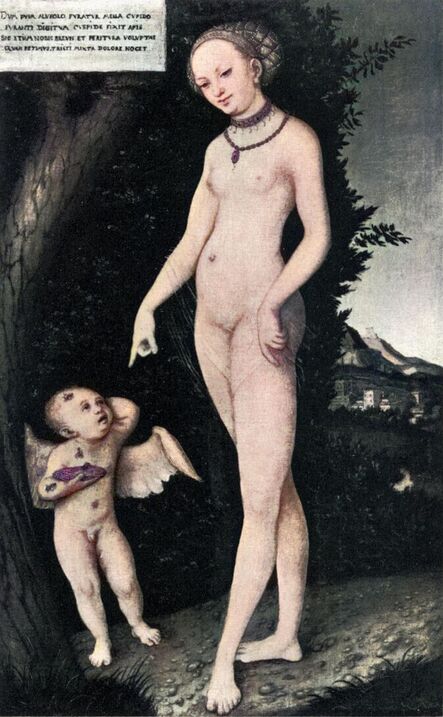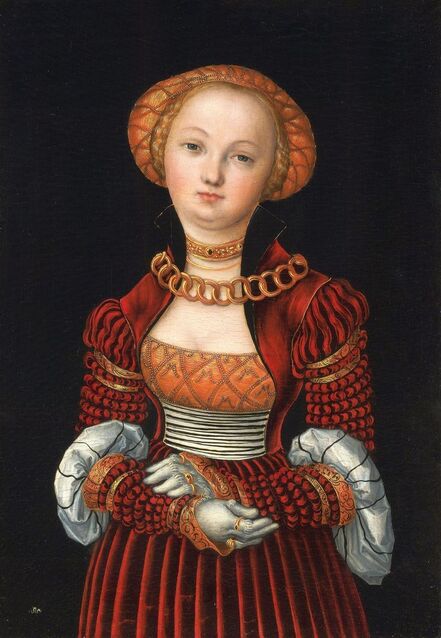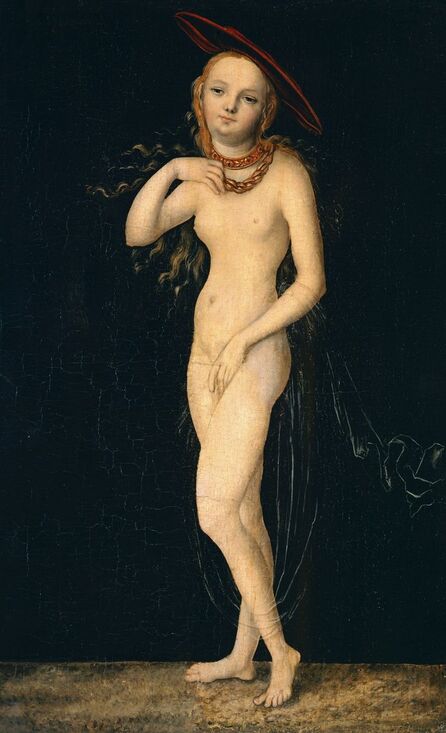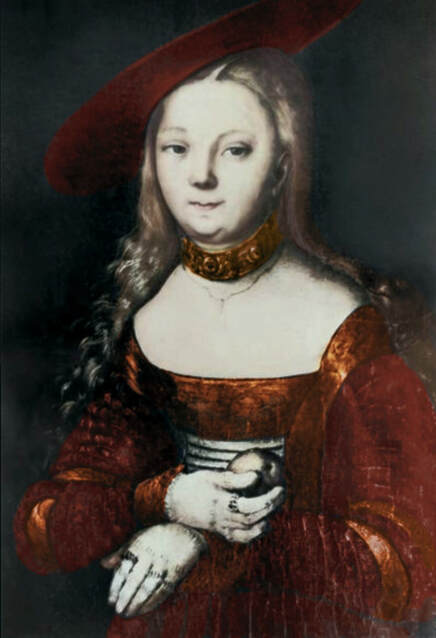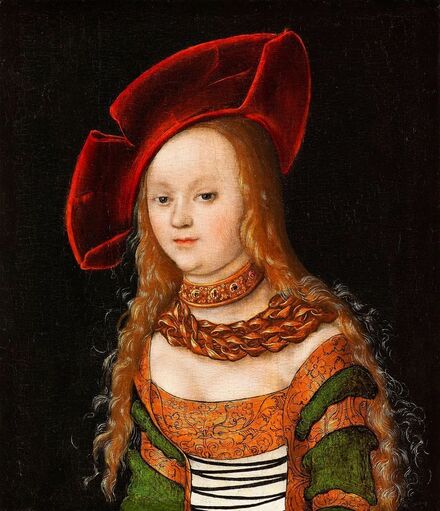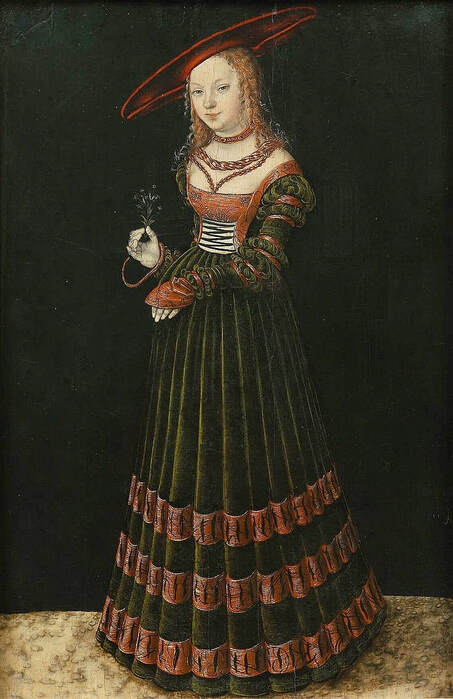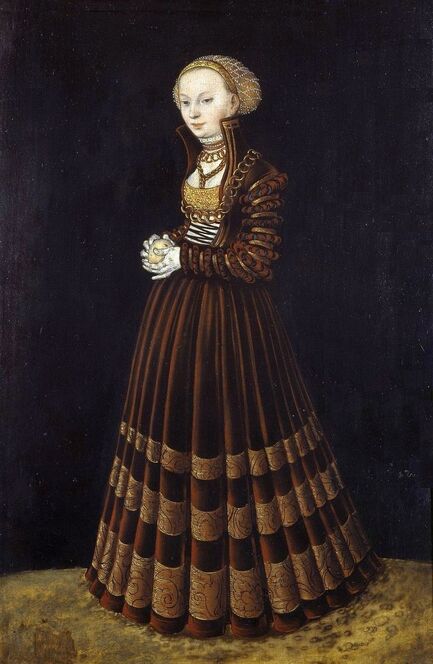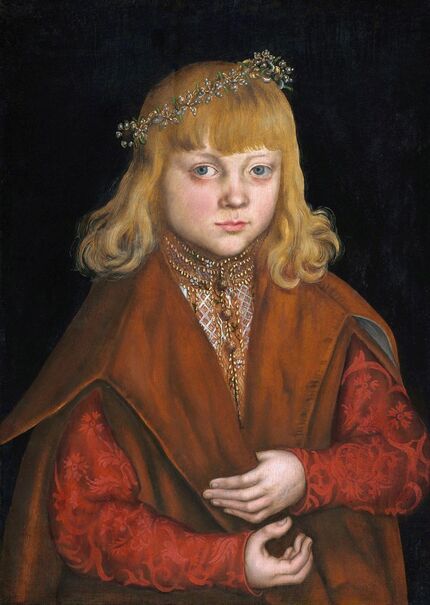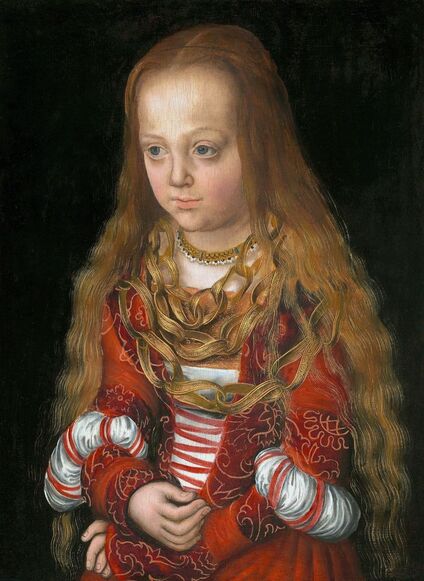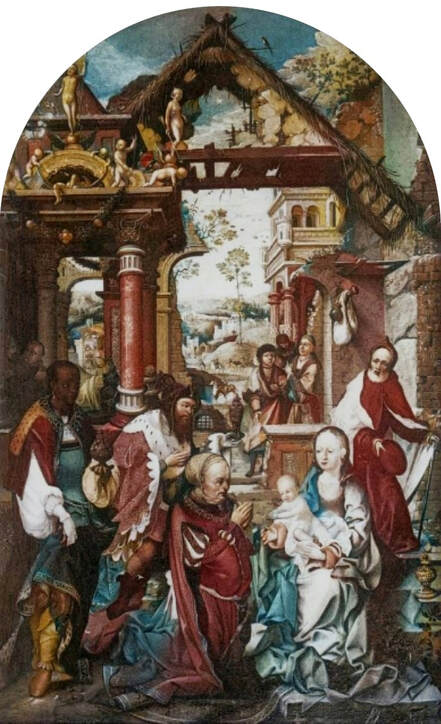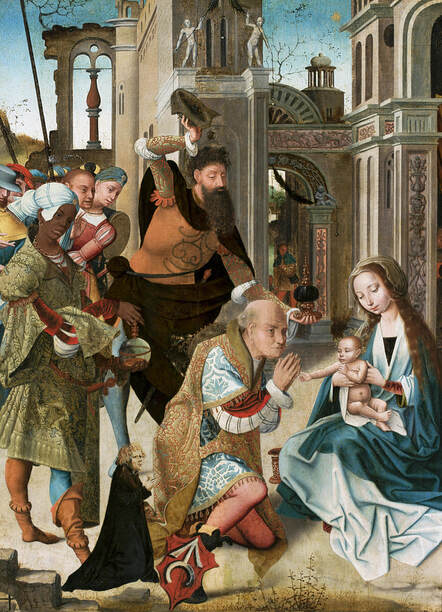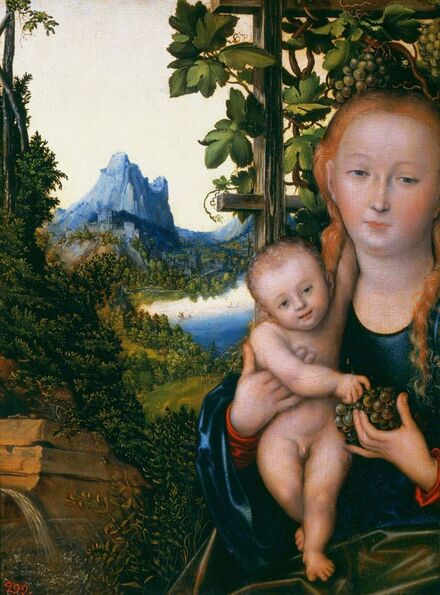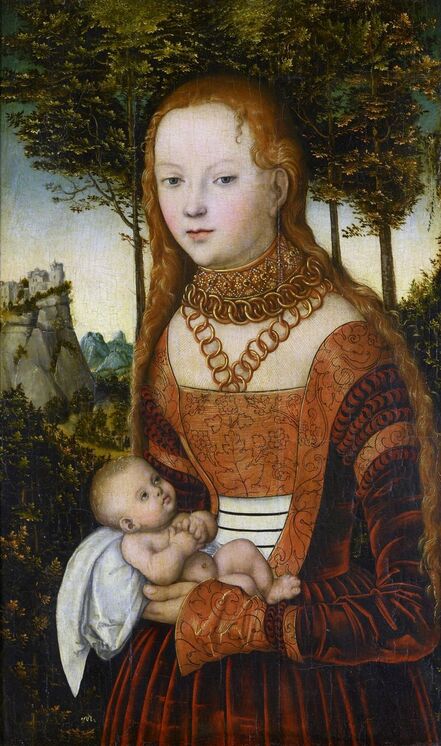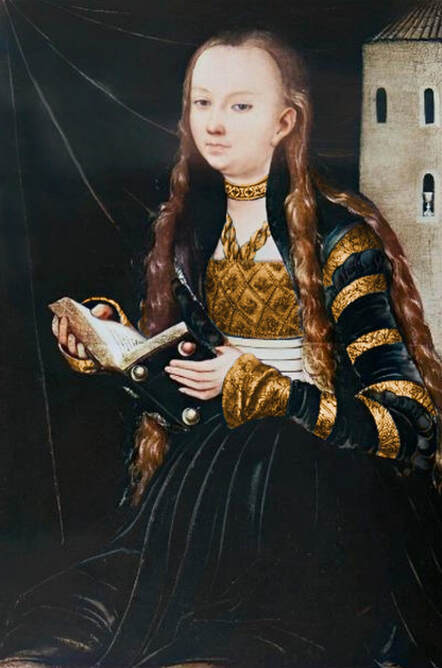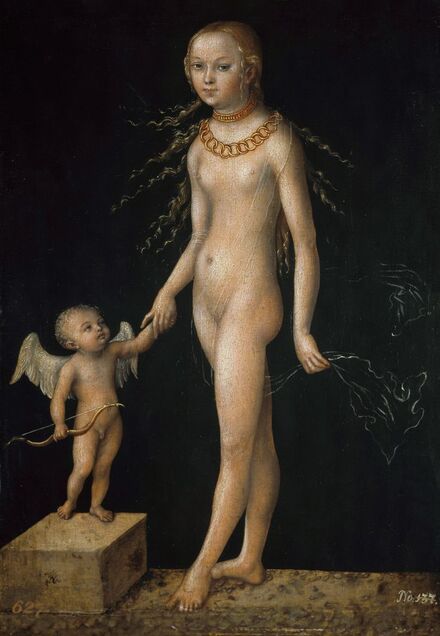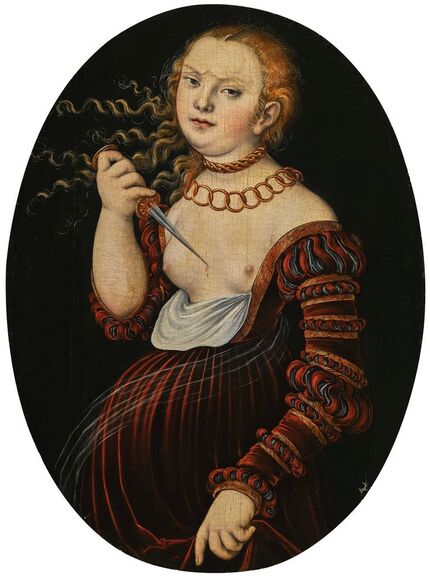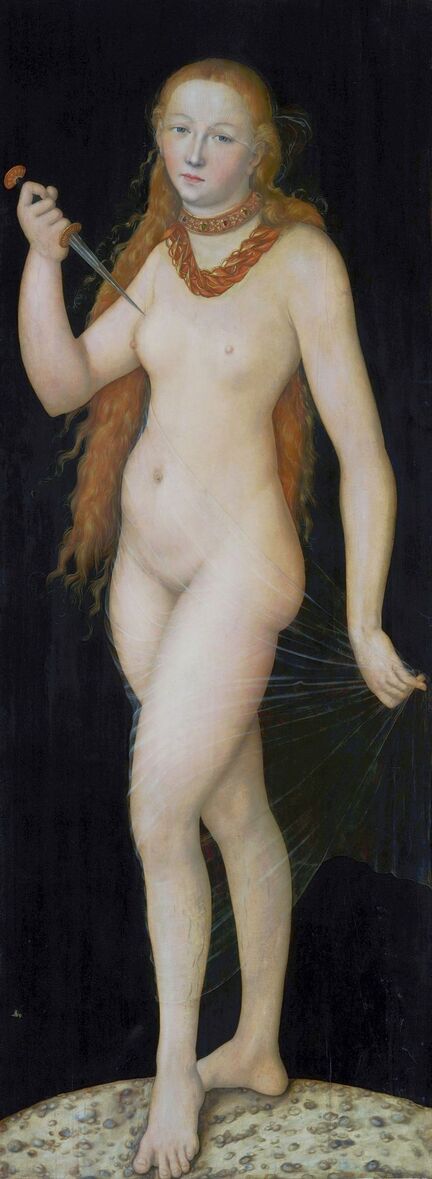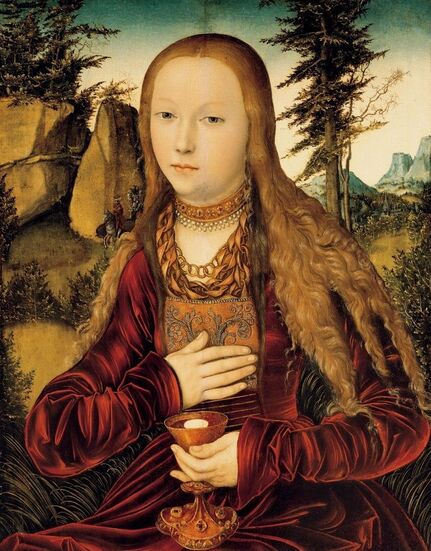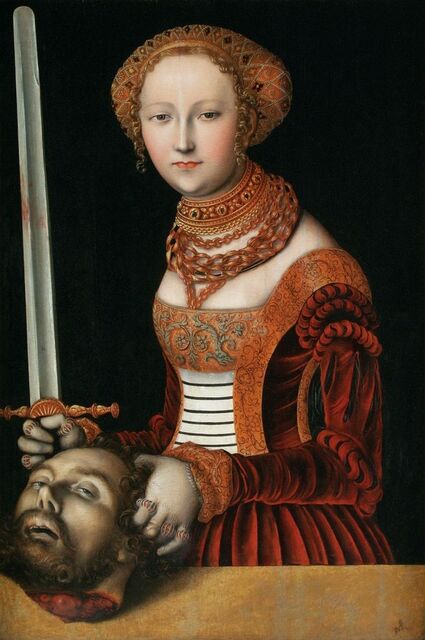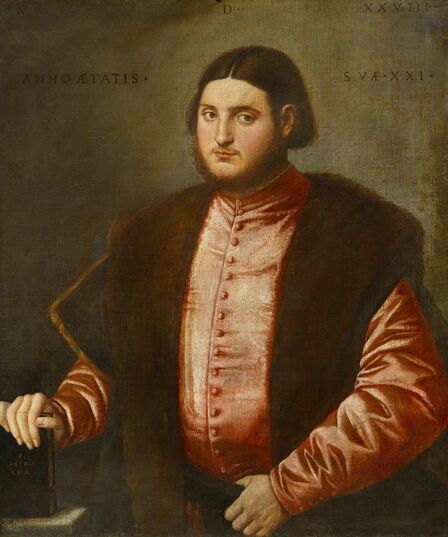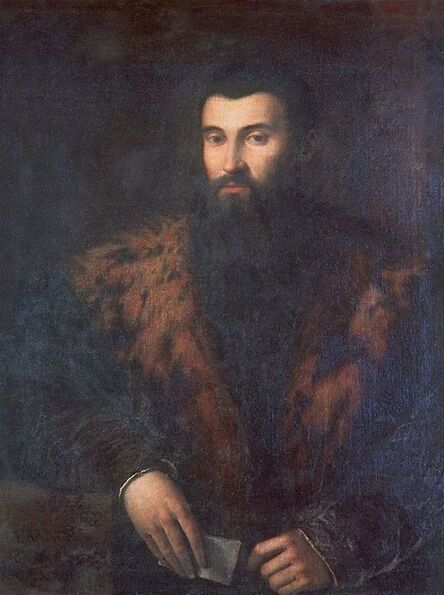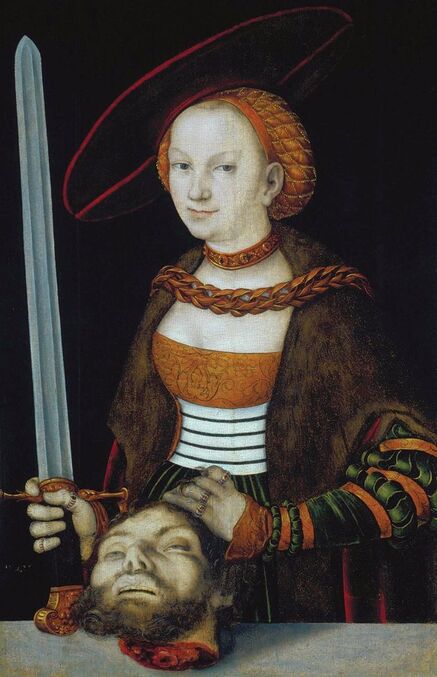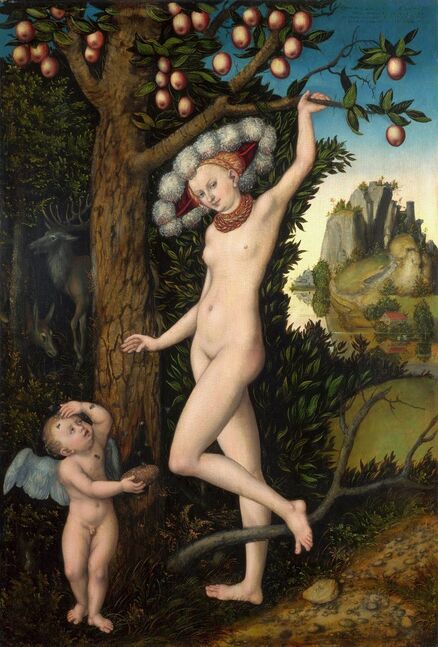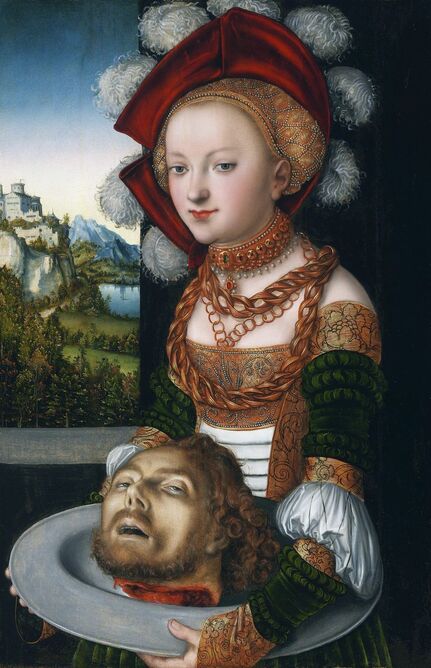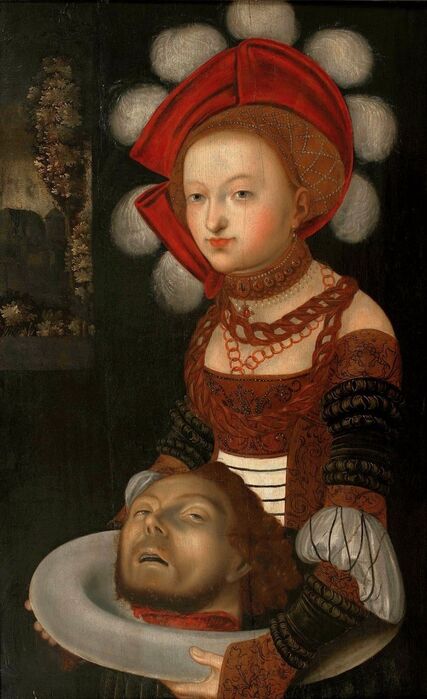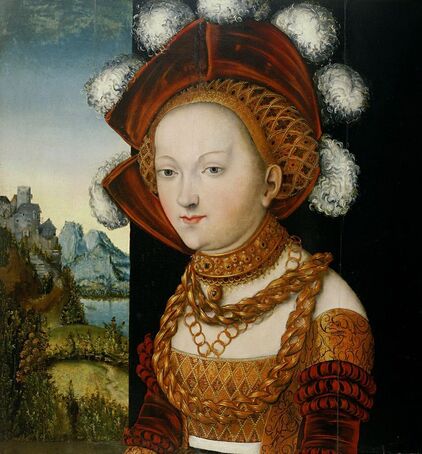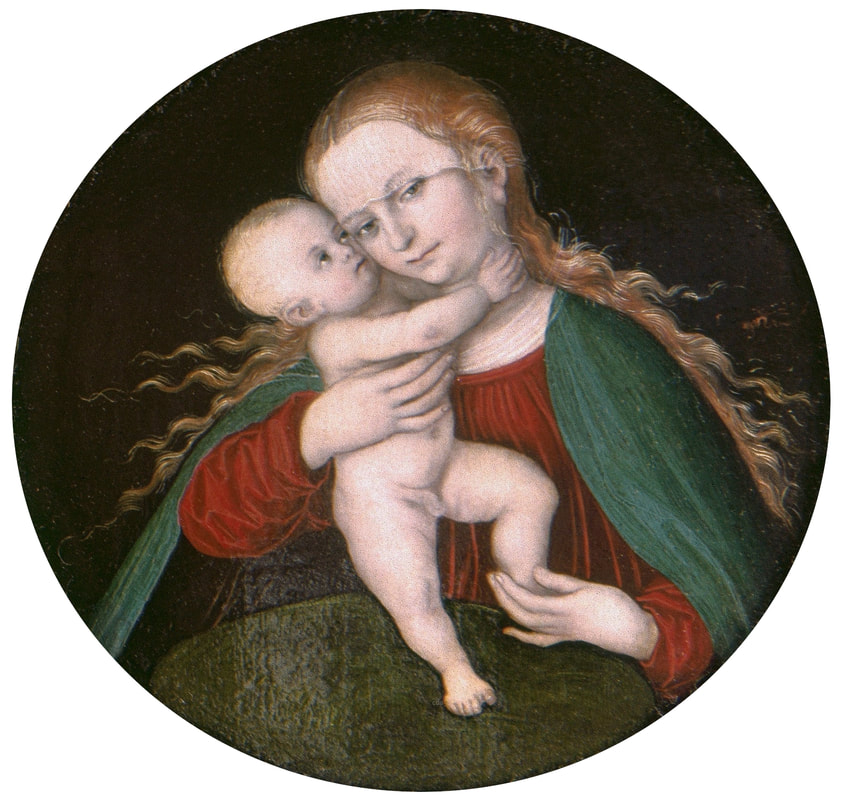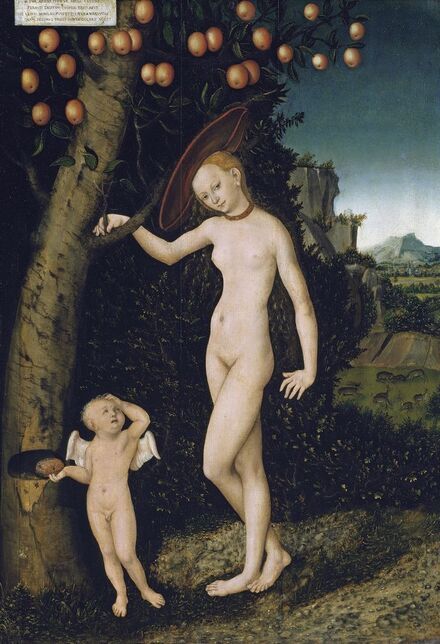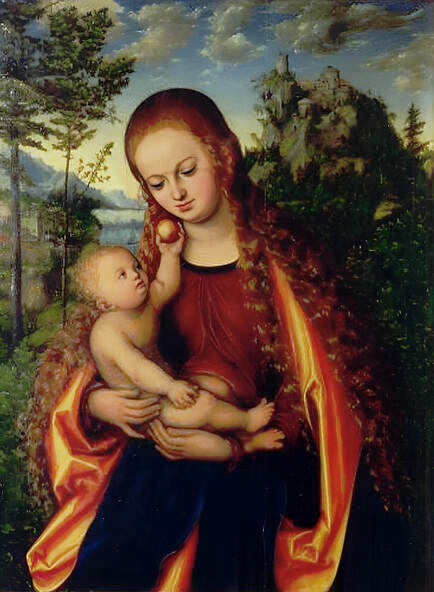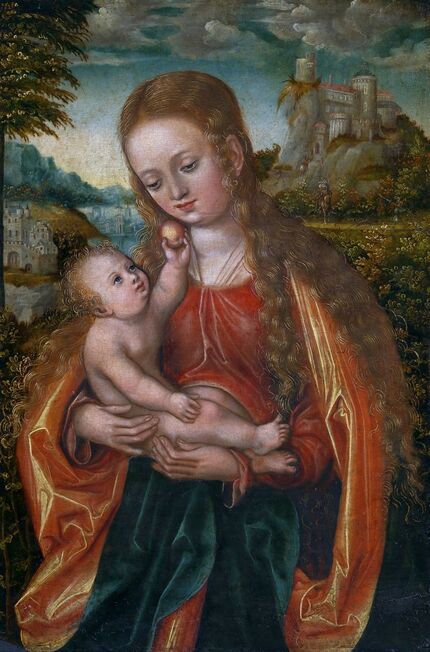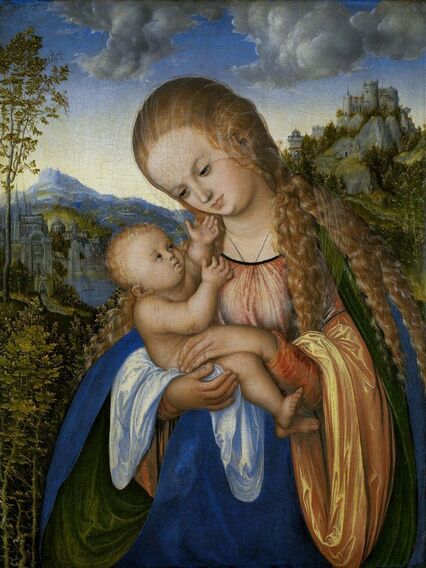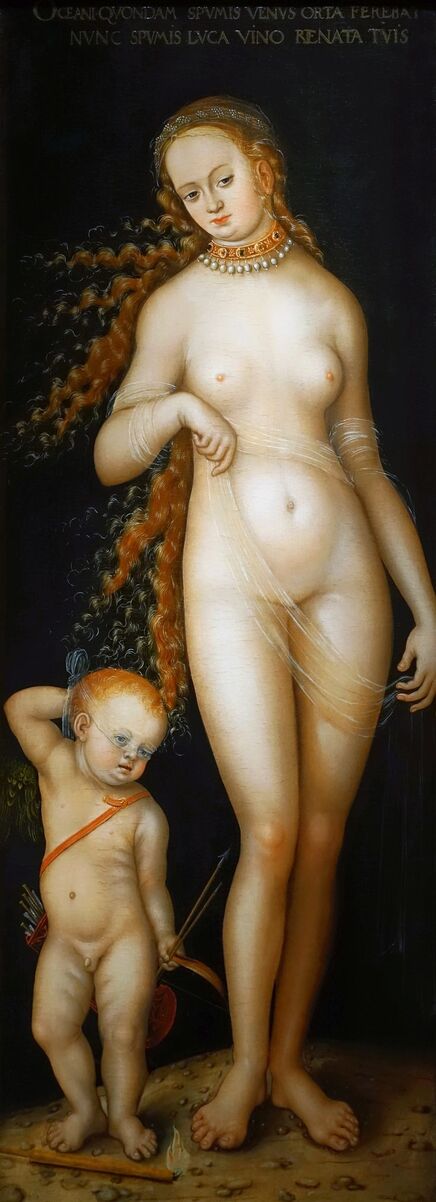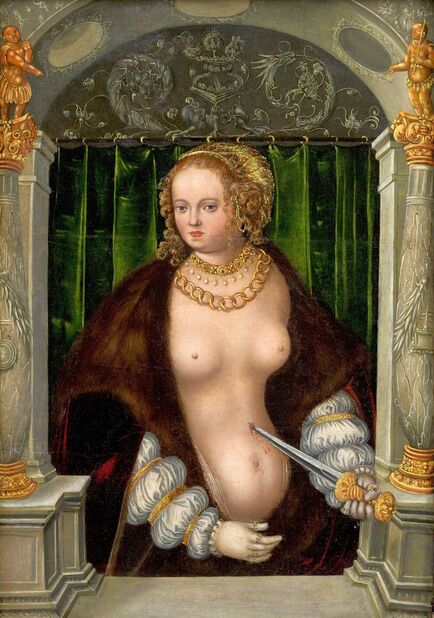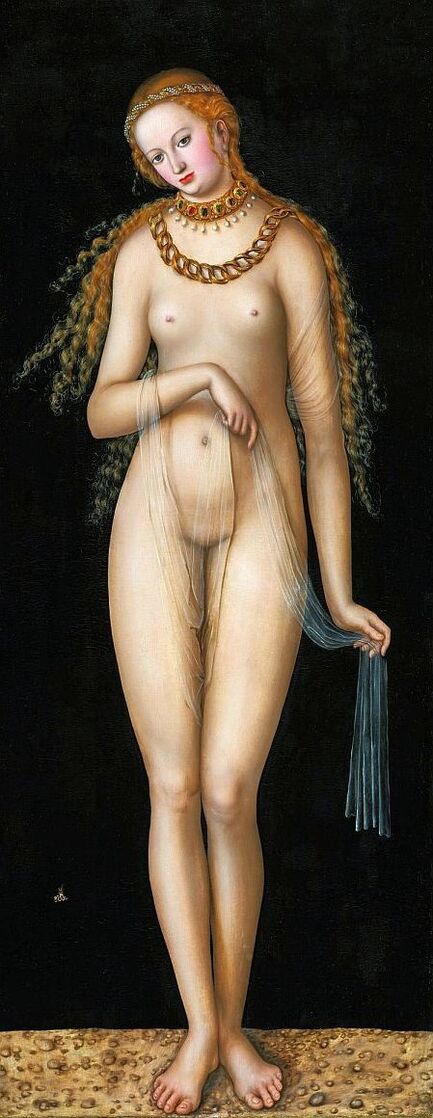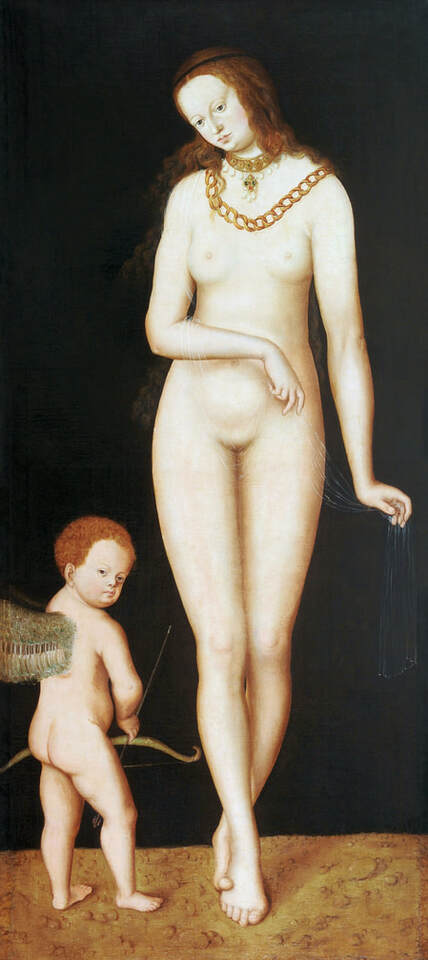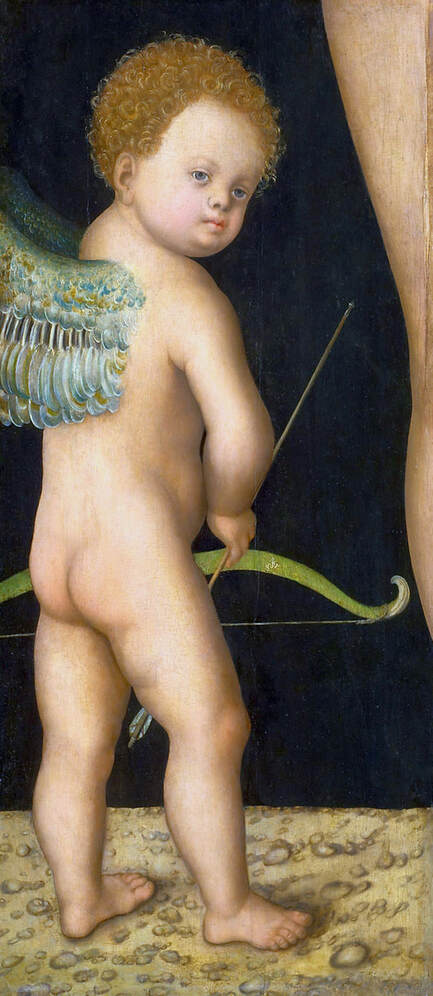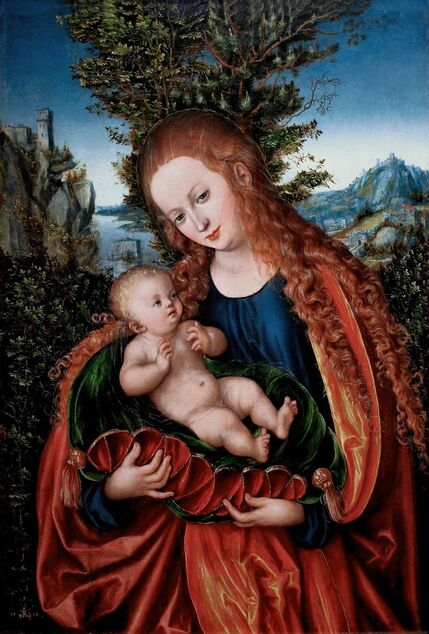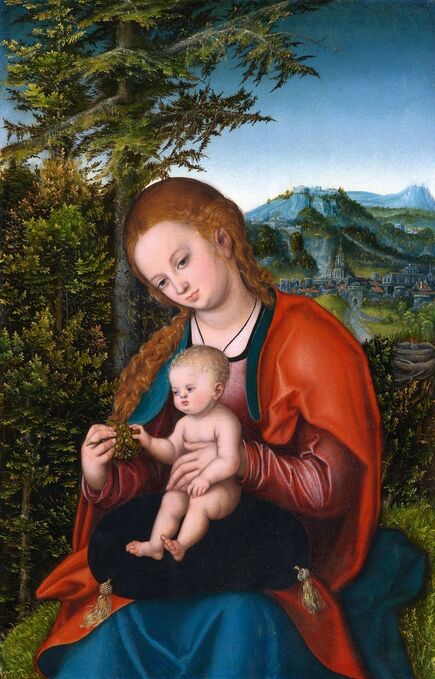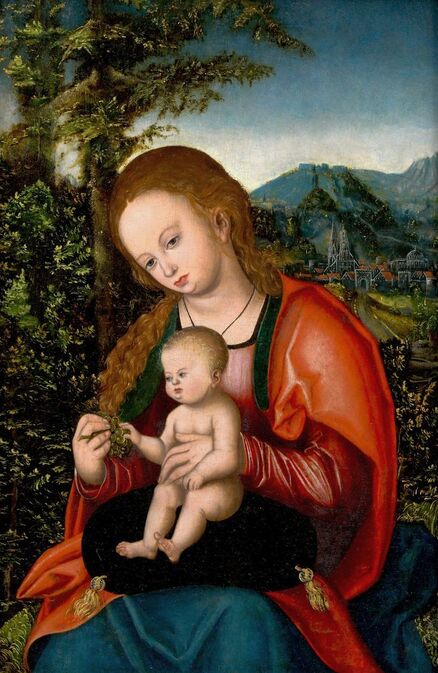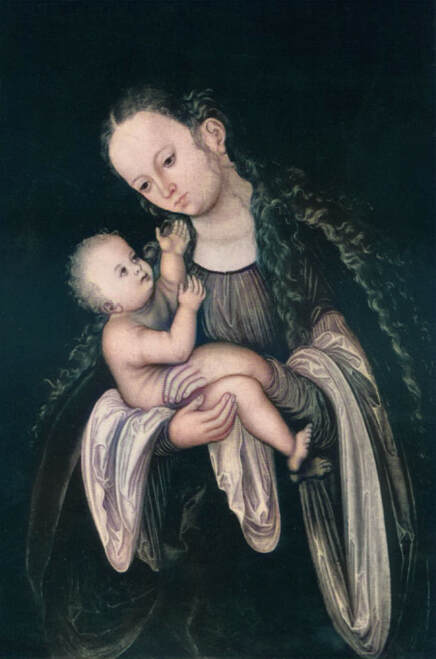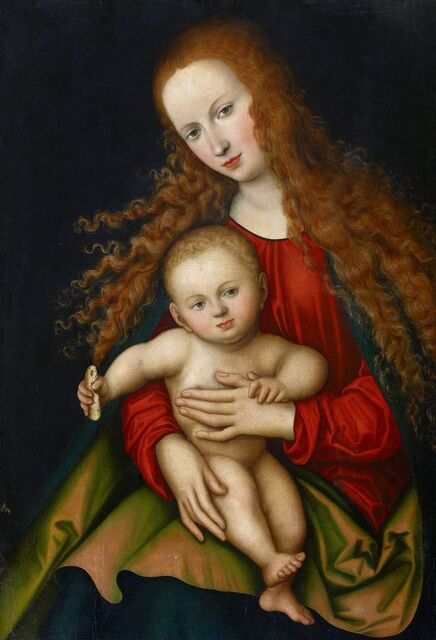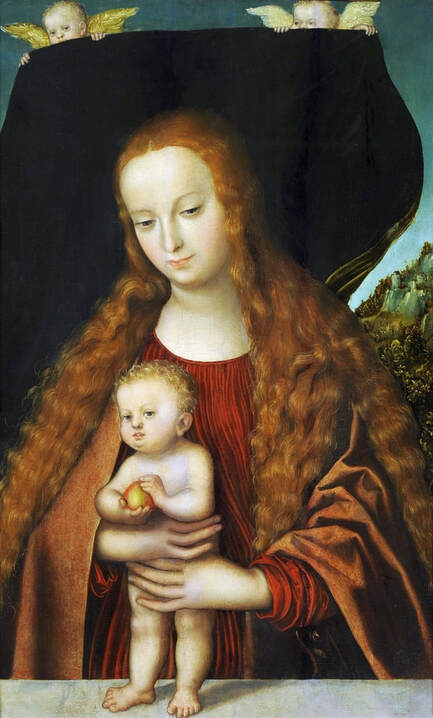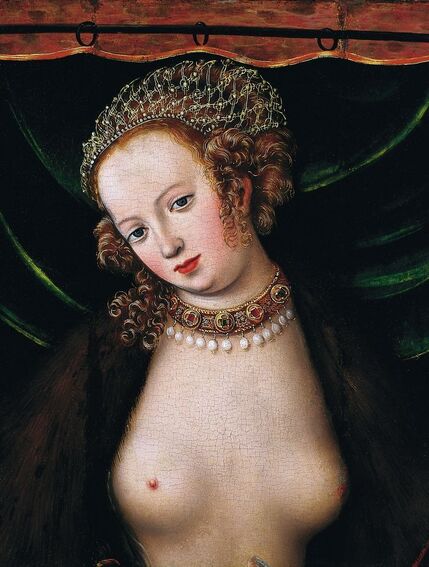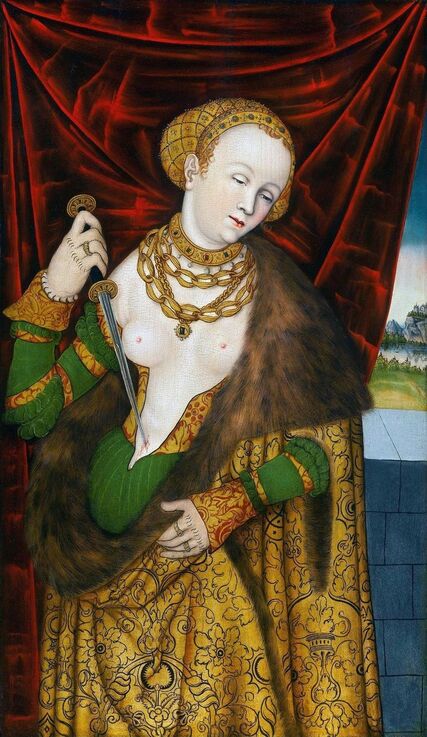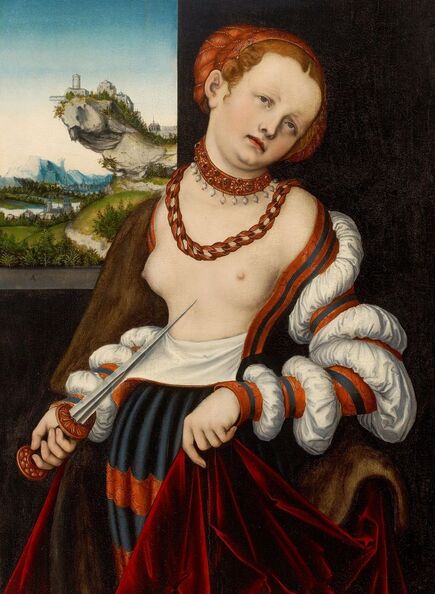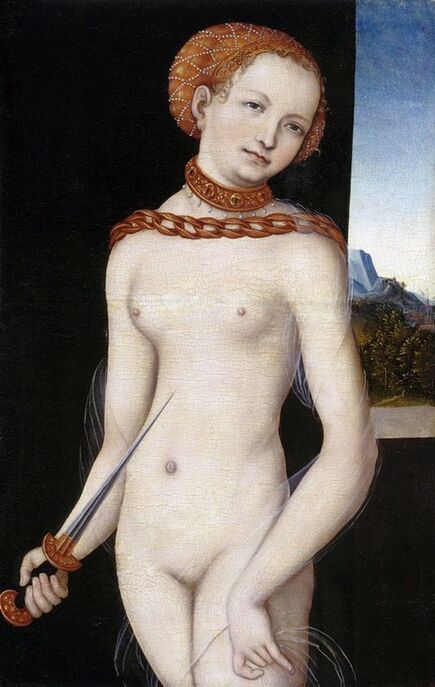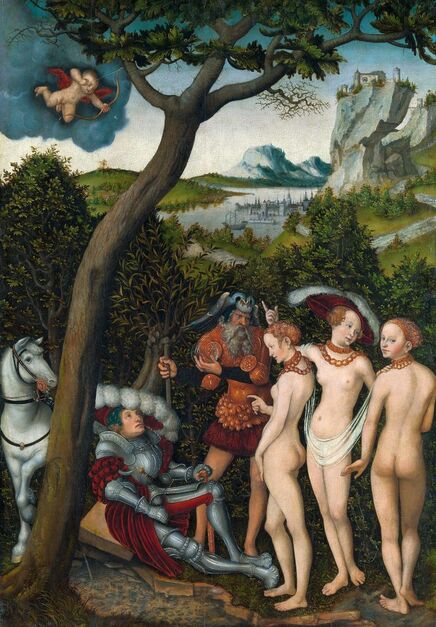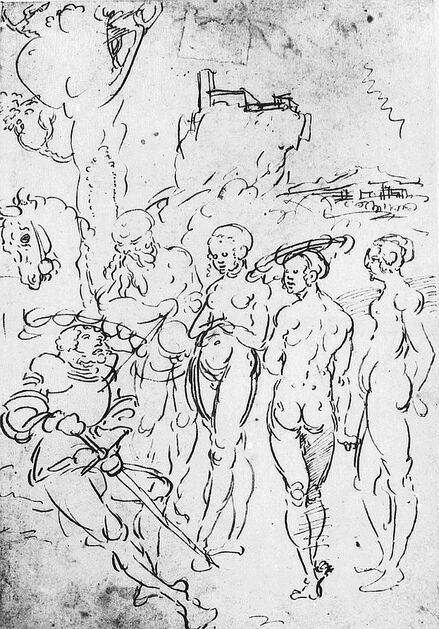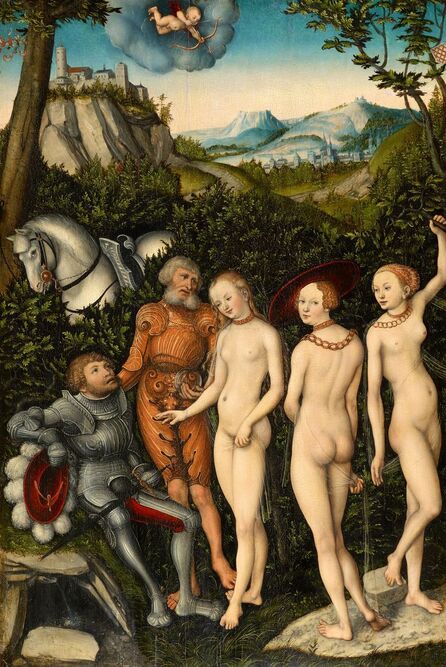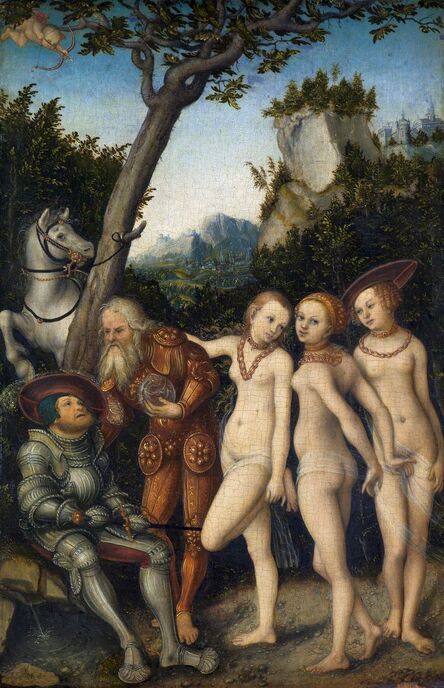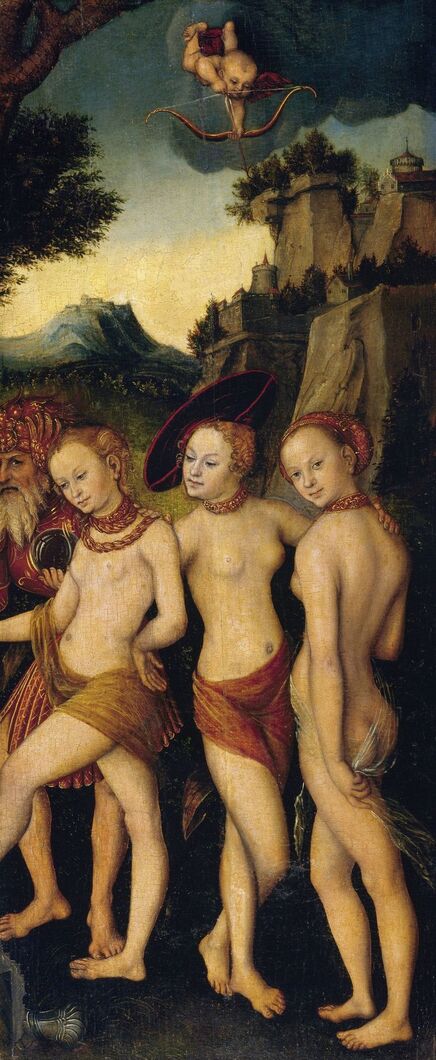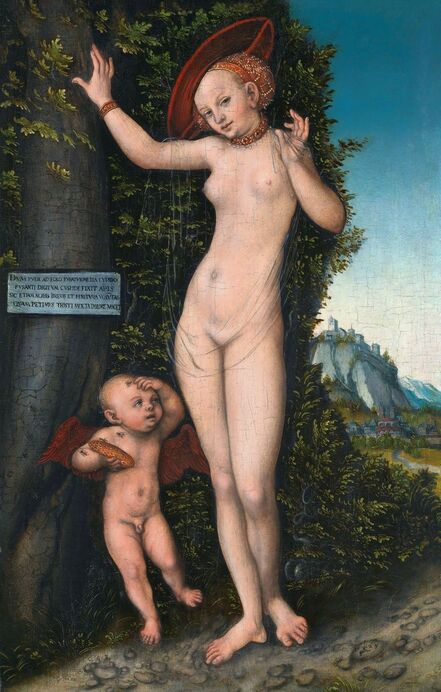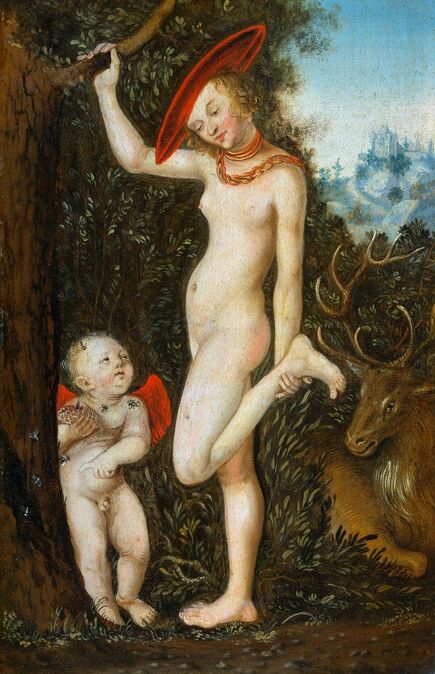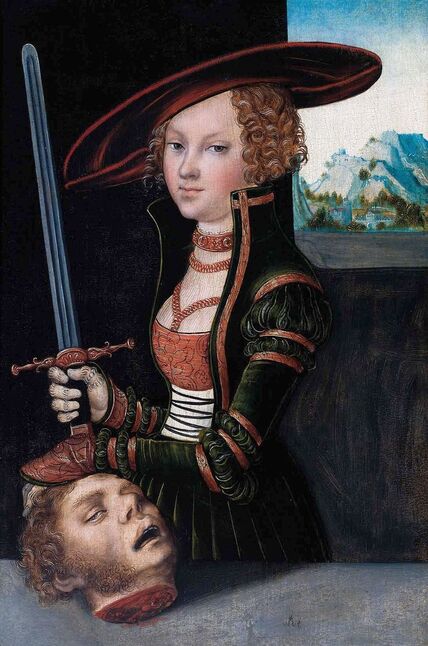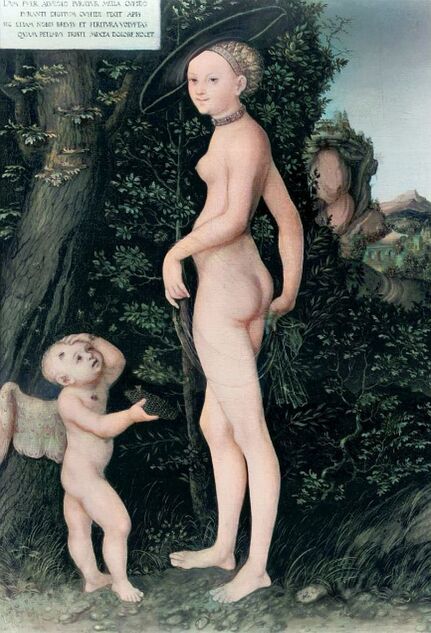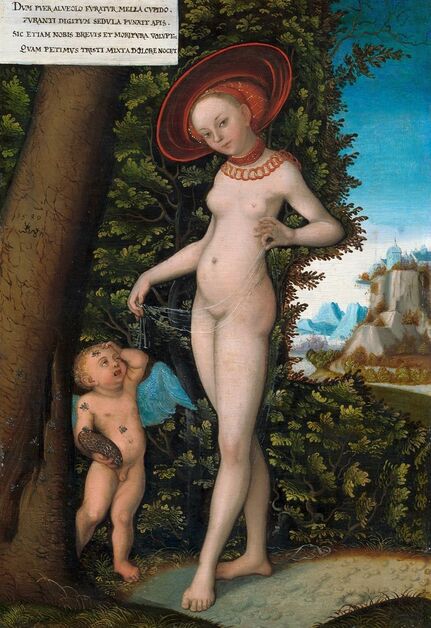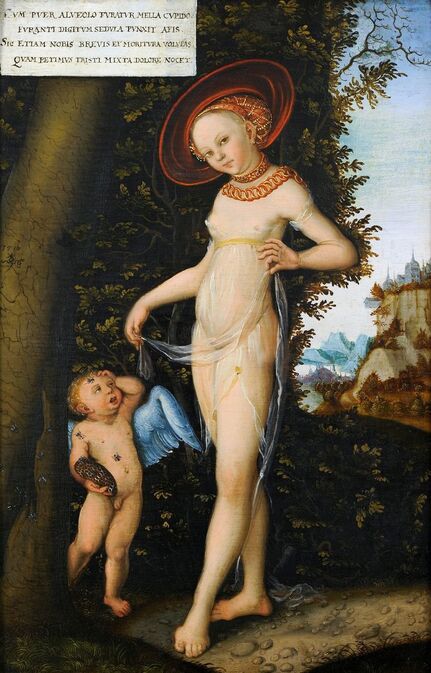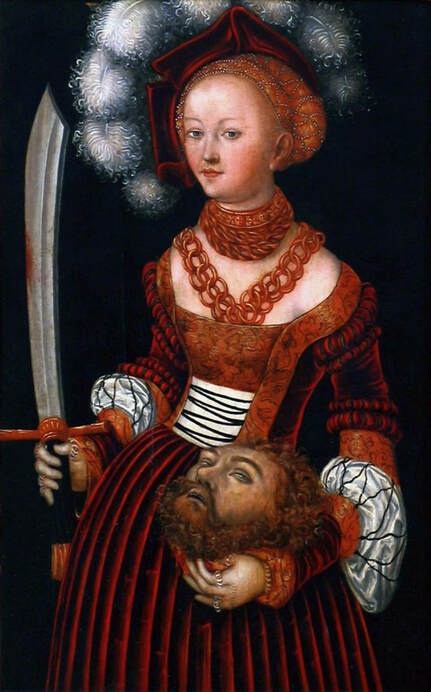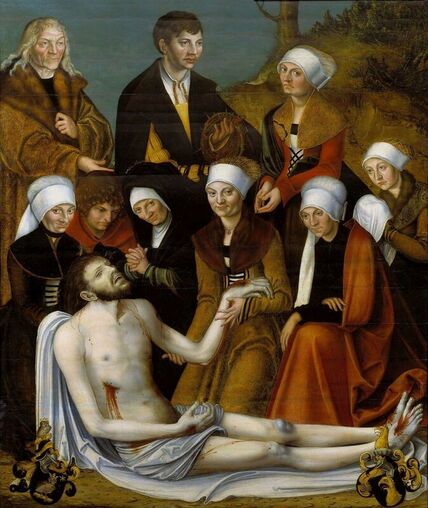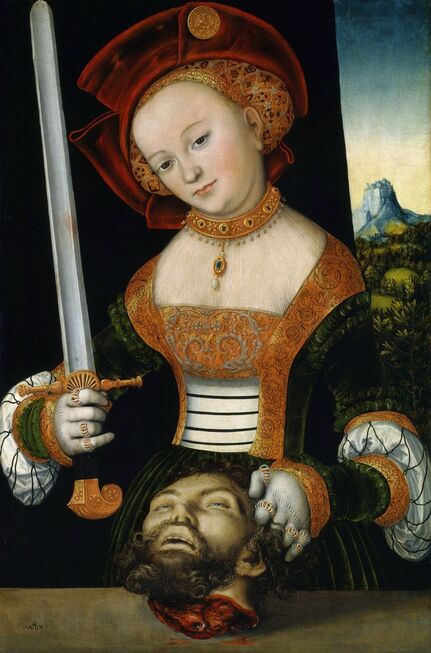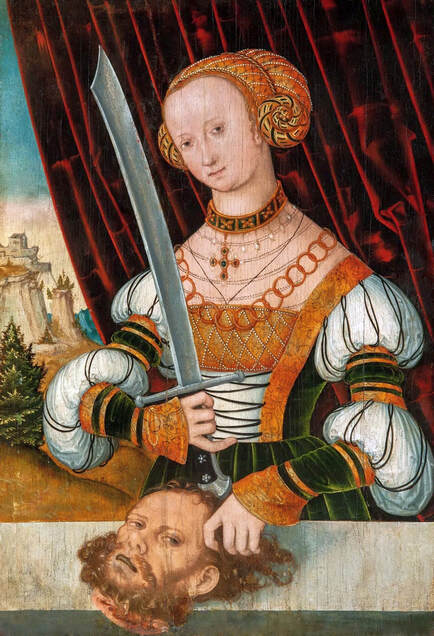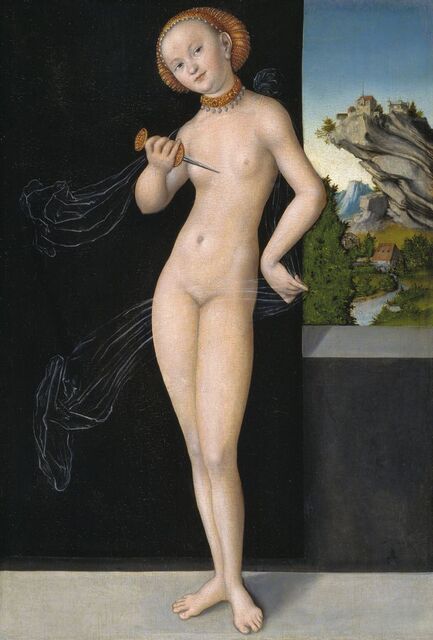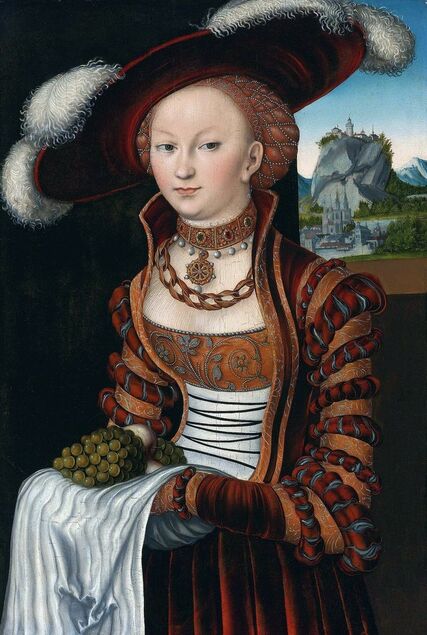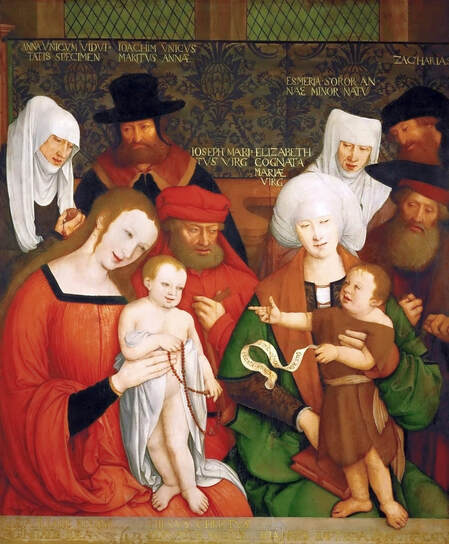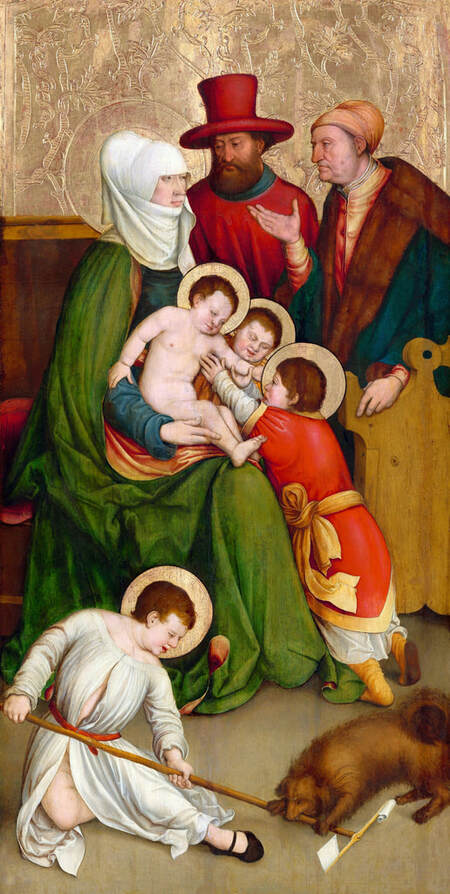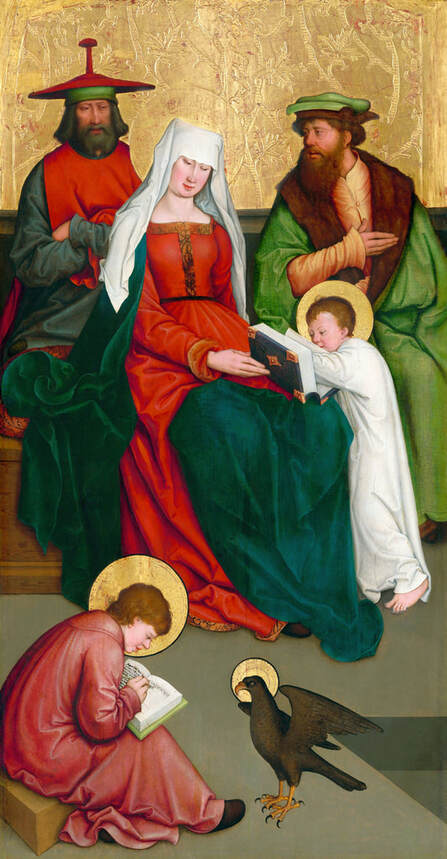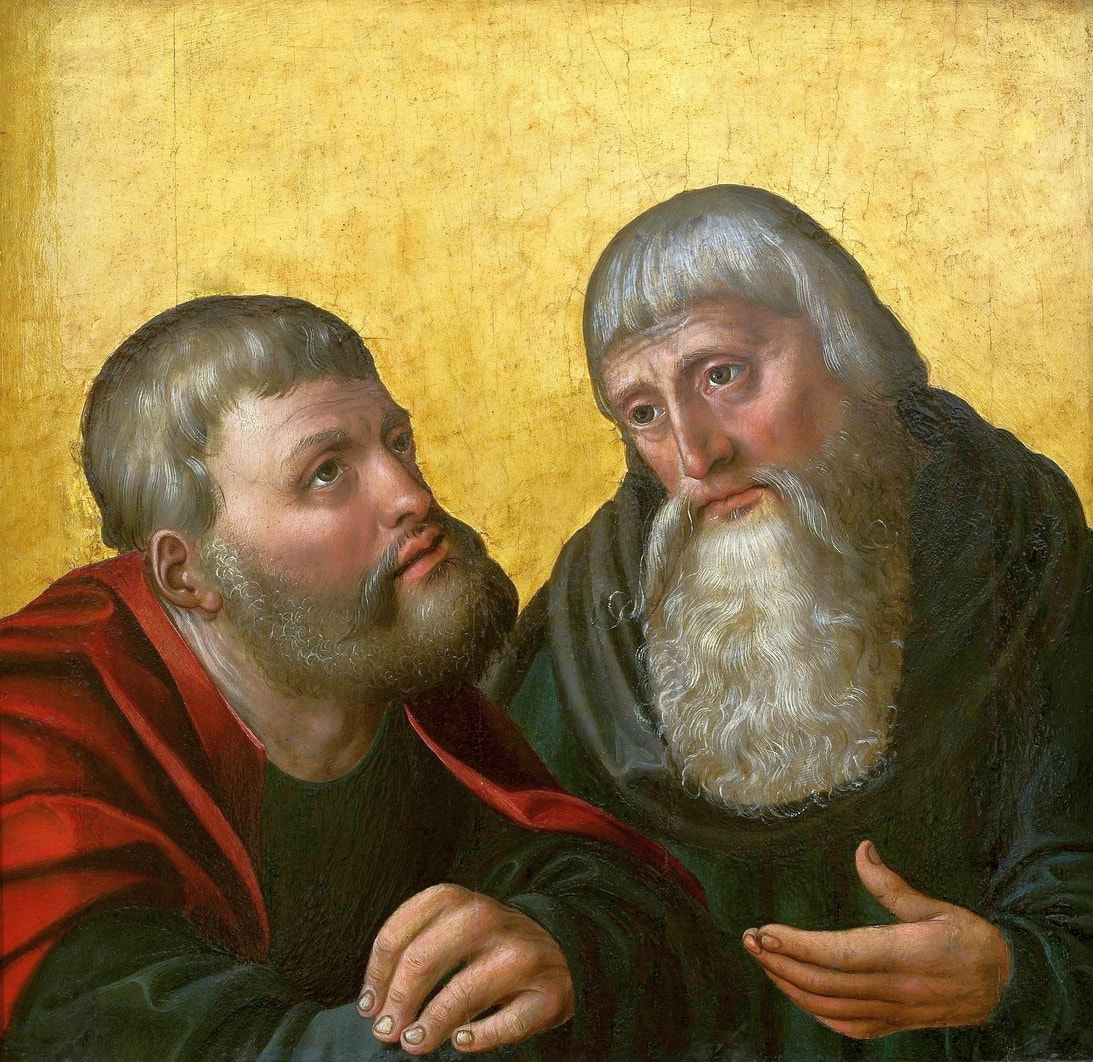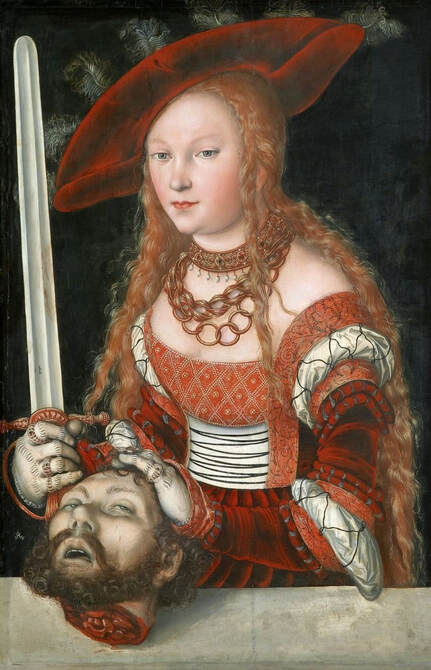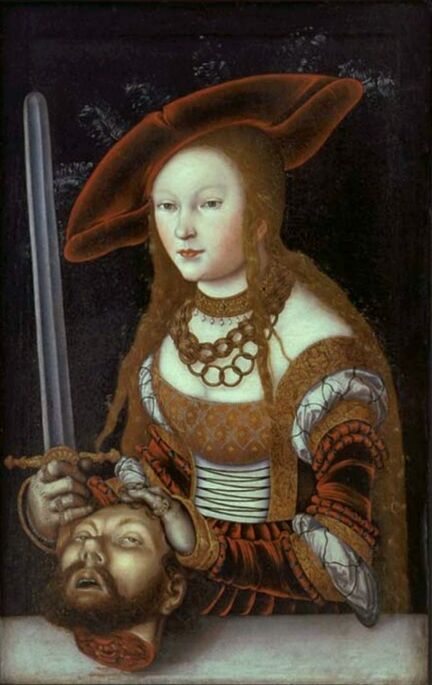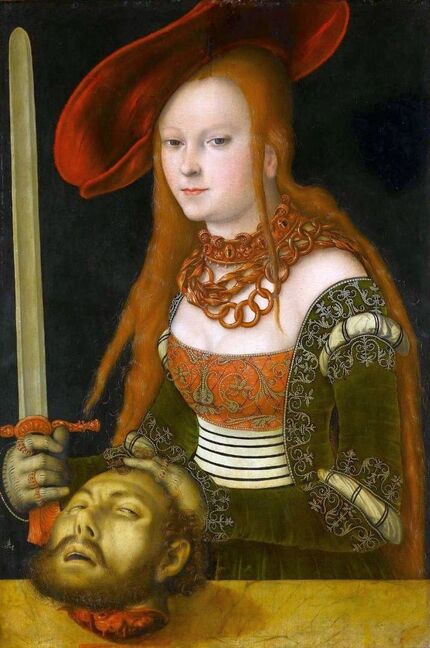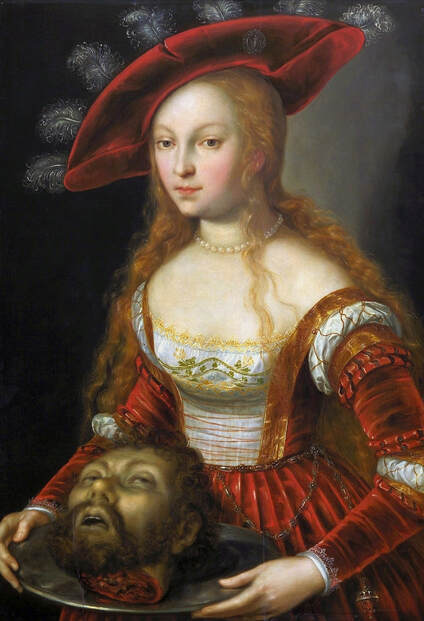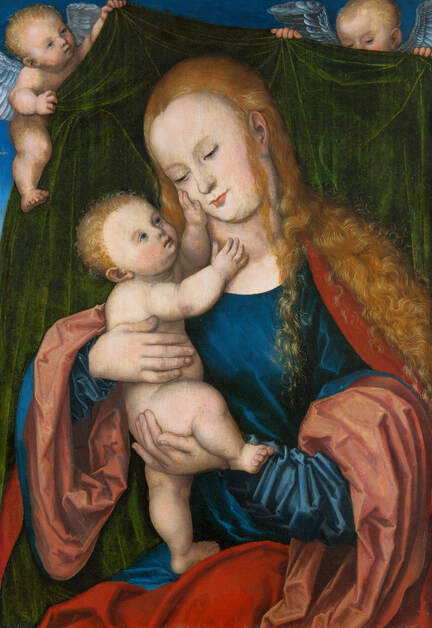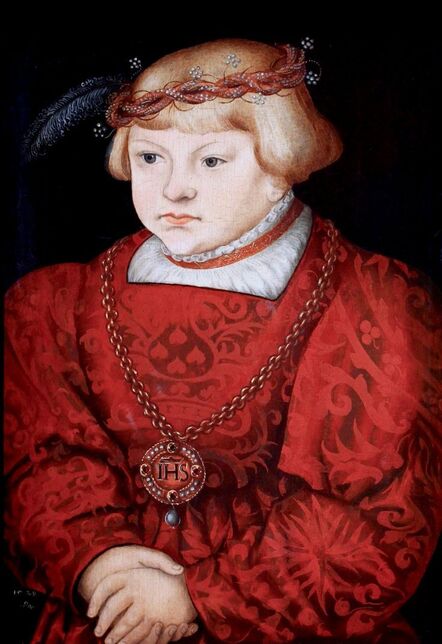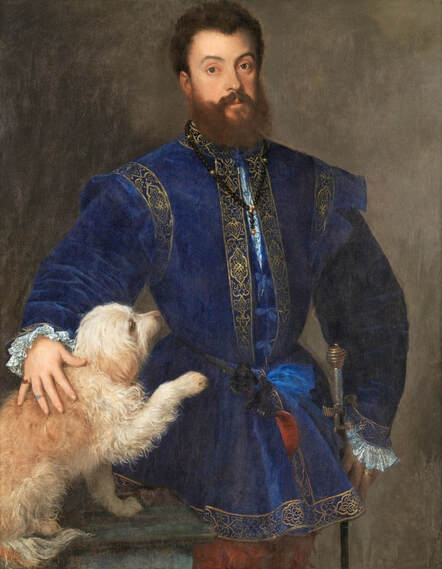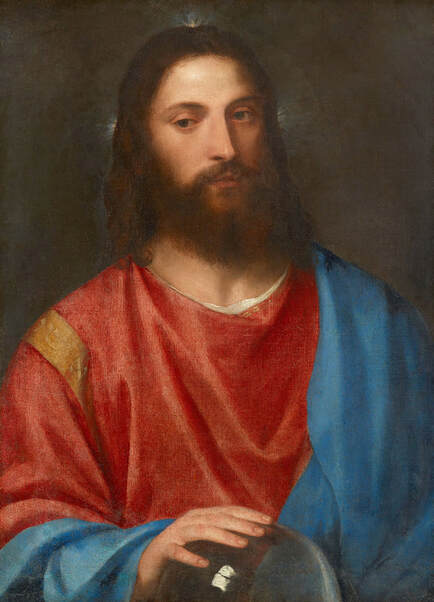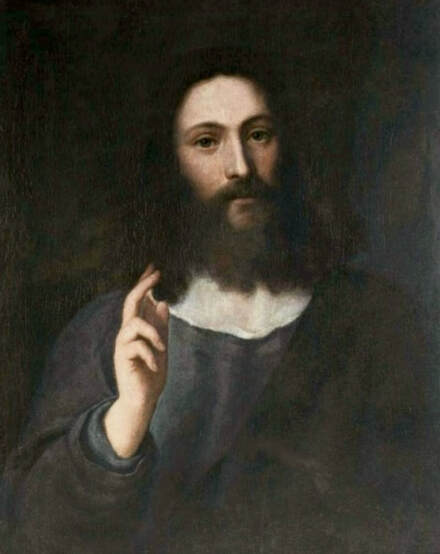|
Portraits of Simonetta Vespucci, Beatrice d'Aragona and Barbara Zapolya as Venus and as Madonna
Around 850 the church of Santa Maria Nova (New St Mary), was built on the ruins of the Temple of Venus and Roma between the eastern edge of the Forum Romanum and the Colosseum in Rome. The temple was dedicated to the goddesses Venus Felix (Venus the Bringer of Good Fortune) and Roma Aeterna (Eternal Rome) and thought to have been the largest temple in Ancient Rome. Virgin Mary was from now on to be venerated in ancient site dedicated to the ancestor of the Roman people, as mother of Aeneas, the founder of Rome. Julius Caesar claimed Venus as his ancestor, dictator Sulla and Pompey as their protectress, she was the goddess of love, beauty, desire, sex, fertility, prosperity, and victory.
In April 1469, at age of sixteen, a Genoese noblewoman Simonetta Cattaneo (1453-1476), married in Genoa in the presence of the Doge and all the city's aristocracy Marco Vespucci from the Republic of Florence, a distant cousin of the navigator Amerigo Vespucci. After the wedding, the couple settled in Florence. Simonetta quickly became popular at the Florentine court, and attracted the interest of the Medici brothers, Lorenzo and Giuliano. When in 1475 Giuliano won a jousting tournament after bearing a banner upon which was a picture of Simonetta as a helmeted Pallas Athene, painted by Sandro Botticelli, beneath which was the French inscription La Sans Pareille, meaning "The Unparalleled One", and he nominated Simonetta as "The Queen of Beauty" at that event, her reputation as an exceptional beauty further increased. She died just one year later on the night of 26/27 April 1476. On the day of her funeral she was carried through Florence in an uncovered coffin dressed in white for the people to admire her one last time and there may have existed a posthumous cult about her in Florence. She become a model for different artists and Botticelli frequently depicted her as Venus and the Virigin, the most important deities of the Renaissance, both of which had pearls and roses as their symbol. Among the best are the paintings in the National Museum in Warsaw (tempera on panel, 111 x 108 cm, M.Ob.607) and the Wawel Castle (tempera on panel, 95 cm, ZKWawel 2176) in which the Virgin has her features, as well as the goddess from the famous Birth of Venus in the Uffizi Gallery in Florence (tempera on canvas, 172.5 x 278.5 cm, 1890 n. 878) and Venus in the Gemäldegalerie in Berlin (oil on canvas, 158.1 x 68.5 cm, 1124). She was also very probably the model for the Venus in the Sabauda Gallery in Turin (oil on canvas, 176 x 77.2 cm, inv. 172), purchased in 1920 by Riccardo Gualino, thus known under the name of Venus Gualino. Giorgio Vasari, recalls that similar representations, produced in Botticelli's workshop, were found in various Florentine houses. If the greatest celebrity of this era lent her appearance to the goddess of love and the Virgin, it is more than obvious that other wealthy ladies wanted to be represented similarly. On 22 December 1476 Matthias Corvinus, King of Hungary, Bohemia and Croatia married other Renaissance beauty Beatrice d'Aragona of Naples, a relative of Bona Sforza, Queen of Poland (Bona's grandfather Alfonso II of Naples was Beatrice's brother). Matthias was fascinated by his young, intelligent and well-educated wife. Her marble bust created by Francesco Laurana in the 1470s (The Frick Collection in New York, 1961.2.86) is inscribed DIVA BEATRIX ARAGONIA (Divine Beatrice of Aragon) to further enhance her remote and ethereal beauty. Numerous Italians followed Beatrice to Hungary, among them Bernardo Vespucci, brother to Amerigo, after whom America was named (after Catherine Fletcher's "The Beauty and the Terror: The Italian Renaissance and the Rise of the West", 2020, p. 36). Corvinus commissioned works of art in Florence and the painters Filippino Lippi, Attavante degli Attavanti and Andrea Mantegna worked for him. He also recived works of art from his friend Lorenzo de' Medici, like metal reliefs of the heads of Alexander the Great and Darius by Andrea da Verrocchio, as Vasari cites. It is highly possible that Venus by Sandro Botticelli or workshop in Berlin was also sent from Florence to Matthias Corvinus or brought by Beatrice to Hungary. After Corvinus' death, Beatrice married in 1491 her second husband, Vladislaus II, son of Casimir IV, King of Poland and elder brother of Sigismund I. Two paintings of Madonna and Child from the 1490s by Perugino, a painter who between 1486 and 1499 worked mostly in Florence, in the Kunsthistorisches Museum in Vienna (tempera and oil on panel, 86.5 x 63 cm, GG 132, from old imperial collection) and in the Städel Museum (tempera and oil on panel, 67.7 x 51.5 cm, inv. 843, acquired in 1832) depict the same woman as the Virgin. Both effigies are very similar to Beatrice's bust by Francesco Laurana. The painting in the Städel Museum was most probably copied or re-created basing on the same set of study drawings by other artists, including young Lucas Cranach the Elder. One version, attributed to Timoteo Viti, was offered to the Collegiate Church in Opatów in 1515 by Krzysztof Szydłowiecki, who was initially Treasurer and Marshal of the Court of Prince Sigismund since 1505, and from 1515 Great Chancellor of the Crown. He was a friend of king Sigismund and frequently travelled to Hungary and Austria. Other two versions by Lucas Cranach the Elder are in private collections, including one sold in Vienna in 2022 (oil on panel, 76.6 × 59 cm, Im Kinsky, June 28, 2022, lot 95). The same woman was also depicted as Venus Pudica in a painting attributed to Lorenzo Costa in the Museum of Fine Arts in Budapest (oil on panel, 174 x 76 cm, inv. 1257). It was purchased by the Budapest Museum in Brescia in 1895 from Achille Glisenti, an Italian painter who also worked in Germany. Between 1498-1501 and 1502-1506 the fifth of six sons of Polish King Casimir IV Jagiellon, Prince Sigismund frequently travelled to Buda, to live at the illustrous court of his elder brother King Vladislaus II. On his way there his stop was Trenčín Castle, owned by Stephen Zapolya, Palatine of the Kingdom of Hungary. Stephen was married to Polish princess Hedwig of Cieszyn of the Piast dynasty and also owned 72 other castles and towns, and drew income from Transylvanian mines. He and his family was also a frequent guest at the royal court in Buda. At the Piotrków Sejm of 1509 the lords of the Kingdom insisted on Sigismund, who was elected king in 1506, to get married and give the Crown and Lithuania a legitimate male heir. In 1509 the youngest daughter of Zapolya, Barbara, reached the age of 14 and Lucas Cranach, then Court painter to the Duke of Saxony, was despatched by the Duke to Nuremberg for the purpose of taking charge of the picture painted by Albrecht Dürer, son of a Hungarian goldsmith, for the Duke. That same year Cranach created two paintings showing the same woman as Venus and as the Virgin. The painting of Venus and Cupid, signed with initials LC and dated 1509 on the cartellino positioned against a dark background was acquired by Empress Catherine II of Russia in 1769 with the collection of Count Heinrich von Brühl in Dresden, now in the State Hermitage Museum (oil on canvas transferred from wood, 213 x 102 cm, ГЭ-680). Its prior history is unknown, therefore it cannot be excluded that Count Brühl, a Polish-Saxon statesman at the court of Saxony and the Polish-Lithuanian Commonwealth, purchased it in Poland. The painting is inspired by Botticelli and Lorenzo Costa's Venuses. However, the direct inspiration may not have been a painting but a statue, such as that of Venus and Cupid discovered near the church of Santa Croce de Gerusalemme in Rome before 1509. This large marble sculpture, now kept at the Pio Clementino Museum (214 cm, inv. 936), which is part of the Vatican Museums, was in turn inspired by Aphrodite of Cnidus (Venus Pudica) by Praxiteles of Athens. According to the inscription on the base: VENERI FELICI / SALLVSTIA / SACRVM / HELPIDVS D[onum] D[edit] (dedicated by Sallustia and Helpidus to the happy Venus), it was long believed to represent Sallustia Barbia Orbiana, a third-century Roman empress, with the title of Augusta as wife of Severus Alexander from 225 to 227 AD, represented as Venus Felix and dedicated by her liberti (freed slaves), Sallustia and Helpidius. The portrait heads are also interpreted to represent unknown Sallustia as Venus and her son Helpidus as Cupid and the origins described as possibly coming from the temple near the Horti Sallustiani (Gardens of Sallust). Nowadays, the statue is considered to be a "disguised portrait" of Empress Faustina Minor (died ca. 175 AD), wife of Emperor Marcus Aurelius (compare "The Art of Praxiteles ... " by Antonio Corso, p. 157). It resembles another disguised statue of Faustina, represented as Fortuna Obsequens, Roman goddess of indulgent fate (Casa de Pilatos in Seville) and her bust in Berlin (Altes Museum). The second painting, very similar to effigies of Beatrice of Naples as Madonna, shows this woman against the landscape which is very similar to topography of the Trenčín Castle, where Barbara Zapolya spent her childhood and where she met Sigismund. This painting, now kept at the Thyssen-Bornemisza Museum in Madrid (oil on panel, 71.5 x 44.2 cm, 114 (1936.1)), comes from the collection of the British art critic Robert Langton Douglas (1864-1951), who lived in Italy from 1895 to 1900, and was acquired in New York in 1936. She offeres the Child a bunch of grapes a Christian symbol of the redemptive sacrifice, but also a popular Renaissance symbol for fertility borrowed from the Roman god of the grape-harvest and fertility, Bacchus. Both women resemble greatly Barbara Zapolya from her portrait with B&S monogram. In the main altar of the 13th century church in Strońsko near Sieradz in central Poland, there is very similar version of this painting by workshop of Lucas Cranach the Elder. The Latin inscription on Venus in Saint Petersburg warns the man for whom it was intended: "Drive out the excesses of Cupid with all your strength, so that Venus may not take over your blinded heart" (PELLE · CVPIDINEOS · TOTO / CONAMINE · LVXVS / NE · TVA · POSSIDEAT / PECTORA · CECA · VENVS).
Statue of Empress Faustina the Younger as Venus Felix, Ancient Rome, ca. 170-175 AD, Pio Clementino Museum.
Portrait of Simonetta Vespucci as Madonna and Child with St. John the Baptist and an angel by Sandro Botticelli, 1470s, National Museum in Warsaw.
Portrait of Simonetta Vespucci as Madonna and Child with angels by Sandro Botticelli or workshop, 1470s, Wawel Royal Castle in Kraków.
The Birth of Venus by Sandro Botticelli, 1484-1485, Uffizi Gallery in Florence.
Portrait of Simonetta Vespucci as Venus by Sandro Botticelli or workshop, fourth quarter of the 15th century, Gemäldegalerie in Berlin.
Venus by Sandro Botticelli or workshop, fourth quarter of the 15th century, Sabauda Gallery in Turin.
Portrait of Beatrice of Naples as Venus by Lorenzo Costa, fourth quarter of the 15th century, Museum of Fine Arts in Budapest.
Portrait of Beatrice of Naples as Madonna and Child with Saints by Perugino, 1490s, Kunsthistorisches Museum in Vienna.
Portrait of Beatrice of Naples as Madonna and Child with the Infant Saint John the Baptist by Perugino, 1490s, Städel Museum in Frankfurt am Main.
Portrait of Beatrice of Naples as Madonna and Child with the Infant Saint John the Baptist by Timoteo Viti or Lucas Cranach the Elder, 1490s, St. Martin's Collegiate Church in Opatów.
Portrait of Beatrice of Naples as Madonna and Child with the Infant Saint John the Baptist by Lucas Cranach the Elder, 1490s, Private collection.
Portrait of Barbara Zapolya as Venus and Cupid by Lucas Cranach the Elder, 1509, The State Hermitage Museum.
Portrait of Barbara Zapolya as Madonna and Child with a bunch of grapes by Lucas Cranach the Elder, 1509-1512, Thyssen-Bornemisza Museum in Madrid.
Portrait of Barbara Zapolya as Madonna and Child against a landscape by workshop of Lucas Cranach the Elder, 1509-1512, Parish church in Strońsko.
Portrait of Magdalena Thurzo by Lucas Cranach the Elder
One of the earliest and the best of Cranach's Madonnas is in the Archdiocesan Museum in Wrocław (oil on panel, 70.3 x 56.5 cm). The work was initially in the Cathedral of St. John the Baptist in Wrocław and is believed to have been offered there in 1517 by John V Thurzo, Prince-Bishop of Wrocław, who also founded a new sacristy portal, considered to be the first work of the Renaissance in Silesia. Thurzo, who came from the Hungarian-Slovak-Polish-German patrician family, was born on April 16, 1464 or 1466 in Kraków, where his father built a smelter in Mogiła. He studied in Kraków and in Italy and he began his ecclesiastical career in Poland (scholastic in Gniezno and in Poznań, a canon in Kraków). Polish King John I Albert sent him on several diplomatic missions. Soon afterwards he moved to Wrocław in Silesia and become a canon and dean of the cathedral chapter in 1502 and Bishop of Wrocław from 1506.
Thurzo owned a sizable library and numerous works of art. In 1508 he paid 72 florins to Albrecht Dürer, the son of a Hungarian goldsmith, for a painting of Virgin Mary (Item jhr dörfft nach keinen kaufman trachten zu meinem Maria bildt. Den der bischoff zu Preßlau hat mir 72 fl. dafür geben. Habs wohl verkhaufft.), according to artist's letter from November 4, 1508. According to Jan Dubravius, he also owned Dürer's Adam and Eve, for which he paid 120 florins. In 1515, John's younger brother Stanislaus Thurzo, Bishop of Olomouc commissioned Lucas Cranach the Elder to create an altarpiece on the themes of the Beheading of St. John the Baptist and the Beheading of St. Catherine (Kroměříž Castle), while his other brother George, who married Anna Fugger, was portrayed by Hans Holbein the Elder (Kupferstichkabinett in Berlin). In 1509 or shortly after, he completed the reconstruction of the episcopal summer residence in Javorník. The medieval castle built by the Piast duke Bolko II of Świdnica was converted into a Renaissance palace from 1505, according to two stone plaques on the castle wall created by the workshop of Francesco Fiorentino (who later worked in Poland) in Kroměříž, one starting with the words "John Thurzo, bishop of Wroclaw, a Pole, repaired this citadel" (Johannes Thurzo, episcopus Vratislaviensis, Polonus, arcem hanc bellorum ac temporum injuriis solo aequatam suo aere restauravit, mutato nomine montem divi Joannis felicius appellari voluit M. D. V.). He also renamed the castle as John's Hill (Mons S. Joannis, Jánský Vrch, Johannisberg or Johannesberg), to honor the patron of the Bishops of Wrocław, Saint John the Baptist. In Thurzo's time, the castle became a meeting place for artists and scholars, including the canon of Toruń, Nicholas Copernicus. Together with his brother Stanislaus, the bishop of Olomouc, he crowned the three-year-old Louis Jagiellon as King of Bohemia on March 11, 1509 in Prague. Bishop Thurzo had two sisters. The younger Margaret married Konrad Krupka, a merchant from Kraków and the elder Magdalena was first married to Max Mölich from Wrocław and in 1510 she married Georg Zebart from Kraków, who were both involved in financial undertakings of her father John III Turzo in Poland, Slovakia and Hungary. The painting of the Wrocław Madonna is generally dated to about 1510 or shortly after 1508, when Cranach was ennobled by Frederick the Wise, Elector of Saxony, because a signet ring decorated with the inverted initials 'L.C' and Cranach's serpent insignia is one of the most important items in the painting. The castle on a fantastic rock in the background with two round towers, a small inner courtyard and a gate tower on the right match perfectly the layout and the view of the Jánský Vrch Castle in the early 16th century (hypothetical reconstruction drawings by Rostislav Vojkovský). Scaffolding and a ladder are also visible, the building is clearly being rebuilt and extended. The child is holding grapes, Christian symbol of Redemption, but also an ancient symbol of fertility. The woman depicted as the Virgin bears resemblance to effigies of George Thurzo (Thyssen-Bornemisza Museum in Madrid and Kupferstichkabinett in Berlin), she sould be therefore identified as Magdalena Thurzo, who around that time was about to get married.
Portrait of Magdalena Thurzo as Madonna and Child with a bunch of grapes against the idealized view of Jánský Vrch Castle by Lucas Cranach the Elder, ca. 1509-1510, Archdiocesan Museum in Wrocław.
Portrait of Barbara Zapolya as Salome with the Head of Saint John the Baptist by Lucas Cranach the Elder
"In the Christian world well through the Renaissance, males were associated with the head (and therefore with thinking, reason, and self-control) and females with the body (and therefore with senses, physicality, and the passions)" (Gail P. Streete's "The Salome Project: Salome and Her Afterlives", 2018, p. 41).
During Renaissance Salome became an erotic symbol of daring, uncontrollable female lust, dangerous female seductiveness, woman's evil nature, the power of female perversity, but also a symbol of beauty and complexity. One of the oldest representations of Dance of Salome is a fresco in the Prato Cathedral, created between 1452 and 1465 by Filippo Lippi, who also created some paintings for Matthias Corvinus, King of Hungary. In April 1511, Sigismund informed his brother, King Vladislaus, that she wants to marry a Hungarian noblewoman. He chose Barbara Zapolya. The marriage treaty was signed on 2 December 1511 and Barbara's dowry was fixed at 100,000 red złotys. Barbara was praised for her virtues, Marcin Bielski wrote of her devotion to God and obedience to husband, kindheartedness and generosity. The painting by Lucas Cranach the Elder in Lisbon depict her as Salome wearing a fur-trimmed coat and a fur hat. It was offered to the Museum of Ancient Art in Lisbon by Luis Augusto Ferreira de Almeida, 1st Count of Carvalhido. It is possible that the painting was sent to Portugal in the 16th century by the Polish-Lithuanian court. In 1516 Jan Amor Tarnowski, who was educated at the court of the Jagiellonian monarchs, and two other Polish lords were knighted in the church of St. John in Lisbon by King Manuel I. More than one decade later, in 1529 and again in 1531 arrived to Poland-Lithuania Damião de Góis, who was entrusted by King John III of Portugal with a mission to negotiate the marriage of Princess Hedwig Jagiellon, a daughter of Barbara Zapolya, with king's brother. In 1520, Hans Kemmer, a pupil of Lucas Cranach the Elder in Wittenberg, probably shortly after his return to his native town of Lübeck (first mentioned in the Town Book on May 25, 1520), created a copy or rather a modified version of this painting. He signed this work with a monogram HK (linked) and dated '1520' at the edge of the dish. It comes from private collection in Austria and was sold in 1994 (oil on panel, 58 x 51 cm, Dorotheum in Vienna, October 18, 1994, lot 151). Her costume is more ornate in this version, but the face is not very elaborately painted. The sitter's velvet fur-lined hat is evidently Eastern European and similar was depicted in a Portrait of a man with a fur hat by Michele Giambono (Palazzo Rosso in Genoa), created in Venice between 1432-1434, which is identified to represent a Bohemian or Hungarian prince who came to Italy for the coronation of Emperor Sigismund. Her left hand is unnatural and almost grotesque or "naively" painted (repainted in the Lisbon version most likely in the 19th century), which is an indication that the painter based on a study drawing that he received to create the painting and not seen the live model. Few years later Laura Dianti (d. 1573), mistress of Alfonso I d'Este, Duke of Ferrara, was depicted in several disguised portraits by Titian and his workshop. Her portrait with an African page boy (Kisters Collection at Kreuzlingen) is known from several copies and other versions, some of which depict her as Salome. The original by Titian in guise of biblical femme fatale was probably lost. Paintings of Madonna and Child with the Infant Saint John the Baptist by Titian and his workshop (Uffizi Gallery in Florence and Musée Fesch in Ajaccio) are also identified to depict Laura as well as Saint Mary Magdalene by circle of Titian (Private collection). They all followed the same Roman pattern of portraits in the guise of deities and mythological heroes. The image of Herodias/Salome preserved in the Augustinian monastery in Kraków and the posthumous inventory of Melchior Czyżewski, who died in Kraków in 1542, lists as many as two such paintings. The popularity of such images in Poland-Lithuania is reflected in poetry. In the fragmentarily preserved works of Mikołaj Sęp Szarzyński (ca. 1550 - ca. 1581) there are four epigrams on paintings, including "On the image of Saint Mary Magdalene" and "On the image of Herodias with the head of Saint John" (after "Od icones do ekfrazy ..." by Radosław Grześkowiak).
Portrait of Barbara Zapolya as Salome with the Head of Saint John the Baptist by Lucas Cranach the Elder, 1510-1515, National Museum of Ancient Art in Lisbon.
Portrait of Barbara Zapolya as Salome with the Head of Saint John the Baptist by Hans Kemmer, 1520, Private collection.
Portraits of Barbara Zapolya and Barbara Jagiellon by Lucas Cranach the Elder
On November 21, 1496 in Leipzig, Barbara Jagiellon, the fourth daughter of Casimir IV Jagiellon, King of Poland and Grand Duke of Lithuania and Elizabeth of Austria, Princess of Bohemia and Hungary, that reached adulthood, married George of Saxony, son and successor of Albert III the Bold, Duke of Saxony and Sidonie of Podebrady, a daughter of George, King of Bohemia, in a glamorous and elaborate ceremony. 6,286 German and Polish nobles are said to have attended the wedding. The marriage was important for the Jagiellons because of the rivalry with the Habsburgs in Central Europe.
As early as 1488, while his father was away on campaigns in Flanders and Friesland, George, Barbara's husband, held various official duties on his behalf, and succeeded him after his death in 1500. George's cousin, prince-elector Frederick the Wise, was a very pious man and he collected many relics, including a sample of breast milk from the Blessed Virgin Mary. In 1509 the elector had printed a catalogue of this collection, produced by his court artist Lucas Cranach and his inventory of 1518 listed 17,443 items. In 1522, Emperor Charles V proposed engagement of Hedwig Jagiellon, the eldest daughter of Sigismund I, Barbara's brother, with John Frederick, heir to the Saxon throne and Frederick the Wise's nephew, as the elector most probably homosexual in relationship with Degenhart Pfäffinger, remained unmarried. The portrait of Frederick by circle of Lucas Cranach the Elder from the 1510s is in the Kórnik Castle near Poznań. On 20 November 1509 in Wolfenbüttel, Catherine (1488-1563), a daughter of the Duke Henry IV of Brunswick-Lüneburg, married Duke Magnus I of Saxe-Lauenburg (1470-1543). Soon after the wedding she bore him a son, future Francis I (1510-1581). Magnus was the first of the Dukes of Saxe-Lauenburg to renounce Electoral claims, which had long been in dispute between the two lines of the Saxon ducal house. He carried neither the electoral title nor the electoral swords (Kurschwerter) in his coat of arms. The electoral swords indicated the office as Imperial Arch-Marshal (Erzmarschall, Archimarescallus), pertaining to the privilege as prince-elector. On 12 August 1537, the eldest daughter of Catherine and Magnus, Dorothea of Saxe-Lauenburg (1511-1571), was crowned Queen of Denmark and Norway in the Copenhagen Cathedral. "That they may see a great kingdom and a mighty people, that they may bear their lord's queen under the stars, O happy virgin, happy stars who have borne you, for the glory of your country" (Ut videant regnum immensum populumque potentem: Reginam domini ferre sub astra sui, O felix virgo, felicia sidera, que te, Ad tantum patrie progenuere decus), wrote in his "Hymn for the Coronation of Queen Barbara" (In Augustissimu[m] Sigisimu[n]di regis Poloniae et reginae Barbarae connubiu[m]), published in Kraków in 1512, the queen's secretary Andrzej Krzycki. Queen Barbara Zapolya was crowned on 8 February 1512 in the Wawel Cathedral. She brought Sigismund a huge dowry of 100,000 red zlotys, equal to the imperial daughters. Their wedding was very expensive and cost 34,365 zlotys, financed by a wealthy Kraków banker Jan Boner. A painting by Lucas Cranach the Elder in the National Gallery of Denmark in Copenhagen dated to about 1510-1512 shows a scene of the Mystical marriage of Saint Catherine. The Saint "as a wife should share in the life of her husband, and as Christ suffered for the redemption of mankind, the mystical spouse enters into a more intimate participation in His sufferings" (after Catholic Encyclopaedia). Virgin Mary bears features of Queen Barbara Zapolya, similar to paintings in the Parish church in Strońsko or in the Thyssen-Bornemisza Museum in Madrid. The woman on the right, depicted in a pose similar to some donor portraits, is identified as effigy of Saint Barbara. It was therefore she who commissioned the painting. Her facial features bears great resemblance to the portrait of Barbara Jagiellon by Cranach from the Silesian Museum of Fine Arts in Wrocław, today in the Gemäldegalerie in Berlin. The effigy of Saint Catherine bears strong resemblance to the portrait of Dorothea of Saxe-Lauenburg, queen of Denmark and daughter of Catherine of Brunswick-Wolfenbüttel, Duchess of Saxe-Lauenburg, in the Frederiksborg Castle, near Copenhagen. Described painting comes from the Danish royal collection and before 1784 it was in the Furniture Chamber of the royal Christiansborg Palace in Copenhagen. The painting bears coat of arms of the Electorate of Saxony in upper part. The message is therefore that Saxe-Lauenburg should join the "Jagiellonian family" and thanks to this union they can regain the electoral title. A good workshop copy, acquired in 1858 from the collection of a Catholic theologian Johann Baptist von Hirscher (1788-1865) in Freiburg im Breisgau, is in the Staatliche Kunsthalle Karlsruhe. The painting is very similar to other Mystical marriage of Saint Catherine by Lucas Cranach the Elder, which was in the Bode Museum in Berlin before World War II, lost. In this scene Queen Barbara is most probably surrounded by her Hungarian and Moravian court ladies in guise of Saints Margaret, Catherine, Barbara and Dorothea. It was purchased from a private collection in Paris, hence the provenance from the Polish royal collection cannot be excluded - John Casimir Vasa, great-grandson of Sigismund I in 1668 and many other Polish aristocrats transferred to Paris their collections in the 17th century and later. The copy of this painting from about 1520 is in the church in Jachymov (Sankt Joachimsthal), where from 1519 Louis II, King of Hungary, Croatia and Bohemia minted his famous gold coin, Joachim thaler. The woman in an effigy of Lucretia, a model of virtuous woman by Lucas Cranach the Elder, which was in the late 19th century in the collection of Wilhelm Lowenfeld in Munich, is very similar to the effigy of Barbara Jagiellon in Copenhagen. It is one of the earliest of the surviving versions of this subject by Cranach and is considered a pendant piece to the Salome in Lisbon (Friedländer). Both paintings have similar dimensions, composition, style, the subject of an ancient femme fatale and were created in the same period. The work in Lisbon depicts Barbara Jagiellon's sister-in-law, Queen Barbara Zapolya. Similar effigy of Lucretia, also by Cranach the Elder, was auctioned at Art Collectors Association Gallery in London in 1920. The effigy of the Virgin of Sorrows in the National Gallery in Prague, which was donated in 1885 by Baron Vojtech (Adalbert) Lanna (1836-1909), is almost identical with the face of Saint Barbara in the Copenhagen painting. In 1634 the work was owned by some unidentified abbot who added his coat of arms with his initiatials "A. A. / Z. G." in right upper corner of the painting. On the other hand, the face of Madonna from a painting in the National Museum in Warsaw (inventory number M.Ob.2542 MNW) is very similar to that of Salome in Munich. This painting is attributed to follower of Lucas Cranach the Elder and dated to the first quarter of the 16th century. The effigy of Salome from the same period by Lucas Cranach the Elder, acquired in 1906 by the Bavarian National Museum in Munich from the Catholic Rectory in Bayreuth, also depict Barbara Jagiellon. A modified copy of this painting by Cranach's workshop or a 17th century copist, possibly Johann Glöckler, with the model shown wearing a dress made of exquisite brocade fabric was in the Heinz Kisters collection in Kreuzlingen in the 1960s (oil on panel, 34.8 × 24.5 cm). It is one of the many known variants of the composition. Possibly around that time or later, when her sister-in-law Bona Sforza ordered her portraits in about 1530, the Duchess also commissioned a series of her portraits as another biblical femme fatale, Judith. The portrait by workshop or follower of Cranach from private collection, sold in 2014, is very similar to the painting in Munich, while the pose essentially corresponds to the portrait of her niece Hedwig Jagiellon from the Suermondt collection, dated 1531. George of Saxony and Barbara Jagiellon were married for 38 years. After her death on 15 February 1534, he grew a beard as a sign of his grief, earning him the nickname the Bearded. He died in Dresden in 1539 and was buried next to his wife in a burial chapel in Meissen Cathedral.
Portrait of Queen Barbara Zapolya (1495-1515), Barbara Jagiellon (1478-1534), Duchess of Saxony and Catherine of Brunswick-Wolfenbüttel (1488-1563), Duchess of Saxe-Lauenburg as the Virgin and Child with Saints Barbara and Catherine by Lucas Cranach the Elder, ca. 1512-1514, National Gallery of Denmark.
Portrait of Queen Barbara Zapolya (1495-1515), Barbara Jagiellon (1478-1534), Duchess of Saxony and Catherine of Brunswick-Wolfenbüttel (1488-1563), Duchess of Saxe-Lauenburg as the Virgin and Child with Saints Barbara and Catherine by workshop of Lucas Cranach the Elder, ca. 1512-1514, Staatliche Kunsthalle Karlsruhe.
Portrait of Queen Barbara Zapolya (1495-1515) and her court ladies as the Virgin and Saints by Lucas Cranach the Elder, ca. 1512-1514, Bode Museum in Berlin, lost.
Portrait of Barbara Jagiellon (1478-1534), Duchess of Saxony as Salome by Lucas Cranach the Elder, ca. 1512, Bavarian National Museum in Munich.
Portrait of Barbara Jagiellon (1478-1534), Duchess of Saxony as Salome by workshop or follower of Lucas Cranach the Elder, after 1512 (17th century?), Private collection.
Portrait of Barbara Jagiellon (1478-1534), Duchess of Saxony as Judith with the head of Holofernes by workshop or follower of Lucas Cranach the Elder, ca. 1512-1531, Private collection.
Portrait of Barbara Jagiellon (1478-1534), Duchess of Saxony as Lucretia by Lucas Cranach the Elder, ca. 1512-1514, Private collection.
Portrait of Barbara Jagiellon (1478-1534), Duchess of Saxony as Lucretia by Lucas Cranach the Elder, ca. 1512-1514, Private collection.
Portrait of Barbara Jagiellon (1478-1534), Duchess of Saxony as the Virgin of Sorrows by Lucas Cranach the Elder, ca. 1512-1514, National Gallery in Prague.
Portrait of Barbara Jagiellon (1478-1534), Duchess of Saxony as Madonna and Child by follower of Lucas Cranach the Elder, first quarter of the 16th century, National Museum in Warsaw.
Portraits of Elizabeth Jagiellon by Lucas Cranach the Elder and workshop
"Towns and villages are scarce in Lithuania; the main wealth among them are particularly animal skins, to which our age gave the names of Zibellini and armelli (ermine). Unknown use of money, skins take its place. The lower classes use copper and silver; more precious than gold. Noble ladies have lovers in public, with the permission of their husbands, whom they call assistants of marriage. It is a shame for men to add a mistress to their legitimate wife. Marriages are easily dissolved by mutual consent, and they marry again. There is a lot of wax and honey here which wild bees make in the woods. The wine use is very rare, and the bread is very black. Cattle provide food to those who use much milk" (Rara inter Lithuanos oppida, neque frequentes villae: opes apud eos, praecipuae animalis pelles, quibus nostra aetas Zibellinis, armellinosque nomina indidit. Usus pecuniae ignotus, locum eius pelles obtinent. Viliores cupri atque argenti vices implent; pro auro signato, pretiosiores. Matronae nobiles, publice concubinos habent, permittentibus viris, quos matrimonii adiutores vocant. Viris turpe est, ad legitimam coniugem pellicem adiicere. Solvuntur tamen facile matrimonia mutuo consensu, et iterum nubunt. Multum hic cerae et mellis est quod sylvestres in sylvis apes conficiunt. Vini rarissimus usus est, panis nigerrimus. Armenta victum praebent multo lacte utentibus.), wrote in the mid-15th century Pope Pius II (Enea Silvio Piccolomini, 1405-1464) in his texts published in Basel in 1551 by Henricus Petrus, who also published the second edition of De revolutionibus orbium coelestium by Nicolaus Copernicus (Aeneae Sylvii Piccolominei Senensis, qui post adeptum ..., p. 417). Some conservative 19th century authors, clearly shocked and terrified by this description, have suggested that the Pope was lying or spreading false rumors.
Elizabeth Jagiellon, the thirteenth and the last child of Casimir IV, King of Poland and Grand Duke of Lithuania and his wife Elizabeth of Austria (1436-1505), was most probably born on November 13, 1482 in Vilnius, when her mother was 47 years old. In 1479 Elizabeth of Austria with her husband and younger children, left Kraków for Vilnius for five years. The Princess was baptized with her mother's name. Just few months later on March 4, 1484 in Grodno died Prince Casimir, the heir apparent and future saint, and was buried in the Vilnius Cathedral. Casimir IV died in 1492 in the Old Grodno Castle in the Grand Duchy of Lithuania. After her father's death Elizabeth strengthen her relationship with her mother. In 1495, together with her mother and sister Barbara, she returned to Lithuania to visit her brother Alexander Jagiellon, Grand Duke of Lithuania. When she was 13 years old, in 1496, John Cicero, Elector of Brandenburg intended to marry her to his son Joachim, but the marriage did not materialize and on April 10, 1502 Joachim married Elizabeth of Denmark, daughter of King John of Denmark. In 1504, Alexander, who became the king of Poland in 1501, granted her a jointure (lifetime provision), secured on Łęczyca, Radom, Przedecz and the village of Zielonki. Between 1505-1509, the Voivode of Moldavia, Bogdan III the One-Eyed, sought to win Elizabeth's hand, but the girl was categorically against it. In the following years, marriage proposals from the Italian, German and Danish princes were considered, and it was even planned to marry Elizabeth to the widowed Emperor Maximilian I, who was over 50 when in 1510 died his third wife Bianca Maria Sforza. In 1509 Princess Elizabeth purchased a house at the Wawel Hill from the cathedral vicars, situated between the houses of Szydłowiecki, Gabryielowa, Ligęza and Filipowski and her brother, king Sigismund I, commissioned in Nuremberg a silver altar for the Wawel Cathedral after victory over Bogdan III the One-Eyed, created in 1512 by Albrecht Glim. Elizabeth also raised the children of the king. Without waiting for a clear response from Emperor Maximilian, Sigismund and his brother Vladislaus II decided to marry their sister to Duke Frederick II of Legnica. First, however, Sigismund wanted to communicate with his sister for her opinion. "We have no doubts, that she would easily agree to everything that Your Highness and We will consider right and grateful", he wrote to Vladislaus. The union was supposed to strengthen King Sigismund's ties with the Duchy of Legnica. The marriage contract was signed in Kraków on September 12, 1515 by John V Thurzo, Bishop of Wrocław, who was replacing the groom. Elizabeth received a dowry of 20,000 zlotys, of which 6,000 were to be paid upon marriage, 7,000 on St. Elizabeth's day in a year, and the last 7,000 on St. Elizabeth's day in 1517. In addition, the princess was given a trousseau in gold, silver, pearls and precious stones, estimated at 20,000 zlotys, apart from the robes of gold and silk and ermine and sable furs. The husband was to transfer a jointure of 40,000 zlotys, secured on all income from Legnica and to pay her annually 2,400 zlotys. On November 8, 1515, Elizabeth set off for Legnica from Sandomierz, accompanied by Stanisław Chodecki, Grand Marshal of the Crown, priests Latalski and Lubrański, voivode of Poznań and bishop Thurzo. The wedding of 32-year-old Elizabeth with 35-year-old Frederick took place on November 21 or 26 in Legnica and the couple lived in the Piast castle there. On February 2, 1517, she gave birth to a daughter, Hedwig, who died two weeks later, followed her mother on February 17. The duchess was buried in the Carthusian church in Legnica and in 1548, her body was transferred to another temple in Legnica - the Church of St. John. A painting of Lucretia, the epitome of female virtue and beauty, by Lucas Cranach the Elder or his workshop was acquired by Gemäldegalerie Alte Meister in Kassel from the art dealer Gutekunst in Stuttgart in 1885. According to inscription on reverse of the panel it was earlier in private collection in Augsburg, a city frequently visited by Emperor Maximilian I. The tower on a hilltop visible on the left in the background is astonishingly similar to the dominant of the 16th century Vilnius, the medieval Gediminas Tower of the Upper Castle. Lucretia's pose, costume and even facial features are very similar to the portrait of Elizabeth's elder sister Barbara Jagiellon (1478-1534), Duchess of Saxony as Lucretia from Wilhelm Löwenfeld's collection in Munich. A study drawing for this painting by an artist from Cranach's studio, possibly a student sent to Poland-Lithuania to prepare initial drawings, is in the Klassik Stiftung Weimar (CC 100). The same woman was also depicted as reclining water nymph Egeria, today in the Grunewald hunting lodge in Berlin. The painter most likely used the same template drawing to create both effigies (in Kassel and in Berlin). Egeria, the nymph of the sacred source, probably a native Italic water goddess, had the power to assist in conception. "Her fountain was said to have sprung from the trunk of an oak tree and whoever drank it water was blessed with fertility, prophetic visions, and wisdom" (after Theresa Bane's "Encyclopedia of Fairies in World Folklore and Mythology", p. 119). Medieval tower on a steep slope in the background is also similar on both paintings. This painting was presumably in the Berlin City Palace since the 16th century and in 1699 it was recorded in the Potsdam City Palace. It cannot be excluded that it was sent to Joachim I Nestor, Elector of Brandenburg or his brother Albert of Brandenburg, future cardinal, or it was taken from Poland during the Deluge (1655-1660). Initial drawing for this painting is in the Graphic Collection of the Erlangen University Library (H62/B1338). Another similar Lucretia was sold in Brussels in 1922. Brussels was a capital of the Habsburg Netherlands, a dominium of Emperor Maximilian. It is highly possible that his daughter Archduchess Margaret of Austria, Governor of the Habsburg Netherlands from 1507 to 1515, who resided in nearby Mechelen, received a portrait of possible stepmother. This portrait is also very similar to another portrait of Elizabeth's sister Barbara as Lucretia, which was auctioned in London in 1920. The Lucretia from Brussels was copied in another painting, today in Veste Coburg, which according to later inscription is known as Dido the Queen of Carthage. It was initially in the Art Cabinet (Kunstkammer) of the Friedenstein Palace in Gotha, like the portrait of Elizabeth's niece Hedwig Jagiellon by Cranach from 1534. The costume of Dido is very similar to the dress of Salome visible in a painting of the Beheading of Saint John the Baptist (Kroměříž Castle), dated '1515' and created by Cranach for Stanislaus Thurzo, Bishop of Olomouc, brother of Bishop John V Thurzo. This painting bears the inscription in Latin DIDO REGINA and date M.D.XLVII (1547). Friedenstein Palace was built for Ernest I, Duke of Saxe-Gotha, and one of the most important events in the history of his family was the Battle of Mühlberg in 1547, lost by his great-grandfather John Frederick I, who was stripped of his title as Elector of Saxony and imperial forces blew up the fortifications of Grimmenstein Castle, the predecessor of the Friedenstein Palace. It is possible that a portrait of Elizabeth as Lucretia, whose identity was already lost by 1547, become for John Frederick's family a symbol of their glorious past and tragic fall, exactly like in the Story of Dido and Aeneas. The same facial features were also used in a series of paintings of Nursing Madonna (Madonna lactans), a symbol of maternity and Virgin's capacity for protection. This popular image of Mary with the infant Jesus is similar to the ancient statues of Isis lactans that is the Egyptian goddess Isis, worshiped as the ideal, fertile mother, shown suckling her son Horus. The best version is now in the Museum of Fine Arts in Budapest. This painting was donated to the museum in 1912 by Count János Pálffy from his collection in the Pezinok Castle in Slovakia. The painting was earlier, most probably, in Principe Fondi's collection which was auctioned in Rome in 1895. The work is exquisitely painted and the landscape in the background resemble the view of Vilnius and Neris river in about 1576, however the face, was not very skilfully added to the painting, most likely as the last part, and the whole effigy looks unnatural. The same mistake was replicated in copies and the face of the Virgin in the copy in the Hessisches Landesmuseum Darmstadt has almost grotesque appearance. The latter painting was acquired before 1820, probably from the collection of the Landgraves of Hesse-Darmstadt and the hilltop tower behind the Virgin is almost identical with that in the painting of Lucretia in Kassel. Other versions are in the Capuchin monastery in Vienna, most probably from the Habsburg collection, one was sold in Lucerne in 2006 (Galerie Fischer) and another in 2011 in Prague (Arcimboldo). The sitter's face in all mentioned effigies with distinguish Habsburg/Masovian lip, resemble greatly Elizabeth's sister Barbara Jagiellon, her mother Elizabeth of Austria and her brother Sigismund I. There is also a painting in the Klassik Stiftung Weimar, created by workshop or follower of Lucas Cranach the Elder, representing the Virgin Mary flanked by two female saints, very similar to the compositions in the National Gallery of Denmark in Copenhagen and in the Bode Museum in Berlin, lost during World War II. The painting was acquired before 1932 on the Berlin art market. The effigy of Mary is a copy of a painting in Strońsko near Sieradz in central Poland, the portrait of Barbara Zapolya. The woman on the left, receiving an apple from the Child, is identical with effigies of Barbara Jagiellon, Duchess of Saxony and the one on the right resemble Elizabeth Jagiellon. The castle in the background match perfectly the layout of the Royal Sandomierz Castle in about 1515 as seen from the west. The Gothic castle in Sandomierz was built by king Casimir the Great after 1349 and it was rebuilt and extended in about 1480. On July 15, 1478 Queen Elizabeth of Austria gave birth to Barbara Jagiellon there and the royal family lived in the castle from about 1513. In 1513 Sigismund I ordered to demolish some ruined, medieval structures and to extend and reconstruct the building in the renaissance style. Two-storey arcaded cloisters around a closed courtyard (west, south and east wings) were constructed between 1520-1527. The castle was destroyed during the Deluge in 1656 and the west wing was rebuilt between 1680-1688 for King John III Sobieski.
Study drawing for portrait of Princess Elizabeth Jagiellon (1482-1517) as reclining water nymph Egeria by workshop of Lucas Cranach the Elder, ca. 1510-1515, Graphic Collection of the Erlangen University Library.
Portrait of Princess Elizabeth Jagiellon (1482-1517) as reclining water nymph Egeria by Lucas Cranach the Elder, ca. 1510-1515, Grunewald hunting lodge.
Study drawing for portrait of Princess Elizabeth Jagiellon (1482-1517) as Lucretia by workshop of Lucas Cranach the Elder, ca. 1510-1515, Klassik Stiftung Weimar.
Portrait of Princess Elizabeth Jagiellon (1482-1517) as Lucretia by Lucas Cranach the Elder or workshop, ca. 1510-1515, Gemäldegalerie Alte Meister in Kassel.
Portrait of Princess Elizabeth Jagiellon (1482-1517) as Lucretia by Lucas Cranach the Elder or workshop, ca. 1510-1515, Private collection.
Portrait of Elizabeth Jagiellon (1482-1517), Duchess of Legnica as Lucretia (Dido Regina) by workshop or follower of Lucas Cranach the Elder, ca. 1515, Veste Coburg.
Portrait of Elizabeth Jagiellon (1482-1517), Duchess of Legnica as Madonna lactans by Lucas Cranach the Elder, ca. 1515, Museum of Fine Arts in Budapest.
Portrait of Elizabeth Jagiellon (1482-1517), Duchess of Legnica as Madonna lactans by workshop or follower of Lucas Cranach the Elder, ca. 1515, Hessisches Landesmuseum Darmstadt.
Portrait of Queen Barbara Zapolya (1495-1515), Barbara Jagiellon (1478-1534), Duchess of Saxony and Elizabeth Jagiellon (1482-1517), Duchess of Legnica as the Virgin flanked by two female saints by workshop or follower of Lucas Cranach the Elder, ca. 1515, Klassik Stiftung Weimar.
Portraits of George I of Brzeg and Anna of Pomerania by Hans Suess von Kulmbach
On June 9, 1516 in Szczecin, Duke George I of Brzeg (1481-1521) married Anna of Pomerania (1492-1550), the eldest daughter of Duke Bogislaw X of Pomerania (1454-1523) and his second wife Anna Jagiellon (1476-1503), daughter of King Casimir IV of Poland.
According to Brzeg city book (fol. 24 v.) their engagement took place as early as 1515. In June 1515, George imposed a two-year tax on the inhabitants of his Duchy in order to collect dowry sums of 10,000 guilder (after "Piastowie: leksykon biograficzny", p. 507), the sum the princess also received from her father. In the years 1512-1514 there were negotiations regarding Anna's marriage with the Danish king Christian II. This marriage was prevented by the Hohenzollerns, leading to his marriage to Isabella of Austria, sister of Emperor Charles V. George, the youngest son of Duke Frederick I, Duke of Chojnów-Oława-Legnica-Brzeg-Lubin, by his wife Ludmila, daughter of George of Poděbrady, King of Bohemia, was the true prince of the Renaissance, a great patron of culture and art. Often staying at the court in Vienna and Prague, he got used to splendor, so that in 1511, during the stay of the Bohemian-Hungarian royal family in Wrocław, all courtiers were eclipsed by the splendor of his retinue. In February 1512 he was in Kraków at the wedding of King Sigismund I with Barbara Zapolya, arriving with 70 horses, then in 1515 at the wedding of his brother with the Polish-Lithuanian princess Elizabeth Jagiellon (1482-1517) in Legnica, and in 1518 again in Kraków at the wedding of Sigismund with Bona Sforza. He imitated the customs of the Jagiellonian courts in Kraków and Buda, had numerous courtiers, held feasts and games at his castle in Brzeg (after "Brzeg" by Mieczysław Zlat, p. 21). He died in 1521 at the age of 39. George and Anna had no children and according to her husband's last will, she received the Duchy of Lubin as a dower with the lifelong rights to independent rule. Anna's rule in Lubin lasted twenty-nine years, and after her death it fell to the Duchy of Legnica. The major painter at that time at the royal court in Kraków was Hans Suess von Kulmbach. His work is documented between 1509-1511 and 1514-1515, working for the king Sigismund I (his portrait in Gołuchów, Pławno triptych, a wing from a retable with effigy of a king, identified as portrait of Jogaila/Ladislaus Jagiello, in Sandomierz, among others), his banker Jan Boner (altar of Saint Catherine) and his nephew Casimir, Margrave of Brandenburg-Kulmbach from 1515 (his portrait dated '1511' in the Alte Pinakothek in Munich). Hans, born in Kulmbach, was a student of the Venetian painter Jacopo de' Barbari (van Venedig geporn, according to Dürer) and then went to Nuremberg, where he became close friends with Albrecht Dürer as his assistant. The portrait of a man by Kulmbach in private collection (auctioned at Sotheby's, London in 1959) bear inscription · I · A · 33 (abbreviation for Ihres Alters 33 in German, his age 33, in upper left corner), monogram of the painter HK (joined) and above the year 1514 (in upper right corner). The man was the same age as Duke George I of Brzeg, born according to sources between 1481 and 1483 (after "Piastowie: leksykon biograficzny", p. 506), when Kulmbach moved to Kraków. This portrait has its counterpart in another painting of the same format and dimensions (41 x 31 cm / 40 x 30 cm), portrait of a young woman in Dublin (National Gallery of Ireland, inventory number NGI.371, purchased at Christie's, London, 2 July 1892, lot 15). Both portraits were painted on limewood panels, they have a similar, matching composition and similar inscription. According to the inscription on the portrait of a woman, she was 24 in 1515 (· I · A · 24 / 1515 / HK), exaclty as Anna of Pomerania, born at the end of 1491 or in the first half of 1492 (after "Rodowód książąt pomorskich" by Edward Rymar, p. 428), when she was engaged to George I of Brzeg. The woman bear a strong resemblance to effigies of Anna of Pomerania by Lucas Cranach the Elder and workshop, identified by me. Her costume is very similar to that visible in the painting depicting Self-burial of St. John the Evangelist (St. Mary's Basilica in Kraków), created by Kulmbach in 1516, possibly showing the interior of the Wawel Cathedral with original gothic, silver sarcophagus of Saint Stanislaus. The female figures in the latter painting could be Queen Barbara Zapolya (d. 1515) and her ladies or wife of Jan Boner, Szczęsna Morsztynówna and other Kraków ladies. Despite different dates, the two portraits are also considered as a possible pair in the exhibition catalog "Meister um Albrecht Dürer" at the Germanisches Nationalmuseum in Nuremberg in 1961, according to which "the figures probably represent people from Kraków, because Kulmbach worked there in 1514/15 on the altar of St. Catherine of the St. Mary's Church" (Dargestellt dürften Krakauer Persönlichkeiten sein, da Kulmbach dort 1514/15 am Katharinenaltar für die Marienkirche arbeitete, compare "Anzeiger des Germanischen Nationalmuseums", items 166-167, p. 107). The portraits are also compared to two similar paintings depicting a woman and her husband, which were before 1913 in the collection of Marczell Nemes (1866-1930) in Budapest, sold in Paris, and earlier in the Weber collection in Hamburg (after "Collection Marczell de Nemes", Galerie Manzi-Joyant, items 26-27). Both paintings were probably destroyed during the First or Second World War. The portrait of a woman (panel, 58.5 x 44), wearing expensive jewelry indicating her wealth, was signed with the artist's monogram and dated: J. A. Z. 4. / 1.5.1.3. HK, which means that the woman was 24 years old in 1513. The portrait of a man (panel, 58 x 43.5) was also signed with the artist's monogram and dated: J. A. Z. 7. / 1.5.1.3. HK, indicating that the model was 27 years old in 1513. The age of a man in 1513 perfectly matches Seweryn Boner (1486-1549), a wealthy banker to King Sigismund I, whose family moved from Nuremberg to Kraków in 1512 and who throughout his life maintained active contact with this German city. Boner's year of birth - 1486, is confirmed on his bronze funerary sculpture in St. Mary's Church in Kraków, created between 1532 and 1538 by Hans Vischer in Nuremberg. According to a Latin inscription, he died in 1549 at the age of 63 (SANDECEN(SIS) ANNV(M) ÆTATIS SVÆ SEXAGESIMV(M) · TERCIV(M) AGE(N)S DIE XII MAY A[NNO] 1549). Seweryn married the daughter of Severin Bethman of Wissembourg (d. 1515) and his wife Dorothea Kletner - Sophia Bethman (d. 1532), also Zofia Bethmanówna (MAGNIFICÆ DOMINÆ ZOPHIÆ BETHMANOWNIE. QVÆ. DIE V MAII AN[NO] MDXXXII OBIIT), according to the inscription on her funerary sculpture, or Sophie Bethmann in German sources, born around 1490, her age therefore also corresponds to that of a woman in the Kulmbach's portrait (around 1489). Zofia was a heiress of Balice and her wealth helped build Boner's successful career. The effigies of a woman and a man also recall Seweryn and Zofia from their funerary sculptures. Although Kulmbach apparently returned to Nuremberg in 1513, that year he painted a votive panel for Provost Lorenz Tucher to Saint Sebaldus in Nuremberg, considered his most important work (signed right in middle panel: HK 1513), the direct meeting with Seweryn Boner around that year is not excluded (whether in Nuremberg or Kraków). The man's costume in the 1513 portrait is typical for Kraków fashion of that era and similar ones can be seen in Hans von Kulmbach's 1511 Adoration of the Magi, the central panel of a triptych founded by Stanisław Jarocki, castellan of Zawichost (d. 1515) for Skałka Monastery in Kraków (Gemäldegalerie in Berlin, inv. 596A). It also greatly resembles the outfit of King Sigismund from his portrait attributed to Kulmbach at Gołuchów Castle (oil on panel, 24 x 18 cm, Mo 2185) or from his portrait, most likely made by Kulmbach, which was at the beginning of the 20th century in the antique shop of Franciszek Studziński in Paris. Regarding the effigy of the king in Gołuchów, it should also be noted that although it is undoubtedly a version of the same prototype, most likely made by Kulmbach, which was also copied by Cristofano dell'Altissimo in a painting in the Uffizi Gallery (inv. 1890, n. 412), the style of the painting more closely resembles to the works of Flemish painters of the 17th century. The most striking element of the two mentioned portraits of Sigismund I is the way in which the nose was depicted and perfectly illustrates how the practice of copying effigies changed facial features. According to Mieczysław Morka ("Sztuka dworu Zygmunta I Starego ...", p. 450, 452), it is probably King Sigismund I who shakes the hand of Saint Joseph, spouse of the Blessed Virgin Mary, in the Adoration of the Magi from Skałka, however, the golden crinale cap and green cloak of a man are very similar to the portrait of a man from 1513. The woman's costume, with its characteristic bulbous coif, called Wulsthaube, also finds equivalents in Kraków fashion in the Miracle at the tomb of the Patriarch from the polyptych of John the Merciful, painted by Jan Goraj around 1504 (National Museum in Kraków, MNK ND-13), founded by Mikołaj of Brzezie Lanckoroński for the Church of St. Catherine in Kraków. A similar dress can be seen in the miniature portrait of Agnieszka Ciołkowa née Zasańska (d. 1518) as Saint Agnes in the Kraków Pontifical by the Master of the Bright Mountain Missal from 1506 to 1518 (Czartoryski Library, 1212 V Rkps, p. 37). Aa a wealthy merchant and banker, sometimes compared to Jakob Fugger the Rich (1459-1525), Seweryn Boner was a great patron of the arts. His family, especially his uncle Jan or Johann (Hans) Boner (1462-1523), were also known for their splendid patronage. In addition to Kulmbach paintings, Hans bought luxury items in Venice. The beautiful Renaissance tombstone of Seweryn's father-in-law, Severin Bethman, in the presbytery of St. Mary's Church in Kraków, carved from red marble, is most likely the work of Giovanni Cini. The only thing preventing us from fully recognizing the 1513 portraits as effigies of Zofia and her husband is the date of the paintings. According to sources, she married Seweryn on October 23, 1515, so two years later. A few days after the wedding, her father died (October 28). Nevertheless, this does not completely rule out identification as Zofia Bethmanówna and Seweryn Boner. The exact source confirming the date of their marriage is not specified, so it could be incorrect. The date of their engagement is also not known. Although, according to traditional iconography, the portraits represent a married couple (pendant portraits, woman's hair covered), as in the case of the portraits made in 1514 and 1515, described above, the interpretation that they were made not as confirmation but as anticipation of a successful marriage is also possible.
Portrait of a woman aged 24, probably Zofia Bethmanówna (d. 1532) by Hans Suess von Kulmbach, 1513, Private collection, lost. Virtual reconstruction, © Marcin Latka
Portrait of a man aged 27, probably Seweryn Boner (1486-1549) by Hans Suess von Kulmbach, 1513, Private collection, lost. Virtual reconstruction, © Marcin Latka
Portrait of George I of Brzeg (1481-1521), aged 33 by Hans Suess von Kulmbach, 1514, Private collection.
Portrait of Anna of Pomerania (1492-1550), aged 24 by Hans Suess von Kulmbach, 1515, National Gallery of Ireland. If you would like to sponsor a better quality reproduction, please contact me here.
Portrait of Sigismund I (1467-1548) by Hans Suess von Kulmbach (?), after 1514, Private collection, lost. Virtual reconstruction, © Marcin Latka
Portrait of Sigismund I (1467-1548) by Flemish painter after Hans Suess von Kulmbach (?), first quarter of the 17th century, Gołuchów Castle.
Disguised portraits of Szczęsna Morsztynówna by Hans Suess von Kulmbach
Renaissance painters frequently placed religious scenes in surroundings that they knew from everyday life. This kind of Renaissance mimesis reproduced reality and, as it included real people in the form of saints and historical figures, interiors and landscapes, it gave rise to other genres, such as portraiture, still life or the landscape.
The wealthy patrons who commissioned such religious scenes often wanted to be included, either as donors or protagonists. Sometimes they also wanted to show off their wealth and power, like Nicolas Rolin (1376-1462), chancellor of Philip the Good, Duke of Burgundy, and one of the richest and most powerful men of his time. In the so-called Madonna of Chancellor Rolin, painted by Jan van Eyck around 1435 (Louvre, INV 1271; MR 705), the chancellor kneels before the Virgin herself in a splendid room or chapel offering a magnificent view. German painter Hans Suess von Kulmbach during the creation of panels of the Altar of Saint Catherine and the Altar of Saint John for the Church of Saint Mary in Kraków, created between 1514 and 1519, also inspired by real life. Both cycles are considered to have been created in Kraków on the orders of the merchant and banker Johann (Hans) Boner (1462-1523), also Hannus Bonner (Bonar, Ponner), a native of Landau in the Palatinate, who settled in Kraków in 1483. Unfortunately, several paintings from these cycles, as well as other paintings by Kulmbach, were lost after the Nazi German invasion of Poland in 1939. Around 1493, Johann married Szczęsna Morsztynówna (died before 1523), Felicia Morrensteyn or Morstein in German sources, the youngest daughter of Stanislaus Morsztyn the Elder, a patrician from Kraków, who brought him houses worth 2,000 zlotys as a dowry. In 1498 he became a city councilor. In 1514 he was ennobled (Bonarowa coat of arms) and obtained the office of burgrave of Kraków Castle, then the starosty of Rabsztyn and Ojców. In 1515 he became manager of the Wieliczka salt mines and was at that time the main banker of Sigismund I. As a painter of the Boner family, who enjoyed special royal protection, Kulmbach did not need to join the Kraków painters' guild, which probably explains why the city documents did not preserve his name. Johann probably met the painter while serving as intermediary between King Sigismund I and his sister Sophia Jagiellon (1464-1512), Margravine of Brandenburg-Ansbach. He probably carried letters from one court to another, and it is quite possible that he represented the king at Sophia's funeral (after "Hans Suess z Kulmbachu" by Józef Muczkowski, Józef Zdanowski, p. 12). In 1511, the Kraków city council granted him the Chapel of the Holy Spirit in St. Mary's Church, which Pope Leo X approved on July 19, 1513 encouraged by the message provided by the Bishop of Płock, Erazm Ciołek, that the king treated the Boner Chapel with special devotion. In 1513, the chapel received a new patron, Saint John the Baptist, and in 1515 its invocation was supplemented with Saint John the Evangelist. The two cycles were most likely created for this chapel. Most interesting is the panel from the altar of Saint Catherine depicting the Disputation in which Saint Catherine converted pagan philosophers to Christianity (tempera and oil on panel, ca. 118 x 62 cm), as it makes a direct reference to the Boners - their coat of arms in the stained glass quatrefoil which adorns the window. The style of the painting is also very interesting because it refers to Jacopo de' Barbari and Albrecht Dürer, thus joining the Venetian and German tradition, so popular in Poland-Lithuania at that time. The scene obviously takes place in Johann's house in Kraków. Interestingly, apart from paintings by Kulmbach, he also commissioned luxury items from Venice, like exquisit glass pilgrim fask adorned with his coat of arms and mongram (initials H and P), now in the Museum of Fine Arts of Lyon (41.3 cm, inv. D 697). The collection of the Museum of Applied Arts Vienna includes a large footed glass plate which also bears Boner's coat of arms, supplemented by his initials (diameter: 44.9 cm, inv. F 180), and suggests that a large set was probably made for Hans in Venice at the beginning of the 16th century. In 1510/1511, he received the following merchandise from Venice alone: 10,054 pieces of window glass, three crates of Venetian glass (luxury glass), and 4,090 glass containers for everyday use (after "An early 16th century Venetian Pilgrim Flask ..." by Klaas Padberg Evenboer, p. 304, 306, 308). The glass in the windows of his house was certainly also imported from Venice, which is why Boner wanted to boast to the other citizens of Kraków. They were probably designed by Hans Suess - one of his most important drawings, made in Kraków in 1511 (dated upper right) is a tondo with the Martyrdom of Saint Stanislaus, which is most likely a design for a stained glass window (Kunsthalle Bremen, inv. 1937/613). All these elements, combined with a very portrait-like effigy in profile of one of the philosophers on the right, standing directly under the quatrefoil with the coat of arms, indicate that this is the cryptoportrait of Johann. The same man was also depicted on the left of the scene of the self-burial of Saint John the Evangelist, painted in 1516 (St. Mary's Basilica in Kraków), which takes place in the Wawel Cathedral before the original Gothic reliquary-sarcophagus of Saint Stanislaus, as well as one of the Apostles in the Ascension of Christ, now in the Metropolitan Museum of Art, attributed to Kulmbach and dated around 1513 (oil on panel, 61.5 x 35.9 cm, inv. 21.84, compare "Just what is it that makes identification-portrait hypotheses so appealing? ..." by Masza Sitek, p. 3, 7, 11-12, 17). Other members of the Boner family were also depicted in the paintings commissioned by Johann, including his wife. Already at the beginning of the 20th century, an interpretation was proposed according to which Empress Faustina from the Conversion of the empress was the disguised portrait of Johann's wife. The empress is the secondary figure of the cycle, while Szczęsna was the central female figure in Johann's life and household, just like Saint Catherine in the Dispute scene by Kulmbach. The woman in rich crimson attire, typical for the Polish nobility, wearing a pearl necklace and a headpiece decorated with pearls (symbols of the Virgin Mary and Venus), points towards the quatrefoil with the image of the Madonna and Child. As the mystical bride of Christ, Saint Catherine ranked second only to the Virgin Mary. The painting of the Madonna also played a decisive role in the conversion of the pagan-born princess, as shown in the first panel of the Kulmbach cycle. A lapdog at her feet, a symbol of marital fidelity, similar to that visible in portrait of Catherine of Mecklenburg, painted by Lucas Cranach the Elder in 1514 (Gemäldegalerie Alte Meister in Dresden, 1906 H), indicate that she is a wealthy lady of the Renaissance. Her costume reflects her husband's status and the fashion of Kraków at that time. It is comparable to the dresses of the ladies in the Miracle at the tomb of the Patriarch from the polyptych of John the Merciful, painted by Jan Goraj around 1504 (National Museum in Kraków, MNK ND-13) or costume of Agnieszka Ciołkowa née Zasańska (died 1518), depicted as Saint Agnes in the Kraków Pontifical from 1506 to 1518 (Czartoryski Library, 1212 V Rkps, p. 37). The clothing of the wife of Erazm Schilling (d. 1561) from Kraków is so rich that her portrait was considered to represent Sibylle of Cleves (1512-1554), electress of Saxony. It was sold as a pendant to the portrait of Frederick III the Wise (1463-1525), prince-elector of Saxony, who was never married (Lempertz in Cologne, Auction 1017, September 25, 2013, lot 112). All copies of this portrait were probably painted by the Nuremberg painter Franz Wolfgang Rohrich (1787-1834), who also copied the portrait of Sigismund I's sister Sophia (Metropolitan Museum of Art, 07.245.2), yet, one copy bears an inscription in German confirming that the woman was a daughter of Stenzel from Poznań and that she married Erazm in 1521. The coat of arms of the Silesian noble family Schilling joined to that of the woman also confirms that she was the wife of this patrician of Kraków (oil on panel, 64.5 x 46 cm, Galeria Staszica in Poznań, December 15, 2022, lot 3, inscription: ANNO MDXXI IST DEM EDLENE VND VESTEN ERASMO SCHILLINGIN CROCAVVER ...). The Venetian-style portrait of the Kraków goldsmith Grzegorz Przybyła or Przybyło (d. 1547) and his wife Katarzyna (d. 1539) is another confirmation of the great prosperity of the Kraków bourgeoisie at the beginning of the 16th century (National Museum in Warsaw, inv. 128874). The big décolletage of Szczęsna's dress in turn confirms that it was popular in Poland-Lithuania long before Queen Marie Louise Gonzaga (1611-1667), who is said to have introduced it upon her arrival in 1646.
Tondo drawing with Martyrdom of Saint Stanislaus by Hans Suess von Kulmbach, 1511, Kunsthalle Bremen.
Conversion of Saint Catherine with disguised portrait of Szczęsna Morsztynówna by Hans Suess von Kulmbach, 1515, St. Mary's Basilica in Kraków.
Disputation of Saint Catherine with pagan philosophers with disguised portraits of Szczęsna Morsztynówna and her husband Johann Boner (1462-1523) by Hans Suess von Kulmbach, 1515, St. Mary's Basilica in Kraków.
Self-burial of St. John the Evangelist with portrait of Johann Boner (1462-1523) by Hans Suess von Kulmbach, 1516, St. Mary's Basilica in Kraków.
Portrait of wife of Erazm Schilling (d. 1561), patrician of Kraków, by Franz Wolfgang Rohrich (?), before 1834 after original from the 1520s, Private collection.
Portraits of Lorenzo de' Medici, Duke of Urbino by Venetian painters
"As to Florence, 1513 also saw another Medici, Lorenzo de' Medici (the grandson of Lorenzo the Magnificent), return to power as a 'leading citizen,' a development felicitous to some, odious to others. He too pursued the Medici drive toward expansion, desiring, and with the help of his uncle the pope, achieving the title of duke of Urbino in 1516. It was to him, in fact, that Machiavelli wound up dedicating The Prince, in the hope, vain in retrospect, that Lorenzo might become the sought-after redeemer of Italy for whom The Prince's final lines cry out so urgently. As duke of Urbino he married a daughter of the count of Auvergne, with whom he had a daughter, Catherine de' Medici, who would later become queen of France" (after Christopher Celenza's "Machiavelli: A Portrait", p. 161).
Lorenzo, born in Florence on 12 September 1492, received the name of his eminent paternal grandfather Lorenzo the Magnificent. Just as for his grandfather, Lorenzo's emblem was the laurel tree, because of the play on the words laurus (laurel) and Laurentius (Lorenzo, Lawrence). A bronze medal cast by Antonio Francesco Selvi (1679-1753) in the 1740s, believed to be inspired by the medal created by Francesco da Sangallo (1494-1576), depict the duke in profile with inscription in Latin LAVRENTIVS. MEDICES. VRBINI.DVX.CP. on obverse and a laurel tree with a lion, generally regarded as symbol of strength, on either side with the motto that says: .ITA. ET VIRTVS. (Thus also is virtue), to signify that virtue like laurel is always green. Another medal by Sangallo in the British Museum (inventory number G3,TuscM.9) also shows laurel wreath around field on reverse. The so-called "Portrait of a poet" by Palma Vecchio in the National Gallery in London, purchased in 1860 from Edmond Beaucousin in Paris, is generally dated to about 1516 basing on costume (oil on canvas, transferred from wood, 83.8 x 63.5 cm, NG636). The laurel tree behind the man have the same symbolic meaning as laurel on the duke of Urbino's medals and his face resemble greatly effigies of Lorenzo de' Medici by Raphael and his workshop. The same man was also depicted in a series of paintings by Venetian painters showing Christ as the Redeemer of the World (Salvator Mundi). One attributed to Palma Vecchio is on display in the Musée des Beaux-Arts of Strasbourg (oil on panel, 74 x 63 cm, MBA 585), the other in the National Museum in Wrocław (oil on canvas, 78.5 x 67.7, VIII-1648, purchased in 1966 from Zofia Filipiak), possibly from the Polish royal collection, was painted more in the style of Giovanni Cariani or Bernardino Licinio, and another in the Agnes Etherington Art Centre in Kingston (oil on canvas, 76.8 x 65 cm, 10-011) is attributed to Girolamo da Santacroce from Bergamo, a pupil of Gentile Bellini, active mainly in Venice. This practice of disguised portraits, dressed as Christian saints or members of the Holy Family, was popular among the Medici family since at least the mid-15th century. The best example is a painting commissioned in Flanders - the Medici Madonna with portraits of Piero di Cosimo de' Medici (1416-1469) and his brother Giovanni (1421-1463) as Saints Cosmas and Damian, painted by Rogier van der Weyden between 1460 and 1464 when the artist was working in Brussels (Städel Museum, 850). As in "The Prince" by Machiavelli, the message is clear, "more than just a prince, Lorenzo can become a 'redeemer' who drives out of Italy the 'barbarian domination [that] stinks to everyone'" (after Ben Jones' "Apocalypse without God: Apocalyptic Thought, Ideal Politics, and the Limits of Utopian Hope", p.64).
Portrait of Lorenzo de' Medici (1492-1519), Duke of Urbino by Palma Vecchio, ca. 1516, National Gallery in London.
Portrait of Lorenzo de' Medici (1492-1519), Duke of Urbino as the Redeemer of the World (Salvator Mundi) by Palma Vecchio, ca. 1516, Musée des Beaux-Arts de Strasbourg.
Portrait of Lorenzo de' Medici (1492-1519), Duke of Urbino as the Redeemer of the World (Salvator Mundi) by Giovanni Cariani or Bernardino Licinio, ca. 1516, National Museum in Wrocław.
Portrait of Lorenzo de' Medici (1492-1519), Duke of Urbino as the Redeemer of the World (Salvator Mundi) by Girolamo da Santacroce, ca. 1516, Agnes Etherington Art Centre.
Portrait of Barbara Zapolya by Lucas Cranach the Elder
In 1535 a lavish wedding ceremony was held at the Wawel Castle in Kraków. Hedwig, the only daughter of Sigismund I the Old and his first wife Barbara Zapolya was married to Joachim II Hector, Elector of Brandenburg.
The bride received a big dowry, including a casket, now in The State Hermitage Museum, commissioned by Sigismund I in 1533 and adorned with jewels from the Jagiellon collection, made of 6.6 kg of silver and 700 grams of gold, adorned with 800 pearls, 370 rubies, 300 diamonds and other gems, including one jewel in the shape of letter S. The same monogram is visible on the sleeves of Hedwig's dress in her portrait by Hans Krell from about 1537. A ring with letter S is on the Sigismund I's tomb monument in the Wawel Cathedral and he also minted coins with it. Hedwig undoubtedly took also with her to Berlin a portrait of her mother. The portrait of a woman with necklace and belt with B&S monogram, dated by the experts to about 1512, which was in the Imperial collection in Berlin before World War II, now in private collection (oil on panel, 42 x 30 cm), is sometimes identified as depicting Barbara Jagiellon, Duchess of Saxony and Barbara Zapolya's sister-in-law. A pendant with the monogram of the married couple SH (Sophia et Henricus) is visible on the tombstone of Sophia Jagiellon (1522-1575), Duchess of Brunswick-Lüneburg, daughter of Sigismund and his second wife Bona Sforza, in the St. Mary's Church in Wolfenbüttel. Such jewelry with monograms, called "letters" (litera/y), were popular and are mentioned in many inventories. Among more than 250 rings of Queen Bona, there was a ring with black enamel, a diamond, rubies and an emerald, on which there were the letters BR (BONA REGINA) and three others with the letter B. Sigismond's daughters, Sophia, Anna and Catherine, owned the jewels with the letters S, A and C from the first letter of their names in Latin of which only Catherine's jewel has survived (Cathedral Museum in Uppsala). They were made in 1546 by Nicolas Nonarth in Nuremberg and depicted in their portraits by the workshop of Lucas Cranach the Younger. Florian, court goldsmith between 1502-1540, elder of the guild in 1511 was paid in the years 1510-1511 for various works for the king and his illegitimate son John (1499-1538), later bishop of Vilnius and Poznań. He made silver belts for the king, a base for a clock, harnesses for horses, cups for king's mistress Katarzyna Telniczanka and silver utensils for the royal bathroom (after "Mecenat Zygmunta Starego ..." by Adam Bochnak, p. 137). The gold sheet with Saint Barbara made as the background of the painting of Our Lady of Częstochowa is considered to be a gift from Queen Barbara given during a pilgrimage to the monastery on October 27, 1512. The necklace and belt in form of chains with initials is clearly an allusion to great affection, thus the letters must be initals of the woman and her husband. If the painting would be an effigy of Barbara Jagiellon, the initials would be B and G or G and B for Barbara and her husband George (Georgius, Georg), Duke of Saxony. The monogram must be then of Barbara Zápolya and Sigismund I, Hedwig's parents, therefore the portrait is the effigy of her mother.
Portrait of Barbara Zapolya (1495-1515), Queen of Poland with necklace and belt with B&S (Barbara et Sigismundus) monogram by Lucas Cranach the Elder or workshop, ca. 1512-1515, Private collection.
Portraits of King Sigismund I and Queen Barbara Zapolya by workshop of Michel Sittow
From July 15-26, 1515 The First Congress of Vienna was held, attended by the Holy Roman Emperor, Maximilian I, and the Jagiellonian brothers, Vladislaus II, King of Hungary and King of Bohemia, and Sigismund I, King of Poland and Grand Duke of Lithuania. It became a turning point in the history of Central Europe. In addition to the political arrangements, Maximilian and Vladislaus agreed on a contract of inheritance and arranged a double marriage between their two ruling houses. After the death of Vladislaus, and later his son and heir, the Habsburg-Jagiellon mutual succession treaty ultimately increased the power of the Habsburgs and diminished that of the Jagiellons.
In the 1510s Michel Sittow, who worked as a court portrait painter for the Habsburgs and other prominent royal houses in Spain and the Netherlands, painted a portrait of a man with the embroidered cross of the Spanish Order of Calatrava on his chest, today in the National Gallery of Art in Washington. This man is identified as Don Diego de Guevara (died 1520), Treasurer to Margaret of Austria (Governor of the Habsburg Netherlands from 1507 to 1515, daughter of Emperor Maximilian I), Knight of the Order of Calatrava, who possessed one of the finest collections of Netherlandish art, including Jan van Eyck's famous Arnolfini Portrait. He also served other successive Dukes of Burgundy and as ambassador. This portrait originally formed a diptych together with Sittow's Virgin and Child and the bird, today in the Gemäldegalerie in Berlin. Virgin Mary has the features of a woman identified as Mary Rose Tudor (1496-1533), sister of Henry VIII of England, who was betrothed to Charles V, future Holy Roman Emperor, in 1507. This portrait by Sittow and a copy are in the Kunsthistorisches Museum in Vienna (GG 5612, GG 7046). The wedding was planned for 1514, but did not take place, due to Charles' illness. The Habsburgs then commissioned the bride's portrait to appease the furious Henry VIII, nevertheless, the engagement was called off. For his efforts to bring about the double wedding in 1515, King Sigismund received a written assurance from Maximilian that he would work in the empire to have the Polish claims against the Teutonic Order recognized and ensured the end of the support of Muscovites directed against Poland (after "Schicksalsorte Österreichs" by Johannes Sachslehner, p. 71-77). The congress of the monarchs was commemorated in a series of woodcuts by the greatest artists working for the Habsburgs - a woodcut by Hans Burgkmair, Leonard Beck, Hans Schaufelein or Hans Springinklee from the Series "The White King" (Der Weisskunig) showing the first meeting between Bratislava and Hainburg an der Donau on July 15, 1515 (Austrian National Library in Vienna) and The Congress of Princes from the Triumphal Arch of Emperor Maximilian I by Albrecht Dürer (Metropolitan Museum of Art). Sigismund, as son of Elizabeth of Austria (1436-1505), was related to the Emperor, who in turn was a grandson of Cymburgis of Masovia (d. 1429). Undoubtedly, he received many family portraits of the Habsburgs by such artists like Giovanni Ambrogio de Predis, Albrecht Dürer, Bernhard Strigel, Hans Burgkmair, Hans Maler zu Schwaz, Joos van Cleve, Bernard van Orley, Jacopo de' Barbari and Michel Sittow, but now he had the opportunity to meet some of them. Beyond doubt he was amazed at the splendor of the imperial court. Contrary to strong national or imperial leaders: Henry VII in England, Ferdinand and Isabella in Spain, Louis XI in France and Maximilian I in the Holy Roman Empire, whose rule was increasingly conceived and expressed in 'absolutist' terms (after "A Cultural History of Theatre in the Early Modern Age" by Robert Henke, p. 16), as an elective monarch (election 20 October and 8 December 1506) whose budget was strictly controlled by Polish, Lithuanian and Ruthenian nobles and parliament, he could not afford to spend large sums to keep such artists at his court. Already at the coronation Sejm in 1507, Sigismund I undertook to provide the Senate with the accounts of the Crown Treasurer from public expenses (after "Sejm Rzeczypospolitej... " by Stefania Ochmann-Staniszewska, Zdzisław Staniszewski, p. 204). However, he might have commissioned some paintings from them. Between 1514 and 1516 Sittow carried out different assignments for the Habsburgs. In 1514 he visited Copenhagen, to paint the portrait of Christian II of Denmark for Margaret of Austria. The portrait was part of the diplomacy for the betrothal of Danish king to Margaret's niece Isabella of Austria. In 1515 he was again in the Netherlands and he went to Spain. Portrait of a man with a big fur collar by follower of Michel Sittow (oil on oak panel, 33.8 x 23.5 cm, sold at Sotheby's London, 06 December 2012, lot 101) is largely based on Sittow's portrait of Diego de Guevara, created according to different sources between 1514 and 1518. The pose and costume are very similar, as well as composition and even the carpet on the parapet. However, the face is completely different. It appears that Sittow's pupil used the same set of study drawings for the composition and a different for the face. The model resemble greatly the effigy of Sigismund I from The Congress of Princes by Albrecht Dürer, and his portrait attributed to Hans von Kulmbach (Gołuchów Castle). The face with protruding lower lip of the Habsburgs and Dukes of Masovia is similar as in the portrait of the Polish king by Titian (Kunsthistorisches Museum in Vienna, inv. GG 94), identified by me. Like the portrait of de Guevara, also this painting is a part of a diptych. Madonna and Child and the bird by follower of Sittow (oil on oak panel, 34 x 24 cm, sold at Koller Auktionen Zürich, 18 March 1998, lot 20) match perfectly in terms of composition, style and dimensions. Similar to the portrait sold in London, it is a copy of the painting of the Virgin from Berlin (Mary Rose Tudor), however, the face is different and resembles effigies of Queen Barbara Zapolya, first wife of Sigismund, who died on 2 October 1515, few months after his return from Vienna. This effigy also resemble the queen's marble bust in the Olesko Castle, most probably created by Netherlandish sculptor. Taking into account that royal effigies, such as the portraits of Emperor Maximilian by Strigel, were created in many copies and versions, the described effigies could be workshop copies of lost originals by Sittow.
Portrait of King Sigismund I as donor by workshop of Michel Sittow, ca. 1515, Private collection.
Portrait of Queen Barbara Zapolya as Madonna and Child and the bird by workshop of Michel Sittow, ca. 1515, Private collection.
Portraits of Jan Dantyszek as Saint John the Baptist by Joos van Cleve
From around 1454 the Hanseatic city of Gdańsk become the main port of Poland-Lithuania and thanks to royal privileges, like the Great Privilege of 1457, one of the most important European transshipment points for grain. The economical and cultural ties of the city with the Netherlands were natural and strong. Grain was exported from Gdańsk and works of art like stone and metal tombstones and wooden altars, produced there in large quantities, were imported from Flanders (after "Złoty wiek malarstwa gdańskiego ..." by Teresa Grzybkowska, p. 44).
In the 16th century, the Netherlandish art market developed an efficient system of distributing works of art. Late Gothic retables were usually created without commissions and were sold on the free market. Artists also dealt with the sale of works outside the studio and traveled around the country or abroad for this purpose. In the case of works commissioned to another city or country, the artist was obliged deliver them to the ship. Artists also organized lotteries of objects of art, such as the one organized in 1559 by a painter from Mechelen - Claude Dorizi. In 1577, a merchant from Lüneburg, Michael Willing, organized a lottery of engravings and paintings in Gdańsk. Another method of selling the studio's products by the artist was participation in the fair in Antwerp or Bergen-op-Zoom, which were held twice a year and were visited by merchants from all over Europe (after "Mecheleńskie reliefy ..." by Aleksandra Lipińska, pp. 189-190). Probably the first major work from the Netherlands "imported" to Gdańsk was Memling's Last Judgment. However, the triptych was not intended there, but ordered around 1467 by an Italian banker Angelo di Jacopo Tani (1415-1482) for the St. Michael's Chapel in Badia Fiesolana near Florence. Tani was manager of the Medici Bank in Bruges from 1455 to 1465. The ship that was supposed to take the picture to Florence in 1473 was captured shortly after leaving port of Bruges by privateers commanded by Paul Beneke and the triptych was donated to St. Mary's Church in Gdańsk. Besides the portrait of the founder Angelo Tani as a donor on the reverse of the left wing, it contains the portrait of his wife Caterina di Francesco Tanagli (1446-1492) in a similar pose as a counterpart on the right wing. Caterina, who could not accompany her husband during his business trip to the Netherlands in 1467-1469, was portrayed in Italy by a Florentine artist (researchers suggest the circle of Filippo Lippi or Piero del Pollaiuolo), and then her image was delivered to Memling's studio. The painting also contains many disguised portraits such as the portrait of Charles the Bold (1433-1477), Duke of Burgundy as Saint Andrew, the patron saint of the Duchy of Burgundy, Tommaso di Folco Portinari (ca. 1424-1501) and his wife Maria Maddalena Portinari née Baroncelli (born 1456) as sinners and probably many more awaiting discovery. The triptych opened the gates to the intensive importation of Netherlandish art for two centuries. Netherlandish retables found buyers in Pomeranian churches in Pruszcz (1500-1510), Gdańsk-Święty Wojciech (ca. 1510) or Żuków (ca. 1520) and in 1520 the Mechelen workshop of Jan van Wavere created an altar for the chapel of St. Anthony, also in St. Mary's Church in Gdańsk, commissioned by the guild of porters (today in the Church of the Teutonic Order in Vienna). In 1526, the Malbork Brotherhood brought from Amsterdam a painting of the Madonna for the Artus Court in Gdańsk. Before 1516 the then young artist Joos van Cleve (born 1485/1490), who had been a member of the Guild of Saint Luke of Antwerp for only four or five years, adorned the wings of the Saint Reinhold Altar created by workshop of Jan de Molder in Antwerp, today in the National Museum in Warsaw (M.Ob.2190). The polyptych was commissioned by Brotherhood of Saint Reinhold in Gdańsk for the chapel of this saint in the St. Mary's Church and it was probably ready before September 1516. The artist portrayed himself in the guise of Saint Reinhold. It was one of the first of his "allegorical portraits" within religious compositions (after "Nieznane autoportrety Joosa van Cleve ... " by Jan Białostocki, p. 468). Joos' self-portraits are in the scene of the Last Supper (Altarpiece of the Lamentation, ca. 1525, Louvre Museum) and in the Adoration of the Magi of Jan Leszczyński (ca. 1527, National Museum in Poznań). Such disguised portraits were popular in the Netherlands since at least the 15th century. Early examples include effigies of Charles the Bold (1433-1477), Duke of Burgundy as one of the Biblical Magi in the Saint Columba Altarpiece by Rogier van der Weyden (ca. 1455, Alte Pinakothek in Munich), as Saint Andrew in mentioned Last Judgment and in the portrait like effigy of this saint holding a rosary (ca. 1490, Groeninge Museum in Bruges) by Hans Memling, as well as portraits of Mary of Burgundy (1457-1482) as Saint Catherine and Margaret of York (1446-1503), Duchess of Burgundy as Saint Barbara in the Saint John Altarpiece (ca. 1479, Memlingmuseum in Bruges) and the Mystic Marriage of Saint Catherine (ca. 1480, Metropolitan Museum of Art), also by Memling. Apart from disguised portraits, they also contained other references to patrons, such as coats of arms, like in the Medici Madonna with portraits of Piero di Cosimo de' Medici (1416-1469) and his brother Giovanni (1421-1463) as Saints Cosmas and Damian by Rogier van der Weyden (1453-1460, Städel Museum in Frankfurt) or the Last Judgment by Memling in Gdańsk with heraldic emblems of Tani and his wife. The only coat of arms in the Saint Reinhold Altar is in the predella, which is sometimes attributed to different artist, possibly from Gdańsk. The predella represent Christ as Man of Sorrows with Virgin Mary and Saints: Barbara, Catherine of Alexandria, James the Elder, Sebastian, Adrian of Nicomedia, Anthony the Abbot and Roch and the coat of arms between the Christ and Saint Sebastian is a cross of the Knights of the Holy Sepulchre of Jerusalem - a gold Jerusalem Cross on a red shield, the colour of blood, to signify the five wounds of Christ. The most important knight of the Holy Sepulchre from Gdańsk (Latin Gedanum or Dantiscum) at that time was John of Gdańsk or Johannes von Höfen-Flachsbinder, better known as Johannes Dantiscus or Jan Dantyszek, royal secretary and diplomat in the service of the King Sigismund, who traveled frequently across Europe, notably to Venice, Flanders and Spain. The cross of the Knights of the Holy Sepulchre and the attributes of Saint Catherine of Alexandria, commemorating Dantyszek's pilgrimage to the Holy Land and Saint Catherine's Monastery on Mount Sinai in 1506, are visible in his ex libris (bookplate) by Hieronymus Vietor, created in 1530-32, and in reverse of wooden model for his medal by Christoph Weiditz, created in 1529. From 1515 Dantyszek was an envoy at the imperial court in Vienna. From there he traveled three times to Venice. Then he stayed with the imperial court first in Tyrol, from February 9, 1516, then in Augsburg, from October to the end of 1516. At the beginning of 1517, he went with Wilhelm von Roggendorf to the Netherlands and tried to persuade the emperor's granddaughter, Eleanor of Austria (1498-1558), to marry the Polish monarch (after "Jan Dantyszek ..." by Zbigniew Nowak, p. 109). He returned from the Netherlands by sea to Gdańsk. Dantyszek, who frequently commissioned works of art from various artists whom he met at the imperial court and during his travels and acted as an intermediary in such orders for his friends and patrons, was undeniably an important visitor for many artists in the Netherlands. There is no direct link connecting the Gdańsk retable with Dantyszek, hence any reference to the royal diplomat was probably a courtesy, like the mentioned effigy of the Duke of Burgundy as Saint Andrew in the Last Judgment, commissioned by an Italian client. It is possible that some members of the Brotherhood of Saint Reinhold were depicted in some of the scenes of the altar, but there should be a stronger reference to the new home of the polyptych, which was commissioned specifically for the St. Mary's Church in Gdańsk. The effigy of Saint John the Baptist on the reverse of the left wing and a companion to Saint Reinhold on the right wing should be considered as such. If Saint Reinhold is a self-portrait of the author, Saint John the Baptist is also a disguised portrait of a real person - John of Gdańsk, i.e. Jan Dantyszek. His face resemble other effigies of the royal secretary, especially his portrait by Dosso Dossi (Nationalmuseum in Stockholm), identified by me. Another very similar John the Baptist, attributed to Joos van Cleve is also in Poland, in the collection of the Royal Castle in Warsaw (ZKW/3629/ab). Some researchers see the painting as an Italian work, most likely Venetian - the composition, modelling, colors speak for this, but the technological construction proves its Netherlandish provenance (after "The Royal Castle in Warsaw: A Complete Catalogue of Paintings ..." by Dorota Juszczak and Hanna Małachowicz, pp. 542-544). This is most likely because the painter copied a Venetian painting, probably by Titian, and was inspired by his style of bold, blurry brushstrokes and composition. Such mutual impacts are visible in the portraits of Jan Dantyszek by workshop of Marco Basaiti (Jagiellonian University Museum) and by Jacob van Utrecht (Private collection) and portraits of Francis I of France - the fur in his portrait by workshop of Joos van Cleve (Royal Castle in Warsaw, ZKW/2124/ab) is painted in similar style as the Saint John the Baptist and the pose of the king in a painting by Venetian painter (Private collection), indicate that he copied a work by a Netherlandish master. Stylistically the painting was dated to about 1520, however, dendrochronological examination of the board indicates the beginning of the 1540s as the probable time of creation, which does not exclude the authorship of Joos because he died in 1540 or 1541, or his son Cornelis, who painted in similar style and died between 1567 and 1614. The painting was a property of Sosnicki in 1952, probably in Saint Petersburg, and in 1994 it was offered by Edward Kossoy to the reconstructed castle in Warsaw.
Portrait of Jan Dantyszek as Saint John the Baptist and self-portrait as Saint Reinhold by Joos van Cleve, before 1516, National Museum in Warsaw.
Portrait of Jan Dantyszek as Saint John the Baptist by Joos van Cleve or follower, 1520-1541, Royal Castle in Warsaw.
Portraits of Barbara Jagiellon against the idealized views of Meissen and Königstein by Lucas Cranach the Elder
"And since the Lechitic state happened to be founded in an area containing vast forests and groves that the ancient people believed to be inhabited by Diana and that Diana claimed power over them, Cerera, on the other hand, was considered the mother and goddess of the harvests the country needed, [therefore] these two goddesses: Diana in their language called Dziewanna and Cerera called Marzanna enjoyed a special cult and devotion", wrote Jan Długosz (1415-1480), chronicler and diplomat, in his "Annals or Chronicles of the famous Kingdom of Poland" (Annales seu Cronicae incliti Regni Poloniae), written between 1455 and 1480. In 1467 he was entrusted with tutoring the sons of King Casimir IV Jagiellon.
Devana (Polish Dziewanna), the goddess of wild nature, forests, hunting and the moon worshiped by the Western Slavs, is also mentioned by Maciej Stryjkowski in his "Chronicle of Poland, Lithuania, Samogitia, and all of Ruthenia of Kiev, Moscow ..." (Kronika Polska Litewska, Zmodzka, y wszystkiey Rusi Kijowskiey, Moskiewskiey ...), published in Königsberg (today Kaliningrad) in 1582: "Diana, the goddess of hunting, was called by the Sarmatians Zievonya or Devana in their language". Nevertheless, according to some researchers, like Aleksander Brückner (1856-1939), Długosz, inspired by Roman mythology, invented or modified beliefs to match with the Roman deity. In a multicultural country where many people spoke Latin, it was easy to have such inspiration. Another later invention inspired by the strong Latin culture in Poland-Lithuania and 16th century art, could be Milda, the Lithuanian goddess of love, compared to Roman Venus. In Roman mythology, the helpers of Diana are nymphs, whose closest Slavic counterparts are goddesses (boginki), or rusalkas (rusałki), frequently associated with water and represented as naked beautiful girls, like in the painting by Russian painter Ivan Gorokhov from 1912. The legendary water nymphs, supposedly living in the waters of Lake Svityaz in Belarus (Świteź in Polish), were called świtezianki. The legend says that świtezianki tempt boys who fall in love with them and then drown them in the waves of the lake (after "Duchy Kresów Wschodnich" by Alicja Łukawska, p. 151). Roman nymph of the sacred source, Egeria, is mentioned by Długosz in his Historiae Polonicae Liber XIII Et Ultimus, as counselor of Numa Pompilius, the second king of Rome (Et exempla non defunt. Nam complures legiferi ita fecerunt: apud Græcos Pisistratus, apud Romanos Numa cum sua Nympha Egeria &c). According to legend, as the divine consort of Numa, she advised him on important decisions and thus showed him the way to wise rule. The 1885 painting by Spanish painter Ulpiano Checa in the Prado Museum in Madrid shows the nymph Egeria dictating the laws of Rome to Numa Pompilius. Egeria was worshipped by pregnant women because she, like Diana, could grant them an easy delivery. Before 1500, the interior of the residential part of the Albrechtsburg castle in Meissen was rebuilt for Barbara Jagiellon (1478-1534) and her husband George the Bearded (1471-1539), Duke of Saxony. This medieval castle was erected on the site of the former West Slavic settlement of Misni inhabited by Glomatians. Another reconstruction, on larger scale, occurred between 1521-1524, when Jacob Haylmann completed the Coat of Arms Hall on the 2nd floor and the 3rd floor of the palace and a separate sepulchral annex was created at the Cathedral, the so-called Capella Ducis Georgii for George and his wife. The couple mainly resided in the ancestral seat of the Albertine line of the House of Wettin, Dresden, originally also a Slavic settlement, called Drežďany in Sorbian. Barbara gave birth to 10 children, six of whom died in infancy, she died in Leipzig at the age of 55. She was buried in Meissen Cathedral in a burial chapel built by her husband. Barbara and George are the last Wettin couple to be buried in Meissen Cathedral. The altarpiece in the burial chapel was created by Lucas Cranach the Elder shortly after Barbara's death and depicts the couple as donors surrounded by apostles and saints. The painting of a nymph at a fountain by Lucas Cranach the Elder, today in the Museum der bildenden Künste in Leipzig (oil on panel, 59 x 91.5 cm, inventory number 757), comes from the collection of the art historian Johann Gottlob von Quandt (1787-1859) in Dresden, acquired by the museum in 1901. This painting is signed with artist's insignia and dated '1518' on the fountain whose pillar is adorned with statue of a naked faun. Fauns and nymphs were among the first inhabitants of early Rome, according to Aeneid by Virgil (Haec nemora indigenae Fauni nymphaeque tenebant). The landscape behind her is her magic and legendary kingdom, however, the topography and the general form of the buildings correspond perfectly to Meissen, like in the view of the city published in about 1820 in "The 70 picturesque sights and views of the environs of Dresden ..." (70 mahlerische An- und Aussichten der Umgegend von Dresden ...) by Carl August Richter and Ludwig Richter. It also seems to be a sort of riddle for the viewer. On the right we can see Albrechtsburg in guise of her abode, below there is the city of Meissen with the church and the Elbe river. The face of a woman greatly resemble Barbara Jagiellon, Duchess of Saxony, from her effigies as Lucretia and the composition is similar to portrait of Barbara's sister Princess Elizabeth Jagiellon (1482-1517) as Egeria (Grunewald hunting lodge in Berlin). Trough this image in guise of nymph Egeria, counselor to the king of Rome, the Duchess of Saxony wanted to express the power of feminine wisdom. Referring to rusalka, the duchess plays with the perilous aspect of female nature - "I am the Nymph of the Sacred Spring: Do not disturb my sleep. I am resting" (FONTIS NIMPHA SACRI SOMNVM NE RVMPE QVIESCO), reads the Latin inscription on the fountain below the statue of the defeated faun holding a broken lance. The same woman was depicted in another naked painting, showing her as Lucretia, a noblewoman in ancient Rome, the epitome of female virtue and beauty. Her face is very similar to Lucretia, which was in the late 19th century in the collection of Wilhelm Lowenfeld in Munich, the likeness of Barbara Jagiellon. The landscape behind her depict Königstein (lapide regis, "King's Rock") near Dresden, in Saxon Switzerland. The place takes its name from the castle belonging to the Bohemian kings, who controlled the Elbe valley. The fortress was probably a Slav stronghold as early as the 12th century, but it is not mentioned in chronicles before the year 1241 (after "The Story of the Encyclopaedia Britannica, 1768-1943" by Paul Robert Kruse, p. 896). In 1459 it formally passed to the margraves of Meissen. In 1516, Duke George the Bearded, a fierce opponent of the Reformation, founded a Celestine abbey on the Königstein, dedicated to Virgin Mary, nevertheless, more and more monks fled until only one monk and one woman in childbed remained, hence the monastery was closed in 1524. The rocky plateau, visible in Cranach's painting, resemble greatly the view of Königstein by Matthäus Merian, published in the Topographia Superioris Saxoniae (1650, part of Topographia Germaniae), as well as the view of Königstein Fortress in about 1900 (photochrom print). This painting is today in the Veste Coburg (oil on panel, 85.5 x 57.5 cm, inventory number M.162), where there are also portraits of Barabra's sister Elizabeth Jagiellon (1482-1517), Duchess of Legnica as Lucretia (M.039) and her niece Crown Princess Hedwig Jagiellon (1513-1573) against the idealized view of Kraków (M.163), both by Cranach or his workshop. It comes from old ducal possessions in Coburg and was recorded in 1851 in Coburg Castle. The work is attributed to Lucas Cranach the Elder or his son Hans Cranach and dated to about 1518-1519 or about 1530. With the fall of the Realm of Venus in Central Europe in the 17th century also many effigies of this important ruler of the Jagiellonian dynasty have been forgotten and she is known today from less favorable portraits in black costume with her hair covered with a bonnet, subdued to the power of God and her husband, exactly as men wanted to see her.
Portrait of Barbara Jagiellon (1478-1534), Duchess of Saxony as reclining water nymph Egeria against the idealized view of Meissen by Lucas Cranach the Elder, 1518, Museum der bildenden Künste in Leipzig.
Portrait of Barbara Jagiellon (1478-1534), Duchess of Saxony as Lucretia against the idealized view of Königstein by Lucas Cranach the Elder or Hans Cranach, ca. 1518-1519 or ca. 1530, Veste Coburg.
Portrait of Bona Sforza by Venetian painter
"As for beauty, it is in no way different from the portrait that Mr. Chryzostom brought, her hair is lovely light blonde, when (oddly enough) her eyelashes and eyebrows are completely black, eyes rather angelic than human, forehead radiant and serene, nose straight without any hump or curvature", described Bona Sforza d'Aragona on 21 December 1517 in his letter to King Sigismund I, Stanisław Ostroróg, castellan of Kalisz.
Already in 1517 the royal banker and main supplier of Sigismund, Jan Boner, was ordered to bring from Venice satin in three colors: crimson, white and black, red velvet and brocade and to purchase a ring with a large diamond in Kraków or Venice for 200 or 300 red zlotys for the king's wedding. The effigies of the Queen from 1520s and 1530s confirms her particular liking for different types of hairnets, most probably to expose her beautiful hair, while chasubles she founded, possibly made from her dresses (in Kraków and Łódź), confirms that similar fabrics and embroideries to these visible in the portrait were in her possession. The arch, dress, hairnet and hair style in the effigy of Queen Bona published in Kraków in 1521, are astonishingly alike. The printmaker was undoubtedly basing on Queen's painted portrait, possiby another version of the painting in London. The rabbit hunt on her bodice is an allusion to Queen's fertility and ability to produce male heirs to over 50 years old Sigismund. The described painting by Venetian school, today in the National Gallery in London (oil on panel, 36.8 x 29.8 cm, inventory number NG631), is generally dated about 1510-1520. It was purchased from the collection of Edmond Beaucousin in Paris, in 1860, like the portrait of Lorenzo de' Medici (1492-1519), Duke of Urbino by Palma Vecchio (NG636) from the same period, identified by me. It is possible that the two effigies come from the Polish royal collection, because since the abdication of John II Casimir Vasa, who settled in Paris, many artistic collections from Poland have been transferred to France. This bust "with blond hair confined in a net, and in a rich dress of embroidered Byzantine stuff" was initially attributed to Francesco Bissolo (1470/72-1554), a Venetian painter described as a pupil of Giovanni Bellini, "distinguished for a delicacy of execution and a fine feeling for colour" (after "Descriptive and Historical Catalogue of the Pictures ..." by Ralph Nicholson Wornum, p. 38). The same woman was depicted in guise of the Virgin Mary in the painting by Francesco Bissolo, now in the National Museum in Warsaw (inventory number M.Ob.953, earlier 128830). The likeness of the blonde lady to other effigies of Queen Bona, notably the portrait by workshop of Giovanni Battista Perini (Royal Castle in Warsaw, ZKW/60) and a miniature by Lambert Sustris or circle (Czartoryski Museum, XII- 141) is unmistakable. A great similarity can also be underlined with the portrait of Bona's mother, Isabella of Aragon, Duchess of Milan, painted by Bernardino de' Conti or circle of Ambrogio de Predis (inscribed indistinctly: ISABELLA / SFORZAAL / LAS.DVCHESSA / DICASTRO), from the Rothschild collection - lips and dyed hair. Although the model's hairstyle is typical of Italian fashion around 1520, in this context the inspiration of Roman portraiture, in particular the busts of the Roman Empress Julia Domna (c. 160-217 AD), is noticeable - marble bust by Roman workshop from the late 2nd century AD - early 3rd century AD (Museum of Fine Arts of Lyon) and Renaissance bust carved in marble and porphyry from the turn of the 16th and 17th centuries (Wawel Royal Castle). Julia was the first empress of the Severan dynasty and in her marble statue from the portico of the fountain with oil-lamp in Ostia Antica (Archaeological Museum of Ostia in Rome), she was depicted in guise of Ceres (Demeter), goddess of agriculture, grain crops, fertility and motherhood. Bona drew inspiration from ancient Rome in many aspects of her life (her son was the new Augustus) and the busts of Roman emperors and empresses in medallions in a painted frieze in the upper part of the arcaded courtyard of Wawel Castle, created between 1535 and 1536 by Dionisius Stube, could be her initiative. According to 17th-century accounts the statues of Roman emperors decorated the Wawel interiors. It is most likely the queen who was depicted naked with a similar hairstyle, embraced by her husband, in the right corner of the small painting painted in 1527 by Hans Dürer depicting the Fountain of Youth (National Museum in Poznań, MNP M 0110, signed and dated center left, on tree trunk: 1527 / HD). Hans, younger brother of Albrecht Dürer, was appointed court painter to King Sigismund I in 1527.
Portrait of Bona Sforza d'Aragona (1494-1557), Queen of Poland against the backdrop of an arch by Venetian painter, possibly Francesco Bissolo, ca. 1520, National Gallery in London.
Portraits of Dukes of Masovia Stanislaus and Janusz III by Giovanni Cariani and Bernardino Licinio
"They both surpassed many kings by their household, world elegance and war gear, and were also worthy of their famous ancestors", wrote in his work Topographia siue Masoviæ descriptio, published in Warsaw in 1634 Andrzej Święcicki, a notary of the Nur region, about Stanislaus and Janusz III, Dukes of Masovia.
On 28 October 1503 died Konrad III the Red, Duke of Masovia. He was succeeded by his two minor sons jointly under the regency of their mother Anna (1476-1522), an ambitious member of the Lithuanian Radziwill family. Apart from Stanislaus (1500-1524) and Janusz III (1502-1526), she was the mother of two daughters Sophia (1497/1498-1543) and Anna (ca. 1498-1557). Anna's firm hand displeased the nobles. She was the regent of Masovia until 1518, when, as a result of a rebellion of the nobility, ignited by her former lover Mrokowski, she was forced to cede power to her grown-up sons. Despite the formal transfer of power, Anna retained real power until her death in 1522. In 1516 the Duchess asked the Emperor to support her daughter's candidacy as a wife for the Polish king Sigismund I, he however decided to marry Bona Sforza. In 1518 she and her children attended the wedding ceremony of Sigismund I with Bona in Kraków. The old Duchess was known for her lavish lifestyle and her inclination towards men. She had an affair with Jan Mrokowski, whom she promoted to the position of the Archdeacon of Warsaw in 1508 and later with Andrzej Zaliwski, who was made castellan of Wizna (the third most important office in the principality). She also cared for the sexual education of her sons having made available to them at one point in their adolescence 8 of her court ladies, among which was the daughter of the Płock voivode, Katarzyna Radziejowska, who was later accused of poisoning the dukes. Their love of drink and women and their dissolute lifestyle most likely contributed to the premature death of both dukes. Stanislaus died on August 8, 1524 in Warsaw and Janusz III during the night of 9 to 10 March 1526. They were buried in the Saint John's Cathedral in Warsaw. Their sister Anna founded a tomb monument, the earliest example of a Renaissance sculpture in Masovia, created by Italian sculptor around 1526, most probably Bernardino Zanobi de Gianotis, called Romanus, from Florence or Rome, who was active in Poland since 1517. The slab, made of "royal" red Hungarian marble, preserved the destruction of the temple during the World War II and depict the dukes together, embraced. Both dukes were shown together in all known, before this article, effigies - created in the 17th century after original from about 1510s (in the State Hermitage Museum and the Royal Castle in Warsaw). Upon death of young princes their Duchy was annexed by Sigismund I while Bona Sforza was frequently accused of poisoning Stanislaus and his brother. According to anatomical and anthropological studies of skeletons of both dukes, published in 1955, Janusz III (skeleton 1) was subnordic and approximately 176.4 cm high and Stanislaus (skeleton 2) nordic type with "reddish hair" and approximately 183 cm high. The specialist examinations did not reveal any traces of poison. Both princes were buried in costumes made of Venetian silk - fragment of fabric with medallions from Janusz III's coffin and fragment of damask fabric with a crown motif from Stanislaus' coffin. The coffins were probably covered with a silk fabric with eagles, a tree of life and a stylized flower-shaped crown (now in Museum of Warsaw), created in Lucca in the end of the 15th century. Apart from trade, significant contacts between Masovia and Venice date back to the Middle Ages. In 1226 Konrad I, Duke of Masovia and Kuyavia, having difficulty with constant raids over his territory and willing to become the High Duke of Poland, invited the religious military order of the Teutonic Knights to pacify his most dangerous neighbours and safeguard his territory. This decision had later much worse consequences for the entire Polish state. In 1309 the knights moved their headquarters from Venice to Malbork (Marienburg). Double portrait known as Bellini brothers is reported in French royal collection since at least 1683 (inventory number 107, as manner of Giovanni Bellini, now in the Louvre, oil on canvas, 45 x 63 cm, INV 101 ; MR 59). It is now atributed to Giovanni Cariani and the costumes are typical to about 1520, threfore this cannot be the Bellinis, who died in 1507 (Gentile) and in 1516 (Giovanni). Edgar Degas, beliving that this is the effigy of the famous Venetians, created a copy of this portrait (Saltwood Castle, oil on canvas, 43 x 63 cm). This portrait is known from several versions, some of which are attributed to Vittore di Matteo, called Vittore Belliniano, son of Matteo, a pupil of Gentile Bellini. The version in the Museum of Fine Arts in Boston (oil on canvas, 43.8 x 59.3 cm, 50.3412) is very similar to the Louvre painting. In the version in the Museum of Fine Arts in Houston (oil on canvas, 45.7 x 63.2 cm, 44.553), which was in the Solly collection in London until 1821, the men changed places. Another, with the same composition as the Louvre painting, was cut in half (one indistinctly monogrammed lower right). Both paintings are now in private collections (oil on canvas, 44.3 x 35.3 cm, Christie's London, Auction 4936, May 4, 2012, lot 63 and oil on canvas, 44.8 x 31.8 cm, Christie's London, Auction 6360, July 6, 2012, lot 57). Half of another painting or a separate composition, attributed to Vittore Belliniano, was in the Hermitage before 1937 and previously in the Barbarigo collection in Venice (oil on canvas, 42.5 x 36.5 cm, Christie's London, Auction 17196, July 5, 2019, lot 174). The number of contemporary copies of this painting also indicates that both men were important European leaders whose effigies were spread throughout Renaissance Europe. These portraits perfectly match known iconography of both dukes of Masovia, as well as examination of their remains. The man with "reddish hair" was also depicted in another painting, also from the Solly collection, in the National Gallery in London (oil on wood, 64.5 x 49.2 cm, NG1052, bequeathed by Miss Sarah Solly, 1879). It is painted in the style of Andrea Previtali, an Italian painter also active in Venice. The "subnordic" man was depicted in several portraits by Bernardino Licinio, like the effigy holding a book in the Royal Palace of Turin (oil on canvas, 52 x 51.5 cm, 687, from the old collection of the dukes of Savoy), a portrait holding his fur coat, which was in the Manfrin Gallery in Venice before 1851, now in private collection (oil on canvas, 77.5 x 59.7 cm, Sotheby's New York, May 20, 2021, lot 2), another portrait holding gloves in the Kunsthistorisches Museum in Vienna (oil on canvas, 58.8 x 53 cm, GG 1928, from the collection of Archduke Leopold Wilhelm in Brussels), and another against a landscape and holding a cane, in the Vittorio Cini Collection (oil on canvas, 32 x 25.5 cm). In almost all described portraits the sitters are depicted in rich furs, including lynx, which were very expensive and of which Poland and Masovia were leading exporters at that time. Distinctive protruding lower lip (prognathism), so-called Habsburg lip, or Habsburg or Austrian jaw, inherited trait which was present and clearly evident in the Habsburg family, was allegedly introduced into the family by Cymburgis of Masovia (1394/1397-1429), Duchess of Austria from 1412 until 1424. In his "Anatomy of Melancholy" (1621) Robert Burton, an English writer, uses it as an example of hereditary transmission (after Manfred Draudt's "Between Topographical Fact and Cliché: Vienna and Austria in Shakespeare and other English Renaissance Writing"). Protruding lower jaw is visible in all portraits by Cariani and Licinio. Also virtual reconstruction of faces of both dukes, shows the "Habsburg lip".
Portrait of Stanislaus (1500-1524) and Janusz III (1502-1526), Dukes of Masovia by Giovanni Cariani, ca. 1520, Louvre Museum.
Portrait of Stanislaus (1500-1524) and Janusz III (1502-1526), Dukes of Masovia by Edgar Degas after original by Giovanni Cariani, 1858-1860, Saltwood Castle.
Portrait of Stanislaus (1500-1524) and Janusz III (1502-1526), Dukes of Masovia by workshop of Giovanni Cariani, ca. 1520, Museum of Fine Arts, Boston.
Portrait of Stanislaus (1500-1524) and Janusz III (1502-1526), Dukes of Masovia by Vittore Belliniano or Giovanni Cariani, ca. 1520, Museum of Fine Arts in Houston.
Portrait of Stanislaus (1500-1524), Duke of Masovia by Vittore Belliniano or Giovanni Cariani, ca. 1520, Private collection.
Portrait of Stanislaus (1500-1524), Duke of Masovia by workshop of Giovanni Cariani, ca. 1520, Private collection.
Portrait of Stanislaus (1500-1524), Duke of Masovia by Italian painter, most probably Andrea Previtali, ca. 1518, National Gallery in London.
Portrait of Janusz III (1502-1526), Duke of Masovia by workshop of Giovanni Cariani, ca. 1520, Private collection.
Portrait of Janusz III (1502-1526), Duke of Masovia holding a book by Bernardino Licinio, ca. 1518-1524, Royal Palace of Turin.
Portrait of Janusz III (1502-1526), Duke of Masovia by Bernardino Licinio, ca. 1518-1524, Private collection.
Portrait of Janusz III (1502-1526), Duke of Masovia holding gloves by Bernardino Licinio, ca. 1524-1526, Kunsthistorisches Museum in Vienna.
Portrait of Janusz III (1502-1526), Duke of Masovia holding a cane by Bernardino Licinio, ca. 1524-1526, Vittorio Cini Collection.
Portrait of Duke Stanislaus of Masovia by Hans Krell
A German Renaissance painter, Hans Krell (1490-1565), who may have trained in the workshop of Lucas Cranach the Elder in Wittenberg, started his career as a court painter for George (1484-1543), Margrave of Brandenburg-Ansbach, a son of Sophia Jagiellon, at his court in Ansbach. He then followed the Margrave to the Hungarian court and entered the service of Louis II Jagiellon, king of Hungary, Croatia and Bohemia, where he served as court painter in Prague, Bratislava and Buda from 1522 to 1526. Krell accompanied the king and queen on their journeys and produced several portraits of the king, his relatives and his courtiers.
In 1522 he produced a number of similar portraits including of Queen Mary of Austria (1505-1558), wife of Louis, on the occasion of her coronation as Queen of Bohemia (June 1, 1522). The portrait of Mary in Alte Pinakothek in Munich, was probably intended to serve as a gift, and the original date '1522' was most likely rewritten as '152(2)4'. That year he also painted Margrave George (Hungarian National Museum), his younger brother Albert of Prussia (1490-1568), Grand Master of the Teutonic Order and then first Duke of Prussia (known from a 19th century copy by Sixtus Heinrich Jarwart) and Jan Bezdružický of Kolowrat (1498-1526), chamberlain of Louis Jagiellon (Rychnov nad Kněžnou Castle, probably a copy by Jan Baltasar Rauch, created before 1716). According to Dieter Koepplin, a Swiss art historian, Krell also painted the Battle of Orsha, created around 1524-1530, which was previously attributed to the circle of Lucas Cranach the Elder. The painting, on display in the National Museum in Warsaw, depicts the 1514 battle between Poland-Lithuania and the Grand Duchy of Moscow. This work was most likely commissioned by Constantine (ca. 1460-1530), Prince of Ostroh, who commanded the main forces of Poland-Lithuania. The detailed knowledge of the battle has been interpreted as meaning that the artist himself participated in the battle. The painting contains a possible self-portrait, depicting the artist as an observer of the battle. After Louis's death, Krell moved to Leipzig, where he is documented in 1533. Around 1537 he created a portrait of Hedwig Jagiellon (1513-1573), Electress of Brandenburg (Grunewald hunting lodge in Berlin), portrayed in her wedding dress with monogram S of her father Sigismund I on sleeves. In 1522 he also created a portrait of a man in a fur coat, which was in Marczell von Nemes' collection in Munich before 1936 (oil on panel, 48.2 x 33.6 cm). According to inscription in Latin, tha man was 22 in 1522 (ETATIS · SVE · ANNORVM · XXII · 1522 ·), exactly as Stanislaus (1500-1524), Duke of Masovia, son of Anna Radziwill. The age of the Duke of Masovia was confirmed on a marble plaque from his tomb in Warsaw's Cathedral, destroyed during World War II. According to the inscription in Latin he died in 1524 at the age of 24 (OBIERVNT. STANISAVS ANNO SALVTIS M.DXXIV AETATIS SVAE XXIV). The man bear a great resemblance to effigies of the blond Duke by Giovanni Cariani and Andrea Previtali and his costume is very similar to that of King Louis from his portrait by Krell created in 1522 or 1526 (Kunsthistorisches Museum in Vienna). In 1518, Stanislaus and his brother Janusz began to rule independently in Masovia, however, their mother Anna Radziwill held real power until her death in March 1522. She was buried in the church of Saint Anne in Warsaw which she founded, constructed between 1515-1521 by Bartłomiej Grzywin of Czersk to design by Michael Enkinger from Gdańsk. Stanislaus commissioned a tomb monument for her, not preserved, one of the first Renaissance sculptures in Masovia. Between 1519-1520 Stanislaus and his brother participated on the side of Poland in the war against Albert of Prussia (1490-1568), Grand Master of the Teutonic Order, who waged war against his uncle Sigismund I. At the same time, Stanislaus secretly entered into talks with the Teutonic Knights for a ceasefire, which finally took place in December 1520.
Portrait of Stanislaus (1500-1524), Duke of Masovia, aged 22 by Hans Krell, 1522, Private collection.
Portrait of Beatrice Zurla, chamberlain of Bona Sforza by Bernardo Licinio
Bona Sforza arrived to Poland in 1518 with a retinue of thirteen noble Italian ladies, among which the most important was Beatrice Zurla. She came from a Neapolitan noble family and become a chamberlain of queen's court. Beatrice and other Ifigenia of unknown family name were paid 100 florins annually and their presence in Poland is confirmed until 1521, but they probably stayed for much longer. The poet and secretary of queen Bona, Andrzej Krzycki, allegedly called Beatrice "the scare of black and white angels".
Very less is known about her later life and close family. She was probably married or widowed as some sources called her a matron (matrona) (after "Działalność Włochów w Polsce w I połowie XVI wieku: na dworze królewskim, w dyplomacji i hierarchii kościelnej", p. 29), i.e. married woman in Roman society. Her great attachment to Bona was most probably a reason why she decided to leave her family. In 1520 a certain nobleman Leonardo Zurla, possibly Beatrice's brother or husband, built himself a magnificent palace in Crema, a city in Lombardy near Cremona, which from 1449 was part of the Venetian Republic and earlier belonged to the Duchy of Milan. In 1523 he wa sent to Venice with two other speakers, to greet the new Doge Andrea Gritti. The portrait attributed to Bernardo Licinio in the Alte Pinakothek in Munich from about 1520, shows a Mediterranean-looking woman. The bodice of her rich gown is embroidered with a motif of vining plant, a symbol of attachment, and she holds her hand on her right breast. It is a reference to Amazons a Scythian race of female warriors, a close - knit sisterhood that valued friendship, courage, and loyalty and who supposedly, according to Hellanicus of Lesbos, removed their right breast to improve their bow strength (FGrHist 4 F 107). It is therefore a symbol of attachment to another, very important woman. The book in her left hand, as not identifiable, could be a reference to the sitter's first name and the most famous literary Beatrice, Dante's muse, Beatrice Portinari. It is also possible that crimson color of her robe of Venetian fabric has symbolic meaning. By the mid-16th century Poland was the main exporter of Polish cochineal used to produce a crimson dye, it soon become a national symbol as majority of Polish nobility was dressed in crimson. Another symbol of her new homeland was White Eagle, just as in her bonnet. She is therefore dressed like today's Polish flag. The painting was transferred in 1804 to Munich from the Neuburg Castle in Neuburg an der Donau. On 8 June 1642 a great-granddaughter of Bona, princess Anna Catherine Constance Vasa, starost of Brodnica, married in Warsaw Philip William, heir of the Count Palatine of Neuburg. She brought a considerable dowry in jewels, estimated in 1645 at the astronomical amount of 443,289 minted thalers, and cash, calculated at a total of 2 million thalers. By the late 16th and early 17th century, such cabinet paintings, as the portrait in Munich, of not necessarily related people, become highly praised objects in princely and royal collections in Europe and their Kunstkammer (art cabinets). An avid collector of such items was Anna Catherine Constance's cousin Archduke Leopold Wilhelm, who had her portrait by Frans Luycx, and who accompanied her during her visit to her Austrian relatives and spa town of Baden-Baden from August and October 1639. It is highly probable that the portrait of the chamberlain of Queen Bona was on one of 70 wagons, that transported Anna Catherine Constance's enormous dowry to Neuburg.
Portrait of Beatrice Zurla, chamberlain of Bona Sforza, Queen of Poland by Bernardo Licinio, ca. 1520, Alte Pinakothek in Munich.
Portrait of royal astrologer Luca Gaurico by Giovanni Cariani
Apart from noble ladies also some scientists arrived to Poland with Bona Sforza or for her wedding in April 1518. Among them were Celio Calcagnini (1479-1541) from Ferrara, who after his sojourn at the Polish court formulated a theory on the motions of the earth similar to that proposed by Nicolaus Copernicus, and Luca Gaurico (1475-1558), known as Lucas Gauricus, an astrologer and astronomer, born in the Kingdom of Naples. It is unknown when he left Kraków, but according to some theories he was to decide about th date and artistic program of the Sigismund Chapel at the Wawel Cathedral - "Year 1519. His Highness, king Sigismund of Poland, on May 17, on Tuesday after St. Sophia [...] at 11 o'clock, began the construction of the royal chapel in the cathedral church by Italian bricklayers", according to entry in the "Świętokrzyski Yearbook".
Considered as one of the most renowned and dependable fortune-tellers, Gaurico later served as an astrologer to Pope Paul III and Catherine de' Medici, Queen of France. In the 1520s he revised some books published in Venice, like De rebus coelestibus aureum opusculum (1526) or the first Latin translation from the Greek of Ptolemy's Almagest (1528), which constituted the basis of astronomical knowledge in Europe and in the Islamic world. The portrait by Giovanni Cariani in Gemäldegalerie in Berlin (Inv. 2201), created in about 1520, shows a man holding an armillary sphere with signs of the zodiac, against the landscape with hills (possibly Euganean Hills, from Greek Eugenes - well-born), and the bird flying through a gap in the stone wall toward the light of knowledge. He is holding a Greek/Byzantine manuscript (after Georgios Boudali's "The Codex and Crafts in Late Antiquity"). The inscription on the parapet in Greek and Latin is unclear and was probably understandable only to a person who commissioned or received the painting. Greek Σ ΣΕΠΙΓΙΝΟΜΕΝΟΙΣ (S Descendants) and a date in Latin AN XI VIII (Year 11 8). The year 1518, when Gaurico arrived to Poland, was the 11th year of reign of Sigismund I the Old, crowned 24 January 1507, and in August 1518 Ottoman forces besieged Belgrade, which was then under the rule of the Kingdom of Hungary. Louis II, king of Hungary was Sigismund's nephew. Turkish forces finally captured the city on 28 August 1521 and continued to march towards the heart of Hungary. Greek Σ is therefore monogram of Σιγισμούνδος - Sigismund for whom the painting was created. It is highly probale that Gaurico predicted in 1518 the Turkish invasion and the fall of the Jagiellonian Empire in Central Europe. Provenance of the painting is unknown, it is possible that it was transferred to Berlin with dowry of Hedwig Jagiellon, Electress of Brandenburg or it was taken from Poland during the Deluge (1655-1660), as such "ancient" cabinet paintings become very popular in the 17th century cabinets of art (Kunstkammer).
Portrait of royal astrologer Luca Gaurico (1475-1558) by Giovanni Cariani, ca. 1520, Gemäldegalerie in Berlin.
Portraits of Magdalena Bonerówna and Nicolaus II Radziwill by Giovanni Cariani
On 11 August 1527 lady-in-waiting of Queen Bona Magdalena Bonerówna (1505-1530) married in Kraków Stanislaus Radziwill (ca. 1500-1531), a son of Nicolaus II Radziwill (1470-1521), nicknamed Amor Poloniae, a magnate and statesman of the Grand Duchy of Lithuania. Their wedding took place in the chambers of the royal Wawel Castle, many eminent people participated in it, and the king himself mediated in a property settlement.
Magdalena, the youngest daughter of Kraków merchant Jakob Andreas Boner (1454-1517) and his wife Barbara Lechner, brought Stanislaus a huge dowry of 12,000 ducats, which is almost three times more than the magnate daughters used to receive at that time. Jakob Andreas was brother of Johann (Hans) Boner (1462-1523), a merchant from Landau in der Pfalz, who in 1483 emigrated to Kraków. He made a great fortune in paper mills and as tradesman dealing with spices, metals, timbers, livestock, etc. He become king's banker and main purveyor to the royal court. Jakob Andreas ran family business in Nuremberg and in Wrocław and in 1512 he settled in Kraków, where he bought from his brother a house in the Main Square. His daughter Magdalena become a court lady of the Queen around 1524 or possibly earlier. A painting by Giovanni Cariani from the Wawel Royal Castle in Kraków, depict a blond lady in a dress from the 1520s. The painting was transferred to Wawel collection in 1931 from Stanisław Niedzielski's collection in Śledziejowice near Wieliczka. Earlier, it was in the collection of Wenzel Anton, Prince of Kaunitz-Rietberg, Austrian State Chancellor who contributed to the partitions of Poland. His collection was sold at an auction in Vienna in 1820 by his heirs. The same woman in similar costume was depicted as Saint Mary Magdalene in another painting by Cariani showing Sacra Conversazione with Madonna and Child, Mary Magdalene and Saint Jerome from the same period. Mary Magdalene is a patron of women's preaching, moral rebirth and of sinful women and Saint Jerome, who encouraged the Roman women who followed him to study and identified how a woman devoted to Jesus should live her life, was a saint of particular importance to women during Renaissance. In the National Art Museum of Belarus in Minsk, there is another portrait from the same period, painted in Cariani's style, from the Radziwill collection. Basing on 17th and 18th century paintings and engravings it is identified as effigy of Nicolaus I Radziwill (ca. 1440-1509) or Petras Mantigirdaitis (d. 1459). However a drawing from the State Hermitage Museum, created in mid-17th century or earlier (ОР-45835) bears the inscription Nicolaus II Radziwill. It is therefore a portrait of Nicolaus I's son and Magdalena Bonerówna's father-in-law who was a voivode of Vilnius from 1507 and the Grand Chancellor of Lithuania from 1510. On 25 February 1518 he received, as the first member of the family, the princely title (Reichsfürst) from the emperor Maximilian I.
Portrait of Magdalena Bonerówna (1505-1530) in white by Giovanni Cariani, 1520-1527, Wawel Royal Castle in Kraków.
Sacra Conversazione with a portrait of Magdalena Bonerówna as Mary Magdalene by Giovanni Cariani, 1520-1527, Private collection.
Portrait of Prince Nicolaus II Radziwill (1470-1521) by Giovanni Cariani, ca. 1520, National Art Museum of Belarus in Minsk.
Portrait of Stanisław Łaski or Jobst von Dewitz by Hans Suess von Kulmbach
In the first quarter of the 16th century, Nuremberg, located between the Principality of Ansbach and the Principality of Bayreuth, ruled by Frederick (1460-1536), husband of Sophia Jagiellon (1464-1512), was an important craft center. Around 1514, therefore probably shortly before his arrival in Poland, Hans von Kulmbach designed the so-called window of the Margraves (Markgrafenfenster) in the St. Sebaldus Church in Nuremberg (drawing at the Kupferstich-Kabinett in Dresden, inv. C 2255) with the effigies of Frederick and Sophia (Sophia geborene P(rin)z(essi)n v. Polen).
When in 1520 the German bellfounder Hans II Beham, originally from Nuremberg, cast the most famous Polish bell - the Sigismund Bell - he proudly put his name and place of origin on his work: * M * D * X * X * / HANS BEHAM / VON * NVRMBERG. While Warsaw merchants transported wax to Wrocław and grain to Gdańsk and further afield, around 1520 the merchant Jerzy Baryczka brought from Nuremberg to Warsaw a magnificent late Gothic crucifix, known as the Baryczka Crucifix (after "Warszawa za książąt mazowieckich i Jagiellonów" by Maksymilian Baruch, p. 15). Splendid Gothic-Renaissance reliquary of Saints Fidelis and Favronius with engraved Veraicon, founded by Hans Boner for the Church of St. Mary in Kraków, was probably made around 1520 in Kraków or Nuremberg after the design of Hans von Kulmbach. Fortunately, these magnificent works and many others created in Nuremberg are preserved in Poland. The portrait of a young blond man by Kulmbach (interlaced monogram HK) at the Gemäldegalerie in Berlin (panel, 41.8 x 30.2 cm, inv. 1834), was acquired before 1918 from the Richard von Kaufmann collection in Berlin. According to the inscription, the man was 29 years old in 1520 (• ETAS • Z9 • / • ANNO • 15Z0). The inscription in Latin instead of German, as in other portraits of Kulmbach - ETAS (ÆTAS) instead of I. A. (Ihres Alters), indicate that the man depicted probably did not know German and was foreign to Nuremberg, where the painter was active at that time. Considering the mentioned connections, a possible model for this portrait is Stanisław Łaski, also known as Stanislaus a Lasco or Stanislaus von Strickenhoff, Polish publicist, orator, military theorist, traveler and diplomat, born according to some sources in 1491, and others around 1500. Stanisław was a nephew of Archbishop of Gniezno Jan Łaski (1456-1531) and brother of famous figure of the Polish Reformation and royal secretary, Jan Łaski (1499-1560). From 1516 to 1518 he studied at the Sorbonne University in Paris with his brothers. He most probably returned to Poland in 1518. The same year Queen Bona arrived to Poland and Hans Suess von Kulmbach returned to Nuremberg after four years spent in Kraków, where he painted a large series of important panels for the church of St. Mary, other religious paintings and portraits of the royal family, of which only the effigy of king Sigismund I the Old preserved in Poland (Gołuchów Castle, inv. Mo 2185), possibly a later copy of Kulmbach's lost original. The portrait of the king, which was at the beginning of the 20th century in the antique shop of Franciszek Studziński in Paris, was probably also painted by Kulmbach. Interestingly, the Parisian effigy of the king can be dated to around 1520, as a similar, made by the Monogrammist HR, was published in Kraków in 1524 in the Statuta Serenissimi Domini Sigismundi Primi (Kórnik Library, Cim.F .4233). Around 1520 Łaski made a pilgrimage to Palestine, where he received the title of Knight of Jerusalem. On the way he visited the Balkans, North Africa and Sicily. In 1524 he visited Erasmus of Rotterdam. In the same year he entered the service of Francis I, King of France and in 1525 he took part in the battle of Pavia. Another possible model is Jobst von Dewitz (1491-1542), born in 1491 in Dobra (German: Daber) near Nowogard, now in Poland and then part of the Duchy of Pomerania. Between 1518 and 1520 Jobst studied in Bologna. After his return, he was a courtier at the court of the Dukes of Pomerania, where his father had already been advisor to Duke Boguslaus X of Pomerania (1454-1523), husband of Anna Jagiellon (1476-1503), sister of Sigismund I. His beautiful portrait painted in 1540 (ANNO M. D. XL.) by the entourage of Christoph Amberger in Augsburg, shows a very similar man with blond hair.
Portrait of a man aged 29, possibly Stanisław Łaski (d. 1550) or Jobst von Dewitz (1491-1542), by Hans von Kulmbach, 1520, Gemäldegalerie in Berlin.
Tomb monument of Barbara of Rożnów by circle of Diogo Pires the Younger
In Tarnów Cathedral, hidden behind the monumental tomb of the Ostrogski family created in the style of Flemish mannerism (Willem van den Blocke and Johann Pfister) and located opposite another monumental tomb of the Tarnowski family in the style of the Venetian renaissance (Giovanni Maria Mosca), there is a smaller tomb of Barbara of Rożnów (1447-1517), the oldest in the cathedral and joining the late gothic and renaissance styles.
This splendid sculpture is exceptional in many respects, notably because its author remains unknown. It seems that the sculptor created only this particular work in Poland, as it is difficult to find anything comparable. The way he carved the banderole held by two angels in the upper part testifies to his mastery, so the tomb of Barbara of Rożnów was certainly not the only work he executed. The portal of the cathedral in the south vestibule with Christ in a well and the coat of arms of the founders, dating from around 1511, was also made by a skilled sculptor, but is different in style. Barbara was the daughter of Jan Zawiszyc and Małgorzata Szafraniec and the granddaughter of the famous knight Zawisza Czarny of Garbowo (Zawissius Niger de Garbow, died in 1428). She married Stanisław Tęczyński (1435-1484) and after his death she was the second wife of Jan Amor Tarnowski (d. 1500). In the upper part, the monument is decorated with two cartouches with the coat of arms Sulima of Barbara's father and Starykoń of her mother. It was carved from fine sandstone, probably brought from Sancygniów or Szydłów, north of Tarnów. The monument was founded by Barbara's son, Jan Amor Tarnowski (1488-1561), future hetman, who ordered an inscription to be placed above the deceased's sarcophagus praising the best and most caring mother (... MATRI INDULGENTISSIME ET / OPTIME FEMINE POSUIT. VIXIT ANNIS LXX. OBIIT A. 1517.). Jan Amor apparently had a special attachment to his mother, since his father died when he was only twelve years old. He also founded a monument to his father, created by the workshop of Bartolommeo Berrecci, but much later around 1536 - the so-called Monument to the Three Johns (his father, his stepbrother and his son). Another exceptional element of Barbara's tomb is the sculpture of the deceased. Lady Tarnowska's pose and clothing are modeled on the Sorrowful Virgin Mary (Mater Dolorosa), such as Our Lady of Sorrows from the church in the Włocławek diocese, created in about 1510 (National Museum in Warsaw, inv. 210488). Tomb effigies were often inspired by portraits, indicating that the effigies of Barbara were portraits in the guise of the Virgin Mary or Mater Dolorosa. "This desecration of sacred things in the Middle Ages resulted, as [Johan] Huizinga claims, from a vulgar familiarity with the sacred. It consisted primarily in the desire to exalt man and deify him. In the case of Barbara of Rożnów, on the contrary, we are dealing with the disavowal of divinity in favor of a secular matron. The person of Mary, especially as the Sorrowful Mother, identified with Barbara the best mother, convinces even more strongly of the conscious choice of this iconographic scheme by the artist", comments Ewa Trajdos in her article about sculpture published in 1964 ("Treści ideowe nagrobka Barbary z Rożnowa ...", p. 4, 8, 13-14). Describing the decoration of the monument with several fantastic characters, mermaids, semi-homines (half men), monkeys, jesters, a winged man and woman with snake tails, the author refers to some sculptures preserved in the Iberian Peninsula, such as the Roman sacophagus used as a tomb of King Ramiro II (1086-1157), king of Aragon, in Huesca or tomb of Pedro González de Valderrábano in Ávila, sculpted by Juan Guas in 1468, which, in general, resembles the tomb in Tarnów. Many elements of the decoration have a symbolic meaning, such as the sirens, a symbol of deceptive temptations, which, according to the texts of Isidore of Seville, emphasize the ideas of vanity. Shortly after the death of his beloved mother, Jan Amor Tarnowski decides to go on a pilgrimage to the Holy Land. In order to obtain funds for this expedition, he pledged some of his estates for 1,000 zlotys to his brother-in-law Stanisław Szczęsny Ligęza. He also borrowed money from Florentine and Roman bankers. Before setting off on his journey, Tarnowski participated in the coronation and wedding of Bona Sforza to King Sigismund. In the spring of 1518, equipped with letters of recommendation from the king, he went to Rome, where he was received by Pope Leo X Medici. On July 4, 1518, he sailed from Venice towards Jaffa, arriving there on August 14. He made a pilgrimage to places related to the life of Jesus Christ and also traveled to Egypt to see the monastery of Saint Catherine at Mount Sinai. During the pilgrimage, which lasted until September 4, he was named Knight of the Holy Sepulchre. On his return journey he probably visited other famous places in the Mediterranean basin and the following year, through Spain, he reached Portugal, which was flourishing as a rich overseas empire under the rule of King Manuel I. Received at his court along with two other Poles, he was ceremonially knighted by the king in Lisbon. He joined the king of Portugal in an expedition to Africa. "He distinguished himself there in such a manner, that he received from the Portuguese monarch the most brilliant offers if he would remain in his service: but having refused them, he was dismissed with rich presents" (after "Historical Sketch of the Rise, Progress, and Decline of the Reformation in Poland ..." by Count Valerian Krasinski, Volume 1, p. 168). From Portugal, Tarnowski went to France, visiting England, Brabant (where he was received in Brussels by the young Emperor Charles V), Germany and Bohemia. After a year and a half of travel, he returned to Poland with letters from the Pope and other monarchs. Probably shortly after Tarnowski's return (1520), "a tombstone for his mother, Barbara of Rożnów, was erected in the Tarnów collegiate church, which was to become the first of the monuments dedicated to his family" (after "Panowie na Tarnowie. Jan Amor Tarnowski, kasztelan krakowski I hetman wielki koronny ..." by Krzysztof Moskal, part 8/1). The Lord of Tarnów undoubtedly brought many exquisite works of art acquired or received during his journey and perhaps even a few artists with him. He was one of the richest lords in the kingdom, and as the owner of 120 villages and 5 towns, which would be enough to support the entire Polish national defense system for a year (compare "Jan Tarnowski ..." by Wojciech Kalwat), he could compete in patronage even with the king. After 1520 he rebuilt Tarnów Castle in the Renaissance style, and around 1535 or later he built a splendid palace in Kraków (Wielopolski Palace), which Stanisław Tomkowicz compared to Palazzo Venezia in Rome ("Pałac Wielopolskich w Krakowie ...", p. 4). The old photograph of the palace from around 1918, before reconstruction, indicates clear Italian influences and the comparison with Palazzo Venezia is fully justified. Around 1536 or later, Tarnowski honored the memory of his wife Barbara Tarnowska née Tęczyńska (ca. 1490-1521), the eldest daughter of Mikołaj Tęczyński (d. 1497), voivode of Ruthenia (BARBARÆ DE THANCZYN NICOLAI RVS/SIÆ PALLATINI FILIÆ ...), with one of most beautiful female monuments in Poland, whose equal it would be difficult to find even in Italy. The monument, attributed to Giovanni Maria Mosca, is made of sandstone and inlaid with expensive red marble. Her pose is inspired by statues and paintings of Venus, such as the Roman statues of Venus Pudica and the Venetian paintings of sleeping/reclining Venus. It may have been inspired by an effigy of Crown Princess Isabella Jagiellon nude - Venus of Urbino, created around that time, or "disguised" portraits of Jan Amor's wife. In Lisbon, Jan Amor had the opportunity to admire newly accomplished masterpieces of Portuguese architecture and sculpture, the most important examples of the Manueline style, such as the Belem Tower, completed in 1519, the rich south and west portal of the monumental Jeronimos Monastery, completed between 1517-1518, or the luxurious Ribeira Palace (destroyed during the Lisbon earthquake in 1755) with its loggias and gardens, rebuilt before 1510, among others. The distinctive Manueline style, which united elements of late Gothic, Plateresque, Mudejar and Italian Renaissance, with maritime (armillary spheres, ropes, knots) or naturalistic ornamentation (corals, algae, artichokes, pine cones), various animals and fantastic elements (ouroboros, mermaids, gargoyles), is characterized by the great skill of stonemasons, who created intricate decorations for buildings and monuments. It is interesting to note that the tomb of Barbara of Rożnów has a shape and composition typical for Manueline funerary monuments: the arch filled with ornaments, the lying figure of the deceased and the plinth with two figures supporting a scroll of parchment, symbolizing the tabula ansata. These elements are clearly visible in two similar tombs of the first two kings of Portugal - Afonso I (died 1185), also called Afonso Henriques, and his son Sancho I (1154-1211), both located in the monastery church of the Holy Cross (Mosteiro de Santa Cruz) in Coimbra. They were founded by King Manuel I, who ordered extensive renovations, reconstructions and redecorations of the monastery and church, and created between 1507 and 1520 by Portuguese of Castilian origin Diogo de Castilho (design), Frenchman Nicolau Chanterene (main statue) and Master of the Royal Tombs (remaining statuary). The Manueline tombs of the first kings undoubtedly inspired two adjacent tombs of Gonçalo Gomes da Silva, lord of Vagos and his great-grandson Aires Gomes da Silva (d. 1500) in the church of the Monastery of Saint Mark (Mosteiro de São Marcos) in Coimbra (Silva Pantheon), sculpted by Diogo Pires the Younger (Diogo Pires, o Moço) in 1522. The style of the decorations on Lady Tarnowska's tomb is reminiscent of those on the Silva monument, which in turn indicates that they could have been made by the member of the same workshop. In the church of Saint Mark in Coimbra there is also a more renaissance tomb of João Gomes da Silva (1412-1431), lord of Vagos, founder of a hermitage which later gave rise to the Monastery of Saint Mark, also attributed to Diogo Pires the Younger, which follows the same model described. Another striking similarity between the Silva and Tarnowski Pantheon is the tomb of Dona Brites de Menezes (Beatriz de Meneses, d. 1466), second wife of Aires Gomes da Silva, 3rd Lord of Vagos, carved in limestone in the second half from the 15th century. Its decoration is similar to that of the portal of the Tarnów Cathedral. Pires, one of the greatest figures of Manueline sculpture, active in Coimbra, also exported his works, as the statue of Saint Sebastian from the Chapel of Saint Sebastian in Câmara de Lobos, Madeira is attributed to him (Museum of Sacred Art in Funchal, inv. MASF379). At that time, many works of art were imported to the island from mainland Portugal and the Low Countries. The sculpture of Saint Sebastian is believed to be a disguised image of the chapel's patron (Esta escultura deve ser a imagem do orago primitivo da capela de São Sebastião de Câmara de Lobos, no início do século XVI, according to catalog note). Additionally, in the 15th century and 16th century, sculptures were frequently transported from Nuremberg to Poland-Lithuania (bronzes by Vischer workshop in Szamotuły and Kraków) or from Kraków to other places, such as Vilnius (marble tomb of Queen Elizabeth of Austria, first wife of Sigismund II Augustus). In conclusion, three options are possible: a member of the Pires workshop was invited to Tarnów by Jan Amor and after completion of the work, he returned to his country, Tarnowski commissioned from the Portuguese sculptor a design for his mother's grave (drawings, clay or wooden model), which was executed in Tarnów by the author of the cathedral's portal or, less likely, the entire monument was transported from Coimbra by land to Kraków or by sea to Gdańsk (the most expensive option, which would probably leave a trace in the documents). With sculptures in Manueline, Italian and Flemish styles, the great diversity of Poland-Lithuania and its art, as well as its international and European aspect, are perfectly represented in the monuments of Tarnów Cathedral.
Tomb monument of Barbara of Rożnów (1447-1517) by circle of Diogo Pires the Younger, ca. 1520, Tarnów Cathedral.
Sacra Conversazione with Bona Sforza and her son as Madonna and Child by Francesco Bissolo
On 1 August 1520 the queen Bona Maria Sforza (she was baptized with the names of her grandmother, Bona Maria of Savoy) gave birth to the long-awaited heir of Sigismund I, Sigismund Augustus. On this occasion the king ordered to struck a special medal dedicated to "the Blessed Virgin, the Mother of God for the felicitous birth of his son Sigismund" (according to abbreviated inscription: B[EATAE] V[IRGINI] D[EI] P[ARENTI] P[ROPTER] F[ELICEM] N[ATIVITATEM] S[IGISMVNDI] INFANS SVI) and showing the scene of Annunciation to the Virgin, to emphasize queen's role as the Mother of Kings (after Mieczysław Morka's "The Beginnings of Medallic Art in Poland during the Times of Zygmunt I and Bona Sforza", 2008, p. 65).
The effigy of the blond Virgin Mary in the painting by Francesco Bissolo in the National Museum in Warsaw (oil on canvas, 72 x 96 cm, M.Ob.953, earlier 128830), bears a great resemblance to other effigies of Bona, notably her portrait by Bissolo (National Gallery, London, NG631) or her disguised effigy as Venus by Lucas Cranach the Elder (Nationalmuseum in Stockholm, NM 259). This painting was transferred to the Museum from the Potocki collection in their Italian style palace in Krzeszowice near Kraków, nationalized after the World War II. It's earlier history is unknown, it is highly probable though, that it was acquired by the Potockis in Poland. Another comparable painting from the same period can be found today in the Church of Saint Catherine of Alexandria in Rzeczyca. It represents the Holy Family - Virgin and Child with Saint John the Baptist and his parents Elisabeth and Zechariah and comes from the collection of the architect Stanisław Zawadzki (1743-1806). Although attributed to the circle of Giovanni Bellini, a similar painting in Crema Cathedral titled Sacra Conversazione is attributed to Francesco Bissolo, a student of Bellini. The scene shows the Virgin and Infant Jesus, the King of kings, the mystical spouse of Jesus, Saint Catherine, whose patronage extends to children and their nurses, Saint Peter holding in his hand the silver key of royal power and Saint John the Baptist, who was sent out by God to announce that the King is coming. As the Polish throne was elective and not hereditary, the concept was undoubtedly to strengthen the rights to the crown for the new born child.
Sacra Conversazione with Bona Sforza and her son as Madonna and Child by Francesco Bissolo, 1520-1525, National Museum in Warsaw.
Sacra Conversazione with portraits of Sigismund I and Bona Sforza by Bonifacio Veronese
Sigismund I, the fifth son of King Casimir IV Jagiellon and Elizabeth of Austria (1436-1505), received the name of his maternal great grandfather, Holy Roman Emperor Sigismund of Luxembourg, King of Hungary, Croatia and Bohemia. Saint Sigismund, his patron saint, was King of the Burgundians and patron of monarchs. When father of Sigismund of Luxembourg, Charles IV, transferred Saint Sigismund's relics to Prague in 1366, he become a patron saint of the Kingdom of Bohemia. In 1166, bishop Werner Roch brought to Płock from Aachen a particle of the skull of Saint Sigismund and king Casimir III the Great commissioned a reliquary in 1370 from Kraków goldsmiths (Diocesan Museum in Płock), later adorned with the 13th century "Piast diadem".
The king was represented as a kneeling donor in several miniatures in his Prayer Book, created by Stanisław Samostrzelnik in 1524 (British Library) and as one of the Magi in the Adoration of the Magi by Joos van Cleve, created between 1520-1534 (Gemäldegalerie in Berlin). In such form, however this time more like Saint Sigismund, he is depicted in the painting by Bonifacio Veronese (born Bonifacio de' Pitati). His effigy is very similar to the painting by Titian in Vienna and by Joos van Cleve in Berlin, but he is much younger. A rich crown is placed beside him and he is accompanied by his favourite little dog. The landscape behind him is very Netherlandish in style, it is therefore possible that it was commissioned together with the painting by Joos van Cleve, as a part of international propaganda of the Jagiellonian state. The king is receiving or giving the globe to the Infant Jesus. He was elected, but was anointed and crowned before the Lord in the Wawel Cathedral, therefore his power comes from the God. The Infant might also represent his newly born son Sigismund Augustus. Queen Bona is shown as Saint Elizabeth, a cousin of Mary and mother of Saint John the Baptist. As a patron Saint of pregnant women, of her mother Isabella of Aragon, Duchess of Milan, and of her distant relative, powerful Queen Isabella I of Castile (Isabel, from medieval Spanish form of Elisabeth), she was of particular importance for the young queen of Poland. Saint Elizabeth conceived and gave birth to John in her advanced age, therefore the painter depicted her older, the effigy, however, is still very similar to the portrait of "Duchess Sforza" by Titian and her portrait as Virigin Mary by Francesco Bissolo in Warsaw. The scene of Visitation of Elizabeth by Mary is one of the most important in her Prayer Book created by Stanisław Samostrzelnik between 1527-1528, adorned with her coat of arms and showing her as the Virgin (Bodleian Library). The Church has added Saint Elizabeth's words to the Virgin "Blessed is the fruit of thy womb" to the Angelical Salutation. The painting is in the Medici collection in Florence since the early 18th century (Palatine Gallery) and it was previously attributed to Palma il Vecchio. In private collection in Rome there is a copy of this painting, painted in the style of Bernardino Licinio.
Sacra Conversazione with portraits of Sigismund I and Bona Sforza by Bonifacio Veronese, ca. 1520, Pitti Palace in Florence.
Sacra Conversazione with portraits of Sigismund I and Bona Sforza by workshop of Bernardino Licinio, ca. 1520, Private collection.
Adoration of the Magi with a portrait of king Sigismund I the Old by Joos van Cleve, ca. 1520-1534, Gemäldegalerie in Berlin.
Portrait of Bona Sforza and her son as Venus and Cupid by Lucas Cranach the Elder
Between 1655-1660 the Polish-Lithuanian Commonwealth, created in 1569 with support of the last male Jagiellon and Bona's son, Sigismund Augustus, was invaded by neighbouring countries from north, south, east and west - the Deluge. Royal and magnate residencies in Warsaw, Kraków, Grodno and Vilnius and other locations were ransacted and burned which resulted in the loss of works by Cranach, his son and his workshop and a loss of memory of the royal effigies and their patronage.
The effigies of unknown monarchs were destroyed, but erotic paintings were undeniably interesting to simple soldiers. The portrait in Stockholm (Nationalmuseum, oil on panel, 90 x 49.5 cm, NM 259) bears a great resemblance to other effigies of Bona. It is dated by experts to 1520-1525 and Sweden was one of the invaders between 1655-1660, however we can only assume that it was taken from Poland. The painting is believed to have come from a robbery by Swedish troops in Prague in 1648, but inventory descriptions do not allow this to be fully confirmed (inventory of Prague collection of 1621 - no. 1138 or 1293, inventory of Queen Christina - no. 167 or 217). It's also very similar in form and face features to the Wilanów painting, showing Bona holding a bouquet of forget-me-nots. The eroticism was very important for the queen. In her portrait by Venetian painter from about 1520 she is shown with a rabbit hunt on her bodice, a clear allusion to her fertility. The subject of Nude Venus was frequent in Italian painting of the renaissance (Botticelli, Giorgione) and the Stockholm painting counts among the oldest by Cranach, so was Bona the first to introduce the subject to Cranach, thus creating a new fashion? It is an erotic, private painting, hence we cannot search any reference to her status as the queen, it's the resemblance that counts. "As the genetrix of the Roman people through her son Aeneas, Venus signified motherhood" (after "Roman Commemorative Portraits: Women with the Attributes of Venus" by Linda Maria Gigante). This depiction was most likely inspired by Roman custom which probably preserved in local tradions in Italy throughout the ages, although sculptures from the Flavian period in the guise of Venus and other mythological figures are being rediscovered - such as statue of a Flavian woman in the guise of Venus from Porta San Sebastiano in Rome, created in 75 AD (Capitoline Museums, inventory number 09 001782) or statue of a Roman matron in the guise of Venus, believed to depict Marcia Furnilla, a Roman noblewoman who was the second and last wife of the future Roman Emperor Titus as well as the aunt of the future emperor Trajan, created in 79-81 AD (Ny Carlsberg Glyptotek in Copenhagen, inventory number 711). Beatrice d'Aragona of Naples, Queen of Hungary and Bohemia and granddaughter of her brother Bona Maria Sforza d'Aragona, both raised in southern Italy (further south from Rome), undoubtedly knew perfectly well this tradition. Bona's fascination with ancient Rome and its culture is best exemplified by the name she gave to her first son - Augustus, after the first Roman Emperor Gaius Octavius Augustus. Flavian statuary largely inspired many funerary monuments in Poland-Lithuania during the Renaissance. During the Early Empire the emperor and empress assumed a variety of divine guises, including nudity. Statues of Roman empresses disguised as Venus from later periods include the statue of empress Sabina as Venus Genetrix (Museo Archeologico Ostiense), statue of empress Faustina the Younger as Venus Felix (Vatican Museums) and from the group of Mars and Venus (Capitoline Museums), as well as the statue of her daughter, empress Lucilla, as Venus (Skulpturensammlung in Dresden) and from the group of Mars and Venus (Louvre Museum). Also the queen's famous aunt Caterina Sforza (1463-1509), Countess of Forli and Lady of Imola, was most likely depicted in guise of Venus and Madonna in paintings by Lorenzo di Credi. The same her other famous relative Isabella d'Este (1474-1539), Marchioness of Mantua. In about 1505-1506 Lorenzo Costa, a painter from Ferrara, created the painting Allegory of the coronation of Isabella for her studiolo (private study). In this scene, the Marchioness, in the center, is crowned with laurel by Anteros (god of requited love), who is held by his mother, Venus (goddess of love). The same woman was depicted in two other paintings attributed to Costa - as the Madonna in the scene of the Adoration of the Child (private collection, oil on panel, 68.4 x 95.2 cm) and as Venus with the horn of plenty - cornucopia (private collection, oil on panel, 156 x 65 cm), both painted between 1505 and 1510. After the birth of his son in 1520, Sigismund I was frequently absent, occupied with war with Muscovy (1512-1522) on north-eastern border, leaving his wife in Kraków in southern Poland. A small painting like this one would be a good reminder of his wife's affection. If the painting comes from Prague, it could have been a gift to Sigismund's relatives.
Portrait of Bona Sforza and her son as Venus and Cupid by Lucas Cranach the Elder, ca. 1521, Nationalmuseum in Stockholm.
Portrait of Bona Sforza and her son as Madonna and Child by Lucas Cranach the Elder
In 1623 hetman Marcin Kazanowski (1563-1636) founded a church for the Carmelites in Bołszowce (today Bilshivtsi in Ukraine). He most probably ordered a painter in Warsaw or Kraków to copy some painting from his own or royal collection to the main altar of the new church. The painting, now in Gdańsk, is astonishingly similar to the Madonna and Child under an apple tree by Lucas Cranach the Elder in The State Hermitage Museum (panel, transferred to canvas, 87 x 59 cm, inv. ГЭ-684).
The latter painting was acquired by Nicholas I, Emperor of Russia and King of Poland in 1843, possibly from a collection in Poland. The effigy of Mary (Maria) bears a great resemblance to the effigies of Bona Sforza. Bona Maria Sforza was baptized with the names of her grandmother, Bona Maria of Savoy. In Poland the name Maria was at that time reserved solely to the Virigin Mary, hence she could not use it. She could however allow herself to be depicted as the Virigin, according the Italian custom, in her Prayer Book and private paintings. In antiquity goddesses of victory commonly were depicted standing upon royal apples. Christians adapted the symbol by setting a cross above the ball to signify the world dominated by Christianity. Thereafter the "imperial apple" became an important emblem of the royal power invested in the monarch - orb (after Encyclopaedia Britannica). Finally the topography and the castle in the background are very similar to these visible in a print published in 1544 in Cosmographie Universalis and showing Wawel Royal Castle in Kraków. Several copies of this painting exists, some of which were probably created by Italian or Netherlandish copists of Cranach, as their style is different. One, recorded in French collections before 1833, was later sold in England in 1919 (panel, 100 x 70 cm, Christie's, January 31, 1919, lot 19), the other, owned by the Barons of Stackelberg in Tallinn (Reval, which became a dominion of Sweden in 1561), was auctioned in Düsseldorf in 1933 (panel, 88 x 61 cm, Julius Stern Kunst-Auktionshaus, March 18, 1933, lot 11). Another, very well painted, was with Farsetti, Milan, until 1953 (oil on panel, 85.6 x 58 cm, Christie's London, Auction 20684, July 7, 2023, lot 131). Despite that none of the copies of the queen's portrait made during her lifetime are found in Poland today, the enormous destruction during numerous wars and invasions and the impoverishment of the country which led to the sale of important objects, evacuation of works of art by different means, the collections of Cranachiana in Poland are still one of the most important outside of Germany. As an example, we can cite some lesser-known works by Cranach, his workshop and his followers from the 1520s, such as the Virgin and Child with dancing Cupids from the Franciscan Monastery in Kraków (on permanent loan to Wawel Castle since 2020, panel, 60 x 40 cm) or portrait of Princess Sibylle of Cleves (1512-1554) as a bride from 1526, which was before the Second World War in the Greater Poland Museum in Poznań (panel, 36 x 24 cm, signed with the artist's insignia at the top right: winged serpent and dated 1526). The portrait of the German princess came from the Skórzewski collection (after "Muzeum Wielkopolskie w Poznaniu ..." by Marian Gumowski, p. 14, item 59) and if it originally came from the royal collection, which cannot be excluded, it could be a gift for Sigismund I and Bona Sforza. In the Nieborów Palace there is a splendidly painted Christ crowned with thorns (oil on copper, 31.7 x 24.8 cm, without black frame: 27.2 x 21 cm, NB 792 MNW), which most probably comes from old Radziwill collections. This is most likely a workshop copy of a devotional image, now in a private collection (panel, 27.5 x 20.7 cm), created around 1520-1525, probably painted in a context associated with the collection of relics of Elector Frederick III (1463-1525) in Wittenberg. From the first quarter of the 16th century also come three paintings considered to be the works of Cranach's followers active in Poland, such as the Madonna (very probably a cryptoportrait) by the master I.G., today in the Archdiocesan Museum in Kraków (inv. DZIELO/05929). This painting comes from the Church of St. Margaret in Raciborowice, which was the endowment of the Wawel Cathedral Chapter, and was painted in 1526 (signed and dated center right: I ... Z / IG / 1526). The style of the painting reveals strong influences from Lucas Cranach the Elder and its possible author could be Master Georgius (Irzik de Kromierzisch) or circle. In the Church of St. Adalbert in Książ Wielki, north of Kraków, there is another Madonna and Child, clearly inspired by the works of Cranach, and the Holy Family in the Carmelite Church in Warsaw, also inspired by the works de Cranach, was probably lost during the First World War (published in "Album Wystawy Maryańskiej w Warszawie w roku 1905. Z. 3-4", p. 40-41).
Portrait of Bona Sforza and her son as Madonna and Child under an apple tree by Lucas Cranach the Elder, ca. 1521-1525, The State Hermitage Museum.
Portrait of Bona Sforza and her son as Madonna and Child from the Stackelberg collection in Tallinn by follower of Lucas Cranach the Elder, ca. 1521-1525, Private collection, lost. Virtual reconstruction, © Marcin Latka
Portrait of Bona Sforza and her son as Madonna and Child under an apple tree by follower of Lucas Cranach the Elder, ca. 1521-1525, Private collection.
Madonna and Child with dancing Cupids from the Franciscan Monastery in Kraków by workshop of Lucas Cranach the Elder, 1520s, Wawel Royal Castle.
Portrait of Princess Sibylle of Cleves (1512-1554) as a bride by Lucas Cranach the Elder, 1526, Greater Poland Museum in Poznań, lost during World War II. Virtual reconstruction, © Marcin Latka
Christ crowned with thorns by workshop of Lucas Cranach the Elder, second quarter of the 16th century, Nieborów Palace.
Portraits of Sigismund Augustus as a child
Around 1520 and after, various European painters copied a mysterious portrait of a child. One of these portraits, at Gorhambury House in England, is traditionally identified as the effigy of Sir Francis Bacon (1561-1626), however others have never been linked to the English philosopher and the identity of the model has never been determined.
The fact that the portrait exists in many different versions and in different locations indicates that the child depicted was an important person, an heir to the throne of a major European country. One was acquired in Rome in 1839 by Prince Albert (1819-1861), husband of Queen Victoria, as by Paolo Veronese, recorded at Osborne House in 1876 (The Royal Collection Trust, oil on canvas, 40.6 x 30.8 cm, inv. RCIN 406402). The Gorhambury House version was there since at least the 18th century, the other two are in the United States - at the Clark Art Institute in Williamstown, Massachusetts (oil on panel, 42 x 31.2 cm, inv. 955.945), sometimes attributed to the German school, which resemble works by Hans Holbein the Younger, such as Portrait of the artist's wife with the two eldest children (Kunstmuseum Basel, inv. 325), and at the Walters Art Museum in Baltimore (oil on panel, 55.8 x 45.7 cm, inv. 37.2004), probably by the Italian painter, acquired in various European collections. Another copy, in a splendid frame, was sold in New York under the attribution "Manner of Agnolo Bronzino", thus created by the workshop or follower of an Italian Mannerist painter from Florence Agnolo di Cosimo (1503-1572), known as Il Bronzino (oil on panel, 39.7 x 31.1 cm, Christie's, Auction 1756, October 3, 2006, lot 6). At the end of the 17th century, Antonio Amorosi (1660-1738), active in Ascoli Piceno and Rome, copied another version which was then in Italy, because the painting sold in Paris was attributed to him (oil on canvas, 48.2 x 37.5 cm, Ader, Hôtel Drouot, December 20, 2022, lot 39). "Portraits of children of noble houses were often commissioned to be sent to distant relatives who might otherwise never see the child, especially as many died before becoming adults" (after the catalog note for the Baltimore painting). Additionally, portraits of children of various rulers of Europe, especially heirs to the throne, were sent to other countries as diplomatic gifts. The costume is similar to the clothing seen in portraits of the sons of Francis I of France from the early 1520s - portrait of Francis (1518-1536) at the Royal Museum of Fine Arts in Antwerp (inv. 33) and portrait of Henry (1519-1559) at the Condé Museum (PE 259), attributed to Jean Clouet, however, the hand gesture and facial features are strikingly similar to those seen in a print published in Kraków in 1521 showing a one year old Sigismund Augustus (De Iagellonvm familia liber II, Impressum Craccouiae [...] XII 1521, National Library of Poland, SD XVI.F.643 adl.). The boy's appearance (blond hair, dark eyes, a bit retracted jaw) are also similar to these known from the effigies of Sigismund Augustus' mother - Bona Sforza. Despite the fact that the throne of Poland-Lithuania was elective, the ambitious queen undoubtedly made sure that all important monarchs of Europe and the Pope had no doubt that her son would rule Poland-Lithuania after his father. "No detail of good Renaissance painting was without an intended symbolic meaning", also the gesture. The child is pictured holding an apple (an age old symbol of the fruit of knowledge and emblem of royal power - an orb) in his right hand (field of action), whilst holding his left hand over his heart (charitable and useful) (compare "Dedication to the Light" by Peter Dawkins). Sigismund Augustus has dark hair in his portraits. Hair color in children tends to darken with advancing age so was the famous light blond of Bona and her daughters another trick of poisonous Sforzas? The Experimenti compiled by Bona's aunt Caterina Sforza, Countess of Forli is a compilation of recipes for "curing headache, fever, syphilis, and epilepsy; lightening the hair or improving the skin; treating infertility, making poisons and panaceas; and producing alchemical gems and gold" (after "Becoming a Blond in Renaissance Italy" by Janet Stephens). The hypothesis that Holbein's workshop in Basel, Flemish, Venetian and Florentine painters received a drawing of a royal child from Kraków to copy is very probable. The fact that the portraits were created by different workshops is another indicator that they were commissioned by the multicultural Jagiellonian court.
Portrait of Sigismund Augustus (1520-1572) as a child holding an apple by circle of Hans Holbein the Younger, ca. 1521, The Clark Art Institute.
Portrait of Sigismund Augustus (1520-1572) as a child holding an apple by Venetian painter, ca. 1521, The Walters Art Museum in Baltimore.
Portrait of Sigismund Augustus (1520-1572) as a child holding an apple by Flemish or Venetian painter, ca. 1521, Gorhambury House.
Portrait of Sigismund Augustus (1520-1572) as a child holding an apple by Venetian painter, ca. 1521, The Royal Collection.
Portrait of Sigismund Augustus (1520-1572) as a child holding an apple by circle of Agnolo Bronzino, after 1521, Private collection.
Portrait of Sigismund Augustus (1520-1572) as a child holding an apple by Antonio Amorosi, end of the 17th century, Private collection.
Portrait of Queen Bona Sforza as Madonna by Jan Gossaert
"Polish lords, under what lucky star You brought Queen Bona here! For all the charm of the Italian land Came with Bona to the country of the frosty Ursa. O happy people and happy kingdom, So greater than others thanks to their rulers! Happy chambers and wedding bed, What shelter you give to the two lights of the world!" (after Polish translation by Edwin Je̜drkiewicz, Reginam proceres Bonam Poloni, Quam fausto dominam tulistis astro! Nam quidquid Latii fuit decoris Translatum est gelidam Bona sub Arcton. Felices populi, beata regna, Quam gentes dominis praeitis omnes ! Felices thalami, tori beati, Qui mundi geminum iubar fovetis), wrote in his Latin epigram entitled "On Queen Bona" (De Regina Bona), secretary of the queen Andrzej Krzycki (1482-1537), later Archbishop of Gniezno.
Witold Wojtowicz calls this poetry "a game with the sacred dimension of the world, reminiscent of the opening verses of the Gospel of John [...], associating it with the sexual act" and "sacralization of eroticism" (after "Szkice o poezji obscenicznej i satyrycznej Andrzeja Krzyckiego", p. 47). Gerolamo Borgia (1475-1550), Bishop of Massa Lubrense, called Bona in his "To Bona Sforza" (Ad Bonam Sfortiadem), written after 1518 and published in Venice in 1666, "the divine offspring of Jupiter's Muses, banished by the savage manners of men, freeing all the lands to give way to Heaven" (divo Musae Iovis alma proles Ob feras mores hominum fugata, Omnibus terris liberat parumper Cedere Coelo). In about 1520 Jan Gossaert (or Gossart), who was at that time a court painter to Philip of Burgundy (1464-1524), bishop of Utrecht, created a small painting depicting Madonna and Child playing with the veil (oil on panel, 25.4 x 19.3 cm). The Virgin wears a blue tunic and mantle, as signifying heavenly love and heavenly truth. To achive the divine celestial blue color Gossaert used ultramarine and azurite, precious pigments made from ground semi-precious stones, and considerably cheaper organic indigo from India. Ultramarine (ultramarinus), literally "beyond the sea", imported from Asia by sea, was made by grinding lapis lazuli into a powder, while azurite, used for the underpainting, hailed from the inaccessible mountains. All were threfore tremendously costly. "In 1515, the Florentine artist Andrea del Sarto paid five florins for an ounce of high-quality ultramarine to use on a painting of the Madonna, equivalent to a month's salary for a minor civil servant, or five years' rent for a labourer living just outside the city" (after "The World According to Colour: A Cultural History" by James Fox). By the 14th century, the principal center for supply of the ultramarine in Europe was Venice. Azurite was mined in Europe, mainly in Hungary and Germany, but also in Poland since the Middle Ages and exported to the Netherlands. In 1485, a Pole Mikołaj Polak (Claeys Polains), was sued by the Bruges Guild of Saint Luke at the Council for using inferior Polish lazurite. The mineral was mined near Chęciny and was mentioned in the manuscript Chorographia Regni Poloniae by Polish historian Jan Długosz, written around 1455-1480: "Chęciny, a mountain […] abounding both in its slopes and in the vicinity of azure stone and copper" and in Sarmatiae Europeae descriptio (Description of Sarmatian Europe) by Venetian-born Polish writer Alessandro Guagnini dei Rizzoni (Aleksander Gwagnin), printed in Kraków in 1578: "Chęciny […] famous for azure mines, where silver is also found" (after "Handel pigmentami miedziowymi ze złóż świętokrzyskich w świetle źródeł archiwalnych" by Michał Witkowski and Sylwia Svorová Pawełkowicz). The subsequent development of the Chęciny mines in the 16th century is due to Queen Bona, who brought in the first Italian masters and expanded the mines in the vicinity of Zelejowa (after "Prace" by Instytut Geologiczny, Volume 21, p. 94). The pigment was highly valued by the Polish-Lithuanian royal court. In 1509 Chęciny azurite, purchased from Leonard of Chęciny, was used to paint the rooms of the Wawel Castle. King Sigismund I recommended this azure to his chamberlain Stanisław Szafraniec in a letter of 1512 and it was mentioned in the entry of the "Świętokrzyski Yearbook": "In 1517 the most serene king of Poland, Sigismund, restoring the Kraków castle adorned it in an unprecedented way with columns, paintings, gilded flowers and azure". In 1544, the painter Piotr (most probably Pietro Veneziano) painted a wooden cross with azure for the princesses. Also painters appreciated its properties - in 1520, the painter Jan Goraj and Jan the illuminator purchased Chęciny azurite, as well as Nuremberg painter Sebald Singer in 1525, the same who drew up several designs for bell-founder from Brussels Servatius Aerts (Serwacy Arcz). Costyly blue pigments were used in abundance in Prayer Books of King Sigismund I the Old (1524, British Library) and his wife Bona Sforza (1527-1528, Bodleian Library), both created by Stanisław Samostrzelnik. The painting by Gossaert was in 1917 in the collection Carl von Hollitscher (1845-1925), an Austrian entrepreneur and art collector in Berlin. It was purchased in 1939 by the Mauritshuis in The Hague (inventory number 830). The inspiration of Venetian painting, especially Madonnas by Giovanni Bellini, is evident. Signed Madonna and playful Child by Bellini, created in about 1476 (signature IOHANNES BELLINVS, Accademia Carrara) being particularly close to described painting. Gossaert travelled to Rome in 1509, however, such direct inspiration by Venetian painting and use of mentioned blue pigments over ten years after his return from Italy, indicate that the person who commissioned the work could have been Italian or Gossaert had received a study drawing by an Italian artist to create a painting for a very rich client. Queen Bona Sforza, whose friend Jan Dantyszek travelled frequently to Venice and the Netherlands and who commissioned 16 tapestries in Antwerp in 1526, match all these terms. Similar to Anna van Bergen (1492-1541), Marquise de Veere, the Queen ordered her effigy as Madonna and Child and the face of the Virgin bear a strong resemblance to her portraits by Francesco Bissolo (ca. 1520, National Gallery in London), by Cranach (1526, The Hermitage, 1530s, Arp Museum, 1535-1540, National Gallery in Prague) and by Bernardino Licinio (1530s, Government Art Collection, UK), all identified by me. Probably the success of this composition prompted the artist to make copies, in which, however, the resemblance to Bona is not so evident. Madonna and Child playing with the veil by workshop of Jan Gossaert, most probably purchased by Stanisław Kostka Potocki in France in 1808, is in the royal Wilanów Palace in Warsaw (Wil.1008) another in the National Museum in Warsaw (M.Ob.63). A good quality version from the Miączyński-Dzieduszycki gallery in Lviv was in the Wawel Royal Castle, lost during World War II (oil on panel, 67 cm x 87.5 cm, inventory of the State Art Collections - PZS from 1932: 2158). Also, the star-shaped pattern on the cloth covering the table could have had a symbolic meaning. It can be compared to the Far Eastern yantra, a diagram, mainly from the Tantric traditions of the Indian religions, used for the worship of deities in temples or at home or the star of Bethlehem in Adoration of the Magi from the Prayer Book of Bona Sforza (Bodleian Library). The star led the Magi on their journey, and the child they visited came to be called "the light of the world". Eight-pointed star that has since come to symbolize the star of Bethlehem was also an ancient symbol for the planet Venus. The "lucky star" brought Queen Bona to Poland.
Portrait of Bona Sforza d'Aragona (1494-1557), Queen of Poland as Madonna and Child playing with the veil by Jan Gossaert, 1520-1525, Mauritshuis.
Madonna and Child playing with the veil by workshop of Jan Gossaert, ca. 1533, Wilanów Palace in Warsaw.
Madonna and Child playing with the veil by workshop of Jan Gossaert, after 1531, National Museum in Warsaw.
Portraits of Anna of Masovia by Bernardino Licinio and Lucas Cranach the Elder
"Stanislaus and Janusz, sons of Konrad, Duke of Masovia, from the ancient Polish kings, the last male offspring of Masovian princes, ruling happily for 600 years. The young men both excelled with good honesty and innocence, with the power of a premature and unfortunate destiny in short intervals, with great sorrow of their subjects, died: Stanislaus, in the year of salvation, 1524, at the age of 24, and Janusz in 1526, at the age of 24; after the death of which the inheritance and reign over the entire Masovia passed to the king of Poland, Anna, the princess, adorned with virginity and unparalleled honesty, made her brothers with bitter tears [this monument]", reads the incription in Latin on the tombstone plaque of the last Dukes of Masovia (destroyed during World War II).
Venetian painting workshops during Renaissance had a great advantage over German or Netherlandish. Painters gradually modified the technique, which allowed them to create paintings much faster and they used canvas, so they could create in a much larger format. The canvas was also far less heavy than wood and one man could transport several paintings to different locations. Many of these paintings remained in artists' ateliers in Venice as a modello or a ricordo. The women in two portraits by Bernardino Licinio resemble greatly the "Masovian brothers". Anna of Masovia was born in about 1498 as the second daughter of Duke Konrad III the Red and Anna Radzwill. She had an elder sister Sophia. In 1518 Casimir, Margrave of Brandenburg-Kulmbach shattered a lance in her honor during the great jousting tournament organized to celebrate the wedding of Sigismund and Bona Sforza. Two years later, on 17 September 1520 in Warsaw, her sister Sophia was married by proxy to Stephen VII Bathory, Palatine of Hungary, and on 17 January 1521 she left for Hungary with her entourage. On the night of March 14-15, 1522, Duchess Anna Radziwill died in Liw. She was buried in St. Anne's Church in Warsaw. Her daughter Anna was from now on, at the age of about 24, the eldest member of the family in Masovia. The portrait by Licinio in the Museum of Fine Arts in Budapest depict a young woman in a simple white shirt, black coat of Venetian satin lined with fur and a cap of black brocaded damask. She holds an open book on a marble block with a date 1522 (MDXXII) and a solitary oak leaf. Oak was a symbol of power, authority and victory in the Roman times. "In moralizations the oak represented patience, strength of faith, and the virtue of Christian endurance in the face of adversity. As such, it was depicted as the attribute of Job and martyred saints in Renaissance art" (after Simona Cohen, "Animals as Disguised Symbols in Renaissance Art", 2008, p. 86). The provenance of the painting in Hungary is not known, threfore it is highly possible that Anna of Masovia sent to her sister Sophia her portrait in mourning for the death of their mother. In 1525, Albert of Prussia asked for Anna's hand in marriage. His dynastic endeavors as well as plans to marry Anna to his brother William of Brandenburg, were stopped by the firm policy of Bona Sforza. Soon after, Queen Bona, not wanting to exacerbate internal conflicts, resigned from marring her, despite the insistence of the Masovian nobles, to her son Sigismund Augustus. The facial features of two women in paintings by Lucas Cranach the Elder entitled Portrait of a courtly lady, in private collection, and Venus and Cupid, in Compton Verney, are very much alike. It is also the same woman as in the portraits by Licinio, her facial features, protruding lower lip and expression are identical. The painting in Compton Verney bears a date 1525 (indistinct), a date when it was proposed to marry Anna with a nephew of King of Poland, newly created Duke of Prussia (after secularisation of the Monastic state of the Teutonic Knights), who was painted by Lucas Cranach the Elder several times (e.g. portrait in the Herzog Anton Ulrich Museum, dated 1528). The woman in the effigy of a courtly lady in wide red hat decorated with plumes from about 1530 was most probably hoding a flower in her left hand, just as Queen Bona in her portrait by Cranach in the Wilanów Palace. The painter possibly forgot to add it or changed the concept, which might indicate that the painting was one of a series dedicated to possible suitors. In 1536 Anna finally married Stanisław Odrowąż, voivode of Podole, who already in 1530 was planning to marry her. In March 1526, almost two years after Stanislaus, died Janusz III, the last male member of the Masovian Piasts. In his last will from 4 March 1526 he left majority of his belongings in money, jewels, precious stones, pearls, gold, silver and movable goods to his sister Anna, and some garments to his courtiers, like a robe and a bonnet lined with sables to Piotr Kopytowski, castellan of Warsaw or a silk robe to Wawrzyniec Prażmowski, castellan of Czersk. The organisation of funeral was postponed, to await the arrival of King Sigismund. Sudden death of both young dukes, in a short time, sparked the suspicion that their deaths were not natural. The main suspect was Katarzyna Radziejowska, who after being seduced and abandoned by both princes, was believed to have poisoned the dukes and their mother Anna Radziwill. The woman and her supposed accomplice Kliczewska confessed to the gradual poisoning of the duke and both were sentenced to endure the horrible death. The rush to execute the sentence raised even more suspicion that, in fact, the real instigator of the crime was Queen Bona. The logical explanation was related to the queen's ambitious plans for Masovia, which she wanted for her son Sigismund Augustus. The contemporary chronicler, however, Bernard Wapowski, citing a scene he witnessed himself denies these allegations: "When the young duke, warmed by the example of a few similar revellers, ordered to pour wine in his throat, as a result of which in two weeks he bid farewell to the world". Despite this, rumors spread and more and more people began to accuse the Polish queen. A group of nobles associated with the Masovian court, opposing the incorporation of the Duchy into the Crown, proclaimed Anna as a duchess. Soon after, however, the Ducal Council concluded a compromise with the Polish king as the incorporation was beneficial for them. Anna had to accept the salary from Sigismund I, lands near Goszczyn and Liw and the "Small Manor" (Curia Minor) at the Royal Castle in Warsaw as her residence, until she got married. The king set up a special commission to deal with the matter of the death of the dukes. On February 9, 1528, he issued an edict in which he stated that the princes "weren't victims of a human hand, but was the will of the Almighty Lord that caused their deaths". The portrait by Bernardino Licinio in the Castello Sforzesco in Milan, shows the same woman as in the portrait in Budapest holding a portrait of a man, very similar to the portrait by Licinio depicting a man holding a cane (Janusz III). She is dressed in black and the bodice of her rich dress is embroidered with a motif of dogs, a symbol of loyalty and fidelity. The landscape in the background with a castle is very similar to the castle in Płock, the ancient capital of Masovia (till 1262), the de facto capital of Poland between 1079 to 1138 and a seat of one of the oldest dioceses in Poland, established in 1075. Between 1504-1522, the Bishop of Płock was Erazm Ciołek (1474-1522) a diplomat, writer and patron of the artists, who travelled to Rome, studied in Bologna with Filippo Beroaldo and negotiatied the marriage of Sigismund I with Bona Sforza. He was followed in 1522 by Rafał Leszczyński (1480-1527), educated in Padua and the secretary of Prince Sigismund during his reign in the Duchy of Głogów and after his death by Andrzej Krzycki (1482-1537), secretary of Queen Bona, patron of arts and a poet writing in Latin, who was studying in Bologna under prominent humanists. In this painting Anna wanted to express that she would not renounce Masovia.
Portrait of Anna of Masovia (ca. 1498-1557) holding a book by Bernardino Licinio, 1522, Museum of Fine Arts in Budapest.
Portrait of Anna of Masovia (ca. 1498-1557) as Venus and Cupid by Lucas Cranach the Elder, 1525, Compton Verney.
Portrait of Anna of Masovia (ca. 1498-1557) holding a portrait of her brother Janusz III by Bernardino Licinio, 1526-1528, Castello Sforzesco in Milan.
Portrait of Anna of Masovia (ca. 1498-1557) in a hat decorated with plumes by Lucas Cranach the Elder, ca. 1530, Private collection.
Portrait of Constantine, Prince of Ostroh and Tatyana Olshanskaya by Giovanni Cariani
"The hetman was a faithful regalist, and the monarch reciprocated by entrusting him with the highest positions in the state. He did so in violation of the law because the Prince of Ostroh professed Orthodoxy, and positions in the Grand Duchy of Lithuania were reserved exclusively for Catholics. This brought him the envy of many Lithuanian nobles. Albertas Gostautas, who had enormous influence, accused him of being a "homo novus of low condition, deriving his family from the poorest Ruthenian princes". The dispute that broke out between them was based not only on personal animosity, it was also an ideological conflict. Gostautas was a Lithuanian separatist, the Prince of Ostroh, however, seeing Lithuania's military weakness, advocated close cooperation with the Crown. Using the support of the royal court, including Queen Bona, he was the most important protector of Orthodoxy in Lithuania" (after "Konstanty Ostrogski (ok. 1460-1530) – Scypion ruski i litewski" by Wojciech Kalwat).
It was Constantine, who, along with several Polish magnates, welcomed Bona in Poland on behalf of the king in the village of Morawica on April 13, 1518. Few days later, during parade in Kraków, the private troops of the Prince of Ostroh stood out among the Lithuanian magnate troops parading in front of the royal couple and he occupied one the leading places next to the king during a huge feast organized after the wedding and coronation. Being so close to the Italianate court of Queen Bona, Constantine undoubtedly followed the fashion introduced or enforced by her, including ordering his effigies in the same style and from the same artists as the queen. Many effigies of Sigismund I by Stanisław Samostrzelnik in king's Prayer Book (1524, British Library) depict him as a donor kneeling before the Virgin or Christ. The same in the Prayer Book of Albertas Gostautas (1528, University Library in Munich) with the king represented as one of the Magi in the scene of the Adoration and the owner kneeling in prayer before his patron Saint Adalbert of Prague. Catholic magnate from Lithuania, George Radziwill (1480-1541), nicknamed "Hercules", a companion and participant in all his victories, joined the opposition led by Constantine. In 1523, the two friends bound themselves by the marriage of their children, Prince Ilia, who was then twelve years old and Anna, the elder daughter of George Radziwill, only five years old. Radziwill did not want to enter into marriage arrangements for his daughter, with a young man baptized and raised in the Greek rite, without the permission of the Holy See (quod cum illustris vir Constantinus Dux Ostrouiensis et Magni Ducatus Lithuaniae Campiductor generalis, Ruthenus juxta ritum Graecorum vivens, quendam filium suum Iliam nuncupatum, duodecim annorum existentem et Ruthenum, et ut Graeci faciunt baptisatum). So he asked for a dispensation from Pope Clement VII (Giulio de' Medici), who had only just been chosen as the successor of St. Peter. The Pope's relative, Catherine de' Medici, future Queen of France, was depicted in several portraits by Giovanni Cariani, identified by me. For the sake of the great merits of Prince Constantine, Grand Hetman of Lithuania, and therefore also all the Christian people, the "Dispensation from the Supreme Pontiff given to a certain Ilia the Ruthenian, so that she could contract marriage" (Dispensatio Summi Pontificis data cuidam Iliae Rutheno, ut possit contrahere matrimonium) was issued on March 5, 1523. Ilia was Constantine's first son and the only child from his first marriage to Tatyana Semenovna Olshanskaya. She was younger of two daughters of Prince Semyon Yurievich Olshansky and Princess Anastasia Semyonovna Zbarazhskaya and the only heir of the great fortune of his father and mother after death of her sister Anastasia in 1511. Tatyana and Constantine married in 1509 and she died in 1522 at the age of about 42. In the same year Constantine married for the second time young Princess Alexandra Olelkovich-Slutska, who gave birth to his son Constantine Vasily and a daughter Sophia. The Prince of Ostroh was a founder of many new Orthodox churches, including in the capital of the Grand Duchy of Lithuania - Vilnius. Like Queen Bona he surrounded by a special veneration and devotion the Virgin Mary. To the Mezhyrich Monastery near Kiev that he founded on March 12, 1523, he offered a 15th century icon of Madonna and Child (Hodegetria), which was probably brought from the Mount Athos as a gift from the Patriarch of Constantinople. He was buried, according to his wish, in the Dormition Cathedral of the Kiev Monastery of the Caves (Pechersk Lavra), where in 1579 his son Constantine Vasily erected him a tombstone in Italian style. In the Palazzo Barberini (Galleria Nazionale d'Arte Antica) in Rome there is portrait of a bearded man from the 1520s in the pose of a donor, painted by Giovanni Cariani (oil on canvas, 69 x 51.5 cm, inventory number 1641). It was bequeathed by Henriette Hertz in 1915 and before 1896 it was in the Bonomi-Cereda collection in Milan. The man wears a coat in eastern style lined with a thick fur, similar to that visible in many portraits of Constantine, Prince of Ostroh (e.g. in Lviv Historical Museum, Ж-1533, Ж-1707). His facial features, beard and distinctive hat are almost identical as in effigies of Constantine in the Bila Tserkva Regional Museum and in the Belarusian National Arts Museum. This painting was most probably a part of a larger composition, like in some of Cariani's Sacra Conversazione representing Madonna and Child venerated by donors, e.g. paintings in Accademia Carrara in Bergamo (inventory number 205 (52) and 1064 (92)) and in Ca' Rezzonico in Venice, which was left unfinished by the artist or it was damaged and divided into pieces. Portrait of a woman in prayer in the Castello Sforzesco in Milan (oil on canvas, 68 × 46 cm, inventory number 26), having a similar composition and dimensions, is considered as another part of this lost painting. The paining comes from the collection of Carlo Dell'Acqua in Milan and reached the Museum through the donation of Camillo Tanzi in 1881. The woman should be identified as the man's wife, hence in this case Tatyana Semenovna Olshanskaya. The artist's activity can be divided into three precise periodsː the first period in Venice at a young age, the second period from 1517 to 1523 in Bergamo near Milan, where he began his personal and free artistic form, the third period again in Venice, where he maintained active collaboration with Bergamo and where he perhaps returned in later years. If the painting was left unfinished in artist's atelier it was most likely because of the death of Tatyana and Constantine's subsequent marriage in 1522. Comparison of Seven Albani Portraits (Sette Ritratti Albani or courtesans and their male admirers, private collection) and Recumbent woman (Venus in a landscape) by Giovanni Cariani (The Royal Collection Trust, mirror view) with the same woman in the same pose depicted dressed and naked, confirms the frequent use of template drawings by the painter. It is possible that the portrait of Constantine in Bila Tserkva from the late 18th century is a copy of unpreserved original by Cariani. The same woman as in Cariani's painting in Milan was also depicted in another portrait from the same period. The painting, now in the Civic Museum of Bassano del Grappa (Museo Civico di Bassano del Grappa), comes from the collection of the Paduan Count Giuseppe Riva and was bequeathed in 1876 (oil on canvas, 84 x 67 cm). It was originally attributed to Giorgione, Titian and Il Pordenone and now to Bernardino Licinio (after "Il Museo civico di Bassano del Grappa ..." by Licisco Magagnato, Bruno Passamani, p. 71). The painting has a beautiful period frame and the woman is holding a strange animal, which was thought to be a dog or a lion cub, but it is most likely a monkey. The painter probably received some general study drawings to prepare this effigy, and did not see the model and her animal, which is why the monkey looks more like a sea-cat (Cattus Marinus) from the Ruthenian-Polish-Lithuanian noble coat of arms of Kot Morski or other fantastic animal. Due to all these factors, this "exotic" wealthy woman was first believed to be Caterina Cornaro, Queen of Cyprus, as in many other effigies of unknown noble ladies from Central and Eastern Europe. It should be noted that the portrait of Tatyana's son, Illia (1510-1539), Prince of Ostroh from the Coburg Palace in Vienna, identified by me, can be attributed either to Giovanni Cariani or to Bernardino Licinio, or even to both, which indicates that the painters could have cooperated closely. Chained monkeys also have a certain symbolism during the Renaissance and "at the feet of the Virgin Mary seems to symbolise the suppression of sins - sensuality, greed, and excess the vices of Eve defeated by the virtue of the Virgin Mary" (after "111 Masterpieces of the National Museum in Warsaw" by Dorota Folga-Januszewska, p. 81). In this portrait it can therefore be considered as the embodiment of erotic passion, a symbol of lust and control over passions.
Portrait of Constantine (ca. 1460-1530), Prince of Ostroh by Giovanni Cariani, ca. 1522, Palazzo Barberini in Rome.
Portrait of Tatyana Olshanskaya (ca. 1480-1522), Princess of Ostroh by Giovanni Cariani, ca. 1522, Castello Sforzesco in Milan.
Constantine (ca. 1460-1530), Prince of Ostroh and his wife Tatyana Olshanskaya (ca. 1480-1522) as donors before Madonna and Child by Giovanni Cariani, ca. 1522. Possible layout of original painting. © Marcin Latka
Portrait of Tatyana Olshanskaya (ca. 1480-1522), Princess of Ostroh holding a monkey by Bernardino Licinio, ca. 1522, Civic Museum of Bassano del Grappa.
Portraits of Constantine, Prince of Ostroh and his wife Alexandra Olelkovich-Slutska by Lucas Cranach the Elder and workshop
When on July 12, 1522 died Princess Tatyana Olshanskaya, first wife of Constantine, Prince of Ostroh (Konstanty Ostrogski), just few days later, on July 26 in Vilnius, the Prince concluded a pre-wedding contract with Anastasia Mstislavska, Princess of Slutsk and her son Yuri regarding the marriage of her daughter - Alexandra. "And if God gives me, with her Majesty Princess Alexandra, children, sons or girls, I should love them also, and look after them as much as for our first son, Prince Ilia, whom we have with my first wife", added the Prince in the contract. They married soon after. The bride, born in about 1503, was 19 years old and the groom, born in about 1460, was 62 at the time of their marriage contract.
Constantine, considered as an eminent military commander and called the Ruthenian Scipio, was the wealthiest man in Red Ruthenia (western Ukraine), the largest landowner in Volhynia and one of the wealthiest and most powerful men in the Grand Duchy of Lithuania. He owned 91 cities and towns and had about 41 thousand subjects. The Princes of Ostroh, a branch of the Rurikid dynasty claiming to be descendants of Daniel of Galicia (1201-1264), King of Ruthenia and Vladimir the Great (c. 958-1015), Prince of Novgorod and Grand Prince of Kiev, were one of the oldest princely families in Poland-Lithuania and initially used Saint George piercing a dragon as their coat of arms. His new wife, Alexandra Olelkovich-Slutska, a descendant of Vladimir Olgerdovich, Grand Prince of Kiev (between 1362-1394), son of Algirdas, Grand Duke of Lithuania, was related to the Jagiellonian dynasty from the maternal and paternal side. It is possible that between 1494-1496 Constantine served Emperor Maximilian I and took part in his campaign in northern Italy. For his victory near Ochakiv over the troops of Mehmed I Giray, khan of Crimea on August 10, 1497 he received the the title of Grand Hetman of Lithuania as the first person to receive this title and in 1522 he become the voivode of Trakai, considered the second most important official after the voivode and castellan of Vilnius, and received from the king the privilege of affixing seals of red wax (August 27, 1522). To commemorate his glorious victory over the forces of Vasily III, Grand Prince of Moscow in the Battle of Orsha on September 8, 1514, he most probably commissioned a painting depicting the battle in the workshop of Lucas Cranach the Elder, attributed to Hans Krell (National Museum in Warsaw), possibly one of a series. He is depicted three times in this work in different stages of the battle. In 1514 the Hetman received permission from King Sigismund I to build two Orthodox churches in Vilnius. Instead of building a new one, he decided to repair and rebuilt in the Gothic style two old, dilapidated churches, Church of the Holy Trinity and the Church of Saint Nicholas. Just as his friend, the king of Poland Sigismund I and his young wife Bona Sforza, he and his wife also undoubtedly commemorated important events in their life and sought to strengthen their position and alliances locally and abroad through paintings. If the king and his wife were depicted in guise of different biblical figures, why Constantine could not? Despite his loyalty to the Catholic kings of Poland and his feud with the Orthodox Grand Duchy of Moscow, Constantine remained Orthodox and he promoted the construction of Orthodox churches and schools. In 1521 in the ancestral home of the Ostroh princes and his main seat, the Ostroh Castle, he began the construction of a new brick church on the site of an older Orthodox church built between 1446 and 1450. This architectural dominant of the castle, combining Gothic and Byzantine elements, was created by an architect presumably from Kraków and dedicated to the Epiphany, honoring the visit of the three Magi to the newborn baby Jesus. A painting of the Adoration of the Magi in the Historical Museum in Bamberg, donated by the cathedral canon Georg Betz (1768-1832), is dated '1522' and bears Cranach's mark, the crowned snake. It is known from many versions, however only this one is signed and dated. There is a noticeable divergence from Cranach's style, the work was therefore created by a pupil in his workshop working on some large scale commission and just signed by the master's mark. Other versions are in the State Art Gallery in Karlsruhe, from the collection of the Margraves and Grand Dukes of Baden, in the Burg Eltz, old family property of the Counts of Eltz-Kempenich and in the Pushkin Museum in Moscow from the Ducal picture gallery in Gotha. One was sold in 1933 by Galerie Helbing in Munich (lot 424) and another in London on 27 October 1993 (lot 155). The mirror version of the whole composition from the collection of Edward Solly (1776-1848) is in the Prussian Palaces and Gardens Foundation Berlin-Brandenburg. All are considered to be workshop copies. The original was undoubtedly a larger composition - the altar. Closed wings in the altar design by Lucas Cranach the Elder in the State Art Collections in Weimar (Schloßmuseum) depict identical scene of the Adoration of the Magi. One of the three "wise man from the East" and the Virgin and Child holding a bowl of gold coins are in the center on separate panels to further accentuate their importance. Melchior, the old man of the three Magi, venerated in Roman Catholic and Eastern Orthodox Church, was traditionally called the King of Persia and brought the gift of gold to Jesus, signifying the regal status, a symbol of wealth and kingship on earth. When opened the altar design in Weimar shows the scene of the Christ nailed to the Cross in central panel and Saint Sebaldus (left wing) and Saint Louis (right wing) according to inscription in Latin. The original crossed out inscription over the head the holy king on the right was most probably "Saint Sigismund". Both effigies do not match the most common iconography of both saints. Saint Sebaldus was usually represented as a pilgrim with the staff and the cap and Saint Louis, King of France with fleur-de-lis, mantle, and the other parts of the French regalia. The inscriptions are therefore later additions and are not correct. The effigy of the king in armour holding a sword, match perfectly the depictions of Constantine the Great, Saint Emperor and Equal to the Apostles, in both Eastern Orthodox (icon in the Nizhny Tagil Museum, 1861-1881) and Roman Church (painting by Cornelis Engebrechtsz in the Alte Pinakothek in Munich, ca. 1517). The effigy of a holy bishop opposite is Saint Nicholas, who was represented vested as a bishop and holding a Gospel Book in both Christian traditions (e.g. icon of Saint Nicholas painted in 1294 for the Lipno Church in Novgorod and a triptych by Giovanni Bellini, created in 1488 for the Santa Maria Gloriosa dei Frari in Venice). Saint Nicholas was particularly important for Queen Bona, Constantine of Ostroh's friend, as most of the relics of this Saint are in her city of Bari. The altar was thus commissioned to the Church of Epiphany at the Ostroh Castle and destroyed during subsequent wars. Around that time king Sigismund I commissioned a triptych of the Adoration of the Magi in the workshop of Joos van Cleve in the Netherlands, where he was depicted as one of the Magi (Berlin), and his wife Bona was depicted as the Virgin under an apple tree by Cranach (Saint Petersburg). The effigy of a bearded old man as Melchior is very similar to other known portraits of Constantine, Prince of Ostroh. The same woman who lend her features to Virgin Mary in described paintings was also depicted in a moralistic painting of the ill-matched lovers by Lucas Cranach the Elder. This painting, today in the Museum of Fine Arts in Budapest, is signed with artist's insignia and dated '1522' in upper left corner. The painting was initially in the Imperial collection in Vienna, hence it was most probably commissioned by the Habsburgs, although it cannot be excluded that it was ordered by some of Constantine's opponents in Poland-Lithuania. The hetman, like the king and his wife Bona, supported the elected King of Hungary, John Zapolya against the Habsburgs and in May 1528 he met with his envoy Farkas Frangepán (1499-1546). The person who commissioned the work could not ridicule a high military official, it would be offensive and diplomatically inappropriate. He or she could however mock his young trophy wife, taking advantage of his embrace to steal the money from his purse. All mentioned paintings have also one other thing in common - coins. The hat of toothless old man in Budapest painting is adorned with a large coin with ambiguous inscription, possibly a humorous anagram or a reference to Ruthenian/Slavonic language used by Constantine. Coins are also visible in majority of preserved portraits of Constantine's and Alexandra's son, Constantine Vasily and the woman bears a strong resemblance to the effigies of Constantine Vasily, including that visible in a gold medal with his portrait (treasury of the Pechersk Lavra and the Hermitage). She was also represented as Judith with the head of Holofernes in a painting, today in the Fine Arts Museums of San Francisco. It is attributed to Hans Cranach, the oldest son of Lucas Cranach the Elder who was active from 1527 and who died in Bologna in 1537. This work, almost like a pendant to a portrait of Queen Bona Sforza as Judith in Vienna, was in the late 18th century in the collection of king Charles IV of Spain. It cannot be excluded that like the portrait of the Queen, it was sent to the Habsburgs in Spain. At least two preparatory drawings to this portrait were before World War II in the State Gallery in Dessau, lost. Both were signed with monogram IVM, an unknown painter from the workshop of Lucas Cranach who was sent to create some drawings or a court painter of Constantine, Prince of Ostroh and his wife. The verso of the larger drawing, also signed with monogram IVM, depict Saint George fighting a dragon, a symbol of the Princes of Ostroh, being thence a study to another painting commissioned by the family and most probably bearing the features of Constantine's eldest son Illia. Constantine's young wife bore him two children Constantine Vasily born on February 2, 1526 and Sophia, born before 1528. Her husband died in Turov, in today's Belarus, on August 10, 1530 and was buried in the Kiev Monastery of the Caves (Pechersk Lavra), where in 1579 his son Constantine Vasily erected him a magnificent tombstone in Italian style.
Design for altar of Constantine (ca. 1460-1530), Prince of Ostroh, closed, with Adoration of the Magi and effigies of the founder and his wife as Melchior and the Virgin by Lucas Cranach the Elder, ca. 1522, State Art Collections in Weimar.
Design for altar of Constantine (ca. 1460-1530), Prince of Ostroh, opened, with Christ nailed to the Cross and Saints Nicholas and Constantine the Great by Lucas Cranach the Elder, ca. 1522, State Art Collections in Weimar.
Adoration of the Magi with portraits of Constantine, Prince of Ostroh and his wife Alexandra Olelkovich-Slutska as Saint Melchior and the Virgin by workshop of Lucas Cranach the Elder, ca. 1522, State Art Gallery in Karlsruhe.
Adoration of the Magi with portraits of Constantine, Prince of Ostroh and his wife Alexandra Olelkovich-Slutska as Saint Melchior and the Virgin by workshop of Lucas Cranach the Elder, ca. 1522, Pushkin State Museum of Fine Arts in Moscow.
Ill-Matched Lovers, caricature of Alexandra Olelkovich-Slutska, Princess of Ostroh by Lucas Cranach the Elder, 1522, Museum of Fine Arts in Budapest.
Portrait of Alexandra Olelkovich-Slutska, Princess of Ostroh as Judith with the head of Holofernes by Lucas Cranach the Elder or Hans Cranach, ca. 1530, Fine Arts Museums of San Francisco.
Preparatory drawing for a portrait of Alexandra Olelkovich-Slutska, Princess of Ostroh as Judith with the head of Holofernes by Monogrammist IVM or workshop of Lucas Cranach the Elder, ca. 1530, State Gallery in Dessau, lost.
Preparatory drawing for a portrait of Alexandra Olelkovich-Slutska, Princess of Ostroh as Judith with the head of Holofernes (recto) by Monogrammist IVM or workshop of Lucas Cranach the Elder, ca. 1530, State Gallery in Dessau, lost.
Preparatory drawing for Saint George fighting a dragon (verso), a crypto-portrait of Illia (1510-1539), Prince of Ostroh by Monogrammist IVM or workshop of Lucas Cranach the Elder, ca. 1530, State Gallery in Dessau, lost.
Portraits of Anna and Katarzyna Górka by Lucas Cranach the Elder and Venetian painters
On May 23, 1511 died Andrzej Szamotulski of Nałęcz coat of arms, voivode of Poznań, one of the wealthiest men in the country, appointed commissioner for minting coins in Poland at the coronation sejm of 1502. According to inscription in Latin on his epitaph in the Collegiate in Szamotuły, he was "the best senator of the entire Kingdom, most distinguished among foreign nations with helpfulness, eloquence and prudence". The epitaph in the form of a metal plaque of high artistic value, some art historians speculate that Albrecht Dürer was responsible for the design, was commissioned in Nuremberg in the Vischer workshop and created by Hermann Vischer the Younger in 1505. The Vischer workshop also created epitaphs and other works for the Jagiellons and members of the royal court, like bronze epitaph of Filippo Buonaccorsi, called Callimachus, tutor to the sons of King Casimir IV Jagiellon by workshop of Hermann Vischer the Younger in the Holy Trinity Church in Kraków, created after 1496, bronze epitaph of Piotr Kmita of Wiśnicz, voivode of Kraków in the Wawel Cathedral by Peter Vischer the Elder, created in about 1505, bronze plaque of Cardinal Frederick Jagiellon (1468-1503), also in the Wawel Cathedral, by Peter Vischer, commissioned by King Sigismund I and created in 1510, bronze grille of the Sigismund's Chapel at the Wawel Cathedral by Hans Vischer's workshop, cast between 1530-1532, or bronze tomb sculpture of banker of King Sigismund I, Seweryn Boner and his wife Zofia Bonerowa née Bethman by Hans Vischer in Kraków's Saint Mary's Church, created between 1532-1538.
In 1941, the Szamotulski epitaph was looted by German army, along with other valuable items. After almost fifty years, it was found in a museum warehouse in what was then Leningrad (Saint Petersburg) in Russia, and in December 1990 it was returned to Szamotuły. Szamotulski's heir was his only daughter Katarzyna Górkowa née Szamotulska. She was married to Łukasz II Górka (1482-1542) of Łodzia coat of arms, who from 1503, together with his father-in-law, supervised the Greater Poland mint and who later become Starost General of Greater Poland (1508-1535) and castellan of Poznań (1511-1535). In 1518 Górka was in the retinue welcoming Bona Sforza and in 1526 he accompanied Sigismund I on his way to Prussia and Gdańsk, during which he established close contacts with Albert of Prussia. He was a supporter of Emperor Charles V and in 1530 he participated in a meeting of Polish, Hungarian, Czech and Saxon envoys. A painting from 1529 founded by Łukasz to the Górka Chapel at Poznań Cathedral, today in the Kórnik Castle, and attributed to so-called Master of Szamotuły, shows him as a donor before the scene of the Annunciation to the Virgin, possibly bearing features of his wife Katarzyna. Łukasz Górka and Katarzyna Szamotulska had a son Andrzej (1500-1551), who in 1525 married Barbara Kurozwęcka (d. 1545), and two daughters Anna and Katarzyna (Catherine). Anna married in 1523 Piotr Kmita Sobieński, nephew of the voivode of Kraków mentioned above, and one of the most trusted followers of Queen Bona Sforza. In 1523 he secured her a dowry of 1,000 ducats on Wiśnicz and Lipnica and in 1531 life tenancy. He was the Court Marshal of the Crown from 1518 and Grand Marshal of the Crown from 1529 and a celebrated patron of the arts, his court in Wiśnicz was one of the finest centers of Polish Renaissance. Katarzyna married in 1528 Stanisław Odrowąż (1509-1545), Bona's protege, who after her death married in February 1536 Duchess Anna of Masovia. In 1528 Stanisław secured Katarzyna a dowry of 30,000 zlotys on his estates Jarosław and others, and on the royal estate Sambir (Sambor) in Ukraine. According to other sources they were married in 1530. In 1537 king Sigismund I buys the Sambir estate from Odrowąż and obliges him to return 15,000 zlotys of his deceased wife's dowry to her father Łukasz Górka. Stanisław was castellan of Lviv from 1533, starost of Lviv from 1534, with the support of Queen Bona, and voivode of Podolia from 1535. A painting of Madonna and Child which was in the Saint Erasmus Church in Sulmierzyce, stolen in 1995, was probably offered to the church by Jan Sulimierski (Sulimirski) around 1550. In the 16th century, the nearby Wieluń was incorporated into the private estates of Queen Bona Sforza. Since then, the castle in Wieluń often hosted royal wives or sisters. From 1558 the voivode of Łęczyca, more to the north, was Łukasz III Górka (1533-1573), grandson of Łukasz II. He was initially a member of the Unity of Brethren and later joined Lutherans, who opposed the worship of saints, especially the Virgin Mary. So maybe Sulimierski family received the painting from someone from the royal family or Łukasz III, after his conversion. Stylistically the painting is dated to about 1525, while the castle on a fantastic hill behind the Virgin is very similar to the main seat of the Górka family, Kórnik Castle near Poznań, built in the late 14th century and rebuilt after 1426. Consequently the effigy should be identified as portrait of Anna Górka, the eldest daughter of Łukasz II, married in 1523 to Piotr Kmita. The same woman was also depicted in a portrait painting by Lucas Cranach the Elder from Walters collection (mode of acquisition unknown) in the Walters Art Museum in Baltimore, known as the effigy of Mary Magdalene. "Her hair hangs loosely, so she is a not a married woman, whose hair would be discretely controlled", according to museum's description, thence it could be created before the marriage. She was also depicted in Italian dress of shiny satin in a portrait from the collection of David Goldmann (1887-1967) in Vienna. This painting is attributed to Paris Bordone, although it is also very close to the style of Giovanni Cariani, both painters connected to the Jagiellons and Queen Bona (therefore also to Piotr Kmita Sobieński). Andrea Donati dates this elegant portrait to circa 1525-1530. A similar woman was represented in a painting which before World War II was in a Parish Church in Radoszyn (Rentschen) near Poznań. The church in Radoszyn was founded at the end of the 15th century by the nuns of the Cistercian monastery in Trzebnica, who owned the village till 1810. After the war the work was transferred to the National Museum in Warsaw from the Nazi German Art Repository in Szczytna (Rückers). The painting bears the date '1530' and a mark of the Cranach workshop (below the window). The castle on fantastic rock in the background is very similar to the remains of the Szamotuły Castle, visibe on lithography by Napoleon Orda from 1880. Medieval castle in Szamotuły was built most likely in the first half of the 15th century. In 1496 Andrzej Szamotulski guaranteed a dowry to his only daughter Katarzyna worth 2,000 grzywnas of silver "on the half of the city of Szamotuły". Katarzyna married Łukasz II in 1499, bringing in the part of the city inherited from her father, including the castle, as a dowry. Around 1518, Łukasz rebuilt the seat. The Warsaw painting is a workshop copy of a work by Cranach, which is known from number of copies. The best is now in the National Gallery of Art in Washington, which by 1929 was probably in H. Michels Gallery in Berlin. Many authors underline clear inspiration of Venetian painting (direct or indirect through works of Albrecht Dürer) in the composition, found in the Madonnas of Giovanni Bellini. Two replicas, containing a landscape, are known. One was sold by Galerie Fischer in Lucerne on November 21, 1972 (lot 2355), the other, from private collection in Austria, was sold in 1990 in London. She was also depicted in a portrait painting, similar to that of Anna Górka in the Walters Art Museum, wearing a wide rimmed hat with a plume. This work was sold at an auction in Cologne in 1920. She is holding a plant, possibly quince sacred to Venus and a symbol of fertility. "Plutarch advised Greek brides to eat a quince in preparation for their wedding night" (after James Hall's "Illustrated Dictionary Of Symbols In Eastern And Western Art", p. 156). A copy of this portrait from the collection of Miklós Jankovich (1772-1846), art collector and historian, is in the Museum of Fine Arts in Budapest. She was finally depicted in guise of Saint Catherine of Alexandria in a paining of Sacra Conversazione by Bernardino Licinio, another painter connected to Queen Bona. Katarzyna's husband, Queen's protege, in shining armour, stand beside her. He is most probably representing Saint George, a military saint venerated in Roman Catholic and Eastern Orthodox Church, who was a patron Saint of Lithuania. Stanisław cound not be depicted as his namesake patron Saint Stanislaus of Szczepanów, as he was a bishop. This painting was sold in 2002 in New York. While in paintings by Cranach both sisters have a high forehead, according to Northern fashion women shaved their hair at the front to achieve this effect, in Venetian paintings their hairlines are more natural.
Portrait of Anna Górka as Madonna and Child before a hanging held by an angel (Sulmierzyce Madonna) by Lucas Cranach the Elder, ca. 1523, Saint Erasmus Church in Sulmierzyce, stolen.
Portrait of Anna Górka by Lucas Cranach the Elder, ca. 1523, Walters Art Museum in Baltimore.
Portrait of Anna Kmicina née Górka by Paris Bordone or Giovanni Cariani, ca. 1525-1530, Private collection.
Portrait of Katarzyna Górka by Lucas Cranach the Elder, ca. 1523-1530, Private collection.
Portrait of Katarzyna Górka by workshop of Lucas Cranach the Elder, ca. 1523-1536, Museum of Fine Arts in Budapest.
Portrait of Katarzyna Górka as Madonna and Child nibbling grapes by Lucas Cranach the Elder, ca. 1528-1530, National Gallery of Art in Washington.
Portrait of Katarzyna Górka as Madonna and Child nibbling grapes by workshop of Lucas Cranach the Elder, ca. 1528-1530, Private collection (sold in London).
Portrait of Katarzyna Górka as Madonna and Child nibbling grapes by workshop of Lucas Cranach the Elder, ca. 1528-1530, Private collection (sold in Lucerne).
Portrait of Katarzyna Górka as Madonna and Child nibbling grapes by workshop of Lucas Cranach the Elder, 1530, National Museum in Warsaw.
Sacra Conversazione with portraits of Stanisław Odrowąż and Katarzyna Górka by Bernardino Licinio, ca. 1530, Private collection.
Portrait of Jakub Uchański by circle of Hans Asper
The portrait of an unknown man from the 1520s can also be assigned to the circle of renaissance court of the Jagiellons. It is an effigy of man aged 22 transferred to the National Museum in Warsaw from the Krasiński collection in Warsaw. According to the inscription in Latin it was created in 1524 (ANNO • DOMINI • MD • XXIIII / • ANNOS • NATVS • XXII • IAR / • RB • / • IW •), the man was therefore born in 1502, just as Jakub Uchański (1502-1581).
Uchański was educated at the collegiate school in Krasnystaw. Then he was employed at the court of the Lublin voivode and starosta of Krasnystaw, Andrzej Tęczyński, becoming one of the administrators of the voivode's vast estates. Tęczyński recommened him to the Crown referendary and the future bishop of Poznań, Sebastian Branicki. He was later a secretary and administrator of Queen Bona's estate and Interrex (regent) during royal elections. Despite the fact that in 1534, he was ordained a priest, he secretly favored the Reformation, loosening the dependence of the Catholic Church in Poland on Rome and even supporting the concept of a national church. As a canon he secretly attended, together with Andrzej Frycz Modrzewski to theological disputes in the dissenting spirit of Queen Bona's confessor Francesco Lismanini (Franciszek Lismanin), a Greek born in Corfu. The Warsaw portrait is very similar in style to effigies created by Swiss painter Hans Asper, a pupil of Hans Leu the Younger in Zurich, especially to the portrait of a leader of the Reformation in Switzerland, Huldrych Zwingli (1484-1531) from 1531 in the Kunstmuseum Winterthur. Even the artist's signature is painted in similar style, however the letters does not match. According to convention the portrait in Warsaw is signed with monogram IW or VIV. This Monogrammist IW, could be other pupil of Leu, who left the country for Poland during the episodes of iconoclasm in Zurich between September and November 1523, instigated by the inflammatory preaching of Zwingli, which led, among others, to the destruction of a large part of works by his master. Another possible explanation is that the painting was created by Asper, the monogram is a part of undetermined titulature of Uchański (Iacobus de Vchanie ...) and the artist intentionally used crimson background to designate a foreigner, a Pole (Polish cochineal).
Portrait of Jakub Uchański (1502-1581) aged 22 by circle of Hans Asper, 1524, National Museum in Warsaw.
Portraits of Stanisław Oleśnicki and Bernard Wapowski by Bernardino Licinio
In 1516, together with Bernard Wapowski, Jan Dantyszek, Andrzej Krzycki and Stanisław Tarło, who all studied at the Kraków Academy, Stanisław Oleśnicki (1469-1539) of Dębno coat of arms, become a secretary of king Sigismund I.
He was the son of Feliks Jan Oleśnicki and Katarzyna Gruszczyńska and the nephew of the Zbigniew Oleśnicki (1430-1493), bishop of Gniezno and primate of Poland. From 1492 he was a canon of Gniezno, a canon of Sandomierz from 1517, a canon of Kraków from 1519, a cantor of Gniezno from 1520 and a deputy of the king to the sejmik of the Kraków voivodeship in Proszowice in 1518 and in 1523. He also acted as secretary to Queen Bona Sforza. A signed portrait by Bernardino Licinio (P · LYCINII·) in the York Art Gallery shows a clergyman holding a half open missal with both hands. According to inscription in Latin (M·D·XXIIII·ANNO · AETATIS · LV·) the man was 55 in 1524, exactly as Stanisław Oleśnicki, born in 1469. In 1524 Jacopo Filippo Pellenegra published in Venice his "Operetta volgare", a collection of poems addressed to Queen Bona and her mother Isabella of Aragon, Duchess of Milan. The same man was also depicted in the painting by Licinio in the Gemäldegalerie in Berlin, most probably acquired in 1815 from the Giustiniani collection in Rome. In the private collection there is a portrait of an astronomer from the same period, attributed to Giovanni Cariani, although stylistically also very close to Licinio. He is holding astronomical rings consisting of three brass rings that swiveled inside each other and engraved with hours of the day, compass directions, and other measurments. It was an instrument used by astronomers, navigators, and surveyors (after Ann Heinrichs' "Gerardus Mercator: Father of Modern Mapmaking", 2007, p. 44). Bernard Wapowski (ca. 1475-1535), called Vapovius, considered to be the "Father of Polish Cartography", who together with Oleśnicki become royal secretary in 1516, studied with Copernicus in Kraków, before leaving to Italy, where he studied in Bologna beteen 1503-1505 and then left for Rome. He returned to Poland in 1515, when he was about 40. He become cantor and canon of Kraków in 1523. Three years later in 1526 he assisted his life-long friend Copernicus, "with whom he wrote about the motion of eight sphere" (motu octavae sphaerae), in mapping the Kingdom of Poland and the Grand Duchy of Lithuania. The same year he created and published in Kraków his most notable map, the first large-scale (1:1,260,000) map of Poland. In the Lviv National Art Gallery there is a portrait of an astronomer by Venetian painter Marco Basaiti, created in 1512 (oil on canvas, 101.5 x 80 cm), which traditionally is identified as effigy of Nicolaus Copernicus (1473-1543). The painting is signed and dated on the table: M. BASAITI FACIEBAT MDXII. In the years 1510-1512, Copernicus drew up a map of Warmia and the western borders of Royal Prussia, intended for the congress of the royal council in Poznań. In 1512 together with the Chapter of Warmia, he swore an oath of allegiance to the king of Poland. In 1909 the painting was in the collection of Prince Andrzej Lubomirski in Przeworsk (after "Katalog wystawy obrazów malarzy dawnych i współczesnych urządzonej staraniem Andrzejowej Księżny Lubomirskiej" by Mieczysław Treter, item 33, p. 11). Most probably 19th century copy of this paining is in the Royal Wilanów Palace in Warsaw (oil on canvas, 103 x 81.5 cm, inventory number Wil.1850).
Portrait of Stanisław Oleśnicki (1469-1539), cantor of Gniezno by Bernardino Licinio, 1524, York Art Gallery.
Portrait of Stanisław Oleśnicki (1469-1539), cantor of Gniezno by Bernardino Licinio, ca. 1524, Gemäldegalerie in Berlin.
Portrait of an astronomer, most probably Bernard Wapowski (ca. 1475-1535), called Vapovius by Bernardino Licinio, ca. 1520, Private collection.
Portrait of Nicolaus Copernicus (1473-1543) by Marco Basaiti, 1512, Lviv National Art Gallery.
Portrait of Nicolaus Copernicus (1473-1543) by follower of Marco Basaiti, after 1512 (19th century?), Wilanów Palace in Warsaw.
Portrait of Jan Dantyszek by Dosso Dossi
Queen Bona maintained very close and cordial relations with the Ducal court in Ferrara, and especially with her cousin, Cardinal Ippolito d'Este (1479-1520), and his brother, Alfonso d'Este (1476-1534), Duke of Ferrara, sons of Eleanor of Naples (1450-1493). So when in the spring of 1524 Sigismund I sends his envoy Jan Dantyszek (1485-1548) on a new mission to Italy regarding the inheritance of Queen Bona, he also visits Ferrara. The legation with Ludovico Alifio, Bona's court chancellor, and a retinue of 27 horsemen left Kraków on March 15, 1524 and headed for Vienna. They went to Venice to congratulate the new Doge and then to Ferrara, where they spent 6 days enjoying the hospitality of Duke Alfonso. The return to Venice took place on May 3 and from there they boarded a ship for Bari.
Dantyszek's embassy received a rich and costly setting. The legation's viaticum, i.e. money for the equipment, journeys, stays and gifts, amounted to 500 Hungarian florins (after "Jan Dantyszek: portret renesansowego humanisty" by Zbigniew Nowak, p. 126). There was a constant exchange of products of both countries between Ferrara and Kraków. "We inform Your Majesty, that we have received all the things she sent us and that she does not need to explain herself to us because the gift was the most beautiful" - the queen reports to Duke Alfonso on January 24, 1522. On June 12, 1524 Bona's envoy Giovanni Valentino (de Valentinis) wrote to Duke Alfonso: "Those things which Your Majesty sends in a carriage coming from Bari, Her Royal Majesty awaits with great devotion, as women are accustomed to do". It seems that from Poland the most valuable furs, horses, sables, falcons and hunting dogs were delivered to the court in Ferrara. When Valentino left at the end of January 1527 to Ferrara, Bona reported to the Duke that she was sending "animals of our countries" through him (after "Królowa Bona, 1494-1557: czasy i ludzie odrodzenia" by Władysław Pociecha, Volume 2, p. 292-293). In his last will and testament, dated August 28, 1533 Duke Alfonso included his closest family and Queen Bona of Poland, to whom he left one of his best carpets (after "The King of Court Poets A Study of the Work Life and Times of Lodovico Ariosto" by Edmund Garratt Gardner, p. 355). Dantyszek commissioned works of art from many eminent artists he met during his travels. When in May 1530 he was nominated for the bishopric of Chełmno, he ordered a medal from Christoph Weiditz, active in Augsburg, who made it the following year. Between 1528 and 1529 Weiditz was in Spain, presumably working at the imperial court of Charles V. Dantyszek sent copies of this medal to his friends in Poland and abroad, including Queen Bona, who received this work very critically. Fabian Wojanowski reported this to Dantyszek in a letter from Kraków, November 22, 1531: "We also discussed a lot about the image of Your Reverence. Her Majesty showed it to everyone several times and everyone, both Her Majesty and the Bishop of Kraków [Tomicki], as well as Mr. Nipszyc, Gołcz and I claimed that if it had not been for the inscription around the bust, they would not have recognized who it represented". Dantyszek's response to this negative opinion of his friends was to order another medal in 1532, this time from the Dutch poet and medalist, Jan Nicolaesz Everearts, known as Johannes Secundus (after "Caraglio w Polsce" by Jerzy Wojciechowski, p. 31). Weiditz created several medals bearing his likeness (the first dated 1516, another of 1522, two of 1529, and one of 1531). Wooden model for 1529 medal is today in the Coin Gallery of the Bode-Museum in Berlin (inventory number 18200344). The main artist active at the Ferrara court during Dantyszek's visit was Dosso Dossi, who around 1524 painted Jupiter, Mercury and Virtue from the Lanckoroński collection (Wawel Royal Castle in Kraków). Dosso, who also travelled to Florence, Rome and above all Venice, eventually became the leader of the Ferrara school and one of the most important artists of his time. In the Nationalmuseum in Stockholm, there is a portrait of a man wearing a black beret by Dosso Dossi, offered by Hjalmar Linder in 1919 (inventory number NM 2163). The painting or a copy was most probaly documented in the inventory of the collection of Queen Christina of Sweden in Rome in 1662 as a portrait of Cesare Borgia, Duke of Valentinois (Valentino, Valentin) by Correggio. Later this painting or another version was in Paris in the collection of the dukes of Orléans in Palais-Royal and was captured in a print by François Jacques Dequevauviller (1783-1848), created in 1808 (National Library of Portugal, inventory number E. 477 V.). Some differences between the print and Stockholm version are visible in the background - a window in the painting and a small wall in the print. There is no painted frame in the engraving. The tower is different and in the print the tower is a part of another structure, most probably a church. In the Revolution of 1848, a Paris mob attacked and looted the royal residence Palais-Royal, particularly the art collection of King Louis-Philippe. It is possible that Paris version was destroyed. According to the authors of "Dosso Dossi: Court Painter in Renaissance Ferrara" (p. 231) the Stockholm painting was from 1798 in the collection of Thomas Hope (1769-1831) in England. It should be noted that Dequevauviller's engraving after portrait of Nikolaus Kratzer by Hans Holbein the Younger is very accurate. The man's attire is clearly northern European and very similar to that visible in a portrait of Hans Dürr, dated 1521 and in a portrait of Wolff Fürleger, dated 1527, both by Hans Brosamer, a German painter active in Nuremberg between 1519-1529, where Sigismund I commissioned many valuable works of art. The tower in the background with steep roof is also more northern European and similar to towers visible in a print published in 1694 and depicting the siege of Grudziądz by the Swedes in 1655 (Obsidio civitatis et arcis Graudensis, National Library of Poland). Jan Dantyszek finished his elementary studies at a parish school in Grudziądz (Graudenz in German), a city in Polish Prussia. The tower (turris) is also some sort of refrain or leitmotif of the drama about Jan Dantyszek staged in 1731 at the Jesuit College in Vilnius. The main character is an envoy in 1525 from Sigismund I to the emperor and the king of Spain Charles V, endowed by the emperor with the title of Spanish grandee. He has a dream in which he sees a high tower falling on his shoulders and resting on him: Incumbet humeris hic brevi Turris tuis. It means both prison and the highest honor falling on the shoulders - in the scenes of the poet's crowning (after "Dantiscana. Osiemnastowieczny dramat o Janie Dantyszku" by Jerzy Starnawski). Like in the case of portraits of Anna van Bergen (1492-1541), Marquise de Veere by Jan Gossaert and his workshop, Emperor Charles V by Netherlandish and Italian painters and portraits of Queen Bona by Bernardino Licinio, there are some differences, such as eye color, in the paintings of different artists, however, the man from Dossi's painting bear a strong resemblance to effigies of Jan Dantyszek, especially his portraits by workshops of Jan Gossaert and Marco Basaiti (attributed by me), or an anonymous print from Ioannis de Curiis Dantisci episcopi olim Varmiensis poemata et hymni e Bibliotheca Zalusciana, published in Wrocław in 1764, after a lost portrait painting most probably by Crispin Herrant. As in the portrait by the Gossaert workshop, the sitter is framed in a black painted frame, but unlike northern tradition and the aforementioned portraits by Brosamer, there was no need to put the inscription. Everyone already knew the famous ambassador of His Highness King of Poland and Grand Duke of Lithuania.
Portrait of Jan Dantyszek (1485-1548), ambassador of the King of Poland by Dosso Dossi, ca. 1524, Nationalmuseum in Stockholm.
Portrait of Jan Dantyszek (1485-1548), ambassador of the King of Poland, from the collection of the dukes of Orléans, by François Jacques Dequevauviller after Dosso Dossi, 1808 after original from about 1524, National Library of Portugal.
Portraits of Anne Lascaris and Magdalene of Savoy by Giovanni Antonio Boltraffio and Bernardino Luini
At the beginning of 1524, Hieronim Łaski (1496-1541), Great Crown Carver and his brothers Jan (1499-1560) and Stanisław (1491-1550), went to the court of Saint-Germain-en-Laye, under the official pretext of committing France to make peace with its neighbors in consideration of the Ottoman threat. His mission was to sign a treaty with the French king concerning mainly the Duchy of Milan and a double marriage. Antoine Duprat (1463-1535), Chancellor of France (and a cardinal from 1527) and René (Renato) of Savoy (1473-1525), Grand Master of France and uncle of king Francis I, who dealt with Łaski on behalf of the king, immediately began to draw up a covenant treaty, including marriage contracts between children of kings of Poland and of France. The Polish and the French courts undoubtedly exchanged some diplomatic gifts and effigies on this occasion. After completing his mission at the French court Hieronim Łaski returned to Poland at the beginning of autumn 1524, leaving his brothers in Paris. Jan went to Basel where he met Erasmus of Rotterdam and Stanisław joined the court of Francis I and the French army and participated in the Battle of Pavia in 1525. He was then sent by Louise of Savoy (1476-1531), mother of king Francis I and Regent of France, to Spain.
Louise's half-brother, René, who when Francis ascended the French throne was made Governor of Provence and Seneschal of Provence, died in the Battle of Pavia. René married on 28 January 1501, Anne Lascaris (1487-1554). As a count of Tende he was succeeded by his son Claude of Savoy (1507-1566) and then by his other son Honorat II of Savoy, who married Jeanne Françoise de Foix and whose great-granddaughter Marie Louise Gonzaga become Queen of Poland in 1645. Marie Louise brought to Poland some paintings in her dowry, a small part of which preserved in Warsaw's Visitandines Monastery. A descendant of Claude of Savoy, Claire Isabelle Eugenie de Mailly-Lespine (1631-1685), a distant relative, lady-in-waiting and confidante of Queen Marie Louise Gonzaga married in 1654 Krzysztof Zygmunt Pac (1621-1684), Grand Standard-Bearer of Lithuania. René of Savoy and Anne Lascaris also had three daughters. Magdalene of Savoy (1510-1586), who spent part of her youth at the cour of her aunt, Louise of Savoy, and on her decision she married Anne de Montmorency (1493-1567), Marshal of France, shortly after her father's death. The contract was signed on January 10, 1526 and the ceremony was held in royal palace of Saint-Germain-en-Laye. Younger Isabella (d. 1587), married in 1527 René de Batanay, count of Bouchage and Margaret (d. 1591) married in 1535 Anthony II of Luxembourg, Count of Ligny (d. 1557), brother of Françoise de Luxembourg-Ligny (d. 1566), Margravine of Baden-Baden. The portrait of a young lady in the National Gallery of Art in Washington, created in the style of Bernardino Luini, is dated to around 1525. She is holding a zibellino (weasel pelt) on her hand, a popular accessory for brides as a talisman for fertility, and standing before a green fabric, a color being symbolic of fertility. This painting was acquired by the Gallery in 1937 and in the 19th century it was possibly owned by Queen Isabel II of Spain. This Leonardo type of beauty from the Washington painting might become a muse for Luini (the paintings may also depict her sisters), as her features can be found in other works by this painter, however, ony few effigies are the most similar and more portrait-like, like the Nursing Madonna in a green dress in the National Museum in Warsaw. This painting was in the 19th century in the collection of Konstanty Adam Czartoryski (1774-1860), the son of famous art collector Princess Izabela Czartoryska (1746-1835), in his palace in Weinhaus near Vienna. In 1947 it was acquired by the museum in Warsaw. In the royal Wilanów Palace in Warsaw, there are two paintings of Cupids, possibly acquired by Aleksandra Potocka, and thought to be from Leonardo da Vinci's school in the 1895 inventory. They are today attributed to Aurelio Luini, son of Bernardino. The conservation of both paintings revealed that they were initially a part of a larger composition showing Venus with two Cupids, possibly damaged, cut into pieces and then repainted. The pose of her legs indicate that it was a Venus Pudica type, similar to the statue of Eve from the late 15th century on the apse of the Milan Cathedral, attributed to a Venetian sculptor Antonio Rizzo. One Cupid is holding a myrtle, consecrated to Venus, goddess of love and used in bridal wreaths, the other is presenting his bow to Venus. It is highly probable that Polish-Lithuanian monarchs Sigismund and Bona or Janusz III, Duke of Masovia, whose portrait by Bernardino Licinio, from the old collection of the dukes of Savoy, is in the Royal Palace of Turin, received the effigies of the eldest daughter of the Grand Master of France in guise of the Virgin and the goddess of love. Preserved Venus by Bernardino Luini is also in the National Gallery of Art in Washington. It was offered to the Gallery in 1939 and in the 19th century it was in England. The goddess' face is the same as in the mentioned portrait of a lady holding a zibellino and Nursing Madonna in Warsaw and landscape behind her is astonishingly similar to the view of Tendarum Oppidum, published in the Theatrum Statuum Sabaudiæ in 1682 in Amsterdam by Joan Blaeu. It is showing Tende (Tenda) in the southeastern corner of France, the hillside village, overlooked by the Lascaris castle and a mountain monastery. In 1261 Guglielmo Pietro I di Ventimiglia, lord of Tende, married Eudoxia Laskarina, sister of the Byzantine emperor, John IV Laskaris. In 1509 the county passed, by marriage, to the prince of Savoy, René, whose branch died out in 1754. The same woman, also in a green dress, was depicted as Saint Mary Magdalene holding a container of ointment. This painting, also in the National Gallery of Art in Washington, was until 1796 in the Pinacoteca Ambrosiana in Milan and later in the collection of Lucien Bonaparte, Prince de Canino. She was also represented as this saint in the composition by Luini in the San Diego Museum of Art showing the Conversion of the Magdalene, most probably also from the collection of Lucien Bonaparte. The same effigy as in the Venus in Washington was also used like a template in two paintings from the French royal collection, both in the Louvre. One is showing biblical temptress Salome receiving the head of Saint John the Baptist. It was acquired by king Louis XIV in 1671 from Everhard Jabach. The second, showing the Holy Family, was acquired before 1810. In all mentioned paintings the face of a woman bears strong resemblance to effigy of Magdalene of Savoy, Duchess of Montmorency and her eldest daughter in a stained-glass window number 14 in the church of Saint Martin in Montmorency. This window, created in about 1563, is a pendant composition to a window of Magdalene's husband Anne de Montmorency. It shows her kneeling and recommended by her patron saint Mary Magdalene in a green dress and her coat of arms below. In the center of the nave of the church, which served as a burial place for the lords of Montmorency, was the magnificent tomb of Anne de Montmorency and his wife Magdalene. The marble recumbent figure of the Constable and his wife is now in the Louvre Museum in Paris. It was commissioned by Magdalene and created bewteen 1576-1582 by Barthélemy Prieur and Charles Bullant and depict her in her old age and in a costume covering almost all her face, however, also in this effigy some resemblance is visible. A very similar woman was depicted in a painting of a lady with a scorpion chain in a green dress in the Columbia Museum of Art, painted in Leonardo's style. Her costume is more from the turn of the 15th and 16th century, it is therefore Magdalene's mother Anne Lascaris. She was born in November 1487, under the astrological sign of Scorpio. When she was just 11 years old she married in February 1498 Louis de Clermont-Lodève, but her husband died just few months after the wedding. On January 28, 1501, at the age of 13, she married René. In astrology the various zodiac signs are identified with different parts of the body. Scorpio, the sign which rules the genitals, is the most sexually charged of all zodiac signs and associated with fertility. The work comes from the collection of Count Potocki in Zator Castle and Jabłonna Palace in Warsaw. When in Zator the portrait was viewed by Emil Schaeffer (1874-1944), an Austrian art historian, journalist and playwright, who described it in an article published in the Beiblatt für Denkmalpflege in 1909. The castle of the Piast dukes in Zator was built in the 15th century and extended in the 16th century after being acquired by king John Albert in 1494. Later the Zator estate was owned by different noble and magnate families including Poniatowski, Tyszkiewicz, Wąsowicz and Potocki, while the neoclassical palace of Bishop Michał Jerzy Poniatowski, brother of king Stanislaus II Augustus Poniatowski, in Jabłonna near Warsaw, was constructed by royal architect Domenico Merlini between 1775-1779. In 1940 during World War II the portrait was taken to Italy and sold to the family of princes Contini Bonacossi in Florence. In 1948 the work was acquired by the Samuel H. Kress Foundation and offered to the Columbia Museum of Art in 1961. This portrait can be consequently linked, with high probability, with the collection of Queen Marie Louise Gonzaga or Claire Isabelle Eugenie de Mailly-Lespine (better known in Poland-Lithuania as Klara Izabella Pacowa), descendants of Anne Lascaris. A copy of this portrait, attributed to the Master of the Virgin with Scales, after the work in the Louvre, or to follower of Leonardo da Vinci, which was in a collection in New York by February 1913, shows her in a gold silk dress.
Portrait of Anne Lascaris (1487-1554), countess of Tende with a scorpion chain by Giovanni Antonio Boltraffio, ca. 1500-1505, The Columbia Museum of Art.
Portrait of Anne Lascaris (1487-1554), countess of Tende in a gold silk dress by Giovanni Antonio Boltraffio or follower, ca. 1500-1505, Private collection.
Portrait of Magdalene of Savoy (1510-1586) holding a zibellino by Bernardino Luini, ca. 1525, National Gallery of Art in Washington.
Portrait of Magdalene of Savoy (1510-1586) as Nursing Madonna by Bernardino Luini, ca. 1525, National Museum in Warsaw.
Portrait of Magdalene of Savoy (1510-1586) as Mary Magdalene by Bernardino Luini, ca. 1525, National Gallery of Art in Washington.
The Conversion of the Magdalene with a portrait of Magdalene of Savoy (1510-1586) by Bernardino Luini, ca. 1520-1525, San Diego Museum of Art.
Portrait of Magdalene of Savoy (1510-1586) as Salome receiving the head of Saint John the Baptist by Bernardino Luini, ca. 1525, Louvre Museum.
The Holy Family with a portrait of Magdalene of Savoy (1510-1586) by Bernardino Luini, ca. 1525, Louvre Museum.
Portrait of Magdalene of Savoy (1510-1586) as Venus against the idealized view of Tende by Bernardino Luini, ca. 1525, National Gallery of Art in Washington.
Cupid with a bow, fragment of a bigger painting "Venus with two Cupids" by workshop of Bernardino Luini, ca. 1525, Wilanów Palace in Warsaw.
Cupid with a myrtle, fragment of a bigger painting "Venus with two Cupids" by workshop of Bernardino Luini, ca. 1525, Wilanów Palace in Warsaw.
Portrait of Queen Bona Sforza as Mary Magdalene and as Saint Helena by Lucas Cranach the Elder
On 11 February 1524 died in Bari Isabella of Aragon, Duchess of Milan, mother of Bona Sforza d'Aragona, who after the collapse of the Sforzas in Milan and her family in Naples, was granted the title of suo jure Duchess of Bari and Princess of Rossano. The duchies that Bona inherited from her mother were involved in the struggle between French and Spanish forces of the Habsburgs for control of Italy. When Emperor Charles V re-conquered Milan from the French in 1521, Francesco II Sforza, member of a rival branch of the family, was appointed its duke.
Fearing the growing influence of the Habsburgs, Bona strove to tighten cooperation with France. In July 1524 Hieronim Łaski signed a treaty with France in Paris on behalf of Sigismund I, which reversed the Polish alliance with the Habsburgs agreed at the Vienna Congress of 1515. It was agreed that Henry, the younger son of the French king Francis I or the Scottish king James, will marry one of the daughters of Sigismund I, Hedwig or Isabella, and that Sigismund Augustus will marry a daughter of Francis I. Determined to regain Lombardy, Francis I, unsuccessful competitor of Charles V for the imperial dignity, invaded the region in mid-October 1524. He was, however, defeated and taken prisoner at Pavia on 25 February 1525, guaranteeing Spanish control of Italy. This battle changed dramatically the situation for Bona. The marriage plans with the French court had been cancelled and Bona had to accept the engagement of her only son with Elizabeth of Austria, daughter of younger brother of Charles V, Ferdinand and his wife Anna Jagellonica. The triumphant Emperor was reluctant to acknowledge Bona's rights to her mother's succession. Diplomatic efforts of the Polish court were finally successful and on 24 June 1525 Ludovico Alifio, Bona's court chancellor, finally took on her behalf the inherited Italian possessions. The painting by Cranach from 1525 in Cologne, an imperial city, whose Archbishop was one of the electors of the Holy Roman Empire and the chief officiant during the coronation ceremony of the Emperor, shows Bona as a sinful woman, Mary Magdalene, from whom Jesus had cast out demons and who then became an important follower and interlocutor of Jesus (Luke 8:2). She is depicted with a vessel of ointment, in reference to the Anointing of Jesus, and her hair covered with translucent penitential veil. The forest is symbolic for the religious suffering of the penitent, while deer is a symbol of Christ. Saints Eustace and Hubert converted to Christianity by seeing a stag with a cross. Finally the landscape to right is very similar to the view of Mola (now Mola di Bari), a Venetian city close to Bari, with Castel Novo, an Aragonese castle, which remained loyal to Naples, published by Georg Braun & Frans Hogenberg in 1582. The view to the left can be compared with the topography of Rossano, a town built on a large rock. Similar is the context of Bona's portrait in guise of Saint Helena holding the Cross by Lucas Cranach the Elder in the Cincinnati Art Museum. The coronation cross of the Polish monarchs was a reliquary of the True Cross (Vera Crux) of the Byzantine emperor Manuel Komnenos, created in the 12th century, today in the Notre-Dame de Paris. Like the legendary finder of the True Cross, Helena, Empress of the Roman Empire and mother of Emperor Constantine the Great, Bona found the truth and the right way and in the guise of Saint Empress is addressing Emperor Charles V. The painting is dated 1525 and was acquired from the collection of the Princes of Liechtenstein in Vienna. Its earlier history is unknown. It is highly possible that it was initially in the Imperial collection and was sent by Bona to the Habsburgs.
Portrait of Queen Bona Sforza (1494-1557) as Mary Magdalene by Lucas Cranach the Elder, 1525, Wallraf-Richartz-Museum.
Miniature portrait of Queen Bona Sforza (1494-1557) by Lucas Cranach the Elder, ca. 1525, Private collection.
Portrait of Queen Bona Sforza (1494-1557) as Saint Helena by Lucas Cranach the Elder, 1525, Cincinnati Art Museum.
Portraits of Hedwig Jagiellon and her stepmother Bona Sforza against the idealized view of Kraków by Lucas Cranach the Elder
1526 was a very important year for the Jagiellons. In January the main port of the Kingdom, Gdańsk, and other cities of Royal Prussia revolted againt the Crown. On March the Duchy of Masovia had fallen to the Crown after the heirless death of the last male member of the Masovian Piasts, Janusz III (Bona was accused of poisoning the duke).
On May 22, 1526 Bernardino de Muro and Andrea Melogesio, on behalf of the inhabitants of Rossano, swore an oath of allegiance to Bona Sforza and Sigismund the Old in the Wawel Cathedral, so-called "Italian Homage". And finally in August the Ottoman Empire invaded Hungary and Sigismund I's nephew, Louis II, King of Hungary, Croatia and Bohemia was killed in the battle of Mohács. The portraits of ladies from the Coburg Fortress dated by experts to about 1526 and from The State Hermitage, dated 1526 on the windowsill, are very similar to miniatures of Hedwig and her stepmother Bona from the same period. Face features and costumes are almost identical. The topography in the landscapes, although idealized and viewed through the lens of artistry of Cranach, match perfectly the capital of the Kingdom - Kraków (Cracow). In the portrait of Hedwig we can see the Wawel Royal Castle and Vistula river towards Tyniec Abbey in the south, as in a print published in 1544 in Cosmographia Universalis, and in the portrait of Bona we can distinguish the Wawel Hill with Sandomierz Tower towards Zwierzyniec Monastery in the north.
Portrait of Crown Princess Hedwig Jagiellon (1513-1573) against the idealized view of Kraków by Lucas Cranach the Elder, ca. 1526, Veste Coburg.
Portrait of Queen Bona Sforza (1494-1557) against the idealized view of Kraków by Lucas Cranach the Elder, 1526, The State Hermitage Museum.
Portrait of Queen Bona Sforza (1494-1557) by workshop of Lucas Cranach the Elder, ca. 1526, Schloss Fasanerie in Eichenzell.
Portrait of Queen Bona Sforza (1494-1557) by Lucas Cranach the Elder, ca. 1526, sold at Hôtel Drouot in Paris on 30 October 1942, lost.
Portrait of Crown Princess Hedwig Jagiellon as Madonna by Jan Gossaert
In 2021, the Royal Castle in Warsaw purchased a portrait depicting Jan Dantyszek (Johannes Dantiscus), known as the "Father of Polish Diplomacy" (sold at Lempertz, Auction 1185, Cologne, Lot 1513, oil on wood, 42 x 30 cm). This work, described as a portrait of a scholar by German master around 1530, comes from a private collection in Northern Germany and it is a copy or rather a version of a painting in the Jagiellonian University Museum in Kraków (inventory number 1987). The painting was then attributed to a copyist of "a Netherlandish painter after Jan Gossaert?, c. 1654" (after "A Polish Envoy in England - Ioannes Dantiscus’s Visit to 'a Very Dear Island'" by Katarzyna Jasińska-Zdun, p. 3). Composition of the effigy resemble greatly portrait of a scholar by Jan Gossaert in the Staatsgalerie in Stuttgart, while the sitter's costume and hands were painted in the same style as in the portrait of Anna van Bergen (1492-1541), Marquise de Veere as Madonna and Child by workshop of Jan Gossaert (sold at Lempertz, Auction 1118, Cologne, Lot 1513). Other version of this portrait, attributed to Jacob van Utrecht, a Flemish painter who worked in Antwerp and Lübeck, was sold in New York in 1945 (Parke-Bernet Galleries, collection of John Bass, January 25, 1945, lot 12).
Dantyszek became associated with the royal court of King John I Albert and later Sigismund I the Old as a diplomat and the royal secretary. He was born Johann(es) von Höfen-Flachsbinder in 1485 in Gdańsk (Latin Gedanum or Dantiscum), where Dutch and Flemish influences become predominant in the 16th century. As a diplomat, he often traveled around Europe, including to Venice, Flanders and the Netherlands. In 1522, he went to Vienna, and then via Nuremberg, Ulm, Mainz, Cologne and Aachen to Antwerp. There he waited for further instructions from the king, who ordered him to go to Spain. From Calais he went by ship first to England, to Canterbury and London, and then in October 1522 to Spain. From there, he travels by ship from La Coruña to Middelburg, capital of the province of Zeeland in today's Netherlands. Through Bergen in Brabant (May 12) and Antwerp, he goes to Mechelen, where he stayed at the court of Archduchess Margaret of Austria, Governor of the Habsburg Netherlands. Then, via Cologne and Leipzig, he arrives at Wittenberg, where he meets Luther and Melanchthon. In the summer of 1523 he returns to Poland. In the spring of 1524, the king sends him on a new mission to Italy concerning the inheritance of Queen Bona in southern Italy. Via Vienna, he goes to Venice, then to Ferrara, and then by ship from Venice to Bari. From Italy he sets out again - through Switzerland and France - to Spain, to Valladolid. In 1524, he is in Madrid, at the imperial court and in 1526 in Genoa (after "Królowa Bona, 1494-1557: czasy i ludzie odrodzenia", Volume 2, by Władysław Pociecha, p. 228). After a few years, in 1528, Dantyszek wanted to return to Poland and was summoned by Sigismund I, but this time the emperor, who was going to Italy, Netherlands and Germany, kept him at his court and the envoy accompanied him (after "Polska slużba dyplomatyczna XVI-XVIII wieku" by Zbigniew Wójcik, p. 56). Around that time, in 1524, South Netherlandish painter Jan Gossaert (ca. 1478-1532), also known as Jan Mabuse, returned from Duurstede to Middelburg, where he was registered as a resident between 1509-1517, shortly after his return from Italy. He become a court painter of Adolf of Burgundy (1489-1540), marquis of Veere and admiral of the Netherlands. According to Karel van Mander's Het Schilder-boeck, first published in 1604 in Haarlem, in about 1525 or earlier when he worked at the court of Adolf's granduncle, Philip of Burgundy, he and his workshop created a series of paintings representing "an image of Mary in which the face was painted after the Marquis' wife and the little child after her child". The disguised portrait of Anna van Bergen and her son or daughter is known from several versions with minor differences, including eye color - blue for some, brown for others (e.g. sold at Christie's, 7 December 2018, lot 113). Gossaert also created several other effigies of the Marquise de Veere. Dantyszek also commissioned works of art from many eminent artists he met during his travels. When in May 1530 he was nominated for the bishopric of Chełmno, he ordered a medal from Christoph Weiditz, active in Augsburg, who made it the following year. Between 1528 and 1529 Weiditz was in Spain, presumably working at the imperial court of Charles V. Dantyszek sent copies of this medal to his friends in Poland and abroad, including Queen Bona (after "Caraglio w Polsce" by Jerzy Wojciechowski, p. 31). Weiditz created several medals bearing his likeness (the first dated 1516, another of 1522, two of 1529, and one of 1531). Similar to Marquise de Veere and members of the Danish royal family, also Dantyszek could commission a series of his portraits in the Gossaert's workshop. It is known that in 1494 a Netherlandish painter named Johannes of Zeerug stayed at the court of king John I Albert, whom Sokołowski identified with Jan Gossaert (after "Malarstwo polskie: Gotyk, renesans, wczesny manieryzm" by Michał Walicki, p. 33). His portrait in the Jagiellonian University Museum was also painted on wood - tempera and oil on oakwood, and has similar dimensions (40.5 x 29.3 cm, inventory number 1985). This version is strikingly similar, both in style and composition, to signed works by Venetian painter Marco Basaiti (ca. 1470-1530) - notably portrait of Nicolaus Copernicus, created in 1512 (oil on canvas, Lviv National Art Gallery) and portrait of a gentleman in black, created in 1521 (oil on panel, Accademia Carrara in Bergamo, signed M. BAXITI. F. MDXXI). It is highly possible that Dantyszek commissioned a copy of his portrait by Gossaert's workshop in Venice or vice versa, a copy of portrait by Basaiti's workshop in the Netherlands. The painting in the Jagiellonian University Museum was repainted in the 19th century and these interventions were removed during restoration in 1992. Based on examination of the painting's support, some scholars date the painting to the end of the 16th century, but according to the 19th century note in French on the back on the frame there was initially an inscription in Latin: Johannes Dantiscus serenissimi Poloniae regis orator Aetatis 48 anno 1531 (after "Portret w Gdańsku ..." by Aleksandra Jaśniewicz, p. 381), according to which it shows Dantyszek in 1531 at the age of 48. The frames were generally added later and the date is not very precise because according to the inscription Dantyszek would have been born in 1483 and not in 1485 as the majority of sources claim. Dantyszek, who in 1529 became a canon of the Warmian chapter, and then - the bishop of Chełmno, also acted as intermediary in commissions for portraits, like the effigy of Mauritius Ferber (1471-1537), Prince-Bishop of Warmia, created in 1535 by Crispin Herrant, a pupil of Dürer and between 1529-1549 a court painter of Duke Albert of Prussia in Königsberg (after "Malarstwo polskie: Gotyk, renesans, wczesny manieryzm" by Michał Walicki, p. 339) or the portrait of Crown Princess Isabella Jagiellon (1519-1559), commissioned in 1537 by Queen Bona. At the Colonna Gallery in Rome, in the Tapestry Room, there is a portrait of a lady as Madonna and Child by Jan Gossaert (inventory number 2029, oil on wood, 42.8 x 32 cm). Her face resemble greatly other effigies of Crown Princess Hedwig Jagiellon (1513-1573) by Cranach (as Venus in Berlin and as Madonna in Madrid) and her likeness in a black dress by Titian (Vienna), all identified by me. Similar to portrait of Hedwig's cousin Anna Jagellonica (1503-1547), Queen of Germany, Bohemia, and Hungary as Venus by Cranach (Borghese Gallery in Rome, dated 1531), the pope or the cardinals should receive the image of this important catholic princess. In Poland there are several paintings by Gossaert and his workshop. Madonna and Child in architectural setting is in the royal Wilanów Palace in Warsaw (Wil.1591), as well as a version of Madonna and Child playing with the veil (Wil.1008), both considered to be from the collection of Stanisław Kostka Potocki (1755-1821). Another Madonna and Child playing with the veil from Izabela Piwarska's collection is in the National Museum in Warsaw (M.Ob.63), while Peleus and Thetis with the young Achilles is in the Wawel Royal Castle (ZKWawel 4213). Portrait of Isabella of Austria, Queen of Denmark by Jan Gossaert from the Tarnowski Castle in Dzików, created in about 1514, was lost during World War II. The latter painting was acquired before 1795 by king Stanislaus Augustus. It cannot be excluded that it was sent to Poland-Lithuania as a gift already in 1514.
Portrait of Isabella of Austria (1501-1526), Queen of Denmark by Jan Gossaert, ca. 1514, Tarnowski Castle in Dzików, lost. Virtual reconstruction, © Marcin Latka
Portrait of Jan Dantyszek (1485-1548) by workshop of Marco Basaiti, 1520s, Jagiellonian University Museum.
Portrait of Jan Dantyszek (1485-1548) by workshop of Jan Gossaert, 1520s, Royal Castle in Warsaw.
Portrait of Jan Dantyszek (1485-1548) by Jacob van Utrecht, 1520s, Private collection.
Portrait of Crown Princess Hedwig Jagiellon (1513-1573) as Madonna and Child by Jan Gossaert, ca. 1526-1532, Colonna Gallery in Rome.
Portrait of Jan Janusz Kościelecki by Giovanni Cariani
If a workshop abroad was providing high quality service at reasonable price and was easily accessible, why to create the structures locally, which would be far more expensive and time consuming? This would explain why Jagiellonian monarchs did not employed any eminent master at their court directly and permanently, like Raphael at the papal court in Italy, Jean Clouet and his son François in France, Alonso Sánchez Coello in Spain, Cristóvão de Morais in Portugal, Hans Holbein in England, Lucas Cranach in Saxony, or Jakob Seisenegger in Austria. Today, we call similar practices outsourcing, however, for some art historians in the late 19th and early 20th century the lack of any prominent and permanent painting workshop in Poland-Lithuania in the 16th century, was a proof of inferiority of the Jagiellonian elective monarchies.
The court painter of Sigismund and Bona Sforza would not only need to satisfy the local demand for paintings in Poland-Lithuania, but also in Italian possessions of Bona and their extensive Italian, German and international relations. The choice of Venice, lying on the way to Bari and Cranach workshop, which was supplying all of Sigismund's relatives in Germany, was obvious. Before 1523 Jan Janusz Kościelecki, a cousin of Beata Kościelecka, daughter of Andrzej Kościelecki and Katarzyna Telniczanka, was appointed the castellan of the castle in the royal city of Inowrocław. In 1526 he also recived the title of castellan of Łęczyca. The Royal Castle there, where Sejms were held and where Ladislaus Jagiello received a Hussite envoy who offered him the Czech crown, was one of the most important in the Crown. As the castellan of Łęczyca he was present in Gdańsk as a witness of a document issued on May 3, 1526 by Sigismund I, when Pomeranian dukes paid homage from Lębork and Bytów. Jan Janusz Kościelecki from Kościelec (Joannes a Cosczielecz) of Ogończyk coat of arms was born in 1490 as the only son of Stanisław, voivode of Poznań from 1525 and his wife nee Oporowska. In 1529 he was a deputy of the Warsaw general assembly to the king in Lithuania. A portrait attributed to Giovanni Cariani or Bernardino Licinio in the Gallerie dell'Accademia in Venice (inventory cat. 300) shows a blond man wearing a large black coat, with large sleeves lined with very expensive ermine fur. Under the coat he wears a long black robe and on his hands he wears a pair of leather gloves, typical of men of high social status. According to inscription in Latin on the plinth beside him, the man was 36 in 1526 (MDXXVI/ANN. TRIGINTASEX), exactly as Jan Janusz Kościelecki when he became the castellan of Łęczyca. The painting comes from the Contarini collection in Venice (transferred in 1838) and was considered to be a portrait of the Venetian nobleman Gabriele Vendramin (1484-1552), however, the dates of his life does not match the inscription. It is also considered to be a pendant to a portrait of lady in black dress in the same museum (inventory cat. 304), due to similar dimensions and composition, but the proportions are not similar and the lady's costume is more from the 1530s and not 1520s. Members of the Contarini family were frequent envoys of the Venetian Serenissima to Poland-Lithuania, like Ambrogio Contarini, who traveled to Poland twice between 1474-1477, or Giovanni Contarini, who during an audience in Lublin in 1649 informed the Polish monarch about the victory of the Venetian fleet over the Ottoman fleet. It is also possible that the painting was left as a modello in the painter's studio and was later acquired by the Contarinis. Jan Janusz died in 1545 and his eldest son Andrzej (1522-1565), a royal courtier and voivode of Kalisz from 1558, built in 1559 a mausoleum at the Romanesque church in Kościelec to design by Giovanni Battista di Quadro, for himself and his father. Their tomb monument, one of the best of its kind, was created by workshop of Giovanni Maria Padovano in Kraków and transported to Kościelec.
Portrait of Jan Janusz Kościelecki (1490-1545), castellan of Łęczyca aged 36 by Giovanni Cariani, 1526, Gallerie dell'Accademia in Venice.
Sigismund I and Katarzyna Telniczanka as David and Bathsheba by Lucas Cranach the Elder
According to the Bible, king David, whilst walking on the palace roof, accidentally espies the beautiful Bathsheba, the wife of a loyal soldier in his army, bathing. He desired her and made her pregnant.
Most probably in about 1498, when Crown Prince Sigismund (1467-1548) was made Duke of Głogów by his brother Vladislaus II of Bohemia and Hungary, he met a Moravian or Silesian lady Katarzyna Telniczanka (ca. 1480-1528). She become his mistress and bore him three children: Jan (1499-1538), Regina (ca. 1500-1526) and Katarzyna (ca. 1503-1548). In 1509, when already King of Poland, Sigismund decided to marry. That same year Katarzyna was married to Sigismund's friend, Andrzej Kościelecki, who was made Grand Crown Treasurer in reward. The only child born of this union, Beata (1515-1576), later a court lady of queen Bona, was reputed to be the child of the king as well. Kościelecki died on 6 September 1515 in Kraków, Sigismund's first wife Barbara Zapolya passed that same year on 2 October 1515 and almost three years later, on 15 April 1518, he married Bona. During this period Katarzyna was undoubtedly close to Sigismund and her daughters were raised with his only legitimate daughter at that time, Hedwig Jagiellon (1513-1573), who in 1535 moved to Berlin as the new Electress of Brandenburg, taking a large dowry and many family souvenirs with her. The small painting by Cranach from 1526, acquired in 1890 by Gemäldegalerie from Frau Medizinalrat Klaatsch in Berlin (panel, 38.8 x 25.6 cm, 567B), shows a courtly scene with Bathsheba bathing her feet in the river. The main character however is not Bathsheba, nor the King David standing on a high terrace to the left. It's a lady standing in the right foreground, who most probably commissioned the painting. Her effigy and costume is astonishingly similar to the portrait of queen Bona holding a bouquet of forget-me-nots created the same year (Wilanów Palace, Wil.1518). She is holding Bathsheba's shoes, a clrear sign of approval for the royal mistress Telniczanka, a life-long companion of her husband, who was depicted as Bathsheba. We could also distinguish two of Telniczanka's daughters to the left, most probably Katarzyna, who according to some sources was married the same year to George III, count of Montfort, and Regina, who died in Kraków on 20 May 1526. There's also king Sigismund as biblical king David - the king was depicted as king Solomon, David's son, in the marble tondo in his funerary chapel at the Wawel Cathedral and possibly also as king David (or king's banker Jan Boner). Beside him there's his son Jan, who was his secretary from 1518 and in 1526 it was planned to make him a Duke of Masovia and marry him to the Princess Anna of Masovia. This miniature could be considered as a proof ordered by Bona to be sent to the king, busy with state affairs in the north of Poland, that two of his women live in peace and harmony in Kraków in southern Poland. The same woman, Bathsheba - Telniczanka, was also depicted in the small painting which was before World War II in the Branicki Palace in Warsaw, converted into the British Embassy in 1919. It is considered to be lost, however according to Friedländer, Rosenberg 1979, No. 247 it is in a private collection in New York (panel, 37.5 x 23.5 cm). The work shows Venus with Cupid stealing honey, which has been interpreted as an allegory of the pleasure and pains of love. Fragment of Latin inscription reads: "And so do we seek transitory and dangerous pleasures / That are mixed with sadness and bring us pain" (SIC ETIAM NOBIS BREVIS ET PERITVRA VOLVPTAS / QUAM PETIMVS TRISTI MIXTA DOLORE NOCET). The effigy of unknown lady from the National Gallery in London (panel, 35.9 x 25.1 cm, NG291), created around 1525, matches perfectly the portrait of the eldest daughter of Telniczanka, Regina Szafraniec, in the Berlin painting. On October 20, 1518 in the Wawel Cathedral, she married the starost of Chęciny and a royal secretary, Hieronim Szafraniec. The letter M on her bodice is a reference to her patron saint, Maria Regina Caeli, Latin 'Mary, Queen of Heaven', as the name Mary (Maria) was at that time in Poland reserved solely to the Virgin. The painting of Venus in the Herzog Anton Ulrich Museum in Brunswick (panel, 41 x 26.5 cm, GG26), painted by Lucas Cranach the Elder, is stylistically close to portrait of Anna of Masovia as Venus in Compton Verney, therefore it should be dated to about 1525. Originally, Venus in Brunswick was accompanied by a Cupid on the left side, however it was overpainted in 1873 due to its damaged state. The face and pose of Venus are almost identical to Regina Szafraniec's portrait by Cranach in London. It was recorded in the inventory of the Palace of the Dukes of Brunswick-Wolfenbüttel in Salzdahlum from 1789-1803, it is hence possible that that it comes from the collection of Regina's step-sister Sophia Jagiellon, Duchess of Brunswick-Wolfenbüttel. Portrait of a young woman with an apple, a symbol of the bride in ancient Greek thought, from about 1525, also lost during World War II (panel, 59.5 x 25.5 cm), is very similar to the effigy of one of the daughters of Telniczanka in the Berlin painting. It is undoubtedly Katarzyna, countess of Montfort. Before the war, this painting was kept in the palace of the Pomeranian Puttkamer family in Trzebielino near Słupsk, which was then part of the German Reich. Other version of this effigy is in the Fondation Bemberg in Toulouse (panel, 31 x 26 cm, INV1016).
Sigismund I and Katarzyna Telniczanka as David and Bathsheba by Lucas Cranach the Elder, 1526, Gemäldegalerie in Berlin.
Katarzyna Telniczanka as Venus with Cupid stealing honey by Lucas Cranach the Elder, 1526-1528, Branicki Palace in Warsaw, lost during World War II.
Portrait of Regina Szafraniec (ca. 1500-1526), natural daughter of king Sigismund I by Lucas Cranach the Elder, ca. 1525-1526, National Gallery in London.
Portrait of Regina Szafraniec (ca. 1500-1526) as Venus by Lucas Cranach the Elder, ca. 1525, Herzog Anton Ulrich Museum in Brunswick.
Portrait of Katarzyna, countess of Montfort (ca. 1503-1548), natural daughter of king Sigismund I by Lucas Cranach the Elder, ca. 1525-1526, Puttkamer Palace in Trzebielino, lost during World War II. Virtual reconstruction, © Marcin Latka
Bust-length portrait of Katarzyna, countess of Montfort (ca. 1503-1548), natural daughter of king Sigismund I by Lucas Cranach the Elder, ca. 1525-1526, Fondation Bemberg in Toulouse.
Portrait of Bona Sforza holding myosotis by Lucas Cranach the Elder
In February 1526 the king Sigismund I went from Kraków in southern Poland to Pomerania in the north to take an active stand against the revolted Gdańsk and other cities of Royal Prussia. He then proceeded to Masovia, which had fallen to the Crown after the heirless death of the last princes of the house of Piast. He returned to the capital on 23 September 1526. He was absent for almost a year leaving his pregnant second wife Bona Sforza in Kraków (on 1 November 1526 she gave birth to her daughter Catherine Jagiellon).
The portrait of a woman by Lucas Cranach the Elder dated 1526 and coming from the old collection of the royal Wilanów Palace (most probably acquired before 1743), bears a great resemblance to the effigies of Bona Sforza. It is of small dimensions (34.9 x 23.8 cm or 13.7 x 9.3 in), a good item to be taken on a journey or to be sent to someone with a love letter. The woman is holding a bouquet of myosotis, colloquially denominated forget-me-nots, a symbol of true love and fidelity and holding her left hand on her belly.
Portrait of Bona Sforza holding myosotis (forget-me-nots) by Lucas Cranach the Elder, 1526, Wilanów Palace in Warsaw.
Portrait of Hedwig Jagiellon hodling an apple by Lucas Cranach the Elder and workshop
In 1527 just 14 years old Crown Princess Hedwig Jagiellon (1513-1573), the only daughter of king Sigismund I the Old and his first wife Barbara Zapolya, was one of the most ardently desired brides in Europe.
Among numberless suitors for her hand were sons of the Brandenburg elector and Stanislaus, Duke of Mazovia in 1523, Frederick Gonzaga, proposed by Pope Clement VII and James V, King of Scotland proposed by Francis I, King of France in 1524, Janusz III, Duke of Masovia, Frederic Gonzaga (again) and Francis II Sforza, Duke of Milan in 1525, Gustav I Vasa, King of Sweden and Francis I, King of France proposed by her uncle Jan Zápolya, King of Hungary in 1526, Louis X, Duke of Bavaria in 1527 and in 1528 and Luis of Portugal, Duke of Beja in 1529 etc. The portrait of a lady hodling an apple from the Prague Castle Picture Gallery by Lucas Cranach the Elder and workshop from 1527 bears a strong resemblance to the portrait of Hedwig portrayed in her wedding dress with monogram S of her father by Hans Krell in about 1537, and a portrait of her mother by Cranach. It also very similar in composition and format to the portrait of her stepmother Bona Sforza holding forget-me-nots dated 1526 (Wilanów Palace), therefore both portraits might be commissioned in the Cranach's workshop at the same time. She is holding an apple, a longstanding symbol of kingship and royalty - the royal orb, and a strong symbol of the bride in ancient Greek thought (Sappho, Plutarch).
Portrait of Crown Princess Hedwig Jagiellon (1513-1573) hodling an apple by Lucas Cranach the Elder and workshop, 1527, Prague Castle Picture Gallery.
Portraits of Sigismund Augustus and Isabella Jagiellon by Lucas Cranach the Elder
"In 1525, when the envoys of Charles V came to Kraków, bringing the Order of the Golden Fleece to King Sigismund, the Queen gave them as a gift portraits of herself, her husband and ... Isabella, and not of her son - the heir to the throne - which would seem more appropriate. She probably wanted to remind at the Habsburg court that she had a daughter - a pretty daughter - who would soon be of marriageable age. It seems that Bona would accept - notwithstanding her hostile attitude towards Austria - to marry one of the Habsburgs. After all, the Archduke of Austria was the best party in Europe" (after Małgorzata Duczmal's "Izabela Jagiellonka, królowa Węgier", p. 73).
That year Bona also had to accept the engagement of her only son Sigismund Augustus with Elizabeth of Austria (1526-1545), the eldest daughter of Ferdinand I of Austria and Anna Jagellonica. Elizabeth's parents undeniably also received portraits of children of Sigismund and Bona, as well as other important royal and princely courts nearby. Portraits of a young boy and an older girl by Lucas Cranach the Elder, comes from Julius Böhler's collection in Munich, owned jointly with August Salomon, Dresden, through Paul Cassirer, Berlin. They were acquired by the National Gallery of Art in Washington in 1947. The boy wears a jewelled wreath on his head which suggest his betrothal. The girl, however, has no garland on her head, she must be therefore his sister, exacly as Sigismund Augustus (1520-1572), betrothed to Elizabeth of Austria in 1526 or 1527, and his elder sister Isabella Jagiellon (1519-1559). The boy's effigy is similar to portrait of Sigismund Augustus as a child in a red tunic from Wallraf-Richartz-Museum, created by Lucas Cranach the Elder in 1529. He and his sister wears garments of crimson Venetian damask, typical for Polish nobilty, possibly acquired in Venice by Jewish merchant Lazarus of Brandenburg, probably expelled from this country in 1510, sent to Venice as a trade expert by Sigismund I. Lazarus also acquired pearls for the Queen. The doublet of a boy is embroidered with gold and silk and shows the scene of a rabbit hunt, an allusion to fertility, exaclty as in the portrait of Sigismund Augustus' mother Bona Sforza d'Aragona by Venetian painter, possibly Francesco Bissolo, in the National Gallery in London. The boy's hand gesture, as if holding the royal orb, is clear information, who will be elected the next king of Poland after Sigismund I.
Portrait of Prince Sigismund Augustus (1520-1572) as a child by Lucas Cranach the Elder, ca. 1527, National Gallery of Art in Washington.
Portrait of Princess Isabella Jagiellon (1519-1559) as a child by Lucas Cranach the Elder, ca. 1527, National Gallery of Art in Washington.
Adoration of the Magi with portraits of Jan Leszczyński, his wife Marie de Marcellanges and Emperor Frederick III by Joos van Cleve and workshop
Around 1526 Rafał Leszczyński (d. 1592), later voivode of Brześć Kujawski, the only son of Jan Leszczyński (d. 1535), was born. His father, son of Kasper, chamberlain of Kalisz, and Zofia of Oporów, was a royal courtier. Before 1512, after his father's death, Jan become chamberlain of Kalisz and starost of Radziejów. In 1518 he was the starost of Koło, on July 4, 1519, he acted as the Collector General of Greater Poland and in 1520 he was named Kalisz customs officer. As early as February 21, 1525 Jan Leszczyński become castellan of Brześć Kujawski and on June 9, 1533, he acted as the king's deputy chamberlain of Kalisz and Konin. After death of his brother Rafał, secretary of Sigismund I and Bishop of Płock, in 1527, Jan remained the sole owner of the Leszczyński estates, the core of which was Gołuchów and Przygodzice. Soon after, he expanded the family abode - Gołuchów Castle near Kalisz (built before 1443 and 1507).
Jan's wife was Marie de Marcellanges (Maryna de Makrelangch), widow of Jarosław of Wrząca Sokołowski (d. 1517/18), bailiff of the king of Bohemia and Hungary Vladislaus II Jagiellon, castellan of Ląd and starost of Koło. They were married before January 1520 (on 25 January 1520 Jan set a dowry of 2,000 zlotys to his wife). Marie, who came from a wealthy family from Bourbonnais in the centre of France (Lords of Arson near Ebreuil, Vaudot, La Grange, Ferrières and other places), was a lady-in-waiting to Anne of Foix-Candale, third wife of King Vladislaus II. In 1520, together with his wife, Jan concluded an agreement with Primate Jan Łaski and Wojciech Sokołowski, starost of Brześć Kujawski, guardians of her children from her first marriage (two daughters and five sons), for the provision of this care and for the welfare of minors. In 1522, Marie funded an altar in the collegiate church in Radziejów and four years later, in 1526, Wojciech Lubieniecki obtained a consent to buy the vogt's office in the village of Dąbie from her. In 1531 Jan Leszczyński appointed guardians for his son Rafał - count Andrzej Górka, his cousin Rafał, and his nephew Roch Koźmiński. He also had a daughter, Dorota. He died in 1535, shortly before June 30 (after "Teki Dworzaczka - Leszczyńscy h. Wieniawa"). Jan's grandfather - Rafał Leszczyński (d. 1501), was a courtier of Emperor Frederick III, son of Cymburgis of Masovia, in 1473 he received from him the title of count (according to Paprocki) and in 1476, as an addition to the coat of arms, a golden crown with a lion. In 1489 Rafał was also an envoy from the king to Frederick III. The painting of Adoration of the Magi in the National Museum in Poznań (oil on panel, 156 x 89.5, inventory number Mo 133) was painted around the same time as a similar painting depicting King Sigismund I as one of the Magi (Gemäldegalerie in Berlin, 578) and as in the painting with king's effigy the artist placed the scene against the backdrop of magnificent, almost palatial architecture, with Italian Renaissance arches supported by rich columns. The man in a black hat and gray jacket on the right is identified as a self-portrait of the artist. This painter is Joos van Cleve as the painting is evidently in his style and it is similar to other effigies of the Antwerp painter, in particular his self-portrait as Saint Reinhold from the outer wings of the Saint Reinhold Altar, commissioned by Brotherhood of Saint Reinhold in Gdańsk (National Museum in Warsaw, M.Ob.2190). "This method - giving the holy figure one's own face - developed in connection with the iconographic type of St. Luke painting the Madonna: Van der Weyden, Dirk Bouts and Gossart portrayed themselves as a saint painter. But around 1515, when the Gdańsk self-portrait was created, not only the principle of the "allegorical portrait" was popularized - presenting the donor in the form of a saint (classic examples include Bishop Albert of Brandenburg as Saint Erasmus by Grünewald or Lukas Paumgartner as Saint Eustace by Dürer) but also a self-portrait allegorized under the figures of saints gained such an important precedent as Dürer's image of one's own face, unambiguously referring to the images of Christ (1500)" (after "Nieznane autoportrety Joosa van Cleve ... " by Jan Białostocki, p. 468). The quality of the Poznań painting is slightly lower than that of the mentioned paintings in Berlin and Warsaw which indicate greater involvement of the painter's studio, and perhaps it is one of a series of similar compositions commissioned by the same patron. Almost in the center of the composition is Saint Caspar, identified as having brought the frankincense (an incense as a symbol of deity) to Jesus (after "Explanation of the Epistles and Gospels ..." by Leonard Goffiné, Georg Ott, p. 83), in a rich coat lined with lynx fur and crinale cap. Behind him stands a man in oriental costume, holding a bow, probably a Tatar warrior. Saint Caspar looks either at the viewer or the Virgin Mary, and this arrangement clearly indicates that this is a portrait of the man who commissioned this painting. The old man depicted as Saint Melchior kneeling beside him has the chain of the Order of the Golden Fleece around his neck, indicating that this is another portrait-like effigy of a real person. He bear a striking resemblence to Emperor Frederick III from a print by A. Ehrenreich s.c. in the Austrian National Library (19th century, wrongly signed as Friedrich IV), his portrait at the old age presented during the Lower Austria exhibition in 2019, as well as effigy from the tapestry with the Legend of Our Lady of the Sablon/Zavel series from about 1518, designed by Bernard van Orley (Brussels City Museum) and especially disguised portraits as Melchior in the Adoration of the Magi scenes, all created after his death, in the 16th century, most likely as part of the glorification efforts by his son Maximilian I. The Emperor was notably represented in the scene of the Epiphany by the Master of Frankfurt (Royal Museum of Fine Arts in Antwerp and Kunsthistorisches Museum in Vienna) and together with his son Maximilian as Caspar and Maximilian's wife Mary of Burgundy as Madonna in a triptych by Master of Frankfurt (The Phoebus Foundation). Such propaganda works of art intended to legitimize the reign of a new monarch were probably intended to strengthen the reign of the Habsburgs in the Netherlands, hence the identification of the face of the Virgin with the effigy of the only child of Charles the Bold, Duke of Burgundy, seems the natural conclusion. It was most likely Maximilian's sucessor Emperor Charles V (1500-1558) or his partisans, who in 1519 ordered the painting of Adoration of the Magi from Marco Cardisco, a painter active mainly in Naples, today in the Civic Museum of Castel Nuovo in Naples. It includes disguised portraits of Ferdinand I of Naples (1424-1494) and his son Alfonso II of Naples (1448-1495), great grandfather and grandfather of Bona Maria Sforza d'Aragona (1494-1557), Queen of Poland and Grand Duchess of Lithuania, and Charles V, the King of Naples from 1516, as the third of the Magi. Very similar portrait of the Emperor Frederick III as the kneeling Melchior was included in another painting by Joos van Cleve, today in the Gemäldegalerie Alte Meister in Dresden (oil on panel, 110 x 70.5 cm, inventory number Gal.-Nr. 809). It was mentioned for the first time in Dresden in 1812 and it is generlly dated to about 1517-1518 or 1512-1523. Several copies of this painting preserved and in one of them, from the Heiligenkreuz Abbey near Vienna, today in private collection, the Virgin Mary has the features of Archduchess Margaret of Austria (1480-1530), Governor of the Habsburg Netherlands, daughter of Maximilian I and Mary of Burgundy. The Adoration of the Magi in Poznań comes from the Mielżyński collection, like the painting representing King Sigismund I and his family by workshop of Lucas Cranach the Elder (National Museum in Poznań). Seweryn Mielżyński donated his collection to the Poznań Society of Friends of Learning in 1870. Due to monogram visible at the bottom left of the painting, read as "L", the painting was considered to be the work of Lucas van Leyden. It was later considered as a forgery, however it could also be the mark of the owner - Leszczyński. In conclusion, the founder of the painting represented in the center of the composition should be identified as Jan Leszczyński, castellan of Brześć Kujawski, whose grandfather received the title from Frederick III. The woman depicted as Mary, whose features are also unique and not similar to Dresden version, is therefore Jan's wife Marie de Marcellanges, who gave birth to his only son at the time the painting was created. Such depictions were popular in Marie's home country of France since the Middle Ages, one of the oldest and best known is the portrait of a favourite and chief mistress of King Charles VII of France, Agnès Sorel (1422-1450) as Madonna Lactans, painted around 1452 by Jean Fouquet (Royal Museum of Fine Arts in Antwerp). The effigy of Agnès was commissioned as part of a diptych, the so-called Melun Diptych, by Étienne Chevalier (d. 1474), who was a treasurer of France under the reign of King Charles VII (from 1452) and who ordered his portrait as donor with his patron saint Saint Stephen kneeling before the Madonna-Agnès (Gemäldegalerie in Berlin). According to Vasari, Giulia Farnese (1474-1524), mistress to Pope Alexander VI, and the sister of Pope Paul III, called concubina papae or sponsa Christi, was also depicted as Madonna in a destroyed fresco "Divine Investiture" by Pinturicchio in the Borgia Apartments. This controversial fresco was divided into fragments - the Madonna and the Child will become part of the Chigi collection, during papacy of an anti-nepotist Pope Alexander VII (1599-1667), between 1655 and 1667. In 1612 Aurelio Recordati, linked to the Duke of Mantua, ordered Giovanni Magni to make a copy of the painting by the painter Pietro Fachetti, today in private collection (after "Sulle tracce di Giulia Farnese ..." by Cristian Pandolfino). Such representations in the guise of deities, most likely revived during renaissance from the Roman times, were unquestionably popular also in Poland-Lithuania where Latin and Italian culture was so strong. Shortly after his death, Antinous, a Greek youth from Bithynia and a favourite and lover of the Roman emperor Hadrian was deified (in October 130, Hadrian proclaimed Antinous to be a deity). Many marble sculptures and reliefs of this handsome man preserved in different museums around the world, some of which depict him as Silvanus, deity of woods and uncultivated lands (Palazzo Massimo alle Terme in Rome), as the god Mercury (bust from the collection of Catherine II, now at the Hermitage Museum), as Bacchus, god of the grape-harvest and fertility (National Archaeological Museum in Naples), as Osiris, Egyptian god of fertility, agriculture and the afterlife (Vatican Museums), as Agathos Daimon, a prominent serpentine civic god, who served as the special protector of Alexandria (Antikensammlung in Berlin), as a divine hero Ganymede (Lady Lever Art Gallery) and many others. At that time painting commissions and imports to Poland-Lithuania from Flanders increased, one of the few surviving examples is mentioned Saint Reinhold Altar in Warsaw and Triptych of King Sigismund I in Berlin, but also Adoration of the Magi with a donor of Odrowąż coat of arms by Master of 1518, a Flemish painter belonging to the stylistic school of Antwerp Mannerism, today in the National Museum in Warsaw (oil on panel, 71.5 x 54.5 cm, 185976 MNW). It comes from the Church in Jasieniec, south of Warsaw. The donor's effigy and the Odrowąż coat of arms were added later in Poland by a less skilled local painter. The painting is dated to about 1525, so this donor could be Jan Chlewicki from Chlewiska of Odrowąż coat of arms, provost of Sandomierz in 1525, educated at the Kraków Academy. In the 1450s the Leszczyński family ordered a votive painting of Enthroned Madonna with their portraits as donors, today in the Parish Church in Drzeczkowo, in the workshop of Wilhelm Kalteysen, a painter educated probably in Aachen, Cologne and the Netherlands and active in Wrocław, which was then part of the Kingdom of Bohemia. The Habsburgs put a lot of effort and money into spreading the image of Frederick III across renaissance Europe, and just like today many people want to have a photo with a famous politician or a celebrity, the Leszczyńskis also sought to increase their influence by presenting themselves with the emperor who granted them the title. The choice of Saint Caspar as his image by Jan Leszczyński was probably dictated by the desire to pay homage to his father - Kasper (Caspar), chamberlain of Kalisz.
Adoration of the Magi with portraits of Jan Leszczyński (d. 1535), his wife Marie de Marcellanges and Emperor Frederick III by Joos van Cleve and workshop, ca. 1527, National Museum in Poznań.
Adoration of the Magi with portrait of Emperor Frederick III (1415-1493) by Joos van Cleve, 1512-1523, Gemäldegalerie Alte Meister in Dresden.
Adoration of the Magi with portrait of Emperor Frederick III (1415-1493) and his granddaughter Archduchess Margaret of Austria (1480-1530) by follower of Joos van Cleve, 1512-1530, Private collection.
Adoration of the Magi with a donor of Odrowąż coat of arms, most probably Jan Chlewicki, provost of Sandomierz by Master of 1518, ca. 1525, National Museum in Warsaw.
Portraits of Barbara Kolanka by Lucas Cranach the Elder
When following the catastrophic Deluge (1655-1660) and subsequent foreign invasions, Polish-Lithuanian Commonwealth was stepping into great political chaos, instability and poverty, one of the invaders and former fief, Ducal Prussia raised to great power and prosperity as an absolute monarchy ruled from Berlin. Between 1772 and 1795 the Habsburg monarchy, the Kingdom of Prussia, and the Russian Empire, divided up the Commonwealth lands among themselves resulting in the elimination of sovereign Poland and Lithuania for 123 years.
In 1796 Prince Antoni Henryk Radziwill married Princess Louise of Prussia, a niece of the late Prussian king Frederick the Great, whom he met when Prussian royal family visited his parents in 1795 at their Nieborów Palace near Łowicz. Antoni Henryk attended Göttingen University and he was a courtier of King Frederick William II of Prussia. As an owner of large estates he frequently travelled between Berlin, Poznań, Warsaw, Nieborów and Saint Petersburg. Shortly after the wedding, he bought the rococo Schulenburg Palace in Berlin at Wilhelm-Strasse 77, which became his main abode, thence denoted the Radziwill Palace. The Radziwills were among the richest and most powerful magnates in Poland-Lithuania and one of the nine families that had been imperial princes since 1515 (princeps imperii, Reichsfürst), allowed to hold the title of prince since 1569 in the otherwise untitled noble republic. Antoni Henryk's parents Helena Przeździecka and Michał Hieronim Radziwill, were renowned art collectors, owning works by Hans Memling (Annunciation in the Metropolitan Museum of Art), Rembrandt (Lucretia in the Minneapolis Institute of Art) or Willem Claesz. Heda (Still-life in the National Museum in Warsaw). Their portraits were painted by eminent artists like Louise Élisabeth Vigée Le Brun and they undeniably also had many other paintings stemming from different Radziwill estates, especially when the main property of the Radziwills, the estates of Nesvizh, Olyka and Mir in Belarus and Ukraine were confiscated by tsar Alexander I in 1813. Also many Radziwill connected items were transferred to Germany with the dowry of Princess Louise Charlotte Radziwill (1667-1695), who was a wife of Margrave Louis of Brandenburg and later married Charles Philip of Palatinate-Neuburg, like the gold Radziwill cup by Hans Karl in Munich. The Radziwill family lived in their Berlin palace until it became too small. In 1869, Prussian Prime Minister Otto von Bismarck, notorious for his bitter hostility to the Poles, bought the palace for the Prussian state government. It was later expanded for Adolf Hitler as Reich Chancellery and demolished in 1949. In 1874 German state also acquired the Raczyński Palace in Berlin, which was demolished to built the Reichstag building. The acquitions of both buildings, famous for its art collections and as centers of Polish culture in German capital, was highly symbolic and sometimes considered an attempt to obliterate Polish heritage and culture. In about 1512 George Radziwill (1480-1541), nicknamed "Hercules" married Barbara Kolanka or Kołówna (d. 1550) of Junosza coat of arms, famous for her beauty direct descendant to Elizabeth Granowska of Pilcza, the Queen consort to Ladislaus II of Poland (Jogaila of Lithuania). They had three children Nicolaus nicknamed "the Red" (1512-1584), Anna Elizabeth (1518-1558) and Barbara (1520/23-1551). From their early age, George Hercules arranged the most advantageous marriages for his daughters to form beneficial alliances. In 1523 Anna Elizabeth was engaged to the son of Konstanty Ostrogski, Grand Hetman of Lithuania, Illia (Eliasz Aleksander). This alliance was formed to oppose Grand Chancellor of Lithuania and Voivode of Vilnius Albertas Gostautas, a successor of his staunch opponent Nicolaus II Radziwill (1470-1521), brother of George Hercules. Soon, however, when the position of castellan of Vilnius was vacant after death of Stanislovas Kesgaila (d. 1527), George Hercules sided with Albertas and betrothed Anna to his son Stanislovas, paying King Sigismund I the Old a pledge of 10,000 Lithuanian money for his future marriage. The castellan of Vilnius was second highest official in Vilnius Voivodeship, subordinate to the Voivode, Albertas Gostautas. In this way, Anna had two grooms at the same time. In 1536 George Hercules demanded that Illia fulfill the marriage contract, but not with Anna Elizabeth, but with her sister Barbara. He refused, because he fell in love with Beata Kościelecka. Controversial lifestyle of Barbara Kolanka and her daughters was the source of stigmatization, rumors and libel. Anna Elizabeth, before her marriage, was accused of sexual misconduct and having illegitimate children and her sister Barbara, after her marriage, that she had as many as 38 lovers, according to canon Stanisław Górski, and "that she either equaled or surpassed her mother in disgrace, and was marked by many blemishes of lust and immodesty" (Itaque cum adolevisset et priori marito collocata esset, ita se gessit, ut matrem turpitudine aut aequarit aut superarit et multis libidinis et impudicitiae maculis notata fuerit), according to Stanisław Orzechowski. It was younger of two sisters Barbara, who on 17 May 1537 married Stanislovas Gostautas. When he died just five years later on 18 December 1542, as the last male descendant of the Gostautas family, Barbara and later her family inherited a large portion of his enormous fortune, thus becoming the most influential nobles of the Grand Duchy of Lithuania. Shortly after Barbara Radziwll become a mistress to king Sigismund Augustus. The portrait of a woman as Saint Barbara by Lucas Cranach the Elder from about 1530 was in the late 19th century in the collection of Geheimrat (the title of the highest advising officials at the Imperial, royal or princely courts of the Holy Roman Empire) Lucas in Berlin, now in the Sammlung Würth in Schwäbisch Hall, Germany (wood, 73 x 56.5 cm, inv. 9325). Her rich outfit and jewels indicate her noble origins. She is being pursued by her father, who kept her locked up in a tower in order to preserve her from the outside world. The topography and general shape of the city with a church and a castle on a hill to the right is very similar to the view of Vilnius by Tomasz Makowski from 1600. The same woman was also depicted as the princess raped by Saint John Chrysostom (Penance of Saint John Chrysostom), holding her daughter, now in the Wartburg-Stiftung in Eisenach (wood, transferred to canvas and plywood, 60.5 x 37.5 cm, WSE M 0002). The long-bearded saint, particularly revered in the Orthodox world and barely visible above the child's head, is expiating his guilt in seducing and slaying the princess by crawling about on all-fours like a beast. John imposed upon himself the penance and his baby miraculously pronounced his sins forgiven. The castle in the background can be also compared with the Vilnius Castle. The painting is therefore a message to Voivode Albertas Gostautas and his supporters, that George Hercules regrets his actions against him, he is worthy to become the castellan of the Vilnius Castle and its surrounding territory and his daughter to be engaged with Voivode's son. The painting was before 1901 in the colletion of Graf Einsiedel in Berlin. The woman, in similar costume and pose, was depicted as Saint Barbara seated before a green velvet drape, in a painting which was before 1932 in the private collection in Brunswick (wood, 55 x 38 cm). She was also depicted as Lucretia, the beautiful and virtuous wife of a commander Lucius Tarquinius Collatinus, whose suicide precipitated a rebellion that overthrew the Roman monarchy. The painting was probably in the collection of Franz Reichardt (1825-1887) in Munich and was cut to oval shape in the 17th or 18th century (wood, 33.5 x 24.5 cm, Sotheby's London, December 6, 2017, lot 6). In a similar, full length effigy as Lucretia from the late 1520s in the Alte Pinakothek in Munich (wood, 194 x 75 cm, inv. 691), her face features are identical with the portrait in Sammlung Würth. The painting is listed in the 1641 inventory of the art cabinet of Maximilian I (1573-1651), Duke of Bavaria (oldest confirmed provenance), who exchanged paintings with the Polish-Lithuanian Vasas. She was eventually depicted in the repertoire of the three other popular variants of portraits historiés. One is Venus and Cupid by Cranach the Elder from the collection of William Schomberg Robert Kerr (1832-1870), 8th Marquess of Lothian, now in the National Gallery of Scotland in Edinburgh (wood, 38.1 x 27 cm, NG 1942). Inventory of the Kunstkammer of the Radziwill Castle in Lubcha from 1647 lists a painting of Venus and Amor, an old painting of Adam and Eve and Saint John in the wilderness, signed L. C. and also a tondo with Madonna and Madonna and Child offered by Antoni Tyszkiewicz (after "Galerie obrazów i "Gabinety Sztuki" Radziwiłłów w XVII w." by Teresa Sulerzyska, p. 93). "Venus and Hercules by Lucas Cranach", mentioned in the register of paintings of Boguslaus Radziwill (1620-1669) from 1657 (AGAD 1/354/0/26/84), could be another disguised portrait of Kolanka, this time accompanied by her husband George "Hercules". The "Old art by Lucas Cranach" and "Similar painting of a Centaur" in this register suggest that an entire series depicting the acts of Hercules could have been created by Cranach and his workshop for the Radziwills, similar to the series depicting "The Labors of Hercules" (Herzog Anton Ulrich Museum). The effigy of the Virgin in the painting by Cranach in the Pushkin Museum (wood, 58 x 46 cm, Ж-2630) resemble greatly the portrait of Barbara in Sammlung Würth. The landscape behind Mary is entirely fantastic in upper part, however in lower part is very similar to view of Trakai in Lithuania by Tomasz Makowski, created in about 1600. Central keep, dilapidated in Makowski's print, surrounded by walls with towers, the bridge leading to the Island Castle, fishermen on the lake, are almost identical. The painting was since 1825 in the Hermitage in Saint Petersburg and in 1930 it was transferred to the Pushkin Museum in Moscow. Its earlier history is unknown, therefore provenance from Radziwill estates cannot be excluded. It is dated by various sources to around 1520 to 1525. In 1522, thanks to the support of Queen Bona, George Hercules, husband of Barbara, received the castellany of the Trakai castle, an important defensive structure protecting Trakai and Vilnius, capital of the Grand Duchy, one of the most important offices in Lithuania. This nomination was related to Queen's efforts to gain support for the project of elevation of her son Sigismund Augustus to the grand-ducal throne. In 1528 George Hercules was also made Marshal of the Court of Lithuania and Grand Hetman of Lithuania in 1531. When in 1529 Sigismund I the Old agreed to approve the First Statute of Lithuania, which further expanded the rights of the nobility, his son Sigismund Augustus was proclaimed the Grand Duke of Lithuania. As the wife of the Marshal of the Court, who was taking care for the court and the safety of the dames, Barbara was the most important woman at the ducal court in Vilnius after the Queen and Grand Duchess Bona Sforza. She undeniably supported the Queen's policy and her portrait as Judith with the head of Holofernes from about 1530 in the Museo de Arte de Ponce in Puerto Rico (wood, 87 x 82.6 cm, 60.0143) is the expression of her support. A painting of "Judith" is among the paintings belonging to Boguslaus Radziwill, who owned several paintings by Cranach.
Portrait of Barbara Kolanka (d. 1550) as the Virgin in a grape arbor by Lucas Cranach the Elder, ca. 1522, Pushkin State Museum of Fine Arts in Moscow.
Portrait of Barbara Kolanka (d. 1550) as the Princess from the Legend of Saint John Chrysostom by Lucas Cranach the Elder, ca. 1527-1530, Wartburg-Stiftung in Eisenach.
Portrait of Barbara Kolanka (d. 1550) as Saint Barbara by Lucas Cranach the Elder, ca. 1527, Private collection.
Portrait of Barbara Kolanka (d. 1550) as Venus and Cupid by Lucas Cranach the Elder, ca. 1527-1537, National Gallery of Scotland.
Portrait of Barbara Kolanka (d. 1550) as Lucretia by Lucas Cranach the Elder, ca. 1527, Private collection.
Portrait of Barbara Kolanka (d. 1550) as Lucretia by Lucas Cranach the Elder, ca. 1527-1530, Alte Pinakothek in Munich.
Portrait of Barbara Kolanka (d. 1550) as Saint Barbara by Lucas Cranach the Elder, ca. 1530, Sammlung Würth.
Portrait of Barbara Kolanka (d. 1550) as Judith with the head of Holofernes by Lucas Cranach the Elder, ca. 1530, Museo de Arte de Ponce.
Portraits of royal courtier Stanisław Bojanowski by Bernardino Licinio
A Renaissance painter, Bernardino Licinio, was most probably born in Poscante north of Bergamo and close to Milan in about 1489. His family was well established at Murano and at Venice by the end of the fifteenth century and he was first recorded as a painter there in 1511.
The portrait by Licinio in the Pushkin Museum, shows a young, twenty-one year old Stanisław Bojanowski (1507-1555), a nobleman and influencial courtier who become a secretary of king Sigismund Augustus in 1543. He is depicted in red żupan (from Arabic dіubbah or giubbone, giuppone, giubba in Italian) of Venetian silk and wearing a fur coat, holding one hand on his belt and the other on a volume of Petrarch's poetry (F PETRARCHA). The painting was purchased by the Museum in 1964 from the collection of Anatol Zhukov in Moscow, who acquired it in 1938. It's earlier history is unknown, therefore it cannot be excluded that it was acquired in Poland. Bojanowski was an educated man, lover of Italian poetry, he possibly, as many Poles, studied in Padua and/or Bologna, when he could order his portrait in nearby Venice, or like his royal patrons he sent a drawing with his effigy to Licinio. He reportedly was the author of the lost book of "bad novels", as it was expressed in the Acts of the Babin Republic. "Boianowski Stanisław, a courtier. / They could have called him Boianowski [Fearful], / But by his own title, I could call him Śmiałowski [Brave]. / For boldly to everyone, without all flattery, / He spoke the honest truth to the point of resentment" (Boianowski Stanisław, dworzanin. / Moglić go tak s przezwiska, nazwać Boianowskim, / Ale własnym tytułem, mogł go zwać Smiałowskim. / Bowiem smiele każdemu, bez pochlebstwa wszego, / Namowił szczyrey prawdy, aż szło do żywego), wrote about Bojanowski in his Bestiary (Zwierziniec/Zwierzyniec), published in 1562, the Polish poet and prose writer Mikołaj Rej. Apart from the age (ANNO AETATIS SVE. XXI) also the date of the portrait is mentioned, 1528 (MD. XXVIII), a date when Baldassare Castiglione's "Book of the Courtier" (Il Cortegiano) was first published in Venice. Shrewd and witty Bojanowski, a model of a typical Renaissance nobleman, become a leading figure of Łukasz Górnicki's "Polish Courtier" (Dworzanin polski), a paraphrase of the Castiglione's Il Cortegiano, published in Kraków in 1566. It is very probable that Bojanowski purchased a volume of the first edition of Castiglione's oeuvre. From 1543 after the creation of a separate court of Sigismund Augustus in Vilnius, he was the deputy of Jan Przerębski, the head of the chancellery. He performed diplomatic missions for the king. In 1551 Hetman Jan Tarnowski proposed him or Jan Krzysztoporski (whose portrait by Licinio is in the Kensington Palace), "both secular and well-known supporters of religious innovations" (after "Papiestwo-Polska 1548-1563: dyplomacja" by Henryk Damian Wojtyska, p. 336), as envoys to Rome. It is possible that it was him that brought to Florence in 1537 the portrait of Queen Bona Sforza by workshop of Lucas Cranach the Elder and her daughter Princess Isabella Jagiellon nude (Venus of Urbino) by Titian, both created around that time and installed in Villa del Poggio Imperiale, fulfilling a secret mission for the Queen. The same man as in the Moscow painting was also depicted in another canvas by Licinio, today in Palazzo Pitti in Florence (inventory number Palatina 69, 1912). According to Latin inscription on a stone pedestal in lower left corner of the painting it was created in 1537 and the man was 30 (AETA. ANNOR / XXX / MDXXXVII), exactly as Bojanowski at that time. He is wearing a coat lined with expensive fur and holding a letter, most likely the envoy's credentials. His effigy with a long beard resemble more closely Bojanowski's bust from his epitaph. He is buried in the Holy Trinity Church in Kraków, where his epitaph of sandtone and red marble, most probably created by workshop of Venetian trained sculptor, Giovanni Maria Mosca called Padovano (who created tomb monuments of two wives of Sigismund Augustus), bears the following inscription in Latin: STANISLAVS BOIANOWSKI / EX MAIORI POLONIA PA / TRIIS BONIS CONTENTVS / ESSE NOLENS AVLAM ET / EIVS PROISSA SECVTVS AN. / DNI. M.D.L.V. XVII IVNII. CRA / COVIAE MORITVR ANTE / QVAM VIVERE DIDICISSET / AETATIS SVAE XXXXVIII (Stanislaus Bojanowski of Greater Poland, unwilling to be content with his country's court, and following his promises, he died in Kraków in the year of our Lord 1555 on June 17, before he had learned how to live, at the age of 48).
Portrait of royal courtier Stanisław Bojanowski (1507-1555), aged 21 by Bernardino Licinio, 1528, The Pushkin State Museum of Fine Arts in Moscow.
Portrait of royal courtier Stanisław Bojanowski (1507-1555), aged 30 by Bernardino Licinio, 1537, Palazzo Pitti in Florence.
Portraits of Christine of Saxony and Elizabeth of Hesse by Lucas Cranach the Elder
Christine of Saxony, the eldest daughter of Barbara Jagiellon, Duchess of Saxony, was born on 25 December 1505. When she was almost 18 years old, on 11 December 1523, she married Landgrave Philip I of Hesse (1504-1567) in Kassel to forge an alliance between Hesse and Saxony. Next year, in 1524, after a personal meeting with the theologian Philipp Melanchthon, Landgrave Philip embraced Protestantism and refused to be drawn into the anti-Lutheran league formed in 1525 by Christine's father, Duke George of Saxony, a staunch Catholic.
Duke George sensed the danger that his daughter would be introduced to the Lutheran religion in Hesse. He was informed by his secretary that some at Philip's court were Lutherans, so he admonished his daughter to remain true to the faith of her fathers and to resist Lutheran teaching. In a letter to her father from Kassel, dated February 20, 1524 Christine assured him that she would not become a "Martinis" (Lutheran): "I would like to thank you for the good instructions you have given me, oh that I will not become a martinis, you have no worries (Ich bedank mich keigen Ewer genaden der guten underrichtunge, di mir Ewer g. gethan haben, och das ich nicht martinis sal werden darf Ewer g. kein sorge vor haben). In March 1525, however, at the age of 21, Landgrave Philip publicly declared himself in favor of new religion and expropriated the monasteries in Hesse. On March 11, 1525, Landgravine Christine, convinced by her husband, wrote to her father as a follower of Luther, a glowing testimony of her new faith. It is on this occassion that she commissioned her portrait as biblical Judith from the Saxon court painter, Lucas Cranach the Elder, inspired by Italian and Venetian painting (Botticelli, Vincenzo Catena). The portrait in the collection of the Syracuse University greatly resemble the effigies of Christine's sister, mother and brother by Cranach as well as effigy of her maternal grandmother Elizabeth of Austria (1436-1505), Queen of Poland by Anton Boys. Her double portraits with her husband, in Kassel by Jost vom Hoff and in Gripsholm Castle near Stockholm, were created long after her death in late 16th or 17th century and resemble more the portrait of Landgrave's morganatic wife, Margarethe von der Saale. Christine and her younger sister Magdalena (1507-1534), future Margravine of Brandenburg, were depicted as relatives of Sigismund I in De Jegellonum familia liber II, published in Kraków in 1521. Christine loved her husband, but despite her sacrifice and her devotion he never desired or loved her (das ich nihe liebe oder brunstlichkeit zu irr gehabt), as he declared later, and as early as 1526 he began to consider the permissibility of bigamy. On August 27, 1515, Christine's brother John of Saxony (1498-1537) married in Marburg Elizabeth of Hesse (1502-1557), sister of Landgrave Philip of Hesse. The bride continued to live in Marburg, where she was born and it was not until January 1519 that she moved to Dresden. In 1529, at the invitation of Landgrave Philip, the Marburg Colloquy took place at Marburg Castle which attempted to solve a disputation between Martin Luther and Ulrich Zwingli over the Real Presence of Christ in the Eucharist. Like biblical Salome, Elizabeth was between two camps, "the old religion" of the family of her husband and "the new religion" of her brother. Elizabeth leaned towards the Lutheran teachings and she constantly fought for her independence against old Duke George, John's father, and his officials. Both John and Elizabeth were also depicted as relatives of Sigismund I in De Jegellonum familia liber II. The couple remained childless and when John died in 1537, Elizabeth moved to Rochlitz. Salome with the head of Saint John the Baptist from the collection Esterhazy in the Museum of Fine Arts in Budapest (acquired in 1871) depicts a woman in rich costume against the background of a castle, which shape and topography are very similar to views of the Marburg Castle from the turn of the 16th and 17th century. This portrait is known from many versions, created by Cranach workshop. Among the best are copies in the royal Wilanów Palace in Warsaw (recorded in inventory of 1696) and in the Germanisches Nationalmuseum in Nuremberg (before 1811 in the Holzhausen collection in Frankfurt am Main), which was cut in half. Facial features of a lady resemble greatly the effigy of Elizabeth of Hesse from the so-called Sächsischen Stammbuch, created in 1546 by Cranach workshop and facial features of her brother Landgrave Philip in his portrait in the Nationalmuseum in Stockholm. The same woman was also depicted as Venus in a painting from Emil Goldschmidt's collection in Frankfurt (acquired before 1909), today in the National Gallery in London. She reaches up to grab a branch from the apple tree behind her, an allude to paintings of Eve by Cranach. An apple is a symbol of sexual temptation and a symbol of royal power, but also a symbol of new beginnings and a new faith. A quote most often attributed to Martin Luther reads: "If I knew that the world were to end tomorrow, I would plant an apple tree today". It is very similar to the effigy of Katarzyna Telniczanka, mistress of Sigismund I, as Venus with Cupid stealing honey (lost during World War II). The painting was inscribed in Latin, not in German, therefore it was most likely sent to some Catholics abroad, possibly as a gift to the Polish royal couple Sigismund and Bona Sforza.
Portrait of Christine of Saxony (1505-1549), Landgravine of Hesse as Judith with the head of Holofernes by Lucas Cranach the Elder, 1525, Syracuse University Art Galleries, New York.
Portrait of Elizabeth of Hesse (1502-1557), Hereditary Princess of Saxony as Venus and Cupid (Cupid complaining to Venus) by Lucas Cranach the Elder, 1527-1530, National Gallery in London.
Portrait of Elizabeth of Hesse (1502-1557), Hereditary Princess of Saxony as Salome with the head of Saint John the Baptist by Lucas Cranach the Elder, ca. 1530, Museum of Fine Arts in Budapest.
Portrait of Elizabeth of Hesse (1502-1557), Hereditary Princess of Saxony as Salome with the head of Saint John the Baptist by workshop of Lucas Cranach the Elder, ca. 1530, Wilanów Palace in Warsaw.
Portrait of Elizabeth of Hesse (1502-1557), Hereditary Princess of Saxony by workshop of Lucas Cranach the Elder, ca. 1530, Germanisches Nationalmuseum in Nuremberg.
Portraits of Anna of Brandenburg by Lucas Cranach the Elder
A painting showing Venus and Cupid as honey thief by Lucas Cranach the Elder in Güstrow Palace, dated 1527, is very similar to the work in the National Gallery in London, the women, however, are different. The painter used the same effigy in a small painting of the Virgin and Child from 1525, which was owned by the Swabian Stein family in 1549 (date and coat of arms at the back of the painting), today in the Royal Palace of Berchtesgaden.
The painting in Güstrow comes from the old collection of the estate (acquired by the Museum in 1851). Medieval castle in Güstrow, originally a Slavic settlement, was rebuilt in Renaissance style between 1558 and 1565 for Ulrich III, Duke of Mecklenburg-Güstrow (1527-1603) by an Italian architect Francesco de Pario (Franciscus Pahr), who earlier constructed arcaded courtyard of the Brzeg Castle. Mother of Ulrich was Anna of Brandenburg (1507-1567), the eldest daughter of Joachim I Nestor (1484-1535), Elector of Brandenburg. On January 17, 1524 in Berlin she married Duke Albert VII of Mecklenburg-Güstrow (1486-1547), and few months later she bore her first child Magnus, who died in childbirth. While Albert's elder brother Henry V of Mecklenburg-Schwerin, promoted the Reformation, Albert opposed it, although he also leaned toward the Lutheran doctrin (according to Luther's letter to Georg Spalatin on May 11, 1524). Henry joined the Protestant Torgau League on June 12, 1526, against the Catholic Dessau League of Anna's father, and in 1532 he publicly declared himself a follower of Luther. While the duke Albert ceded the parish church in Güstrow to the Protestants in 1534, Anna turned away from Lutheranism to become a Catholic and after the death of her husband in 1547, she moved to Lübz, which was the only part of the country that had not joined the Lutheran Reformation. Facial features of a woman in both described paintings greatly resemble Anna of Brandenburg's brother Joachim II Hector, Elector of Brandenburg and her son Ulrich. Her portrait in the Doberan Minster was created by Cornelius Krommeny in 1587, twenty years after her death. Ancient Roman tradition of depiction in the guise of deities, was undeniably one of the factors that repulsed people from Roman Catholicism during the Reformation. Their sometimes unpopular rulers portrayed themselves as the Virgin and Saints.
Portrait of Anna of Brandenburg (1507-1567), Duchess of Mecklenburg as Virgin and Child by Lucas Cranach the Elder, 1525, Royal Palace of Berchtesgaden.
Portrait of Anna of Brandenburg (1507-1567), Duchess of Mecklenburg as Venus and Cupid by Lucas Cranach the Elder, 1527, Güstrow Palace.
Portraits of Dukes of Silesia by Lucas Cranach the Elder and workshop
In 1526 Louis II Jagiellon, King of Hungary, Croatia and Bohemia died in the Battle of Mohács and Ottoman forces entered the capital of Hungary, Buda. The sultan re-conquered Buda in 1529, and finally occupied it in 1541. Illustrious, Italian style royal palace in the Hungarian capital was ransacked and burned and famous Bibliotheca Corviniana was in great part transferred to Istanbul. The fall of the Jagiellonian monarchy in Hungary and Bohemia was undeniably considered by many people as God's punishment for sins, also inside the union.
Jagiellonian elective monarchies and their allies with their bold, liberated and powerful females (according to the text of Pope Pius II on noble ladies in Lithuania, among others), multiculturalism and religious freedom represented everything that pious and prudish men and their obedient wives, inside and outside the union, were afraid of. They should destroy this debauchery and the memory of it and introduce their own order. They will, however, keep nude and erotic paintings, for themselves. On November 14, 1518, just few days before her sister and few months after her uncle Sigismund I, king of Poland, Sophia of Brandenburg-Ansbach (1485-1537), married Duke Frederick II of Legnica (1480-1547). Sophia, was a daughter of Sophia Jagiellon, Margravine of Brandenburg-Ansbach-Kulmbach and a cousin of Louis II Jagiellon, while her husband a member of the Polish Piast dynasty, who was first married to Sophia's aunt Elizabeth Jagiellon (1482-1517), was a vassal of Bohemian crown. Duchy of Legnica, created during fragmentation of the Kingdom of Poland in 1248, was a fiefdom of Bohemia from 1329 onwards. As a son of Ludmila of Poděbrady, daughter of George of Poděbrady (who was elected King of Bohemia in 1458) in his early youth he spent some time at the court of King Vladislaus II Jagiellon in Prague. In 1521 after death of his younger brother George (1481/1483-1521), he inherited the Duchy of Brzeg. George I of Brzeg, Frederick's brother, married on 9 June 1516 with Anna of Pomerania (1492-1550). She was born as the eldest daughter of Duke Bogislaw X of Pomerania and his second wife Anna Jagiellon (1476-1503), daughter of King Casimir IV of Poland. They had no children and according to her husband's last will, Anna received the Duchy of Lubin as a dower with the lifelong rights to independent rule. Anna's rule in Lubin lasted twenty-nine years, and after her death it fell to the Duchy of Legnica. Even though Gustav Vasa, King of Sweden from 1523, sent a legation to Brzeg bearing a proposal of marriage to Anna, according to Nicolaus von Klemptzen's revision of Pomeranian chronicle (Chronik von Pommern), Anna remained unmarried. When in 1523 the rich Frederick II, who was already Duke of Legnica, Brzeg, Chojnów and Oława, bought the principality of Wołów from the Hungarian nobleman John Thurzo, brother of the bishop of Wrocław, John V Thurzo, he almost encircled with his domains the main economic center of Lower Silesia - the city of Wrocław. In the same year, he converted to Lutheranism and granted the population religious freedom. In 1528 or 1529 his radical preacher Caspar Schwenckfeld, according to which the Vigin Mary "was simply a conduit through which the 'heavenly flesh' had passed" (after John Roth, James Stayer, "A Companion to Anabaptism and Spiritualism, 1521-1700", p. 131), was banished by the duke, both from the court and the country. Just five years later the duke substantially changed his approach towards the freedom of religion. In 1534, he issued an edict against the ceremonies of Catholic worship in the Duchy of Legnica. He strengthened the fortifications of Brzeg, which was caused by the threat of the Turkish invasion of Silesia, ordered to demolish the Church of the Virgin Mary and the Dominican monastery and he established particularly close contacts with the Brandenburg elector. In the fall of 1536, a family reunion was held in Frankfurt an der Oder, and there it was decided to marry the children of the elector and the Duke of Legnica. A year later, on October 18, 1537, the Elector of Brandenburg Joachim II went to Legnica, where a document was signed regarding a double marriage and concluded a treaty of mutual inheritance. Frederick II's wife, Sophia, died earlier that year on 24 May 1537 in Legnica. The other important union of the royal houses of Poland and Bohemia, Piast and Poděbrady, Anna of Głogów-Żagań (1483-1541) and Charles I (1476-1536), Duke of Ziębice-Oleśnica (Münsterberg-Oels) ruled the other principalities near Wrocław. Anna, the last surviving member of the Głogów-Żagań branch of the Silesian Piasts, and Charles were married on 3 March 1495 (marriage contract was signed on 7 January 1488). Charles, who remanied Catholic during the Reformation, became governor of Silesia in 1524. He was born in Kłodzko, and although he and his brothers had sold the county to their future brother-in-law Ulrich von Hardegg in 1501, he and his descendants continued to use the title of Count of Kłodzko. Between 1491-1506, the Jagiellons, including Sigismund, ruled in Głogów, a part of Anna's inheritance. The king of Poland renounced his claims to the Duchy in 1508, while his wife, Bona Sforza still made attempts to reintegrate it with the Kingdom of Poland in 1522, 1526 and 1547. A small painting by Lucas Cranach the Elder and his workshop in the Metropolitan Museum of Art in New York shows a mythological scene of the Judgement of Paris. Mercury, the god of trade and commerce and the supporter of success, in fantastic armour and headpiece, just brought before Paris, the son of King Priam of Troy, the three goddesses of whose beauty he is to be judge. He is holding the Apple of Discord, which, according to the myth, was inscribed - "For the most beautiful one", or "To the fairest one". Each goddesses attempted with her powers to bribe Paris; Juno offered power, Minerva, wisdom and skill in war and Venus offered the love of the world's most beautiful woman, Helen of Troy. Paris accepted Venus' gift and awarded the apple to her. This painting is dated to about 1528 due to similarity to another, dated Judgement of Paris in Basel. Fashionable, princely armour and the hat of Paris from the 1520s, as well as composition of the scene, reflect perfectly the main princely courts around Wrocław at that time. We can distinguish in this courtly scene Frederick II of Legnica-Brzeg, a candiate to the Bohemian crown after death of king Louis in 1526, as Paris, and his wife Sophia of Brandenburg-Ansbach, who most probably commissioned the painting, as she is in the center of the composition, as Venus. Charles I of Ziębice-Oleśnica, chief governor of Silesia from 1527, is the "divine trickster" Mercury, son of Jupiter, king of the gods. Next to him is his wife Anna of Głogów-Żagań as Juno, the wife of Jupiter, queen of the gods, protector of women and associated with marriage and fertility. Juno is holding her hand on the arm of Minerva, the virgin goddess of wisdom, justice and victory and pointing to Cupid (meaning "desire"), the son of the love goddess Venus and the god of war Mars, who shoots an arrow at Minerva. The last goddess is Anna of Pomerania, Duchess of Lubin. The castle on a fantastic rock in the background is also in "disguise". It is the main ducal residence of Silesia at that time, Legnica Castle, "dressed" as a palace of King Priam in Troy. The layout and overall shape of the edifice match perfectly the Legnica Castle (east-west) from the view of Legnica by Matthäus Merian, created in about 1680, or an anonymous drawing from 1604 in the Herzog August Bibliothek in Wolfenbüttel. The painting was until 1889 in the collection of Freiherr von Lüttwitz in their palace Lüttwitzhof in Ścinawka Średnia in the County of Kłodzko. The palace, initially a house built in 1466, was extended and rebuilt during renaissance and baroque. From 1628 it was owned by the Jesuits from Kłodzko and after the dissolution of the order in 1773, it was acquired by von Lüttwitz family, who owned it between 1788-1926. Ścinawka Średnia is not far from Ząbkowice Śląskie (Frankenstein), where in 1522 or 1524 Charles I started the reconstruction of the the original Gothic castle of the Dukes of Ziębice in the Renaissance style. Other version of this composition dated '1528' is in the Kunstmuseum Basel. From about 1936 it was in the Hermann Göring collection and bears the coat of arms of Marschall von Bieberstein, an old Meissen noble family, who settled in Silesia at the beginning of the 16th century, as well as in Pomerania and Prussia in the 18th and 19th centuries. Protagonists are the same and are arranged in the same order, however the castle in now on the left side of the painting and correspond to the west-east layout of the Legnica Castle. There is also a drawing in the Herzog Anton Ulrich Museum in Brunswick, most probably a study to the Basel version or to another, not preserved painting. The same people were also depicted in two very similar compositions by Cranach and his workshop, in the Anhaltische Gemäldegalerie Dessau and Staatliche Kunsthalle Karlsruhe. The painting in Dessau was damaged during World War II. It comes from the old collection of the Princes of Anhalt-Dessau. In about 1530 the principality of Anhalt-Dessau was ruled by three sons of Margaret of Ziębice (1473-1530), elder sister of Charles I, who also served as regent in their first years of rule. The "gods" are placed in the same order, however there is more emphasis on Anna of Pomerania-Minerva who is looking at the viewer. She was threfore a candidate to marry Margaret of Ziębice's eldest son John V of Anhalt-Zerbst (1504-1551), he however married on 15 February 1534 Anna's sister-in-law Margaret of Brandenburg (1511-1577), widowed Duchess of Pomerania. The castle on the hilltop is different and it is similar on the Karlsruhe version, where the protagonists were re-arranged and Anna of Pomerania is more like a Venus. This painting was in the late 17th century in castle of Toužim (Theusing) in Bohemia (inventory number 42). The Lord of Toužim in 1530, when this painting was created was Henry IV (1510-1554), Burgrave of Plauen and Meissen, who on 19 September 1530 obtained a confirmation of his fief from Emperor Charles V and in the summer of 1532 he married Margaret, Countess of Salm and Neuburg. It is highly possible that he earlier received a portrait of the Duchess of Lubin. Anna's pose and features as well as the castle in the background are almost identical with a small painting of Venus with Cupid stealing honey also from 1530, which was before World War II in the State Art Collections in Weimar, today in private collection. The castle in these paintings greatly resemble the Lubin Castle and the Catholic Chapel visible in the print published in 1738. Another effigy of Anna as Venus created by Cranach's workshop in 1530 is known from two copies from the early 17th century, most probably created by a Flemish painter active in Prague. Both were likely taken by the Swedish army in Prague in 1648 or in Lubin in 1641, when the castle was conquered and destroyed by Swedish troops. One was before 2013 in private collection in Stockholm and the other from Transehe-Roseneck collection in the Jaungulbene Manor (former territory of the Swedish Livonia) is in the Metropolitan Museum of Art in New York. In about 1530 Anna was also depicted as Judith with the head of Holofernes. This painting, most probably from the collection of the Catholic bishops of Wrocław in their palace in Nysa, is from 1949 in the Museum in Nysa. The main protagonist in described paintings of the Judgement of Paris, Sophia of Brandenburg-Ansbach as Venus, is also known from other effigies. In a large Venus from about 1518 is the National Gallery of Canada in Ottawa her features are similar to these in the painting in Basel, as well as in the miniature as Venus and Cupid stealing honey dated '1529' in the National Gallery in London. In the latter painting the castle in the background resemble the Legnica Castle as seen from the east. The facial features of the Virgin in the Wallraf-Richartz-Museum dated '1518' are identical to these visible in the painting of Venus in Ottawa and the castle tower on the fantastic rock behind is similar to the smallest, eastern tower of the Legnica Castle. This Madonna was most probably in the collection of the Hungarian noble family Festetics, before being sold in Vienna in 1859. Another version of the Venus in Ottawa, painted on canvas, possibly a 17th century copy of a lost original, is in the Schlossmuseum in Weimar. The prototype for this Venus was most likely the painting from the Imperial collection in Vienna of which only Cupid preserved (Kunsthistorisches Museum). Copies of Madonna from the Wallraf-Richartz-Museum are in the North Carolina Museum of Art in Raleigh, owned before 1940 by the Viennese industrialist Philipp von Gomperz (1860-1948), and in the Bonnefantenmuseum in Maastricht, which was in private collection in the Netherlands before the Second World War. Another, simplified version of Madonna from Wallraf-Richartz-Museum against a dark background and dated '1516', is in private collection. In 1961, the panel was in the Schwartz collection in Mönchengladbach. Stylistically, it seems to be a much later copy, hence the date 1516 may be commemorative and may not correspond to the actual date of creation of the work. In 1516, Sophia's husband, Frederick II of Legnica, became the Governor of Lower Silesia. The composition of the figures corresponds to the Madonna in Karlsruhe (portrait of Anna of Głogów-Żagań). The effigy of Sophia from Wallraf-Richartz-Museum was like a template used in another Virgin and Child dated '1529' in the Kunstsammlung Basel, which was sold in Augsburg in 1871 and in a fragment of a portrait as Lucretia from about 1530 in the Beaverbrook Art Gallery in Fredericton. She was also represented in other two paintings of Lucretia, in both her face and pose is very similar to that visible in the painting in Karlsruhe. The castle tower in the background is in both paintings similar to the towers of the Legnica Castle. One of these Lucretia portraits, in private collection, is signed with artist's insignia 'I W' and dated '1525'. Master IW or Monogramist IW, was a Czech or Saxon Renaissance painter, trained in the workshop of Lucas Cranach the Elder, and active between 1520-1550 mainly in northwestern Bohemia. The other Lucretia, dated '1529', today in the Sarah Campbell Blaffer Foundation in Houston, is similar to the portrait of Sophia's younger sister Anna of Brandenburg-Ansbach (1487-1539), Duchess of Cieszyn as Lucretia, created just a year earlier in 1528 (Nationalmuseum in Stockholm). A version of Lucretia in Houston, more undressed, is in the Grunewald hunting lodge in Berlin. The painting was probably originally in the Potsdam City Palace and in 1811 it was recorded in the Sanssouci Palace. A Madonna, similar to that in the Kunstsammlung Basel (portrait of Sophia of Brandenburg-Ansbach), is in the Johannisburg Palace in Aschaffenburg. It comes from the Oettingen-Wallerstein collection, a family that had ties to Prussia and Bohemia. This painting is attributed to follower of Lucas Cranach the Elder and dated to about 1520-1530. It represent the model before a curtain held by two angels, a motif of glorification, and also as an artistic medium to heighten the three dimensionality of the figures. The last woman of this "divine trinity", Anna of Głogów-Żagań, was also represented in other works by Cranach and his workshop. Like Sophia, Duchess of Legnica-Brzeg, Anna also commissioned her effigies as Venus and as the Virgin in 1518. The Madonna and Child which was before World War II in the Collegiate Church in Głogów, today most likely in the Pushkin Museum in Moscow, was dated '1518'. Her face resemble greatly other effigies of Anna from the paintings of the Judgement of Paris. The Child is holding an apple, a symbol of original sin, but also a symbol of royal power (king Sigismund I, was a ruling Duke of Głogów between 1499-1506) and of new teaching (in 1518 Luther's first sermons on indulgences and grace were published in Wrocław). The castle on the mountian behid the Virgin can be compared with the main fortress of Silesia at that time, the Kłodzko Castle. A workshop copy of this painting is in the National Gallery of Norway in Oslo. Other version of this composition is in Karlsruhe, and like the Judgement of Paris there, it comes from the Toužim Castle in Bohemia. The effigy of the Virgin from Głogów was copied in the large painting of Venus, similar to that in Ottawa, which was in the early 20th century in the collection Kleiweg van Zwaan in Amsterdam, today in the Princeton University Art Museum. The painting of Lucretia framed by Renaissance arch in the Bonnefantenmuseum in Maastricht is similar to the Lucretia in Beaverbrook Art Gallery in Fredericton. It is attributed to workshop of Lucas Cranach the Elder or so-called Master of the Mass of St Gregory and before 1940 it was in private collection in Amsterdam. While Lucretia in Fredericton bears the facial features of Sophia of Brandenburg-Ansbach, that in Maastricht has the face of Anna of Głogów-Żagań, similar to the Madonna in Oslo and Venus in Princeton University Art Museum. The Lucretia in Maastricht has a copy in the Museum Haldensleben, which is dated '1519'. The portrait of Anna of Głogów-Żagań as Venus with Cupid stealing honey, similar to the portraits of Anna of Pomerania, copied by the same Flemish painter, is in the National Gallery in Prague. The original was lost, however, due to similarity to effigies in the Judgement of Paris and to portraits of Anna of Pomerania, it should be dated to about 1530. The castle in the background is a large Gothic manor, similar to that in the portrait of Anna of Głogów-Żagań as Judith in the National Museum of Western Art in Tokyo. Exacly as Ziębice Castle, main seat of the Duchess and her husband in about 1530, which was built as a large manor house after 1488 in the eastern part of the city, close to the Gothic Nysa Gate and the Church of St. George. The painting as Judith was also copied by some Flemish painter in the early 17th century, today in the private collection. Both were most likely in the collection of Agnes von Waldeck (1618-1651), Abbess of Schaaken Monastery, great-granddaughter of Barbara of Brandenburg-Ansbach (1495-1552), Landgravine of Leuchtenberg, younger sister of Sophia of Brandenburg-Ansbach, Duchess of Legnica-Brzeg. In 1530 Anna of Głogów-Żagań was 47, however the painter depicted her as a young girl, possibly basing on the same preparatory drawing that was used to create Madonna in Karlsruhe. He could not have done it otherwise, the gods are not getting old. In 2022, the National Museum in Wrocław recovered an important painting from the workshop or circle of Lucas Cranach the Elder. It comes from the ducal chapel of Lubiąż Abbey and it shows the Lamentation of Christ. Members of the family of the Saxon merchant Konrad von Günterode (1476-1535) and his wife Anna Alnpeck (1494-1541), as evidenced by the coats of arms in the lower part of the painting, were immortalized in the scene of mourning for Christ next to the biblical characters: Mary - the mother of Jesus and John the Evangelist. According to Piotr Oszczanowski "the uniqueness of this work lies in the fact that in the immediate vicinity of the deceased Christ there appear secular figures, specific people known by the name, whose reaction to the event seems to be quite ambiguous. None of the secular heroes of the painting directs their eyes to the body of the dead Christ, which is almost veristically shown, and some of them - and in a truly provocative way - make eye contact with the viewer" (after "Obraz z pracowni Lucasa Cranacha st. w Muzeum Narodowym we Wrocławiu"). It should also be noted that the effigy of the Virgin Mary is like a mirror reflection of Anna Alnpeck holding the body of Christ.
Portrait of Anna of Głogów-Żagań (1483-1541), Duchess of Ziębice-Oleśnica as Madonna and Child by Lucas Cranach the Elder, 1518, Collegiate Church in Głogów, lost.
Portrait of Anna of Głogów-Żagań (1483-1541), Duchess of Ziębice-Oleśnica as Madonna and Child by follower of Lucas Cranach the Elder, ca. 1518, National Gallery of Norway in Oslo.
Portrait of Anna of Głogów-Żagań (1483-1541), Duchess of Ziębice-Oleśnica as Madonna and Child by Lucas Cranach the Elder, ca. 1518, Staatliche Kunsthalle Karlsruhe.
Portrait of Anna of Głogów-Żagań (1483-1541), Duchess of Ziębice-Oleśnica as Venus and Cupid by workshop of Lucas Cranach the Elder, ca. 1518, Princeton University Art Museum.
Portrait of Anna of Głogów-Żagań (1483-1541), Duchess of Ziębice-Oleśnica as Lucretia by workshop of Lucas Cranach the Elder, ca. 1519, Bonnefantenmuseum in Maastricht.
Portrait of Sophia of Brandenburg-Ansbach (1485-1537), Duchess of Legnica-Brzeg nude (Venus) by Lucas Cranach the Elder, ca. 1518, National Gallery of Canada in Ottawa.
Portrait of Sophia of Brandenburg-Ansbach (1485-1537), Duchess of Legnica-Brzeg as Venus and Cupid by workshop or follower Lucas Cranach the Elder, after 1518, Schlossmuseum in Weimar.
Cupid, fragment of portrait of Sophia of Brandenburg-Ansbach (1485-1537), Duchess of Legnica-Brzeg as Venus and Cupid by Lucas Cranach the Elder, after 1518, Kunsthistorisches Museum in Vienna.
Portrait of Sophia of Brandenburg-Ansbach (1485-1537), Duchess of Legnica-Brzeg as Madonna and Child by Lucas Cranach the Elder, 1518, Wallraf-Richartz-Museum.
Portrait of Sophia of Brandenburg-Ansbach (1485-1537), Duchess of Legnica-Brzeg as Madonna and Child by Lucas Cranach the Elder, ca. 1518, North Carolina Museum of Art in Raleigh.
Portrait of Sophia of Brandenburg-Ansbach (1485-1537), Duchess of Legnica-Brzeg as Madonna and Child by workshop of Lucas Cranach the Elder, ca. 1518, Bonnefantenmuseum in Maastricht.
Portrait of Sophia of Brandenburg-Ansbach (1485-1537), Duchess of Legnica-Brzeg as Madonna and Child by workshop of Lucas Cranach the Elder, ca. 1529, Private collection.
Portrait of Sophia of Brandenburg-Ansbach (1485-1537), Duchess of Legnica-Brzeg as Madonna and Child by Lucas Cranach the Elder, 1529, Kunstsammlung Basel.
Portrait of Sophia of Brandenburg-Ansbach (1485-1537), Duchess of Legnica-Brzeg as Madonna and Child by follower of Lucas Cranach the Elder, ca. 1530, Johannisburg Palace in Aschaffenburg.
Portrait of Sophia of Brandenburg-Ansbach (1485-1537), Duchess of Legnica-Brzeg as Lucretia by Lucas Cranach the Elder, ca. 1530, Beaverbrook Art Gallery in Fredericton.
Portrait of Sophia of Brandenburg-Ansbach (1485-1537), Duchess of Legnica-Brzeg as Lucretia by Master IW, 1525, Private collection.
Portrait of Sophia of Brandenburg-Ansbach (1485-1537), Duchess of Legnica-Brzeg as Lucretia by Lucas Cranach the Elder, 1529, Sarah Campbell Blaffer Foundation in Houston.
Portrait of Sophia of Brandenburg-Ansbach (1485-1537), Duchess of Legnica-Brzeg as Lucretia by Lucas Cranach the Elder, ca. 1529, Grunewald hunting lodge.
Portrait of Dukes of Legnica-Brzeg, Ziębice-Oleśnica and Lubin in the scene of the Judgement of Paris against the idealized view of the Legnica Castle by Lucas Cranach the Elder and workshop, ca. 1528, Metropolitan Museum of Art.
Study drawing for portrait of Dukes of Legnica-Brzeg, Ziębice-Oleśnica and Lubin in the scene of the Judgement of Paris against the idealized view of the Legnica Castle by Lucas Cranach the Elder and workshop, ca. 1528, Herzog Anton Ulrich Museum in Brunswick.
Portrait of Dukes of Legnica-Brzeg, Ziębice-Oleśnica and Lubin in the scene of the Judgement of Paris against the idealized view of the Legnica Castle by Lucas Cranach the Elder and workshop, 1528, Kunstmuseum Basel.
Portrait of Dukes of Legnica-Brzeg, Ziębice-Oleśnica and Lubin in the scene of the Judgement of Paris against the idealized view of the Lubin Castle by Lucas Cranach the Elder and workshop, 1530, Staatliche Kunsthalle Karlsruhe.
Portrait of Dukes of Legnica-Brzeg, Ziębice-Oleśnica and Lubin in the scene of the Judgement of Paris against the idealized view of the Lubin Castle by Lucas Cranach the Elder and workshop, ca. 1530-1533, Anhaltische Gemäldegalerie Dessau.
Portrait of Sophia of Brandenburg-Ansbach (1485-1537), Duchess of Legnica-Brzeg as Venus with Cupid stealing honey by Lucas Cranach the Elder, 1529, National Gallery in London.
Portrait of Anna of Głogów-Żagań (1483-1541), Duchess of Ziębice-Oleśnica as Venus with Cupid stealing honey by circle of Roelant Savery in Prague after original by Lucas Cranach the Elder and workshop, early 17th century after original from about 1530, National Gallery in Prague.
Portrait of Anna of Głogów-Żagań (1483-1541), Duchess of Ziębice-Oleśnica as Judith with the head of Holofernes by Lucas Cranach the Elder, ca. 1530, National Museum of Western Art in Tokyo.
Portrait of Anna of Pomerania (1492-1550), Duchess of Lubin as Venus with Cupid stealing honey by Lucas Cranach the Elder and workshop, 1530, Private collection.
Portrait of Anna of Pomerania (1492-1550), Duchess of Lubin as Venus with Cupid stealing honey by circle of Roelant Savery in Prague after original by Lucas Cranach the Elder and workshop, early 17th century after original from 1530, Metropolitan Museum of Art.
Portrait of Anna of Pomerania (1492-1550), Duchess of Lubin as Venus with Cupid stealing honey by circle of Roelant Savery in Prague after original by Lucas Cranach the Elder and workshop, early 17th century after original from 1530, Private collection.
Portrait of Anna of Pomerania (1492-1550), Duchess of Lubin as Judith with the head of Holofernes by workshop of Lucas Cranach the Elder, ca. 1530, Museum in Nysa.
Lamentation of Christ with members of the family of merchant Konrad von Günterode (1476-1535) and his wife Anna Alnpeck (1494-1541) by workshop or circle of Lucas Cranach the Elder, 1530s, National Museum in Wrocław.
Portraits of Duchess Anna of Cieszyn by Lucas Cranach the Elder
On 1 December 1518 Princess Anna of Brandenburg-Ansbach (1487-1539), third daughter of Sophia Jagiellon, Margravine of Brandenburg-Ansbach and a cousin of Louis II, King of Hungary, Croatia and Bohemia, married Prince Wenceslaus of Cieszyn, of the Piast dynasty. Earlier that year her uncle, Sigismund I, King of Poland and Grand Duke of Lithuania married Bona Sforza.
Wenceslaus was made co-ruler of his father in 1518 as Wenceslaus II and a Duke of Cieszyn (Teschen), one of Silesian duchies, created in 1290 during the feudal division of Poland. The Duchy was a fiefdom of the Bohemian kings since 1327 and was incorporated into the Lands of the Bohemian Crown in 1348. Anna bore him a son, who died shortly after birth, and two daughters, Ludmila and Sophie. The second son of Wenceslaus - Wenceslaus III Adam was born after his father's death on November 17, 1524. The old Duke Casimir II, who outlived his two sons, died on 13 December 1528. Since the time of his birth, as his only heir, Wenceslaus III Adam was placed under the guardianship of his grandfather, who had him engaged to Mary of Pernštejn (1524-1566) when he was just one-year-old. In his will, the Duke left his Duchy to his grandson under the regency of his mother Anna of Brandenburg-Ansbach and the Bohemian magnate John IV of Pernštejn (1487-1548), called "The Rich". The young duke was sent to be educated at the imperial court in Vienna. After death of Louis II during the Battle of Mohács in 1526, the Habsburgs took the western part of divided Hungary and Bohemia. Both Hungary and Bohemia were elective monarchies and the main goal of the new ruler, Ferdinand I, was to establish a hereditary Habsburg succession and strengthen his power in territories previously ruled by the Jagiellons, also in Silesian duchies. A painting by Lucas Cranach the Elder or workshop in Kassel shows a woman in allegorical guise of biblical heroine Judith, who cleverly defeated an enemy who has been feigning friendship. Her hat, instead of a brooch, is adorned with a gold coin, so-called Joachim thaler minted in Kingdom of Bohemia from 1519 until 1528. The crowned Bohemian lion with title of king Louis, LVDOVICUS PRIM[us]: [D] GRACIA: R[ex]: BO[hemiae]: is clearly visible. The new coins minted by Ferdinand I in 1528 shows his personal coat of arms on reverse and his effigy on horseback, amidst a group of subjects paying homage to him on obverse. In the backgound of the painting there is a distant town of Bethulia, however the castle on the top of a fantastic hill is very similar to the shape of the Cieszyn Castle, visible in a drawing from 1645. Another later version of this painting from the workshop of Lucas Cranach the Elder, painted in the 1530s, is in the Lviv National Art Gallery. The same woman is also depicted as Lucretia, the Roman heroine and a victim of the tyrant's abuse, whose suicide ignited the political revolution, in the Nationalmuseum in Stockholm (most probably taken from Prague by the Swedish army). It is dated 1528 and the castle atop the fantastic rock is similar to Fryštát Castle used by the Dukes of Cieszyn as their second seat. The castle was built in 1288 and reconstructed in the first half of the 15th century by Duchess Euphemia of Masovia. Facial features of a woman in a painting by Lucas Cranach the Elder, which was in private collection in Munich by 1929, are almost identical with the painting in Stockholm. She is holding a bunch of grapes, a Christian symbol of redemptive sacrifice, and two apples, a symbol of original sin and the fruit of salvation. Like in Stockholm painting, the landscape in the background is fantastic, however, the overall layout of the castle is identical with the Fryštát Castle. This painting is also dated 1528. In 1528 John IV of Pernštejn, who was made governor of Moravia by Ferdinand I in 1526, relocated the ducal court to Fryštát Castle. The widowed Duchess Anna, beyond doubt, opposed all these actions against her power and commissioned some paintings, to express her dissatisfaction. Famous Lucas Cranach, the court painter of her aunt Barbara Jagiellon, Duchess of nearby Saxony, which also opposed the Habsburgs, was the obvious choice.
Portrait of Anna of Brandenburg-Ansbach (1487-1539), Duchess of Cieszyn as Judith with the head of Holofernes by Lucas Cranach the Elder or workshop, 1526-1531, Gemäldegalerie Alte Meister in Kassel.
Portrait of Anna of Brandenburg-Ansbach (1487-1539), Duchess of Cieszyn as Judith with the head of Holofernes by workshop of Lucas Cranach the Elder, 1530s, Lviv National Art Gallery.
Portrait of Anna of Brandenburg-Ansbach (1487-1539), Duchess of Cieszyn as Lucretia by Lucas Cranach the Elder, 1528, Nationalmuseum in Stockholm.
Portrait of Anna of Brandenburg-Ansbach (1487-1539), Duchess of Cieszyn holding a bunch of grapes by Lucas Cranach the Elder, 1528, Private collection.
Portraits of the Jagiellons by Bernhard Strigel
"Thus, the king of Poland led over one and a half thousand horsemen, dressed in Hungarian clothes - these are called hussars, and also dressed in German, but there were also Poles, Ruthenians, Muscovites, Turkish captives and Tatars with their cavalry and a host of trumpeters with great trumpets with a loud sound", described the entry into Vienna in 1515 of Sigismund I, elected monarch of Poland-Lithuania, Johannes Cuspinian or Cuspinianus (1473-1529), a German-Austrian humanist and diplomat (after "O muzykach, muzyce i jej funkcji ..." by Renata Król-Mazur p. 40).
In 1502 Cuspinian married 17-year-old Anna Putsch, daughter of the Imperial valet. On the occasion of the wedding, he had Lucas Cranach the Elder paint a portrait of himself and his wife. They had eight children. A year after his wife's death, in 1514, he remarried to Agnes Stainer. He undertook numerous diplomatic missions to Hungary, Bohemia and Poland. Cuspinian was ambassador of Emperor Maximilian I to Hungary in 1510-1515 and 1519. He was instrumental in preparing the Congress of Princes and the Habsburg-Jagellonian double wedding in Vienna in 1515, between the grandchildren of the Emperor and the children of King Vladislaus II Jagiellon. Details of the negotiations are known because Cuspinian kept meticulous records of them and published in his Congressus Ac Celeberrimi Conventus Caesaris Max. et trium regum Hungariae, Bohemiae Et Poloniae In Vienna Panoniae, mense Iulio, Anno M.D.XV. facti, brevis ac verissima descriptio. The emperor rewarded his services by appointing him his councillor and prefect of the city of Vienna. In January 1518 he accompanied the Milanese Princess Bona Sforza to Kraków for her wedding to King Sigismund, in November 1518 he presented King Louis II Jagiellon with the insignia of the Order of the Golden Fleece, and in April and May 1519 he successfully completed the difficult task to secure the vote of Louis as King of Bohemia for Charles V in the forthcoming election of the Emperor. In 1520 he ordered a portrait of himself with his second wife Agnes, and his sons from his first marriage Sebastian Felix and Nicolaus Christostomus. Cuspinian wears a fur hat, similar to that depicted in a portrait created between 1432-1434 in Venice by Michele Giambono, today in Palazzo Rosso in Genoa, and said to represent one of the Bohemian or Hungarian princes who came to Italy in 1433 for the coronation of the Emperor Sigismund. The effigy of Cuspinian and his family was painted in October 1520 in Vienna by Bernhard Strigel (d. 1528), court painter of the emperor (oil on panel, 71 x 62 cm, sold at Sotheby's London, 04 July 2018, lot 13, today in the Strigel-Museum in Memmingen). The identity of the sitters is mainly known thanks to the inscription in Latin on the reverse, which also gives a great deal of information about the painter. According to inscription on the painting it depict biblical figures, members of the Holy Kinship, the family of Our Lord - Cuspinian inscribed as Zebedee (ZEBEDEVS), the father of James and John, two disciples of Jesus, above his head, his wife Agnes as Mary Salome (SALOME VXOR .I. PACIFICA / QVIA FILIOS PAC S GENVIT), one of the Three Marys who were daughters of Saint Anne, his eldest son is Saint James the Great (JACOBVS MAIOR / CHRISTO.COEVVS) and the younger is Saint John the Apostle (IOANNES [...] E / CHRIS [...]). Similar depictions were popular at that time, one of the best being the Altarpiece of the Holy Kinship by Lucas Cranach the Elder (Städel Museum in Frankfurt am Main), painted in 1509, in which Emperor Maximilian I, Imperial Councillor Sixtus Oelhafens, Frederick the Wise, Elector of Saxony and his brother John the Steadfast and their families were depicted as members of the family of Jesus. Another with putative self-portrait by Cranach, painted in about 1510-1512, is in the Academy of Fine Arts in Vienna. The inscription behind Cuspinian's portrait also mentions "the first panel" (PRIMA TABVLA) with "likenesses of Maximilian Caesar Augustus, of Mary the duchess of Burgundy, daughter of Duke Charles, of their son Philip of the kingdom of Castille, Charles V Emperor Augustus, Ferdinand the Infante of Spain, of archdukes and nephews of the Emperor and Louis king of Hungary and Bohemia", today in the Kunsthistorisches Museum in Vienna (oil on panel, 72.8 x 60.4 cm, inventory number GG 832). It was probably painted after the double wedding in 1515 and the panel was recorded in the imperial portrait collection in Vienna in the 1590s. Some members of the imperial family represented in the painting were already dead when it was created between 1515 and 1520, like the first wife of the Emperor Mary of Burgundy, who died in 1482, and their son Philip the Handsome, who died in 1506. Like in the portrait of the family of Cuspinian inscriptions painted above the heads of the sitters evoke the names of members of another branch of the Holy Family, the family of Mary of Cleophas - Maximilian was labelled Cleophas, brother of Saint Joseph married to Mary, the mother of Jesus (CLEOPHAS . FRATER . CARNALIS . IO= / SEPHI: MARITI DIVAE VIRG . MARIÆ), his son Philip as Saint James the Less (I / JACOBVS: MINOR EPVS: / HIEROSOLIMITANVS .), his mother Mary of Burgundy as Mary of Cleophas (or Clopas), said to be the sister-in-law of the Virgin Mary (MARIA CLEOPHÆ SOROR / VIRG . MAR PVTATIVA MA= / TER TERA . D . N .), Emperor's grandsons as disciples of Jesus - Charles, future emperor, as Saint Simon the Zealot (II / SIMON ZELOTES CONSO= / BRINVS . DNI . NRI .) and his brother Ferdinand, also future emperor, as Saint Joseph Barsabbas, also known as Justus (III / IOSEPH IVSTVS). The likeness of Louis of Hungary, whom Maximilian had adopted in 1515, was not inscribed in biblical terms, which has led some scholars to suggest that his effigy was not part of the initial composition. Until 1919 on the reverse of the family portrait of Emperor Maximilian I there was a depiction of the family of Mary, mother of Jesus, the most important of the Three Marys, subsequently separated from it by splitting the panel (oil on panel, 72.5 x 60 cm, inventory number GG 6411). This composition is not mentioned in the inscription on the back of Cuspinian's portrait, as well as all the biblical references. The family of the Virgin was threfore added later, after 1520 and before the artist's death in 1528 in his hometown of Memmingen, as well as all the inscriptions referring to the bible. These likenesses (IMAGINES) were therefore initially only portraits of the emperor and his councillor. When this additonal image was added the cycle was transformed into a sort of triptych, a three-part house altar with the families of the three daughters of Saint Anne - Mary, mother of Jesus, Mary of Cleophas and Salome, called Mary Salome. The legend of three daughters of Saint Anne, propounded by Haymo of Auxerre in the mid-9th century, but rejected by the Council of Trent, was included in the Golden Legend (Legenda aurea) of Jacobus de Voragine, written in about 1260. A beautiful miniature from Legenda aurea sive Flores sanctorum, illuminated by two miniaturists active in Padua and Venice, the so-called Master of the Barozzi Breviary and Antonio Maria da Villafora (or Giovanni Pietro Birago and Antonio Mario Sforza), owned by Krzysztof Szydłowiecki, Chancellor of the Crown from 1525 (National Library of Poland, Rps BOZ 11), showns Saint Anne and her daughters in the Nativity of the Blessed Virgin Mary (NATIVITAS BEATE VIRGINIS MARIE). This manuscript was created in the 1480s for Francesco Vendramini, a member of an influential Venetian family. The family of Mary shows the Virgin, Queen of Heaven (MARIA . ILLABIS . REGINA / VIRGINITATIS' IDEA) with her son Jesus Christ, Our Saviour (HIESVS CHRISTVS / SERVATOR NOSTER) and Elizabeth, wife of Zechariah, and maternal aunt of Mary (ELIZABETH / COGNATA / MARIÆ / VIRG) with her son John the Baptist, Sanctified in the womb (IOANNES BAPTISTA SANCTIFICATVS / IN VTERO) who is holding a band with inscription in Latin "Behold the Lamb of God who takes away the sins of the World" (ECCE AGNUS DEI QUI TOLLIT PECCATA MUNDI) and pointing to the son of Mary. The two main male figures, behind Mary and Elizabeth are Joseph, married to the Virgin Mary (IOSEPH MARI/TVS VIRG) and, most likely, Ephaim, husband of Esmeria and father of Zechariah/Zachariah, Elizabeth's husband, because these two are standing behind him - Esmeria, younger sister of Anne, mother of Mary (ESMERIA . SOROR . AN/NAE MINOR NATV) and her son Zachariah, father of John the Baptist (ZACHARIAS). There is no inscription explaining his role, so he could be also Aaron, the father of Saint Elizabeth. These two men were depicted in another painting attributed to Strigel or his workshop, today in the National Museum in Warsaw (oil on panel, 34.5 x 36 cm, M.Ob.1771 MNW). It represents Saints Anthony the Great and Paul of Thebes, the Desert Fathers, venerated among the Eastern Orthodox and Catholic churches. The painting was purchased by the museum from Zbigniew Kamiński's collection in Warsaw in 1974. Saint Joseph/Anthony the Great resemble greatly the effigies of King Sigismund I, especially a woodcut from Marcin Bielski's "Chronicle of the Entire World" (Kronika wszytkiego świata), published in Kraków in 1551, and a miniature by workshop of Lucas Cranach the Younger, painted in Wittenberg (Czartoryski Museum). His protruding lower lip of the Habsburgs/Dukes of Masovia is perfectly visible, like in the portrait attributed to Hans von Kulmbach (Gołuchów Castle). The other man, Ephaim-Aaron/Paul of Thebes, with a long beard resemble the effigies of Sigismund's elder brother Vladislaus II (1456-1516), who was elected King of Bohemia, Hungary and Croatia, especially his face from the Congress of Princes at Vienna by Albrecht Dürer and from medal known from the 19th century engraving in the Austrian National Library. In 1515 or before Strigel created a portrait of Vladislaus, his son and daughter, in a devotional painting with his coat of arms, showing Saint Ladislaus of Hungary interceding with the Virgin for the king and his children (Museum of Fine Arts in Budapest, inventory number 7502). He and his wife, which should be identified as the third wife of Vladislaus II, Anne of Foix-Candale (1484-1506), were depicted in another painting by Strigel in very similar costumes, today in the National Gallery of Art in Washington, sold in London in 1900. It shows Saint Mary Salome (inscription SANCTA MARIA SALOME on halo of female figure) and her family, it is one of two wings, which were part of an altarpiece that probably depicted the Holy Kinship (oil on panel, 125 x 65.7 cm, 1961.9.89). If the painting was created in about 1526-1528, two sons of Mary Salome, Saint James (SANCTVS IACOBVS MA) and Saint John (SANCTV IOHANES EWAN), visible in the painting, should be identifed as Louis II, the only son of Vladislaus II and Anne of Foix-Candale, who died on 29 August 1526 in the Battle of Mohács and John Zapolya (d. 1540), brother of first wife of Sigismund I Barbara (1495-1515), who claimed the throne of Hungary. The man in a green coat to the right of Mary Salome could be therefore the father of John Zapolya - Stephen (d. 1499), Palatine of the Kingdom of Hungary or Anne's father Gaston de Foix (1448-1500), Count of Candale. The counterpart wing represents Saint Mary of Cleophas (SANCTA MARIA CLEOP[H?]E) and her four holy sons - Jude, Simon, Joseph and James (SANCTVS IVDAS XPI APOSTOLV, SCTVS SIMON, ST[ ]SANCTVS IOSEPHI, SANCTVS IACOBVS MINOR AIPHE) (oil on panel, 125.5 x 65.8 cm, 1961.9.88). Beside her stands her husband Saint Cleophas and the effigies of the couple correspond perfectly with the parents of the Vigin Mary from the painting in Vienna - Saint Anne (ANNA VNICUVM VIDVI/MATIS SPECIMEN) and her husband Joachim (IOACHIM VNICVS / MARITVS ANNÆ), patron saint of fathers and grandfathers. The protruding lower lip of Mary of Cleophas/Saint Anne indicates that she is unmistakably a Habsburg, it is therefore the portrait of Elizabeth of Austria (1436-1505), called the "mother of kings" (or the "mother of the Jagiellons"), similar to that by Antoni Boys in the Kunsthistorisches Museum in Vienna (GG 4648). All of her sons who become kings were depicted in this painting, including the youngest living in in about 1526-1528, Sigismund I, sitting on her knees, as well as Alexander Jagiellon, John I Albert and Vladislaus II. Elizabeth's husband Casimir IV Jagiellon (1427-1492) was consequenly depicted as Saint Cleophas/Saint Joachim in the paintings in Washington and Vienna and his facial features match the counterpart of Elizabeth's portrait by Antoni Boys in Vienna (GG 4649). The old man standing next to the couple in Washington painting is identified to represent Emperor Frederick III (1415-1493), son of Cymburgis of Masovia, however his effigy also resemble posthumous portraits of Elizabeth's father Albert the Magnanimous (1397-1439), Duke of Austria, through his wife (jure uxoris) King of Hungary, Croatia, Bohemia, elected King of the Romans as Albert II by Boys and from the Bohemian chronicle (Charles University in Prague). Another man from the Vienna painting with the family of the Virgin has also clearly Habsburg features - Zachariah, the husband of Saint Elizabeth. His face resemble the effigies of Ferdinand (1503-1564), Archduke of Austria - a portrait by circle of Jan Cornelisz Vermeyen and a miniature, most likely by Hans Bocksberger the Elder, both in the Kunsthistorisches Museum in Vienna. The woman depicted as Saint Elizabeth is therefore his wife Anna Jagiellonica (1503-1547), the oldest child and only daughter of King Vladislaus II and Anne of Foix-Candale. It was thanks to this marriage that Ferdinand was able to claim the Bohemian and Hungarian crown. Soon, thanks to the success of their dynastic marriage policy the Habsburgs could genuinely claim "Let others wage war: you, happy Austria, marry" (Bella gerant alii, tu felix Austria nube - epigram attributed to Matthias Corvinus, king of Hungary) and "All the world is subject to Austria", as in their motto A.E.I.O.U. (Austriae est imperare orbi universo). Ferdinand immediately applied to the parliaments of Hungary and Bohemia to participate as a candidate in the elections. The union with the Jagiellons as well the child born to Anna - Maximilian, born on 31 July 1527 in Vienna, gave the Archduke certain rights also to the elective throne of Poland-Lithuania, which Maximilian and his sons claimed during elections in 1573, 1575 and 1587. Many people understood what Habsburg rule meant for Central Europe - predominance of German culture and language, religious intolerance and absolutism, therefore they were not successfully elected. The Habsburgs were masters of propaganda and employed the best artists, such as Albrecht Dürer, for this purpose. Copies of portait of Emperor Maximilian and his family by Strigel were sent to different royal and ducal court in Europe - an old copy, most probably originally from the Spanish royal collection, is in the Royal Academy of Fine Arts of San Fernando in Madrid (collection of Manuel Godoy, First Secretary of State of Spain, inventory number 0856). It was probably Maximilian who ordered a portrait of young Louis Jagiellon. The wreath of carnations that the boy wears in his loose hair alludes directly to the politically desired union with the House of Austria (Kunsthistorisches Museum in Vienna, GG 827). As historian Hugh Trevor Roper put it, to Emperor Maximilian "all the arts were propaganda" (after "Easily Led: A History of Propaganda" by Oliver Thomson, p. 169). "Certainly the art itself was supposed to make the ruler look good; effusive symbolism linking him and his family with divinity as well as with virtues such as wisdom, clemency, piety and valor were blatant propaganda. This was not mass propaganda aimed at the general population, however. Few people ever actually saw the art that such rulers commissioned. Rather, patronage was targeted marketing, configuring the dynasty's status to other elites" ("The Habsburgs: The History of a Dynasty" by Benjamin Curtis, p. 50). One woman understood this strategy perfectly and responded with similar means - Bona (Maria) Sforza, the Milanese princess whom Cuspinian escorted to Kraków. She and her son Sigismund Augustus are depicted as the Virgin and Child in the Vienna painting. Bona's likeness is similar to her portraits as Judith and Madonna by Cranach from the same period. Ferdinand's son as John the Baptist confirms the divine right of her son to be elected as successor of her husband.
The Jagiellons (family of Bona Sforza and King Sigismund I) as the family of the Virgin Mary by Bernhard Strigel, 1527-1528, Kunsthistorisches Museum in Vienna.
Family of Elizabeth of Austria (1436-1505) and Casimir IV Jagiellon (1427-1492) as the family of Mary of Cleophas by Bernhard Strigel, 1526-1528, National Gallery of Art in Washington.
Family of Anne of Foix-Candale (1484-1506) and Vladislaus II Jagiellon (1456-1516) as the family of Mary Salome by Bernhard Strigel, 1526-1528, National Gallery of Art in Washington.
Portrait of Sigismund I (1467-1548) and Vladislaus II Jagiellon (1456-1516) as Saints Anthony and Paul by Bernhard Strigel or follower, 1515-1528, National Museum in Warsaw.
Portrait of Bona Sforza as Judith with the Head of Holofernes by Lucas Cranach the Elder
In 1530 Bona Maria Sforza has won an important battle. In 1527, as a result of a fall from a horse, the queen prematurely gave birth to her second son, Albert, who died at birth. After this event, the she could not have any more children. That same year she was depicted as the Virigin Mary, according the Italian custom, in her Prayer Book, created by Stanisław Samostrzelnik, exposing her beautiful hair before ladies dressed in German style and loosely based on German graphics.
Polish throne was elective and German Hohenzollerns (who took over Prussia) and Habsburgs (who took from Jagiellons Bohemian and Hungarian crown) were relatives of her son with rights to the crown. To secure the throne to him she came up with an idea of unprecedented election vivente rege (the election of a successor during the lifetime of the king). Despite huge opposition from Polish-Lithuanian lords the ten-year-old Sigismund Augustus was first made Grand Duke of Lithuania and then crowned King of Poland on 20 February 1530. At that time it become fashionable at the court of her sister-in-law Barbara Jagiellon in nearby Saxony to be depicted in the guise of Judith. The biblical heroine, clever and cunning, who having seduced and then beheaded Assyrian general who besieged her city with his own sword, was a perfect prefiguration of a typical Sforza. The subject, well known to Italian art, was not so explored in the Northern art before Cranach, so was Bona the first to introduce it to the German painter? The painting is in Imperial collection since at least 1610, so does she personally sent it to the Habsburgs as a sign of her victory? Cranach and his studio painted several copies of this Judith. One, very accurate copy, is in the Forchtenstein Castle in Austria (inventory number B481), which was owned the House of Habsburg in the 16th century and in 1622 Nikolaus Esterházy, founder of the western Hungarian Esterházy line, received the castle from Emperor Ferdinand II. In the Staatsgalerie Stuttgart there is a different version of the painting (inventory number 643), acquired in 1847 from the collection of Friedrich Freiherr von Salmuth in Heidelberg. It is possible that it comes from the collection of Louis V (1478-1544), Count Palatine of the Rhine (Heidelberg Castle), who in 1519 voted for Charles V in the imperial election, after receiving large bribes from the Habsburgs. Two other copies of the painting in Vienna are in private collection, one was sold in Berlin (Rudolph Lepke, May 5, 1925, lot 130), the other in Munich (Neumeister, December 3, 2008, lot 576). Another artist, most probably Joseph Heinz the Elder (1564-1609), court painter to Emperor Rudolf II, to whom the painting is attributed, painted around 1600-1605 a reinterpretation of Judith as Salome with the head of Saint John the Baptist, most probably a copy of a lost version by Cranach (Kunsthistorisches Museum in Vienna, inventory number 862). Around that time Heinz created portraits of Bona's grandson King Sigismund III Vasa (ca. 1604, Alte Pinakothek in Munich) and of his future wife Constance of Austria, granddaughter of Anna Jagellonica (1503-1547), whom he married in 1605 in Kraków (1604, Clark Art Institute and Kunsthistorisches Museum). It is possible that aroung 1604 Heinz or one of his pupils went to Warsaw or Kraków to create the portrait of the King of Poland, taking with him the portrait of a bride (most probably the painting in the Clark Art Institute), and he created a copy of the likeness of the famous grandmother of the King, Queen Bona. Salome by Heinz is identifiable in the inventories of the imperial collection in Vienna between 1610-1619.
Portrait of Bona Sforza d'Aragona (1494-1557), Queen of Poland as Judith with the Head of Holofernes by Lucas Cranach the Elder, ca. 1530, Kunsthistorisches Museum in Vienna.
Portrait of Bona Sforza (1494-1557) as Judith with the Head of Holofernes by Lucas Cranach the Elder, ca. 1530, Forchtenstein Castle.
Portrait of Bona Sforza (1494-1557) as Judith with the Head of Holofernes by Lucas Cranach the Elder, ca. 1530, Staatsgalerie Stuttgart.
Portrait of Bona Sforza (1494-1557) as Salome with the head of Saint John the Baptist by Joseph Heinz the Elder after Lucas Cranach the Elder, ca. 1604, Kunsthistorisches Museum in Vienna.
Portrait of Bona Sforza as Madonna and Child caressing the divine face of the Virgin by Lucas Cranach the Elder
"King Sigismund's newly married Wife Bona with a heavenly face, Shining like a deity With rare gifts of the soul. Venus's gift is a beauty of her face, Minerva's reason" (partially after Polish translation by Antonina Jelicz, "Antologia poezji polsko-łacińskiej: 1470-1543", p. 166, Alma Sismundi nova nupta regis Bona caelesti decorata vultu Dotibus raris animi refulgens Numinis instar. Cui dedit pulchrum Venus alma vultum Et caput Pallas), praises the divine beauty of Queen Bona Sforza in about 1518 in his Latin epigram entitled "In praise of Queen Bona" (In laudem reginae Bonae), secretary of the queen Andrzej Krzycki (1482-1537), later Archbishop of Gniezno.
The same effigy as in the Judith by Cranach in Vienna, almost like a template, was used in a painting of Madonna and Child in front of a curtain held up by angels, today in the Städel Museum in Frankfurt (inventory number 847). The painting is signed by Lucas Cranach the Elder with artist's insignia on the left (winged serpent) and dated to about 1527-1530. It was acquired in 1833 from the art dealer Metzler in Mainz. In the 16th century the Elector-Archbishop of Mainz had the right to elect the emperor. From 1514 to 1545, this position was held by Cardinal Albert of Brandenburg (1490-1545), the same whom the king Sigismund I asked in a letter of July 9, 1536 to intervene at the Berlin court with his daughter's marital problems. Cardinal Albert was a renowned patron of the arts and he was frequenly painted by Cranach and depicted in guise of different saints. In 1525 Cranach painted a portrait of the cardinal as Saint Jerome in his study (Hessisches Landesmuseum Darmstadt, GK 71) and a year later (1526), he created a similar effigy (John and Mable Ringling Museum of Art in Sarasota, SN 308) in which, however, an hourglass on the wall near window was replaced with a picture of Madonna. The cardinal undeniably owned many paintings of the Virgin by Cranach. In the Frankfurt painting the Child caresses the divine face of the Virgin. The bacground was painted with a costly azurite which in the 16th century was also mined in Chęciny in Poland. The effigy and composition can be compared with other portraits of Queen Bona as Madonna by Cranach and his workshop in Prague and in Gdańsk, created between 1535-1540. On July 19, 1525, the archbishop of Mainz took part in the founding of the anti-Lutheran Dessau League. While Jan Benedykt Solfa (1483-1564), the royal physician of Sigismund I and Bona, wrote to Erasmus of Rotterdam about the need to defend the Catholic faith and by means of meticulous analysis, he tried to show the falsity of the arguments used by the supporters of the Reformation, Piotr Tomicki (1464-1535), Archbishop of Kraków and Vice-Chancellor of the Crown, wrote in a letter to the dean of Gniezno, Marcin Rambiewski (May 1527), that "in a free kingdom, both opinions and voices should always be free" (in libero regno et sententias et voces liberos esse semper decet). In a letter to the queen's secretary, Ludovico Alifio, he presented a similar attitude to faith, speaking of the free choice of religion (after "Podkanclerzy Piotr Tomicki (1515-1535): polityk i humanista" by Anna Odrzywolska-Kidawa, p. 236).
Portrait of Bona Sforza (1494-1557) as Madonna and Child caressing the divine face of the Virgin by Lucas Cranach the Elder, ca. 1527-1530, Städel Museum.
Portrait of Sigismund Augustus as a child by Lucas Cranach the Elder
The portrait of a boy from the Wallraf-Richartz-Museum, dated in lower left corner 1529, can be consequently identified as Bona's son. Sigismund Augustus, was elevated to the Grand Duchy of Lithuania on 18 October 1529 and on 18 December 1529 the Diet in Piotrków proclaimed him the king of Poland.
He was crowned the next year in the similar garments to these visible in the portrait. The inventory of the State Treasury from 1555 mentions: "tibalia (stockings), dalmatics, gloves and a small sword" and the inventory of 1599 mentions: "a velvet dress with gold stripes, in which the late King Augustus was crowned". Only his shoes on a platform covered with red velvet preserved, today at the Wawel Castle. The boy wears a jewelled wreath with a feather, which traditionally marks an engagement. In 1527 Sigismund I agreed to marry his son with his cousin who was only eight months old, Elizabeth of Austria (1526-1545), and proposed an engagement after the archduchess turned seven.
Portrait of Sigismund Augustus (1520-1572) as a child in a red tunic by Lucas Cranach the Elder, 1529, Wallraf-Richartz-Museum.
Portraits of Federico II Gonzaga as the Christ by Titian and followers
In his letter of June 1529 from Vilnius to Alfonso d'Este (1476-1534), Duke of Ferrara, Giovanni Andrea Valentino (de Valentinis) of Modena, court physician to Sigismund I and Bona Sforza, recounts a rather particular event. Queen Bona was showing the court barber, the Mantuan Giacomo da Montagnana, the portrait of Marquis Federico II Gonzaga (1500-1540) that had just been brought to her. He wrote that she demonstrated it "with the same ceremony with which the mantle of Saint Mark is shown in Venice", so that the barber had to kneel before it with folded hands, reported Valentino in a letter to Alfonso (after "Królowa Bona, 1494-1557: czasy i ludzie odrodzenia", Volume 3, p. 187). He was most likely referring to the Feast of the Relics of Our Lady (May 28), when portions of the Blessed Virgin's robe, mantle, veil and girdle are displayed for veneration by the faithful in Venice. Montagnana was the Marquis' representative at the Polish court from 1527 and this clearly ironic remark was not without reason.
Gonzaga was known in all European courts for his dissolute life and tried to redeem his sins, at least officially, to have the marriage contract with Maria Paleologa (1508-1530), celebrated on April 15, 1517, annulled. He accused Maria and her mother Anne of Alençon of attempting to poison his mistress Isabella Boschetti. On 6 May 1529, convinced by Isabella d'Este, Federico's mother, Pope Clement VII annulled the marriage, which was never consummated. He was then betrothed to Giulia d'Aragona of Naples (1492-1542), the daughter of Federico I of Naples and distant relative of Queen Bona, by Emperor Charles V, which gave Federico the coveted title of Duke of Mantua in 1530. As a grandson of Eleanor of Naples (1450-1493), the Duke was also a relative of Queen Bona. Federico never married Giulia, but in 1531 he married Margaret Palaeologa (1510-1566), the sister of his first wife. He suffered long from syphilis and died on 28 June 1540 at his villa at Marmirolo. In his famous portrait by Titian, now in the Prado Museum in Madrid, he wears a doublet of blue velvet, painted with expensive ultramarine, with gold embroidery. From his neck hangs an expensive gold and lapis lazuli rosary that testifies to his faith, a visible sign of his redemption from the stormy past. Similar is the role of the Maltese dog, more appropriate as a symbol of fidelity for female portraits than for male portraits. This portrait was most likely made in 1529 because on April 16 of that year, Federico apologized to his uncle Alfonso d'Este for retaining Titian "because he has started a portrait of me which I greatly desire to be finished" (perché ha conienzo un retratto mio qual molto desidero sii finito). The comparison with one of the most sacred relics of the Republic of Venice in Valentino's letter indicates that the portrait of Federico was by the Venetian painter, Titian in this case, and that the Marquis was depicted as a Christian saint or even as the Christ, the Redeemer of sins, which explain this unusual veneration. We will probably never know it for sure as the Jagiellonian collections were looted, destroyed and dispersed due to the multiple invasions of the country and the subsequent impoverishment when many of the valuables that survived were sold. Connected with family ties of the ruling houses, the royal collections of Poland-Lithuania were beyond any doubt as sumptuous as those of Spain, Austria and Florence, if not richer. Effigies of relatives and members of the reigning houses were frequently exchanged. Portrait of Lorenzo de' Medici (1492-1519), Duke of Urbino as the Redeemer of the World (Salvator Mundi) by Giovanni Cariani or Bernardino Licinio, created in about 1516 (National Museum in Wrocław), was most likely such a diplomatic gift. In the Kunsthistorisches Museum in Vienna, which contains many family collections of the House of Habsburg, there is a painting of Christ as the Redeemer of the World, holding his hand on a crystal ball, which signifies the world and alludes to the universal validity of redemption and to God as the creator of light (oil on canvas, 82.5 x 60.5 cm, inventory number GG 85). Scholars date the work to around 1520-1530 and the inclusion of a Hebrew inscription on Christ's tunic referring to Kabbalah suggests that the work was commissioned by a well-educated patron. This painting was attributed to workshop of Titian and it was mentioned in the treasury of the Imperial collection at the beginning of the 18th century. After thorough examitation of the canvas in 2022, it is now considered to be a genuine Titian. X-ray revealed a completely different composition underneath - a Madonna and Child. Titian, like Tintoretto and other Venetian workshops, frequently reused other canvases. Perhaps this Madonna was a painting for which the artist did not receive payment or it was a study for another painting. It also revealed that the face was changed, the model initially had sharper eyebrows and thicker nose. Despite these changes, the resemblance to the mentioned portrait of Federico with a rosary is striking. Beard, lips and an embroidered band on his attire are very much alike, which suggest that Titian and his workshop were using the same set of study drawings and just changing elements of the composition. The resemblance to two other portraits of the Duke of Mantua by workshop of Titian (1539-1540, private collection) and follower, possibly Flemish Anton Boys, who copied many portraits from the Imperial collection (Kunsthistorisches Museum in Vienna), is also visible. It is possible that the face of Christ was repainted by a court painter of the Habsburgs after the Council of Trent (1545-1563), when such representations were no longer appropriate. Christ coming out of the tomb (Resurrection) is visible on the reverse of a gold coin scudo del sole of Federico II Gonzaga with his coat of arms from 1530-1536, bearing inscriptions in Latin: FEDERICVS II MANTVA DVX I / SI LABORATIS EGO REFICIAM (If you work, I will give you rest). Beautiful gold coin of Federico's father, Francesco II Gonzaga (1466-1519), Marquis of Mantua with his bust, designed by Bartolomeo Melioli between 1492-1514, shows him in a hairstyle and beard evoking the Renaissance representations of Jesus. Another version from Titian's workshop at Cobham Hall, collection of the Earls of Darnley, shows the same model as the Blessing Christ (oil on canvas, 73.6 x 57 cm). In 1777 it was in the Vitturi collection in Venice and earlier in the Ruzzini collection, also in Venice. Carlo Ruzzini (1653-1735), who rebuilt Palazzo Ruzzini was the 113th Doge, so it is possible that the painting was originally in the state collections of the Republic. Similar effigy of Christ with the same model, although more in profile, as in the mentioned coin of Francesco II Gonzaga, is in the Pitti Palace in Florence (oil on canvas, 77 x 57 cm, Palatina 228). It is also dated to around 1530 or 1532 ("Savior" mentioned in a letter dated March 23, 1532). In 1652 the picture was in Vittoria della Rovere's wardrobe, so it was earlier, either in the family collections of the Dukes of Urbino or sent to the Medicis as a gift. Although attributed to Titian, this work can also be considered to be from the workshop or from a follower like Bonifacio Veronese (Bonifacio de' Pitati), whose style is very close. Bonifacio's Sacra Conversazione with portraits of Sigismund I and Bona Sforza is also in the Pitti Palace. A copy of this painting, most probably from the early 19th century, was sold in 2004 (Bonhams London, April 21, 2004, lot 39). This diversity of representations and provenance from the ducal collections also suggests that this is a disguised portrait of an important figure.
Portrait of Federico II Gonzaga (1500-1540), Marquis of Mantua with a rosary around his neck and a dog by Titian, ca. 1529, Prado Museum in Madrid.
Portrait of Federico II Gonzaga (1500-1540), Marquis of Mantua as the Redeemer of the World (Salvator Mundi) by Titian or workshop, ca. 1529, Kunsthistorisches Museum in Vienna.
Portrait of Federico II Gonzaga (1500-1540), Duke of Mantua as Blessing Christ by workshop of Titian, ca. 1530-1532, Cobham Hall.
Portrait of Federico II Gonzaga (1500-1540), Duke of Mantua as the Christ by follower of Titian, possibly Bonifacio Veronese, ca. 1530-1532, Pitti Palace in Florence.
Portrait of Federico II Gonzaga (1500-1540), Duke of Mantua as the Christ by follower of Titian, early 19th century (?), Private collection.
Comments are closed.
|
Artinpl is individual, educational project to share knowledge about works of art nowadays and in the past in Poland.
© Marcin Latka Categories
All
Archives
April 2023
|
